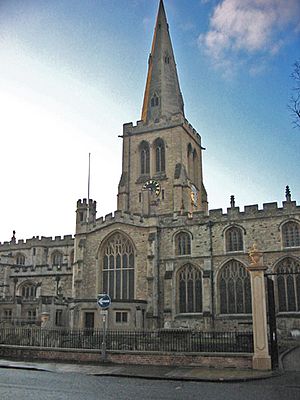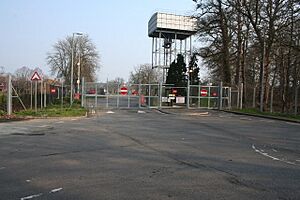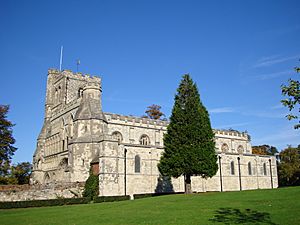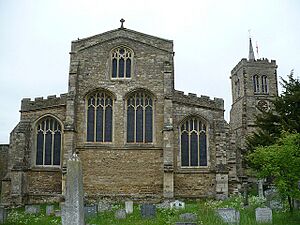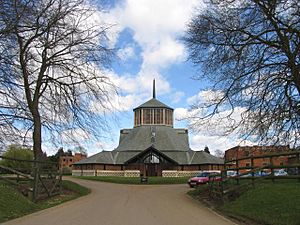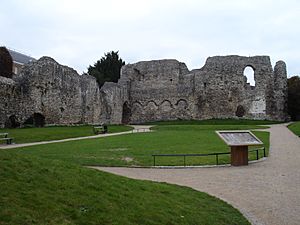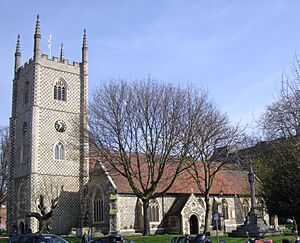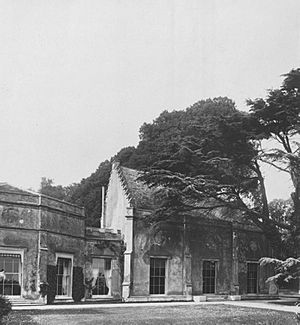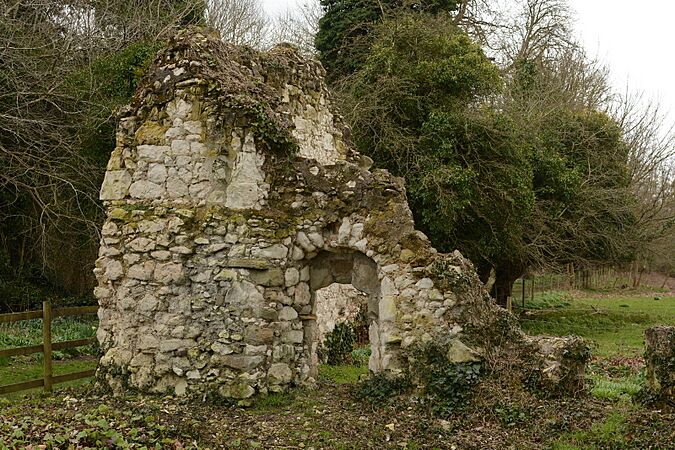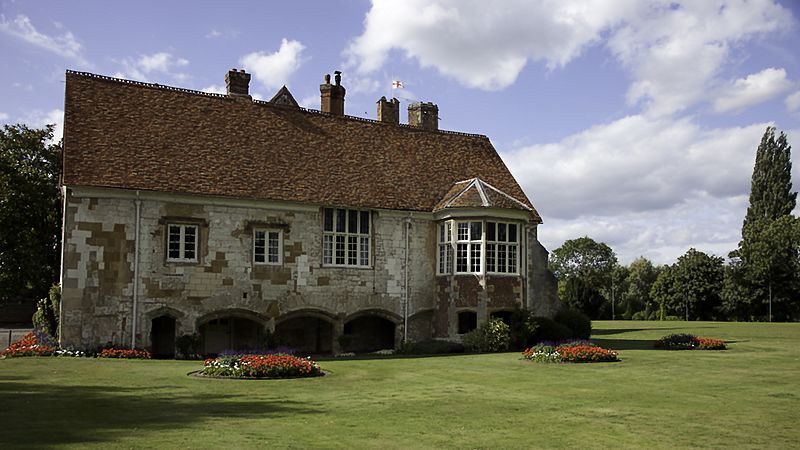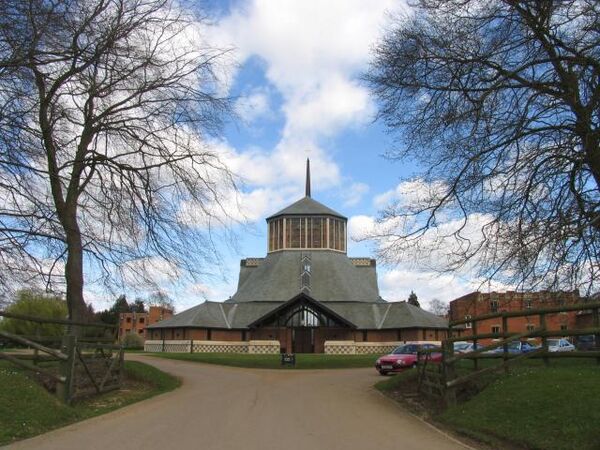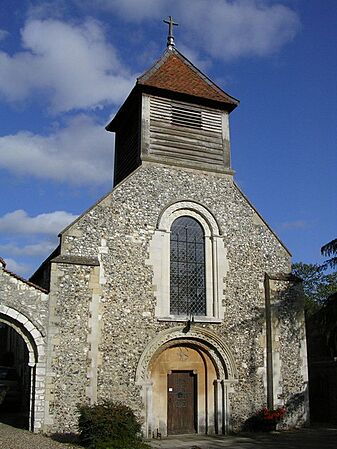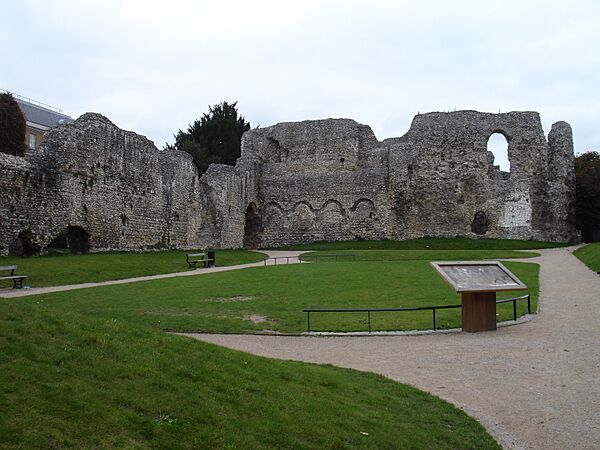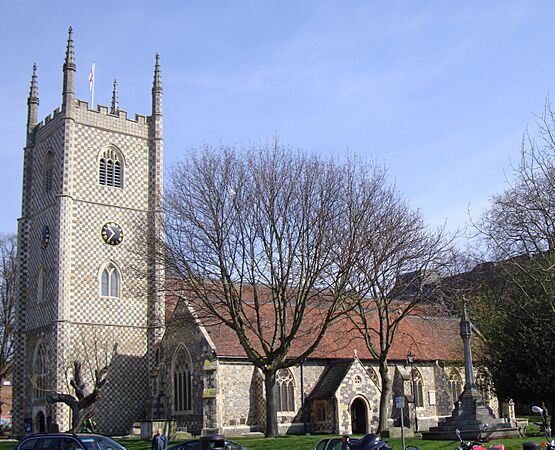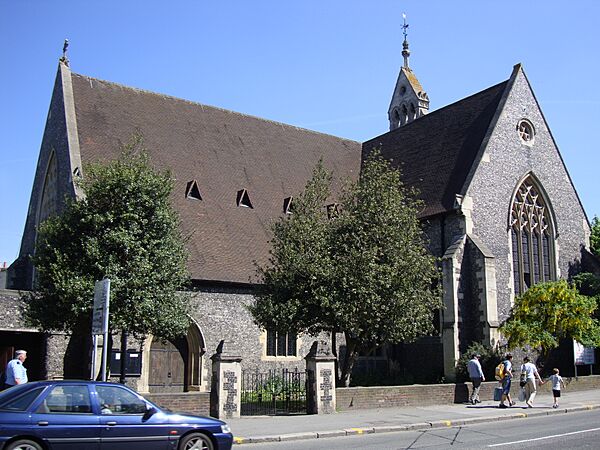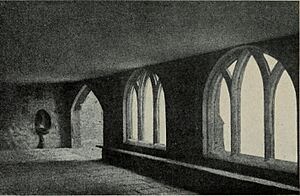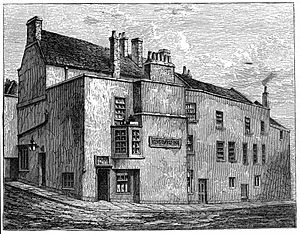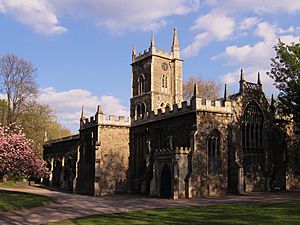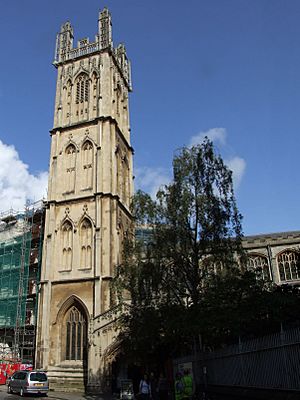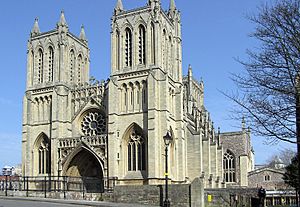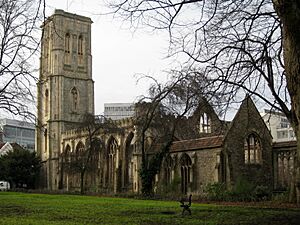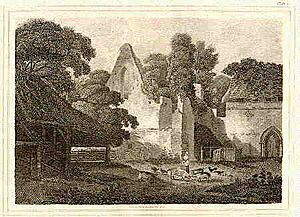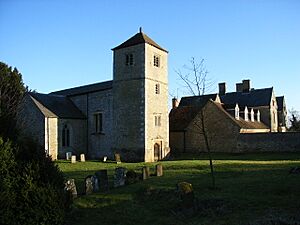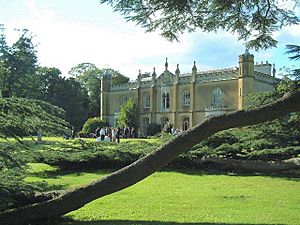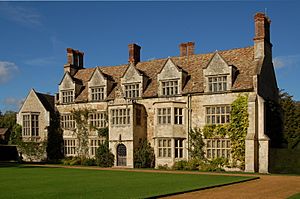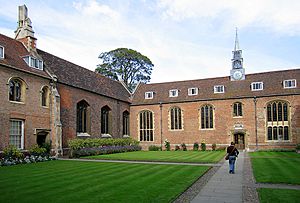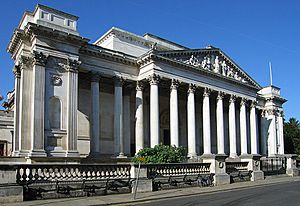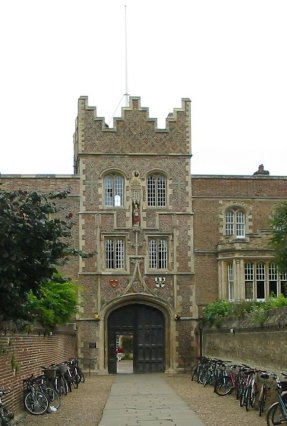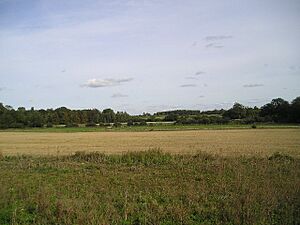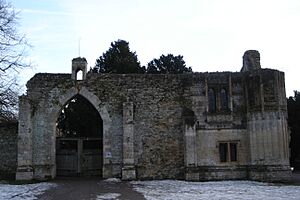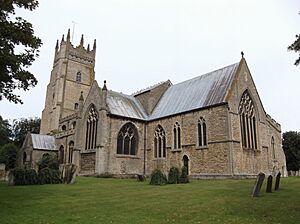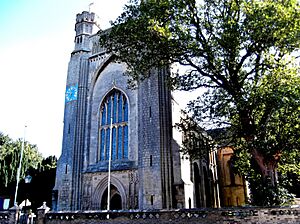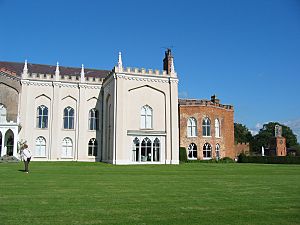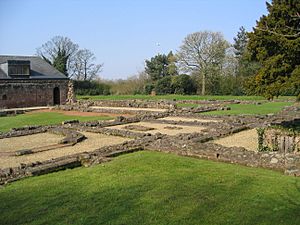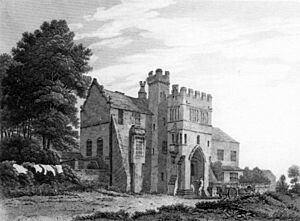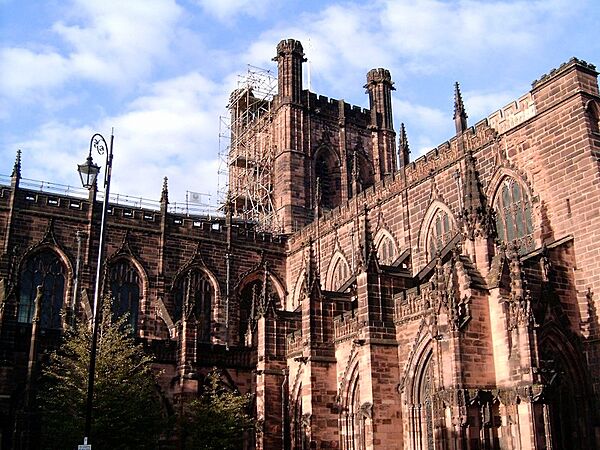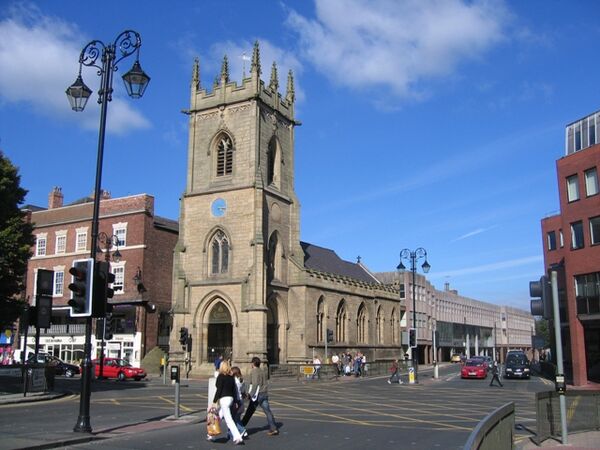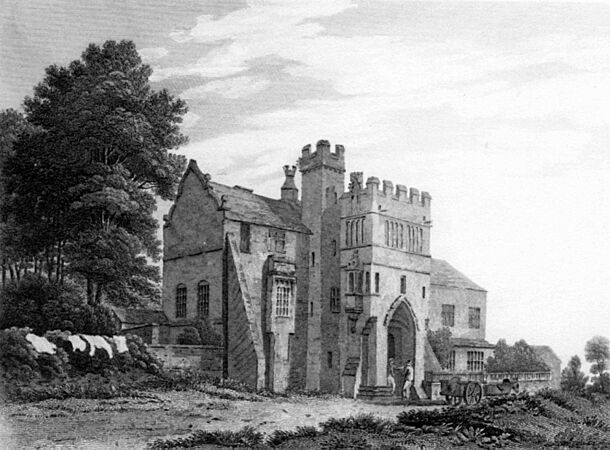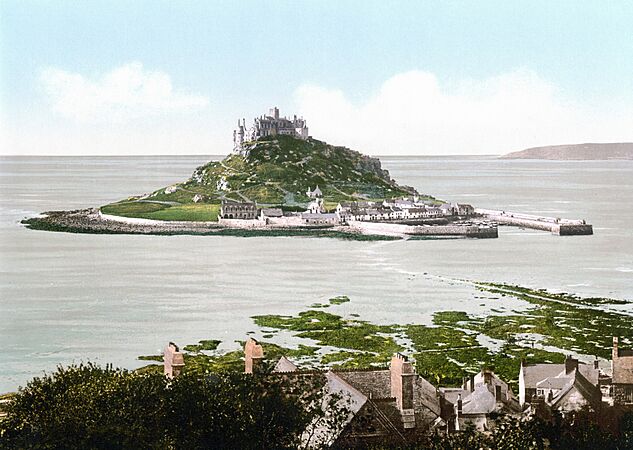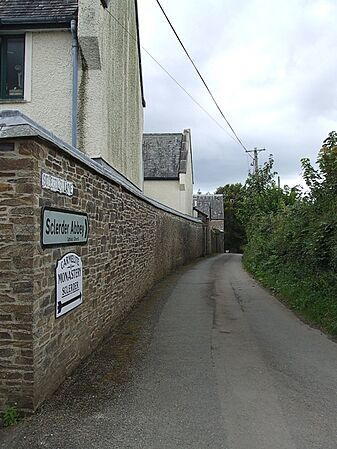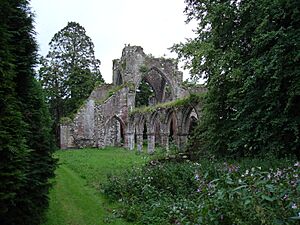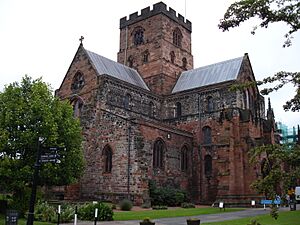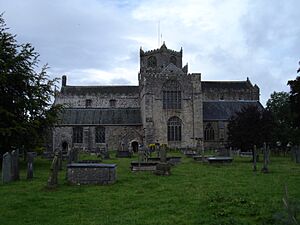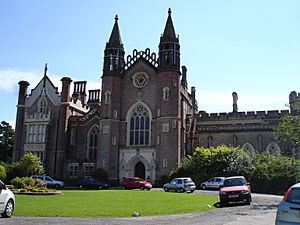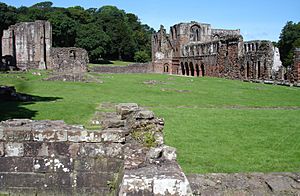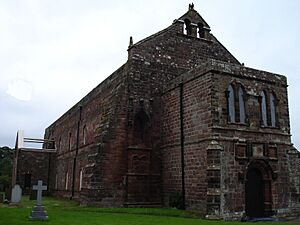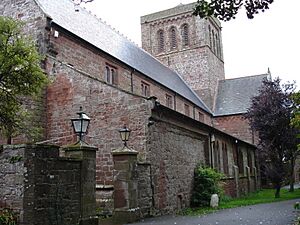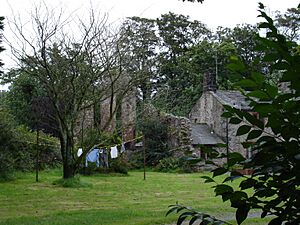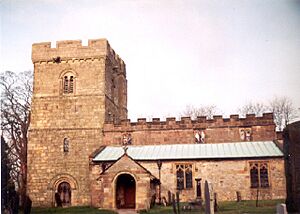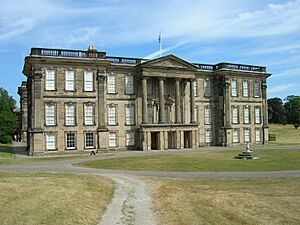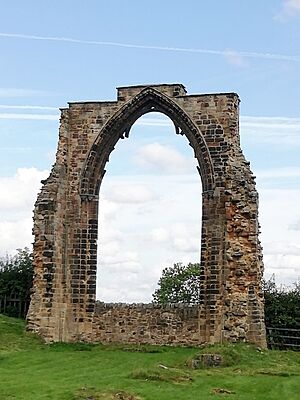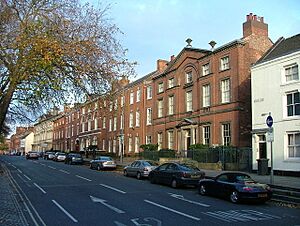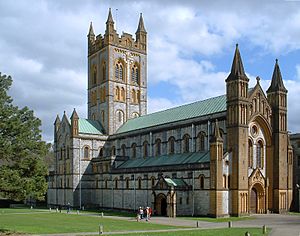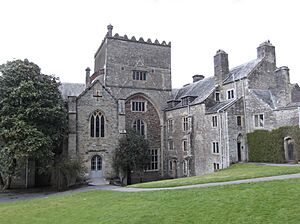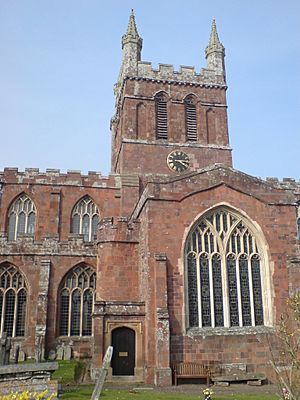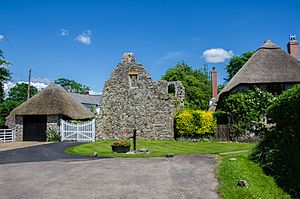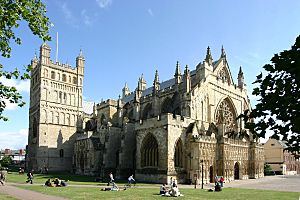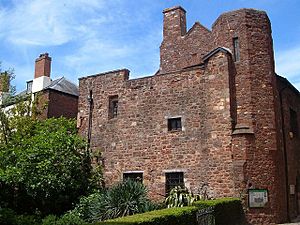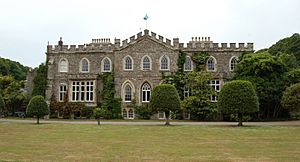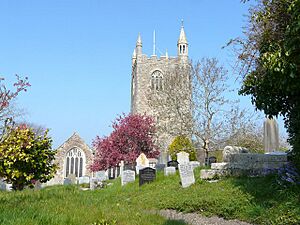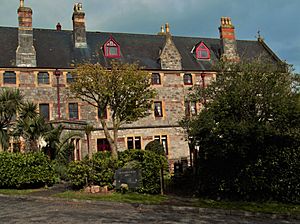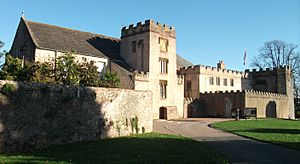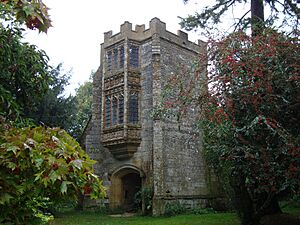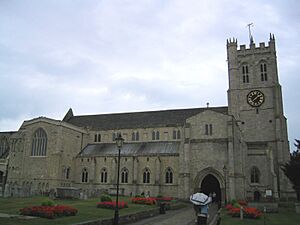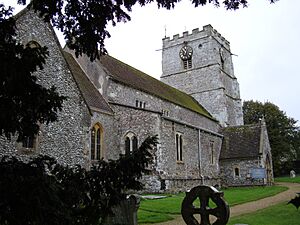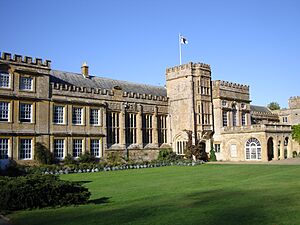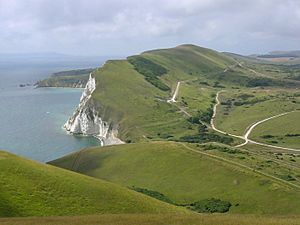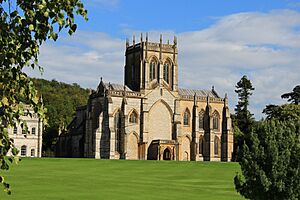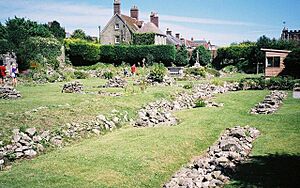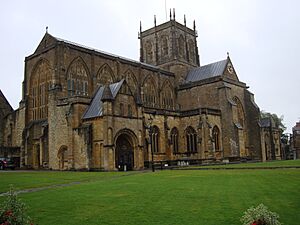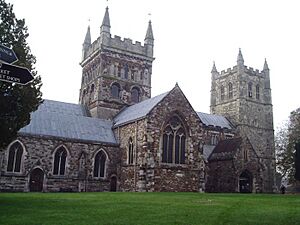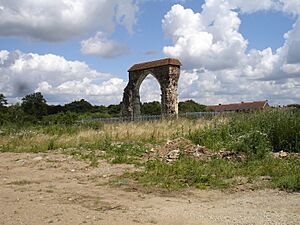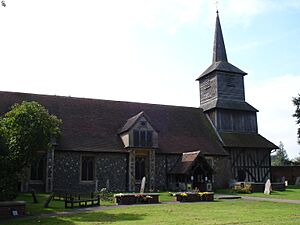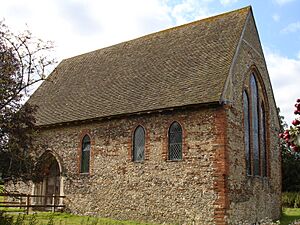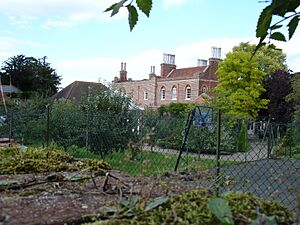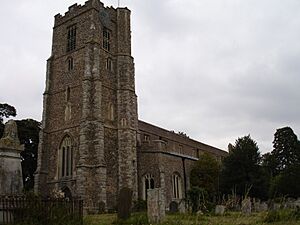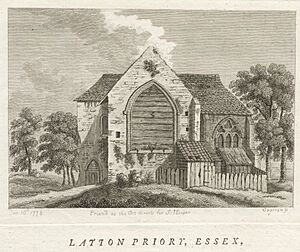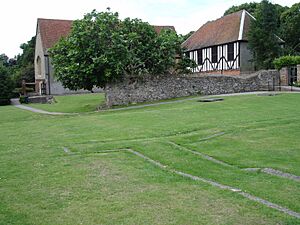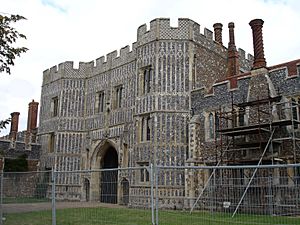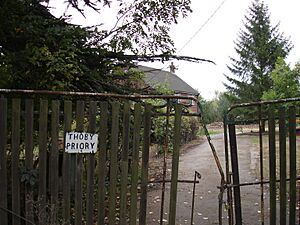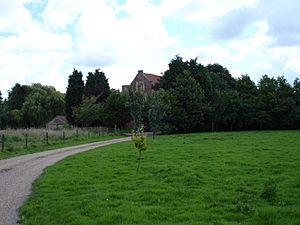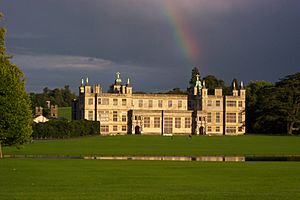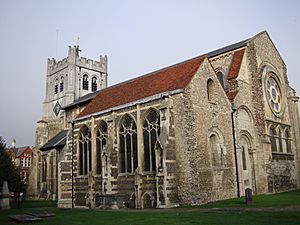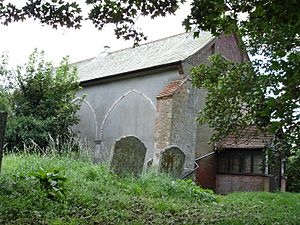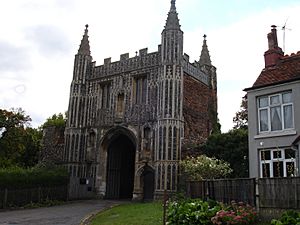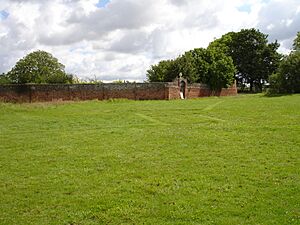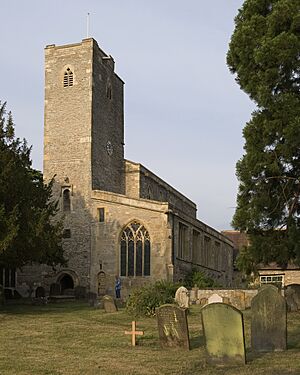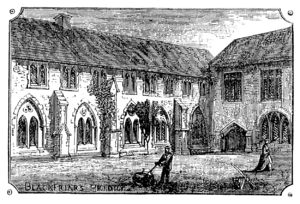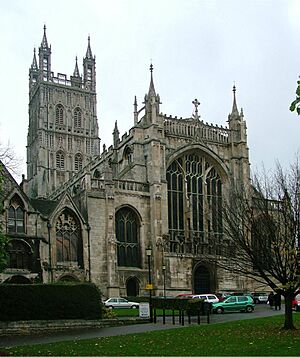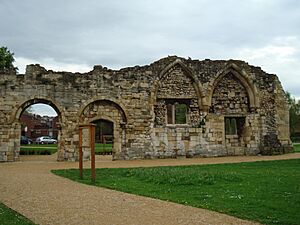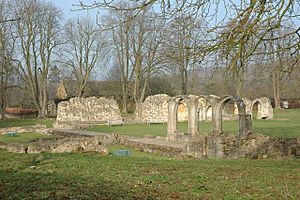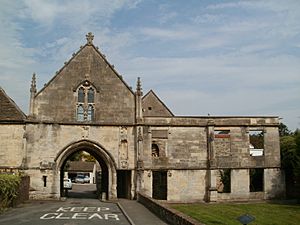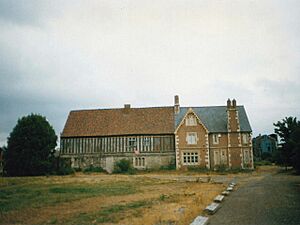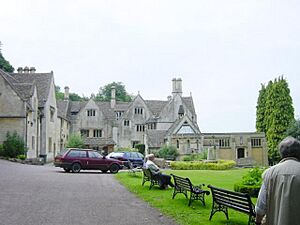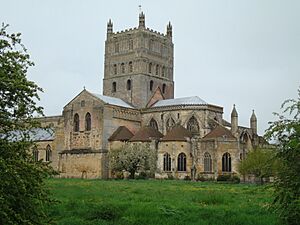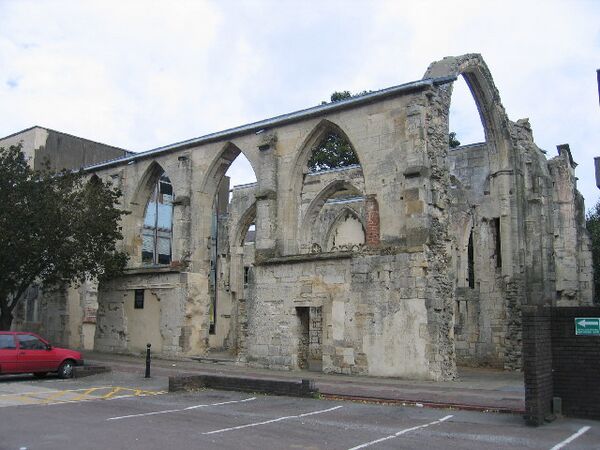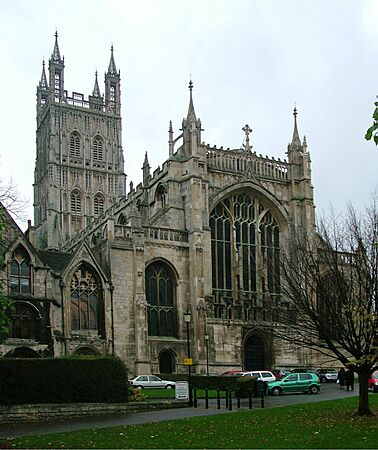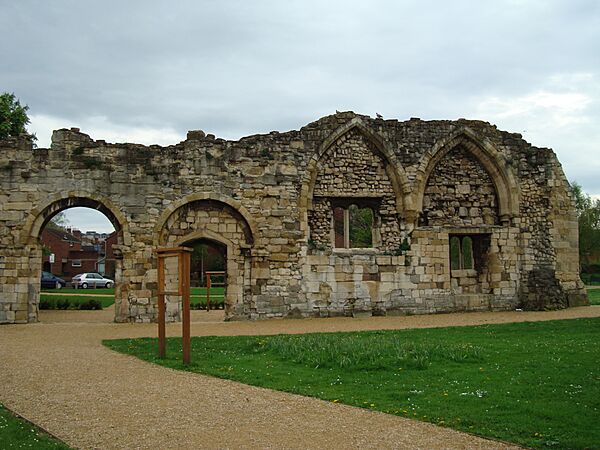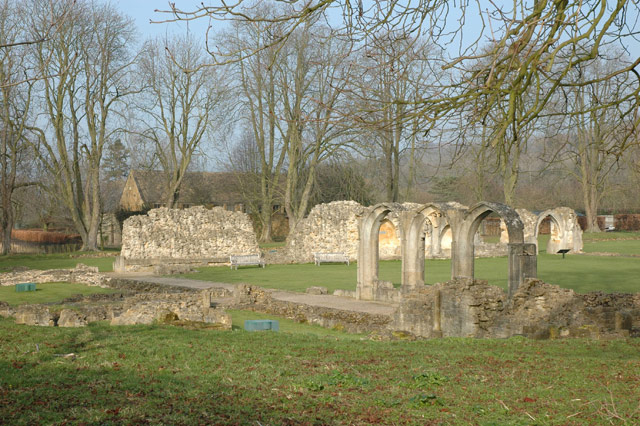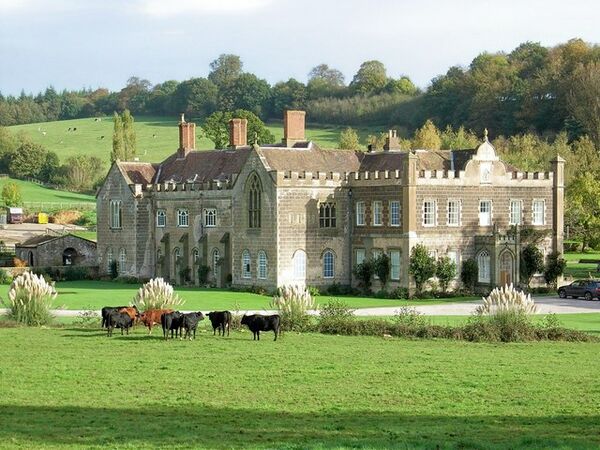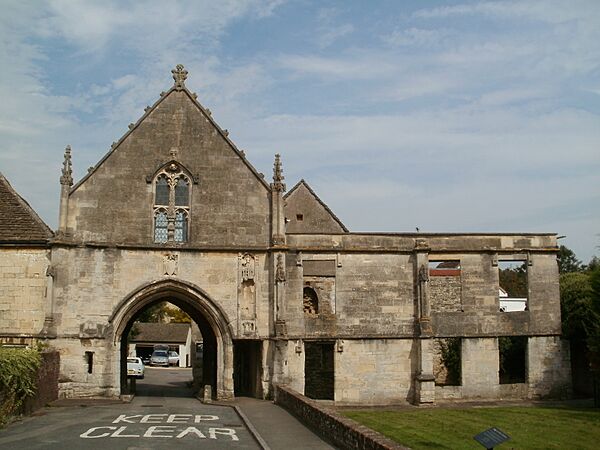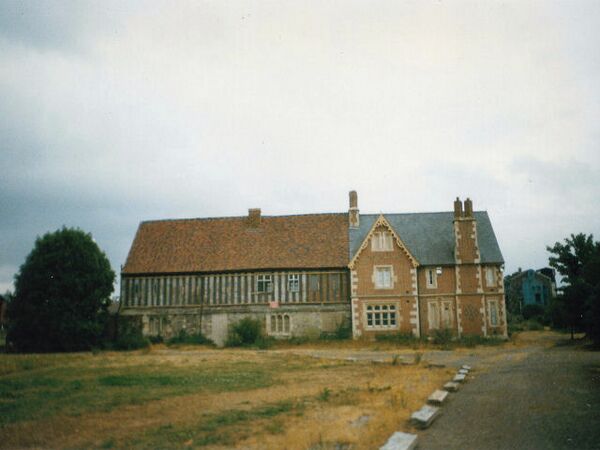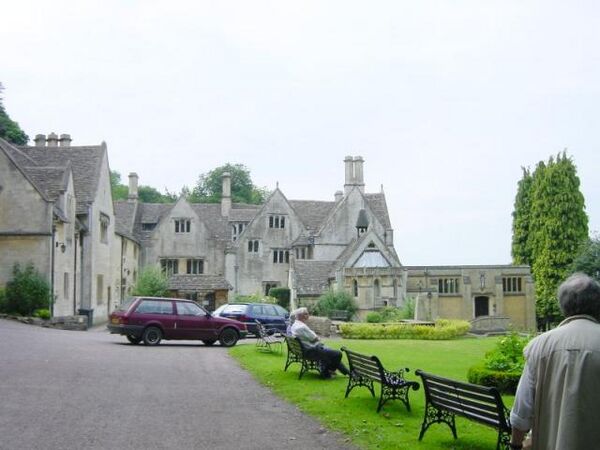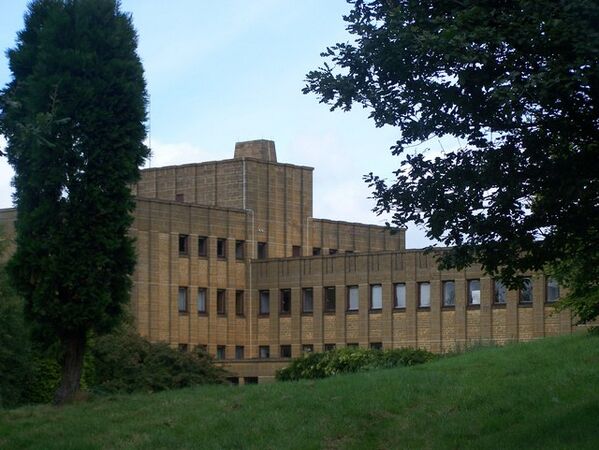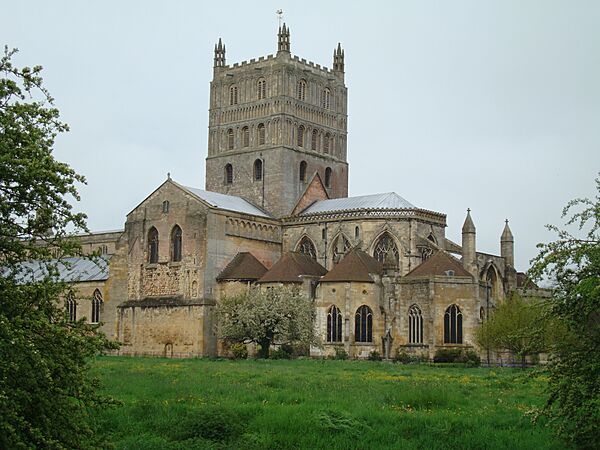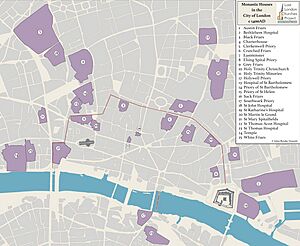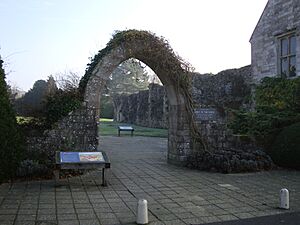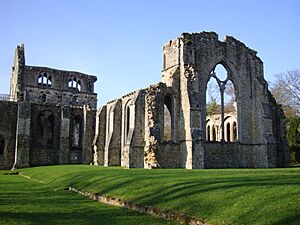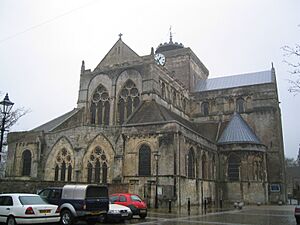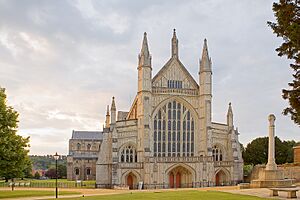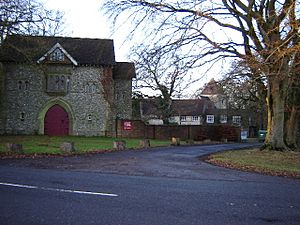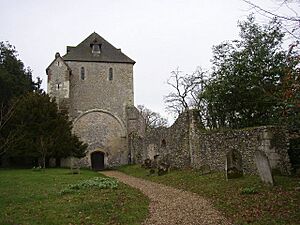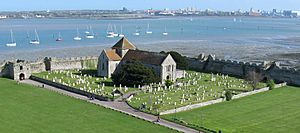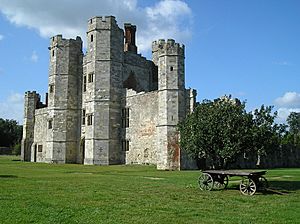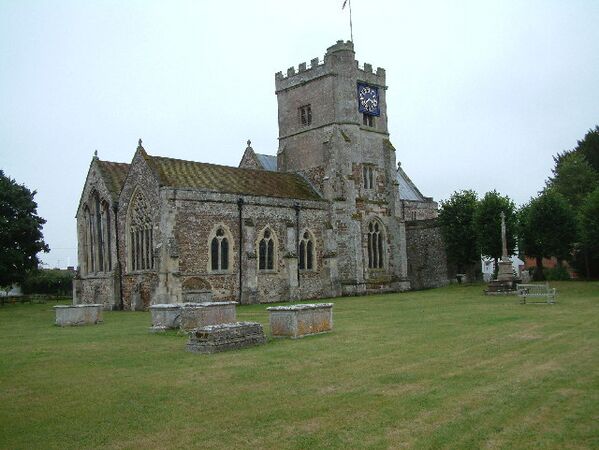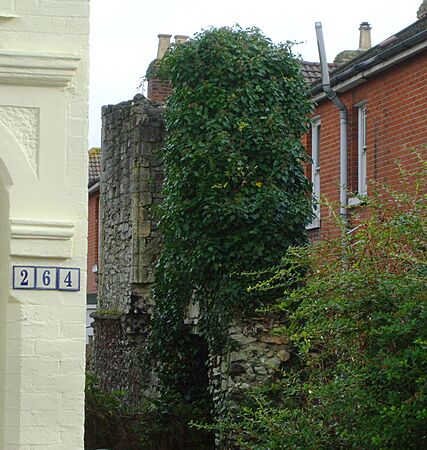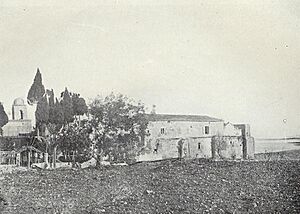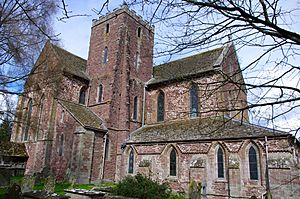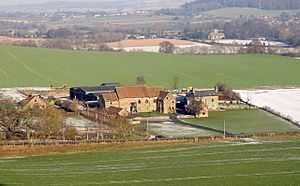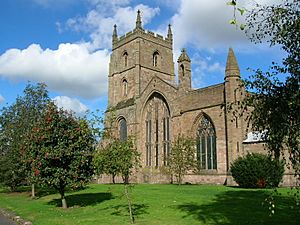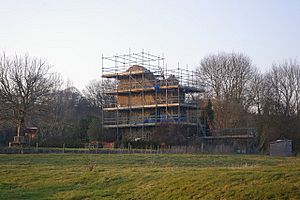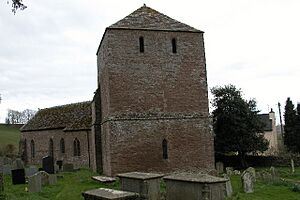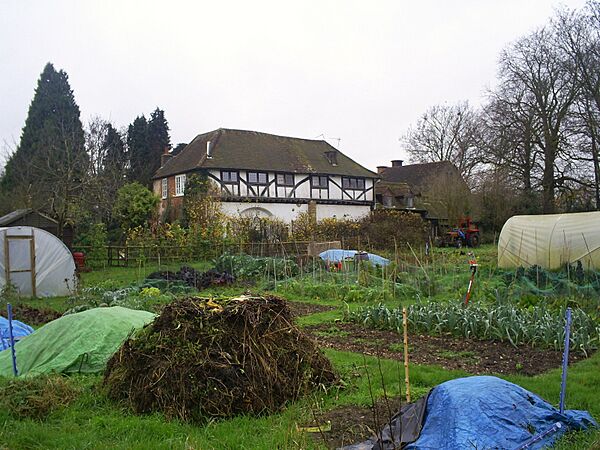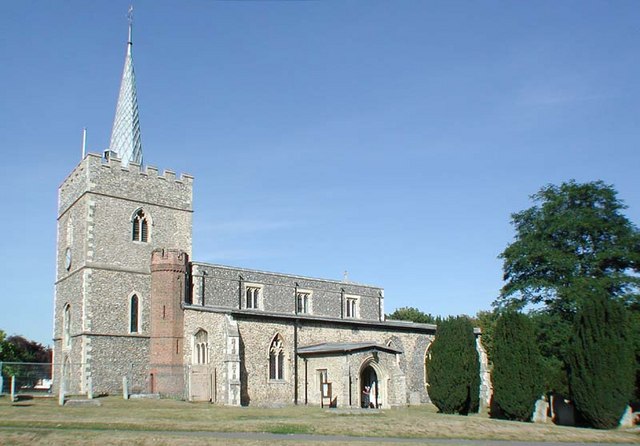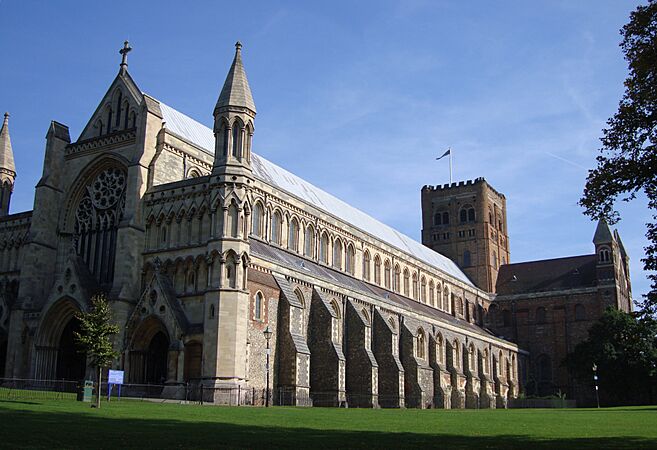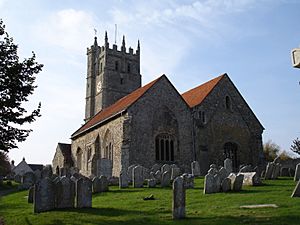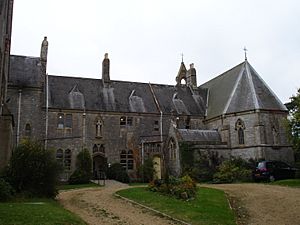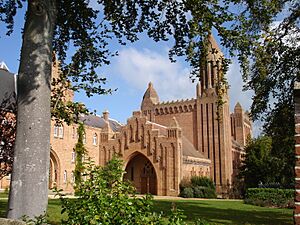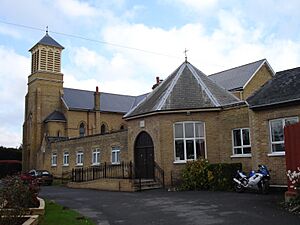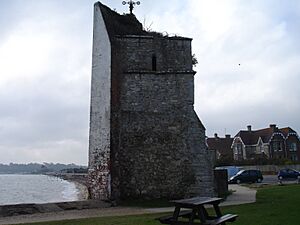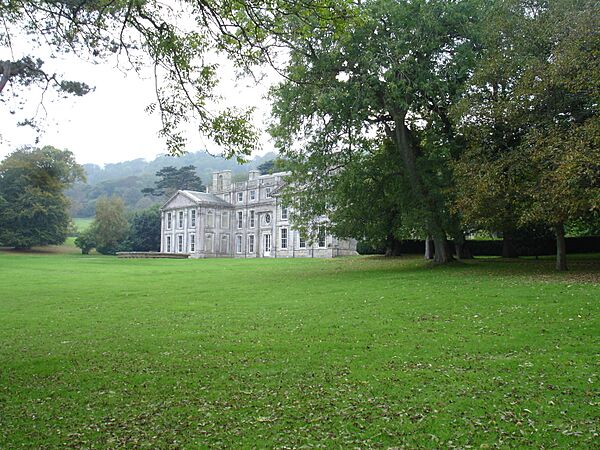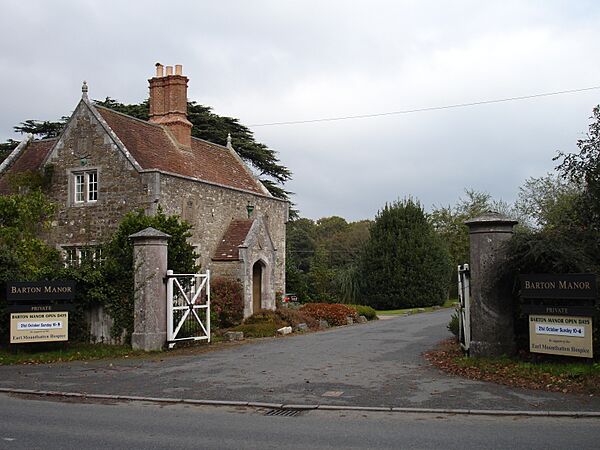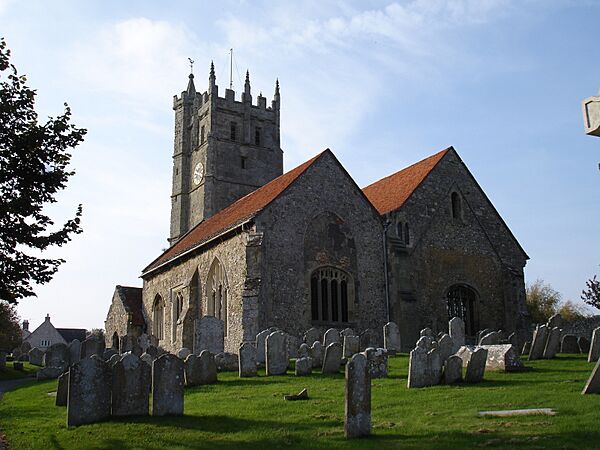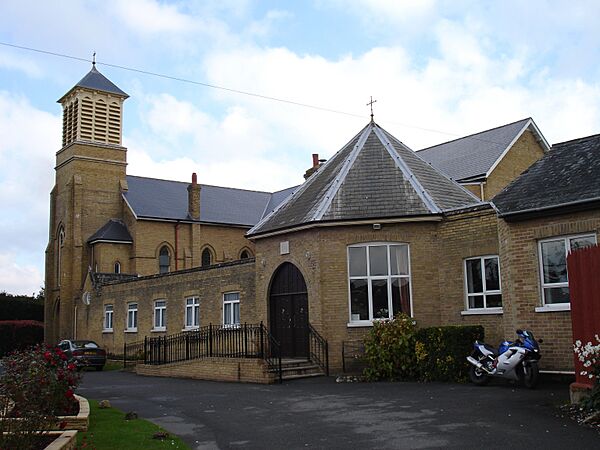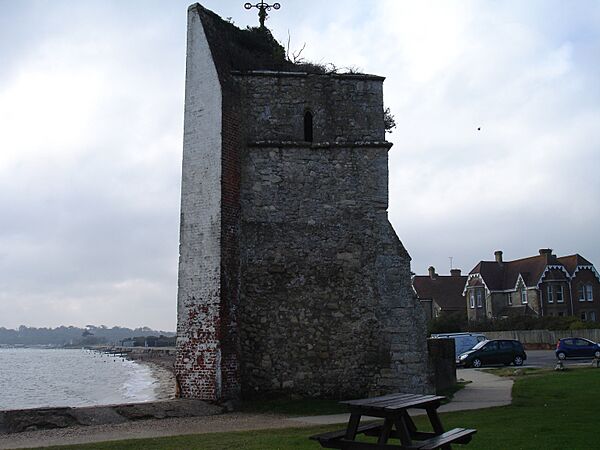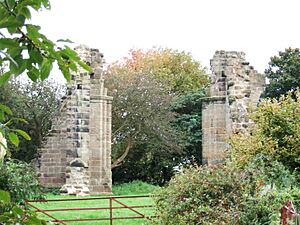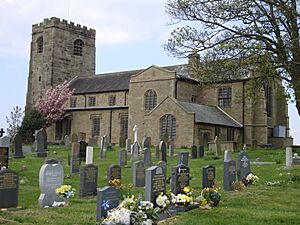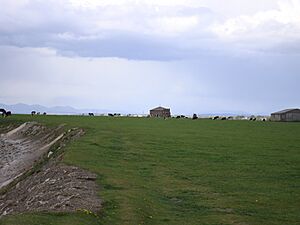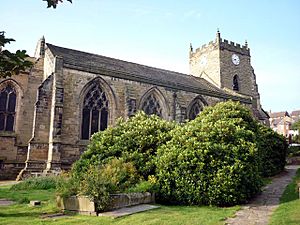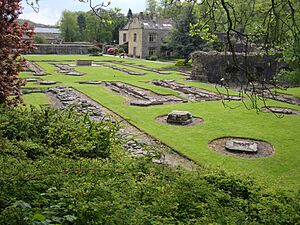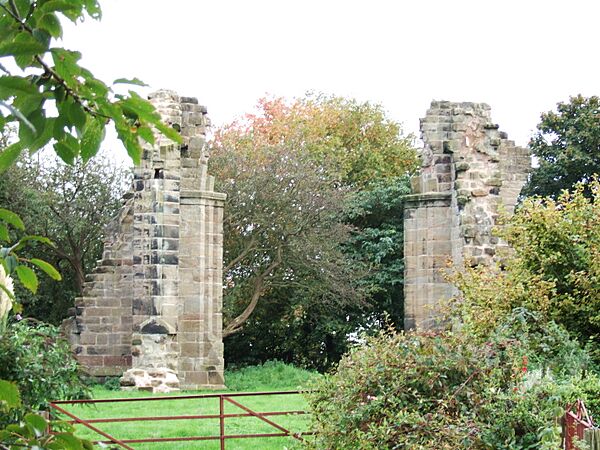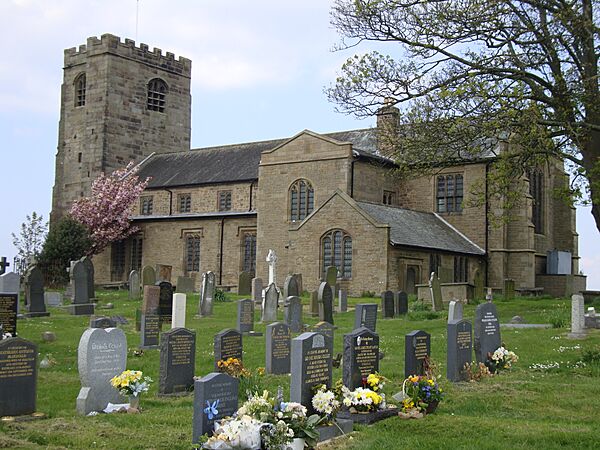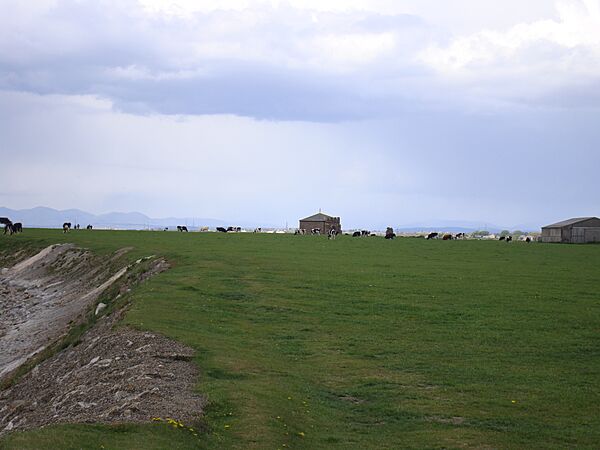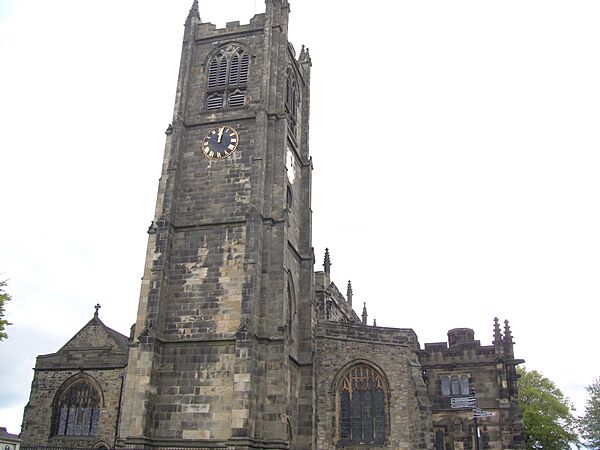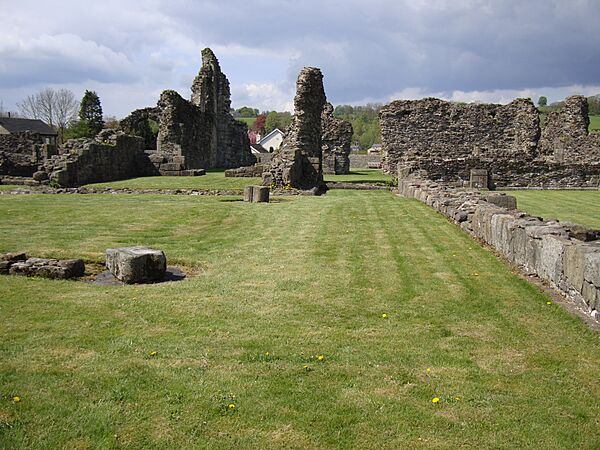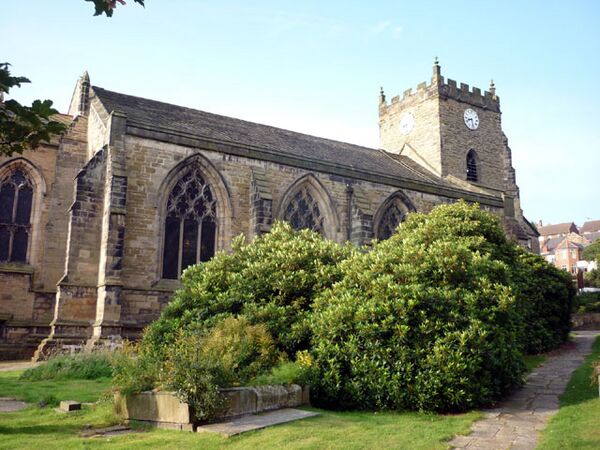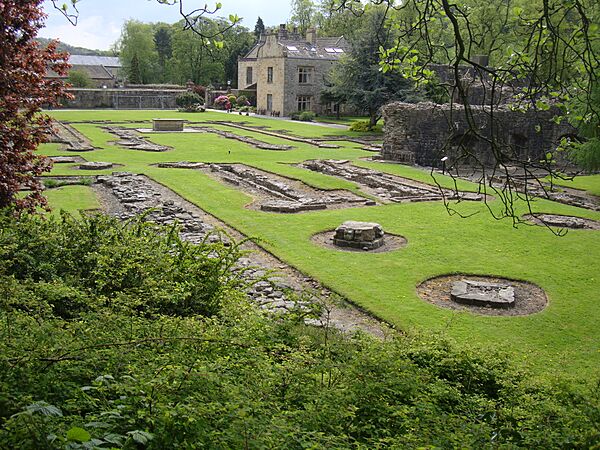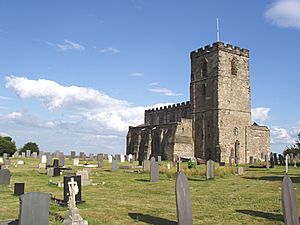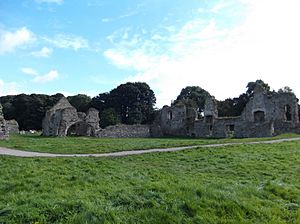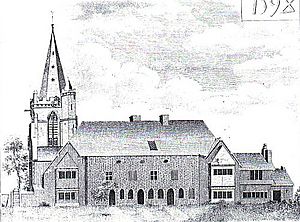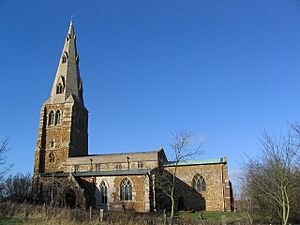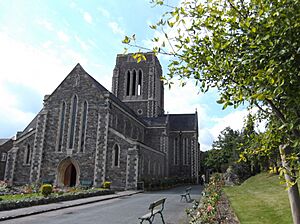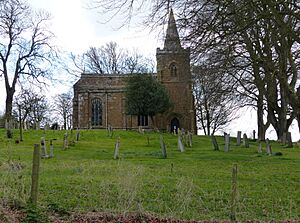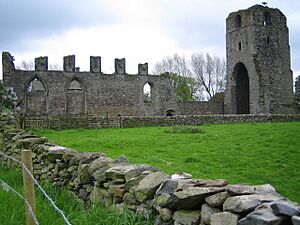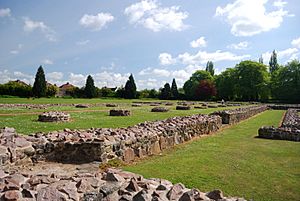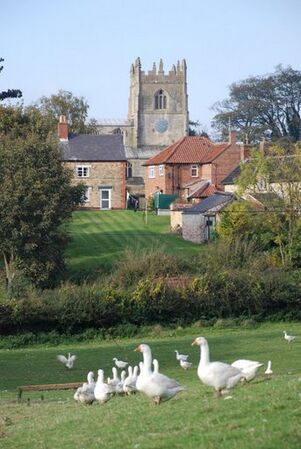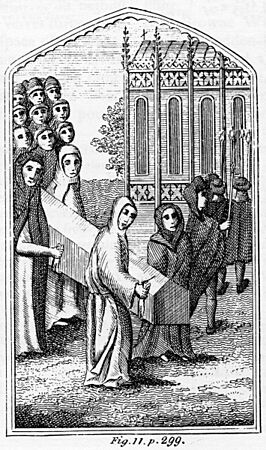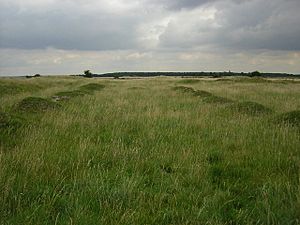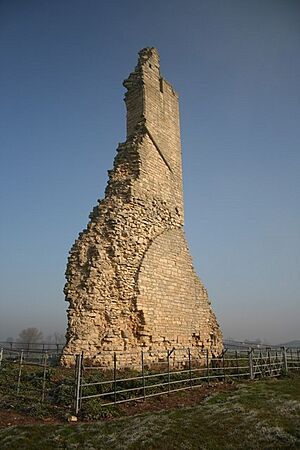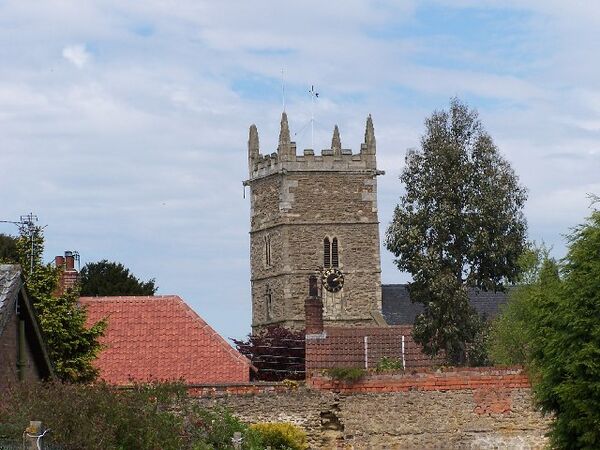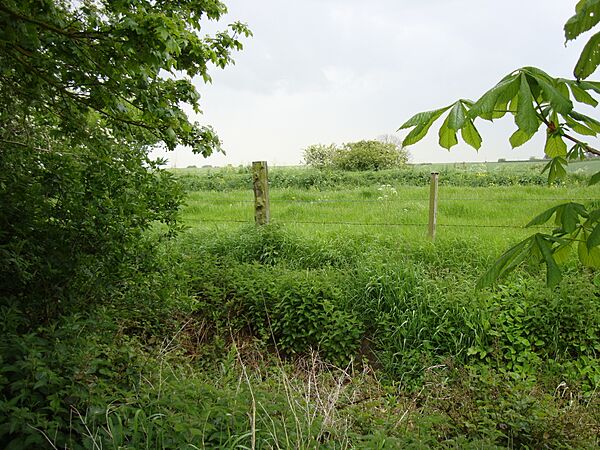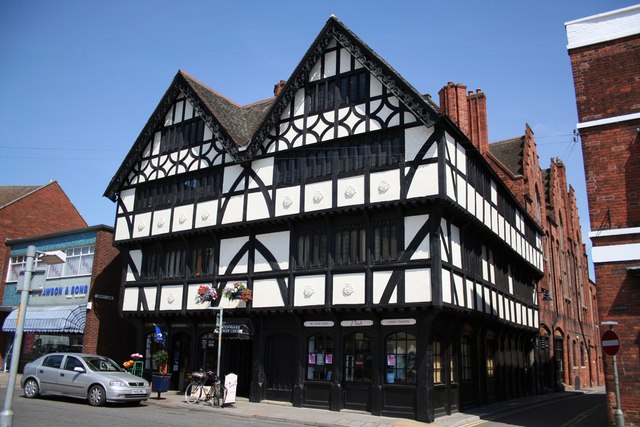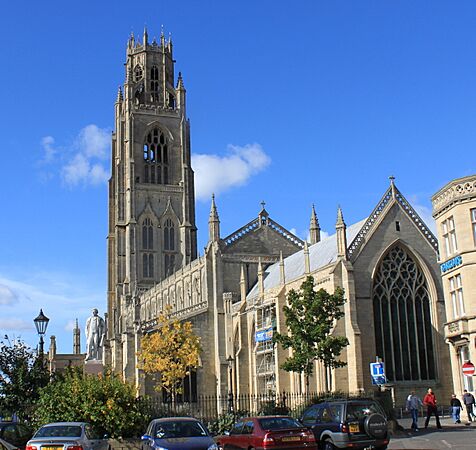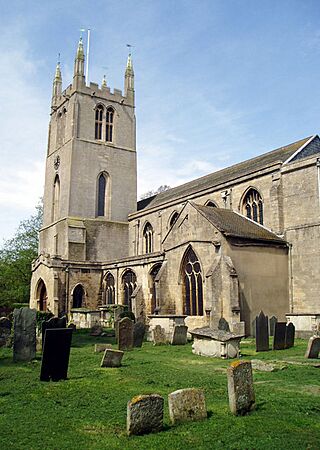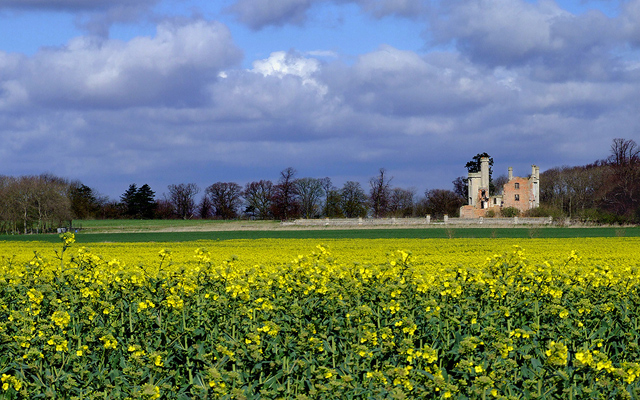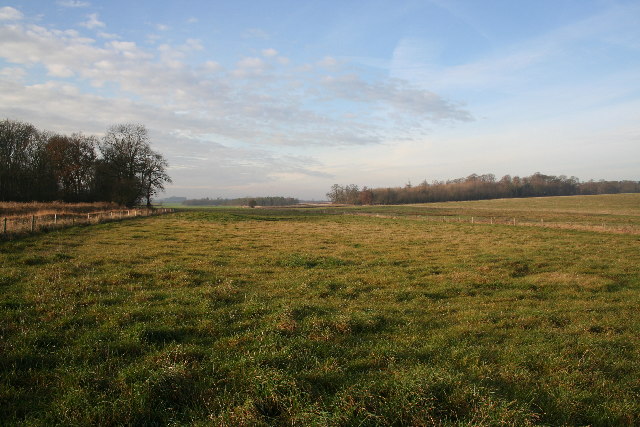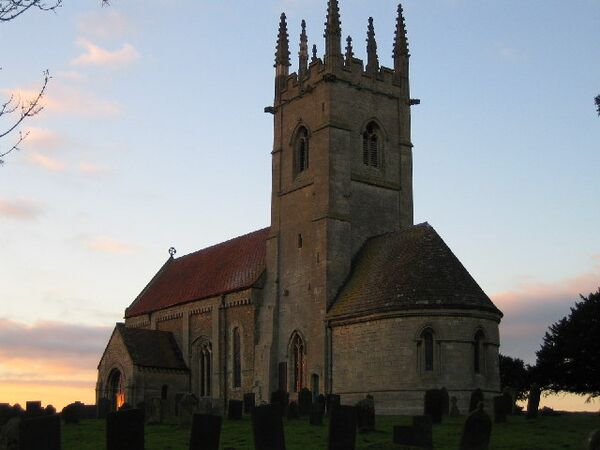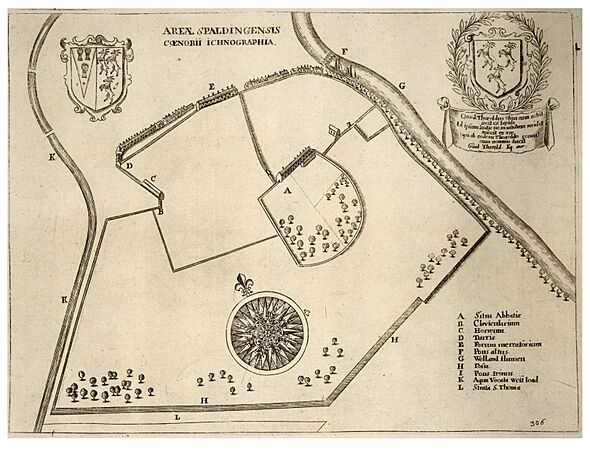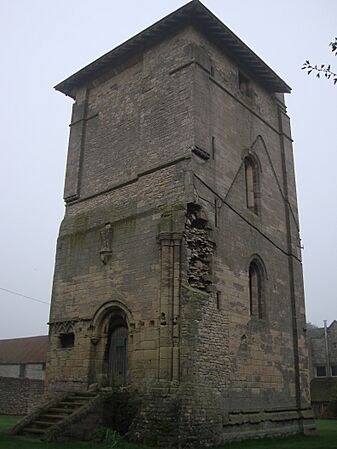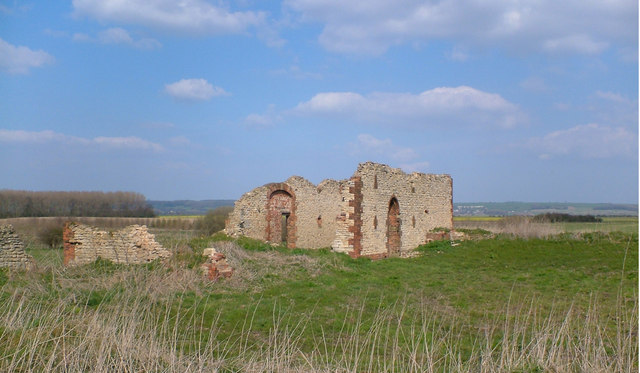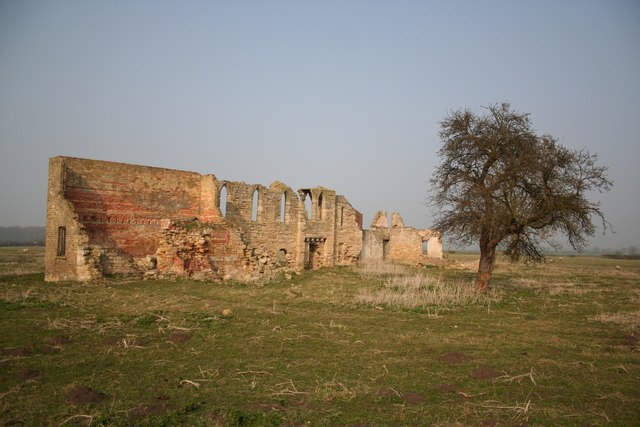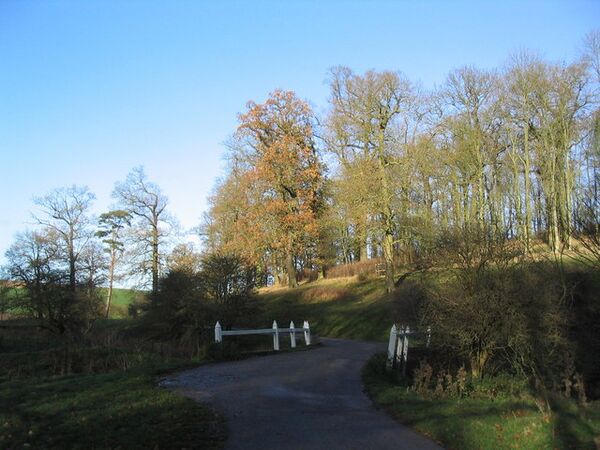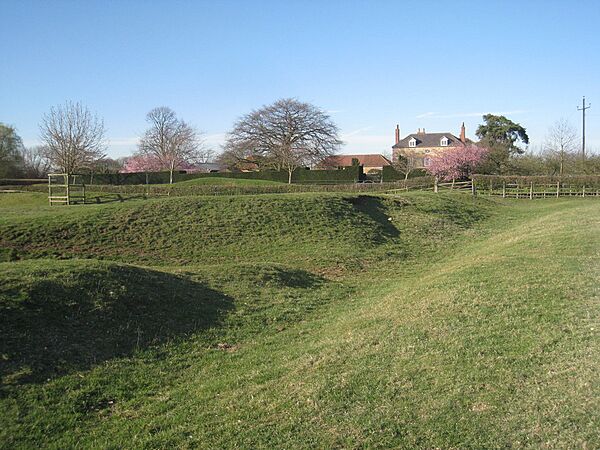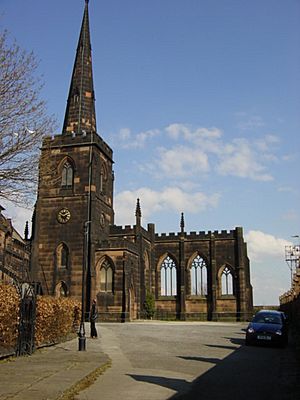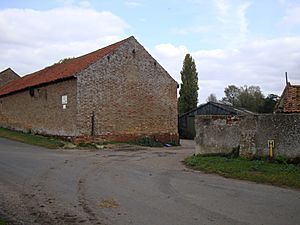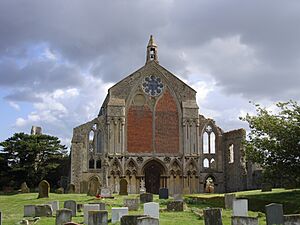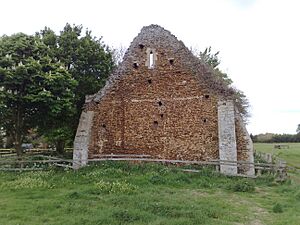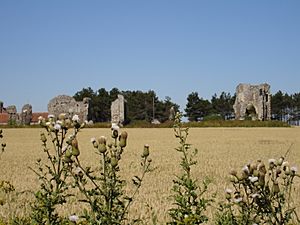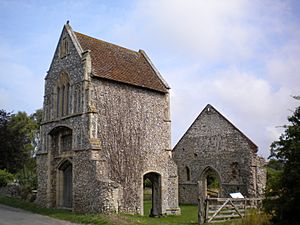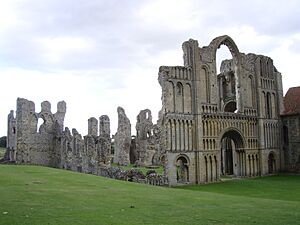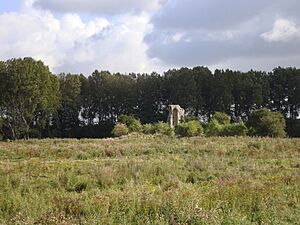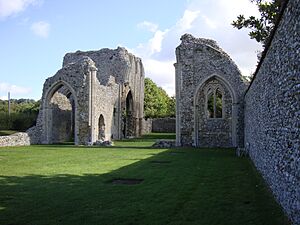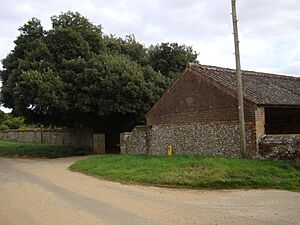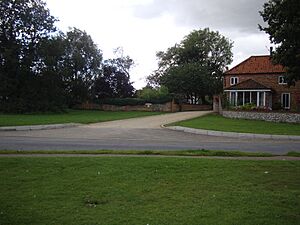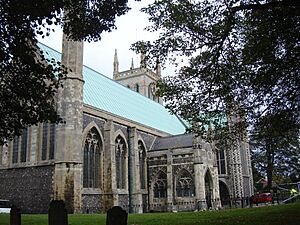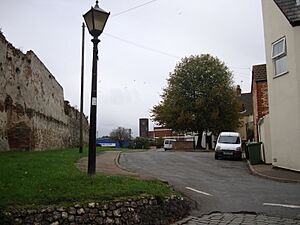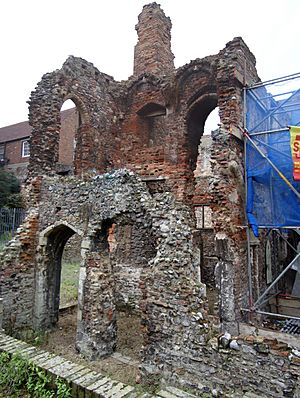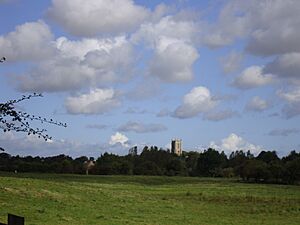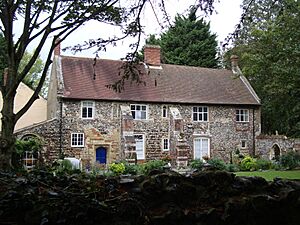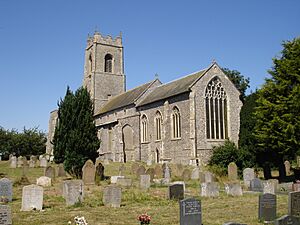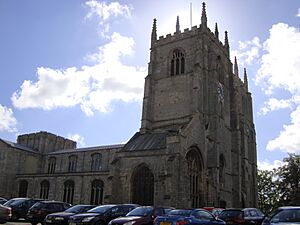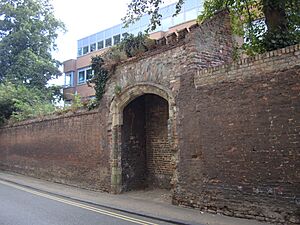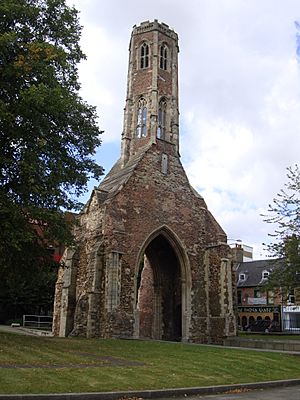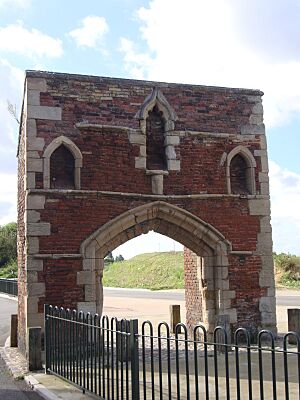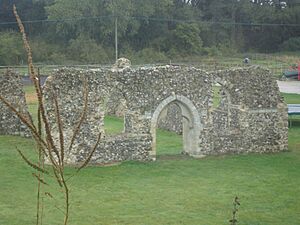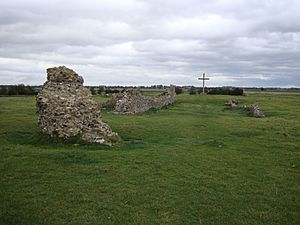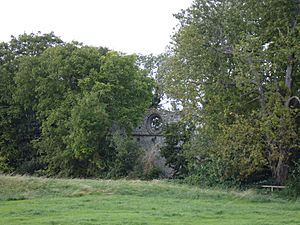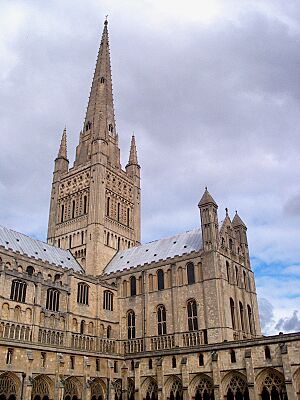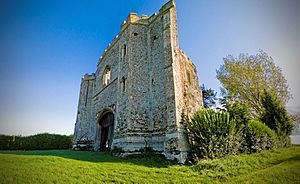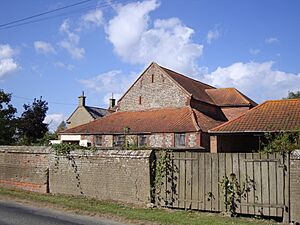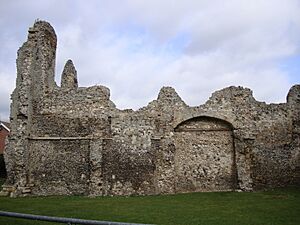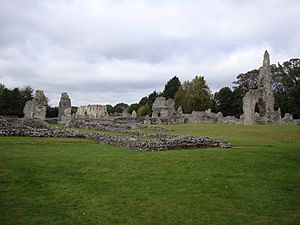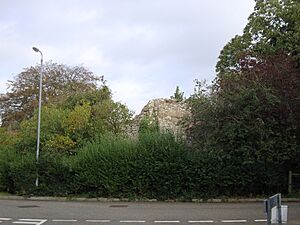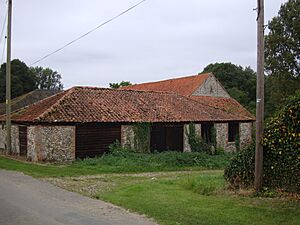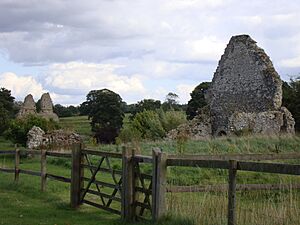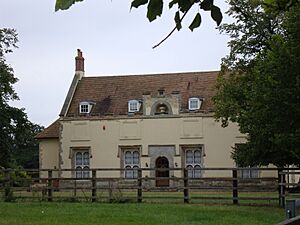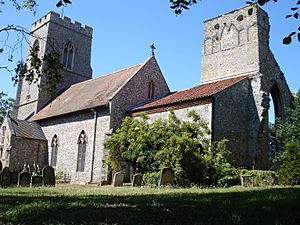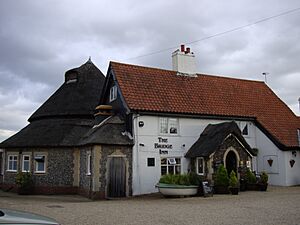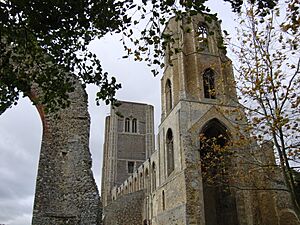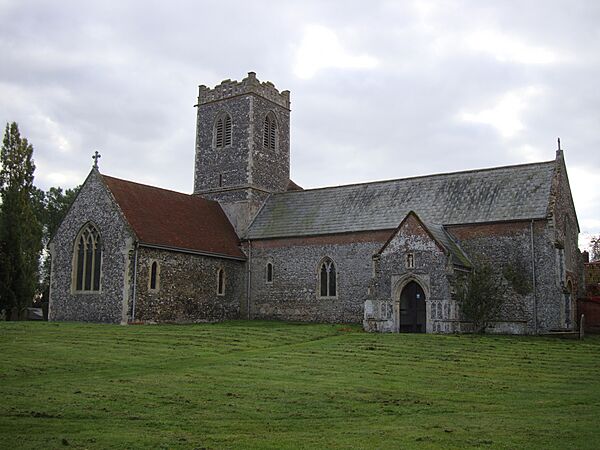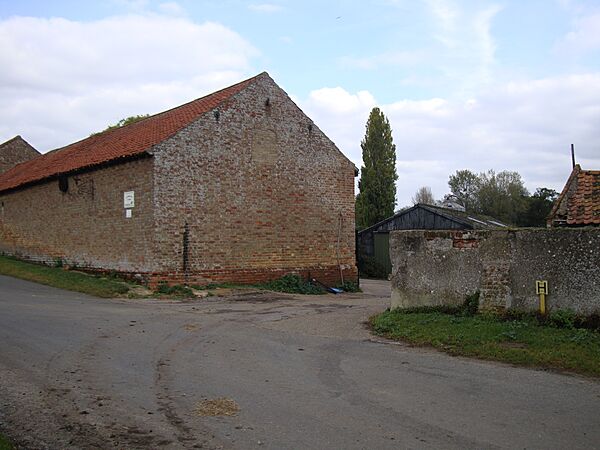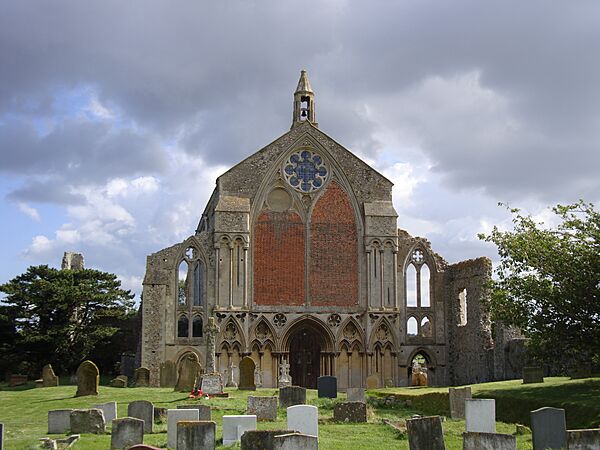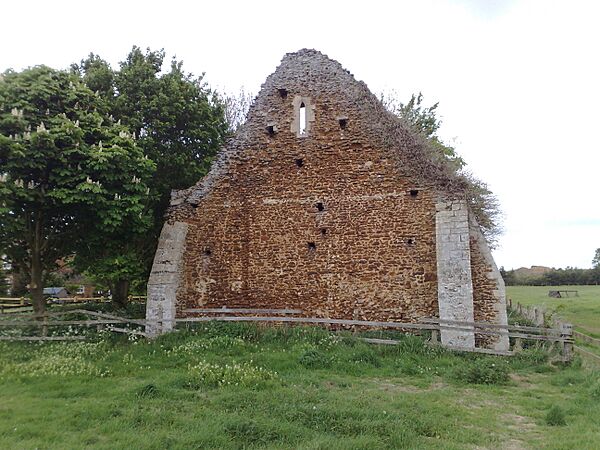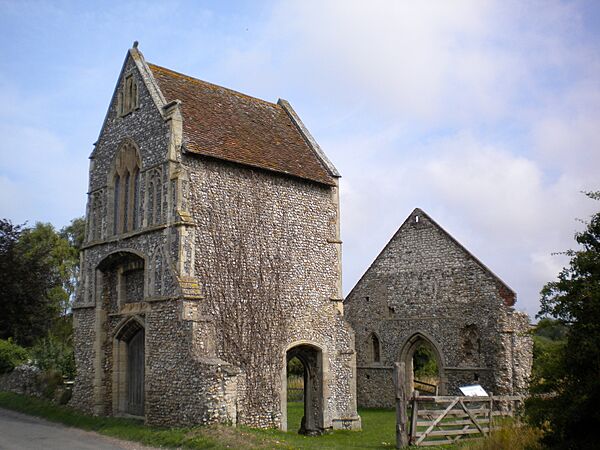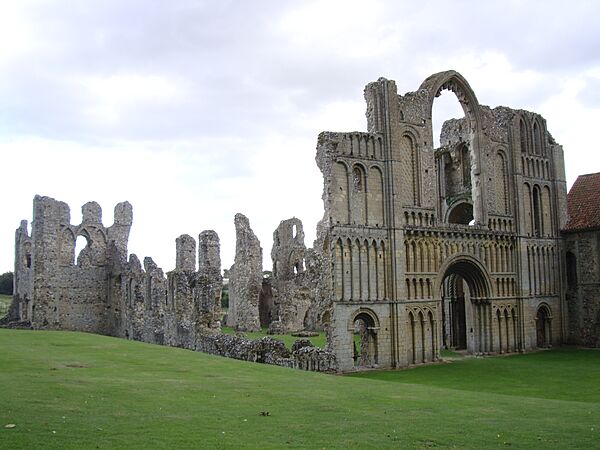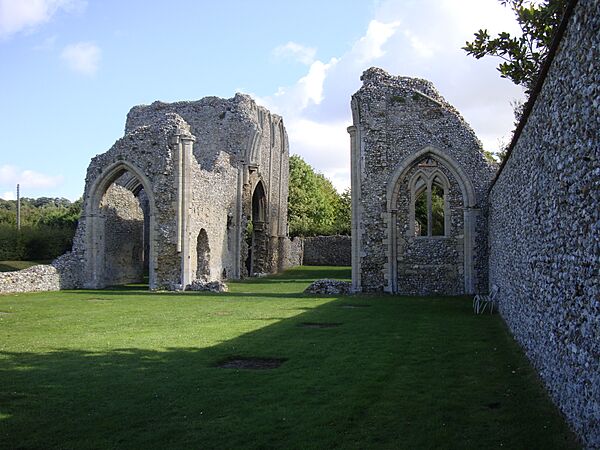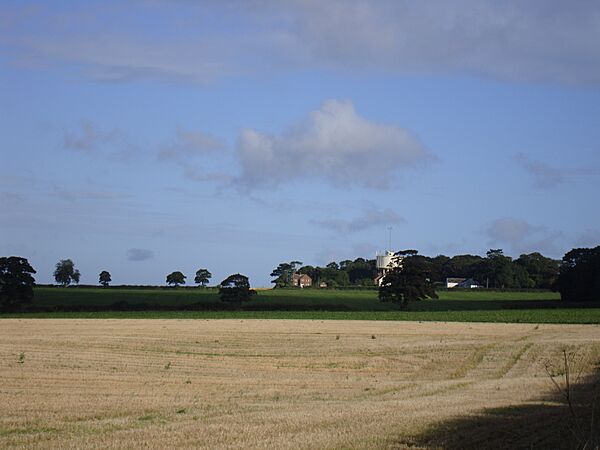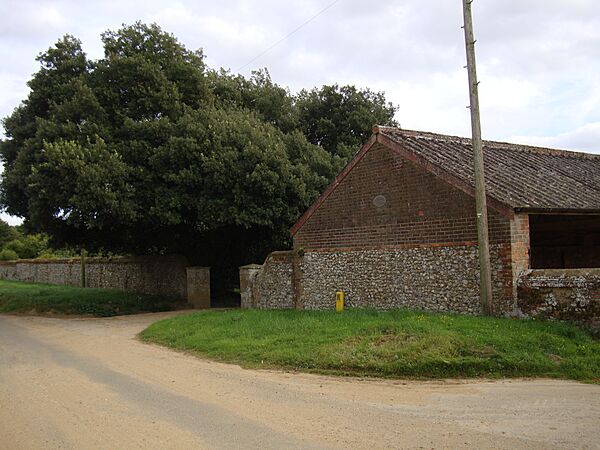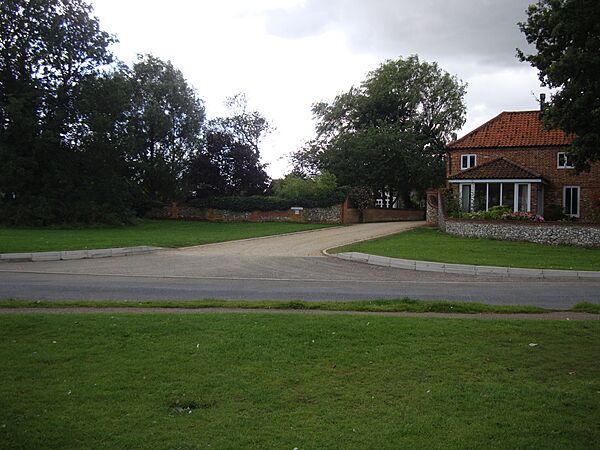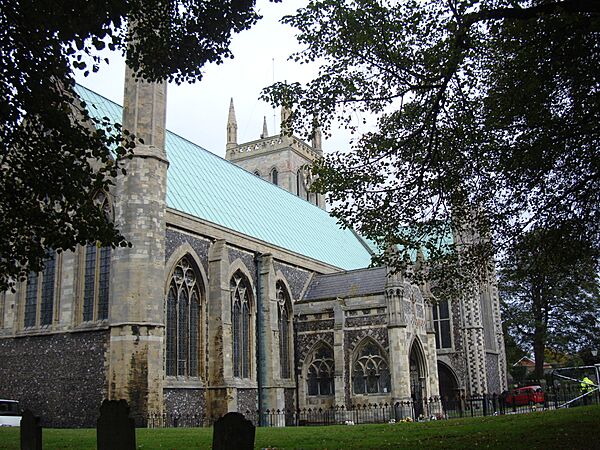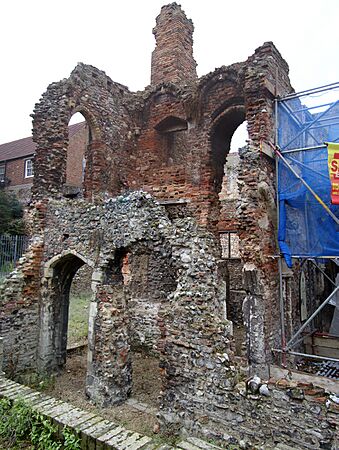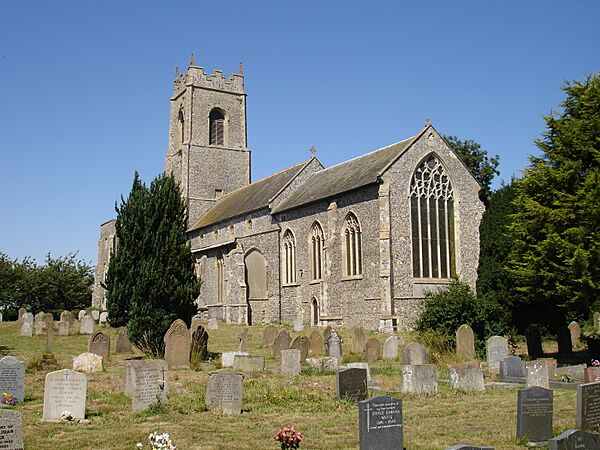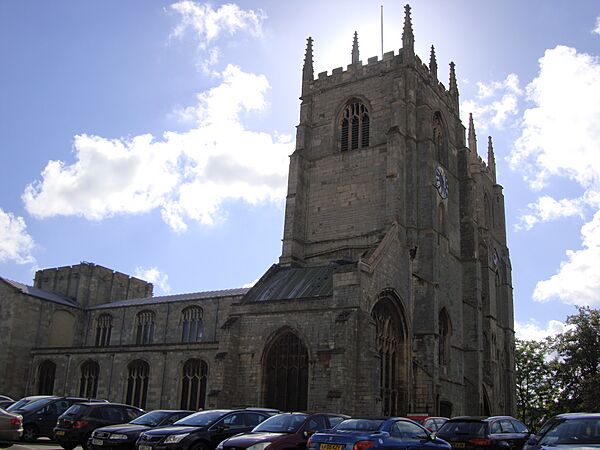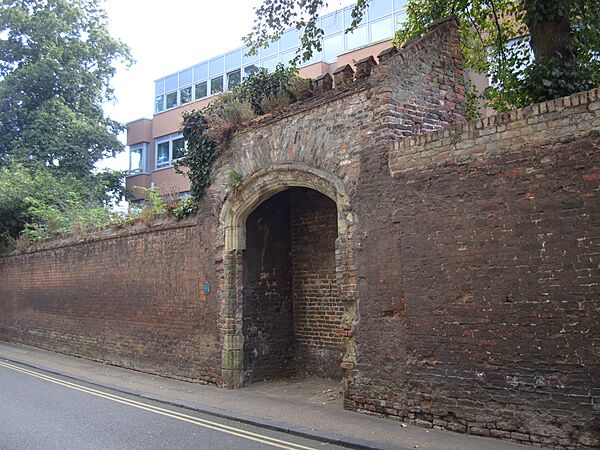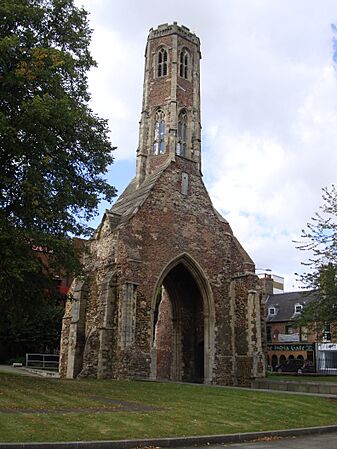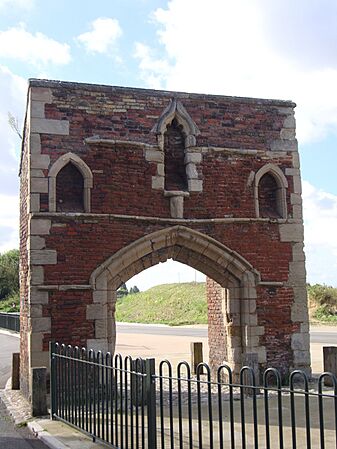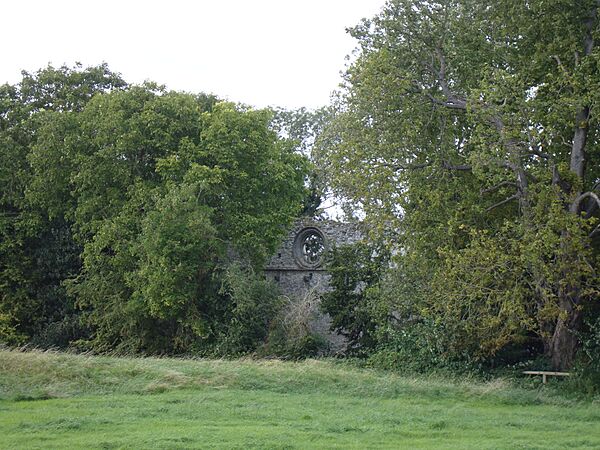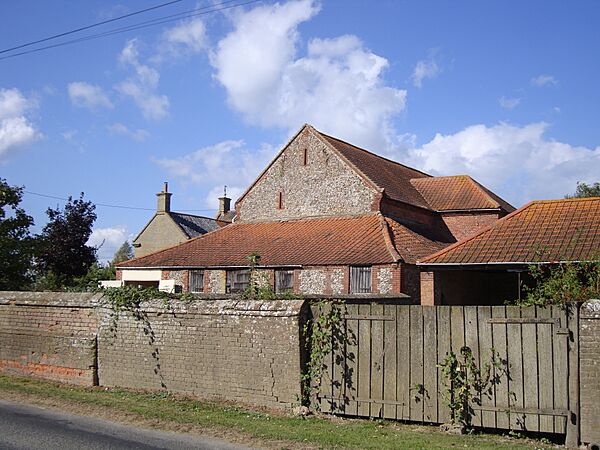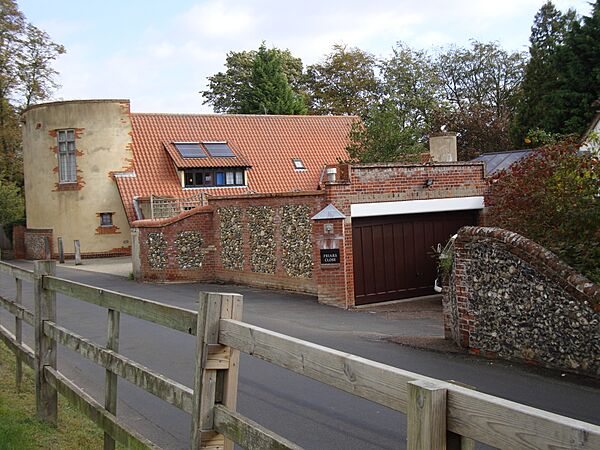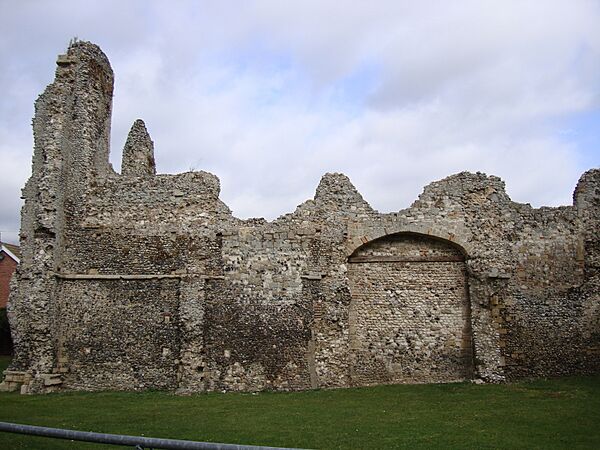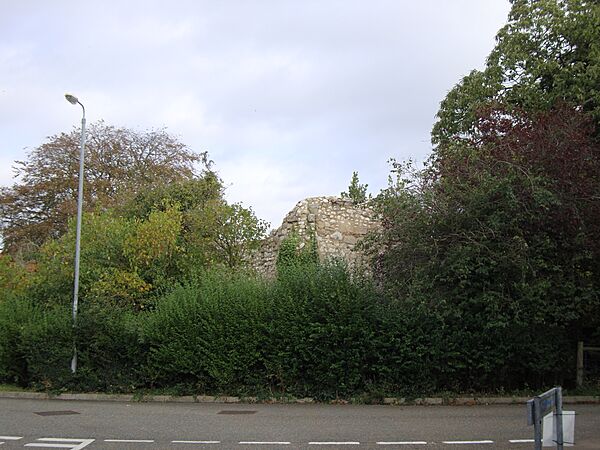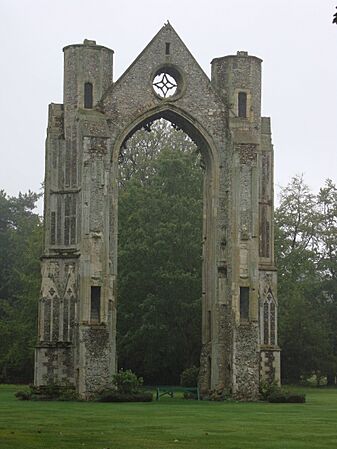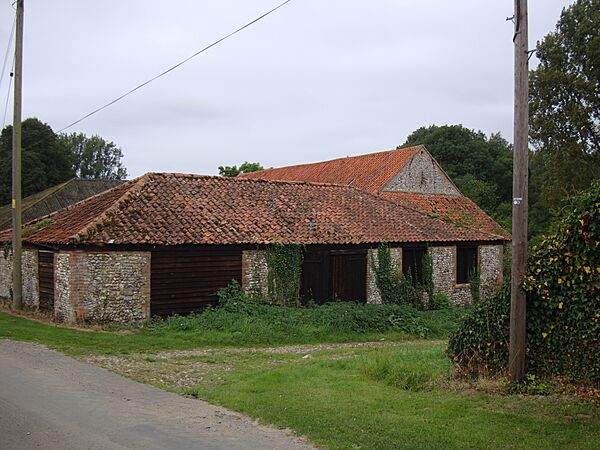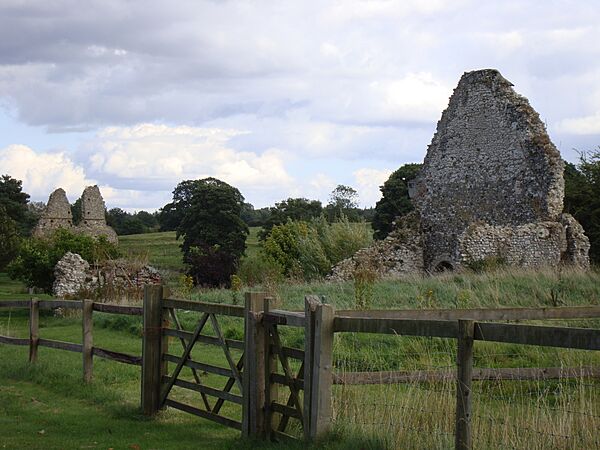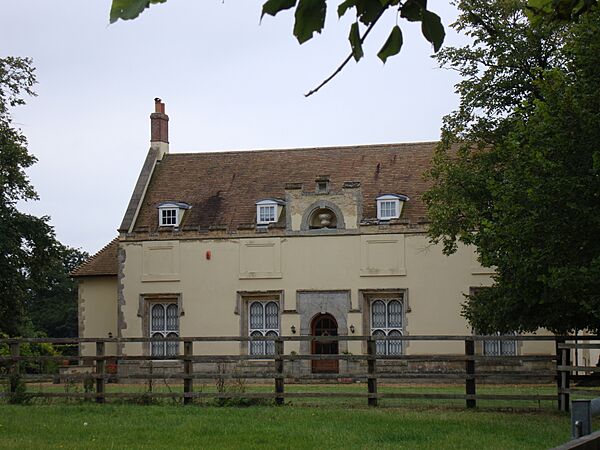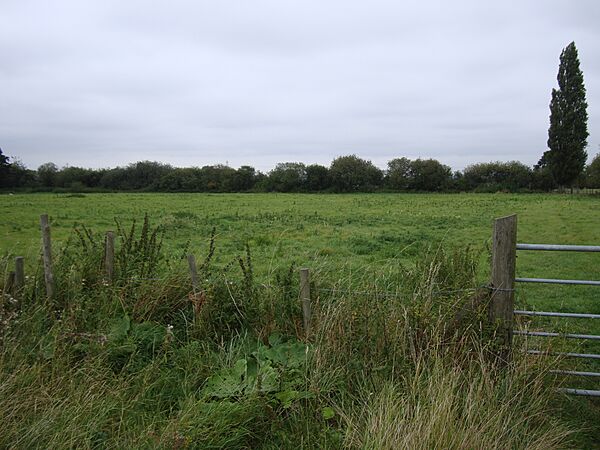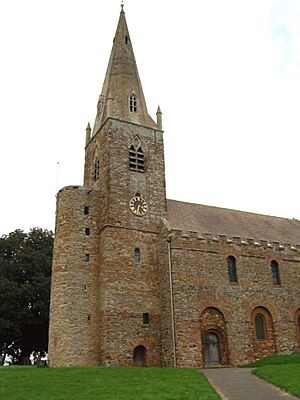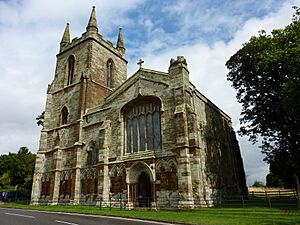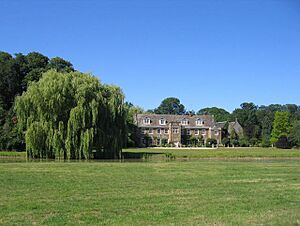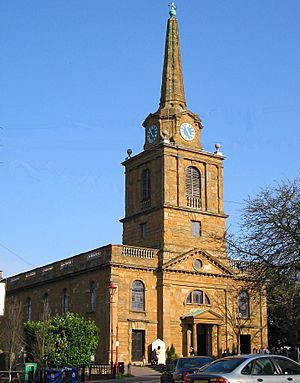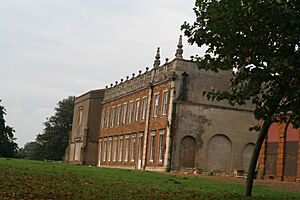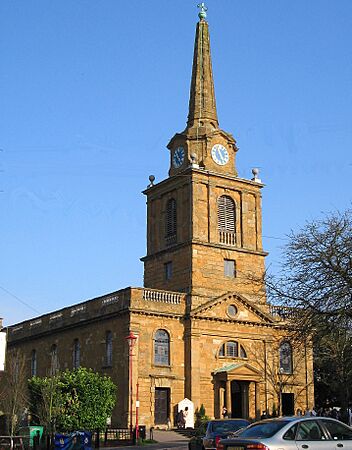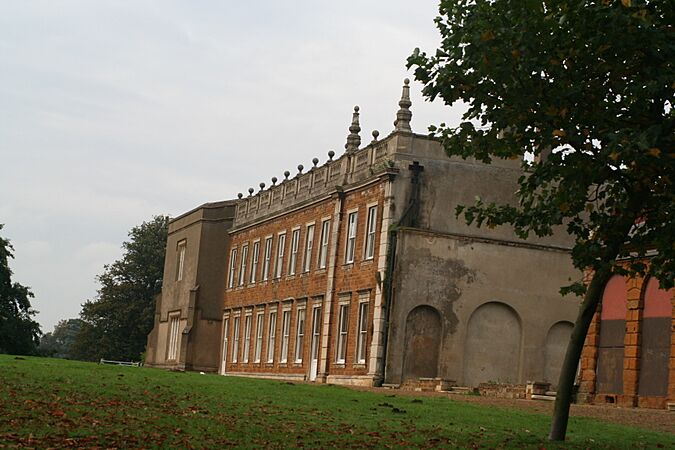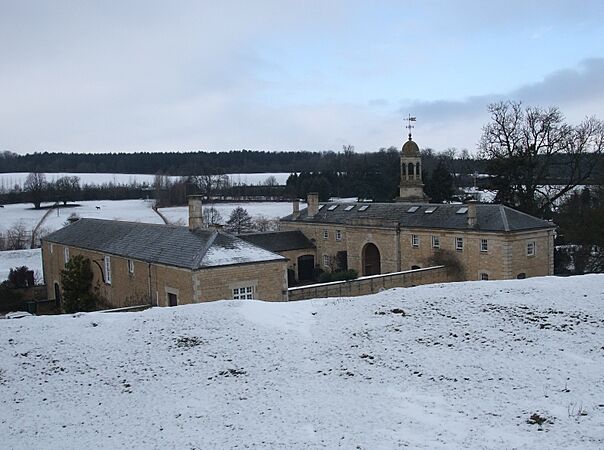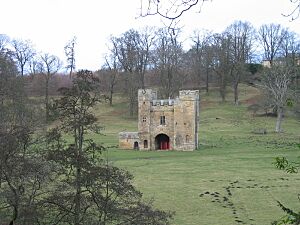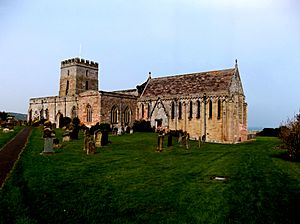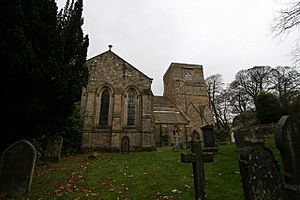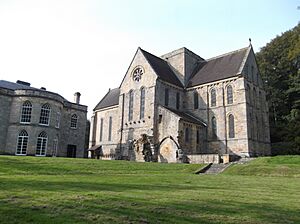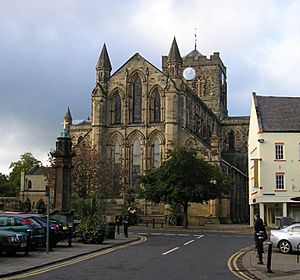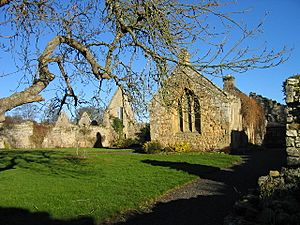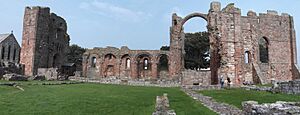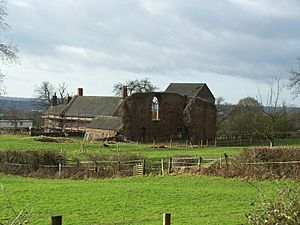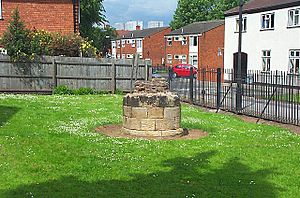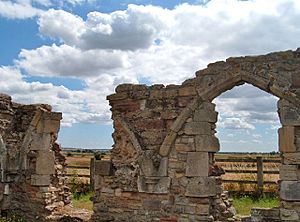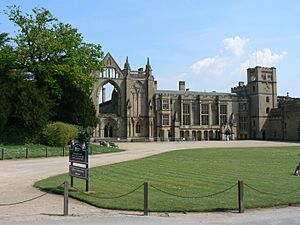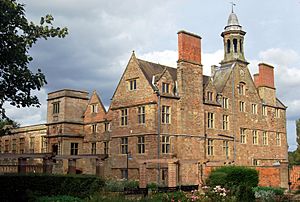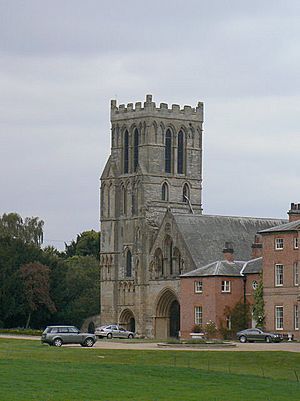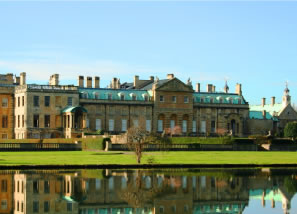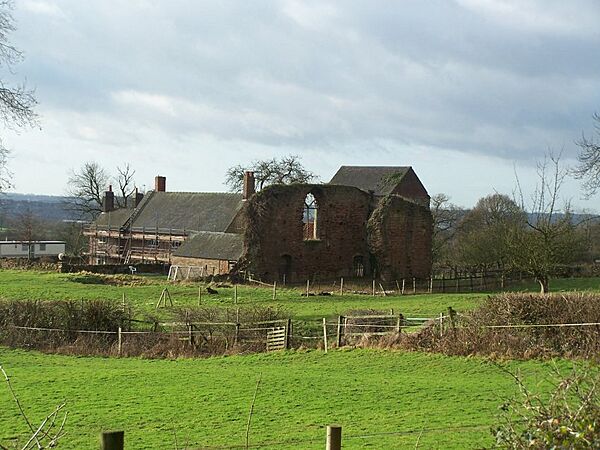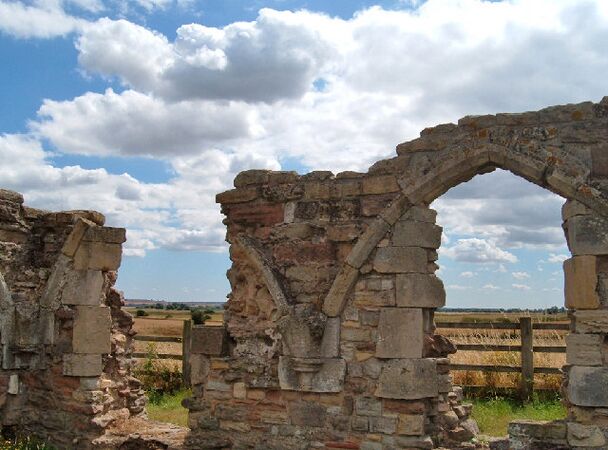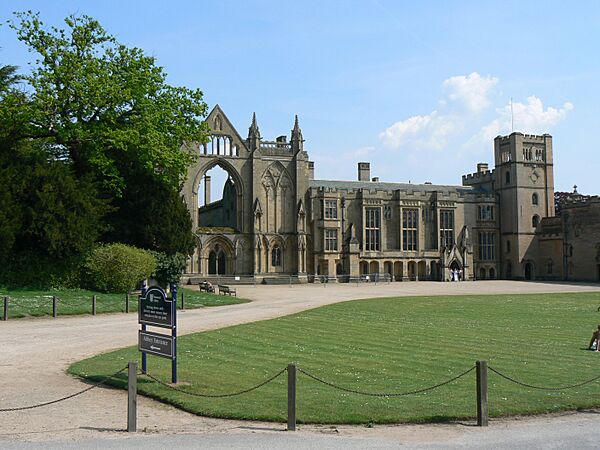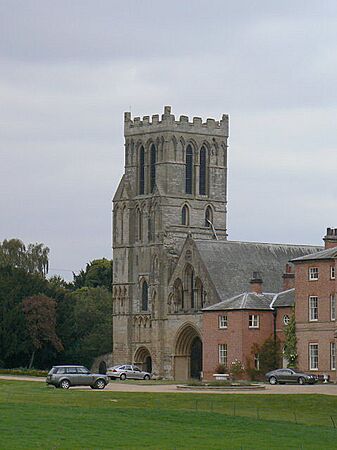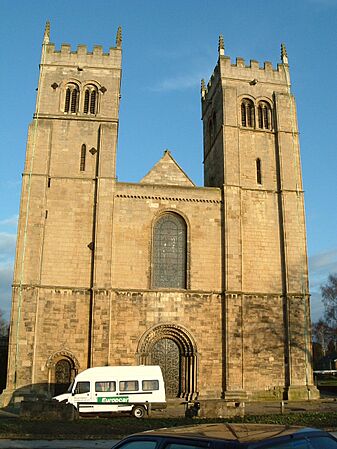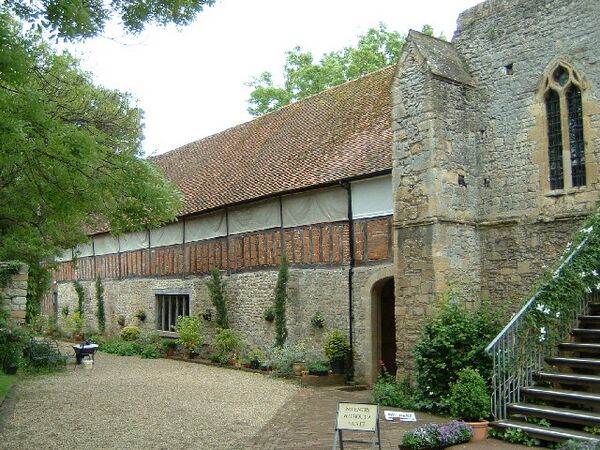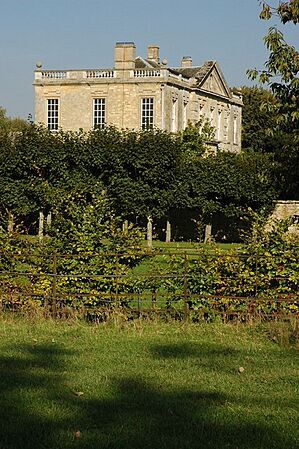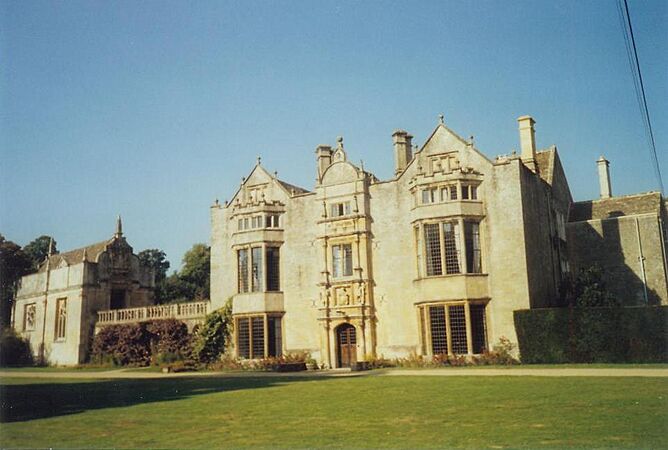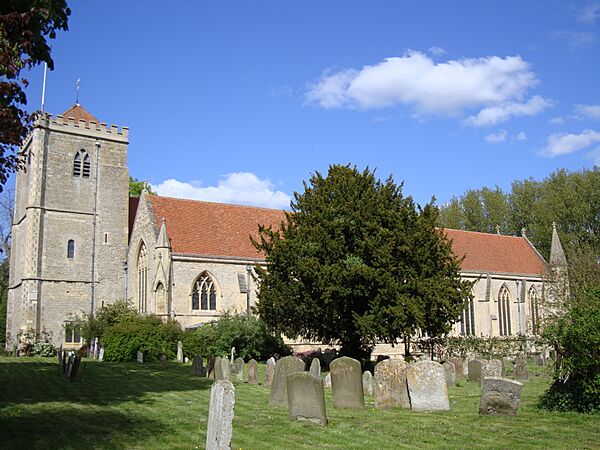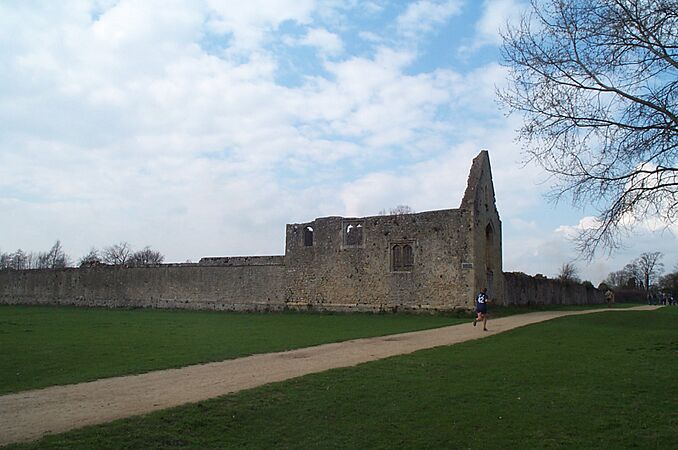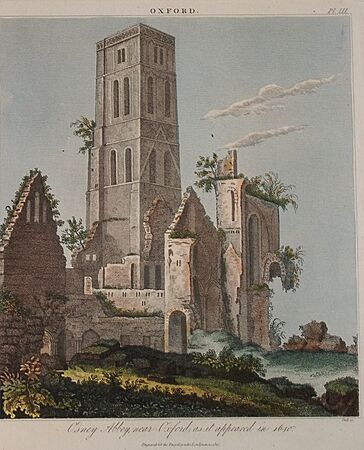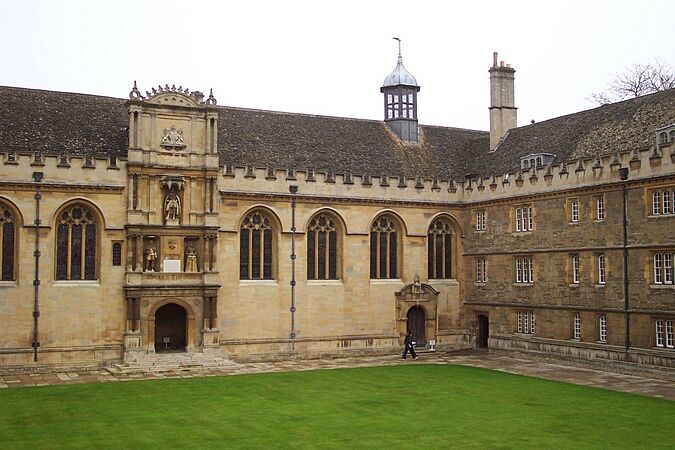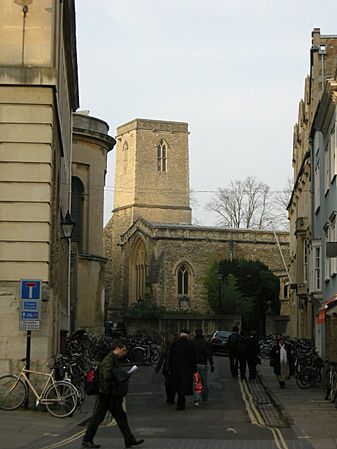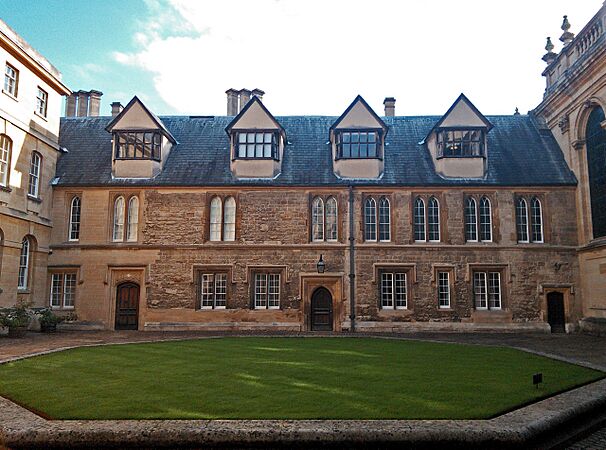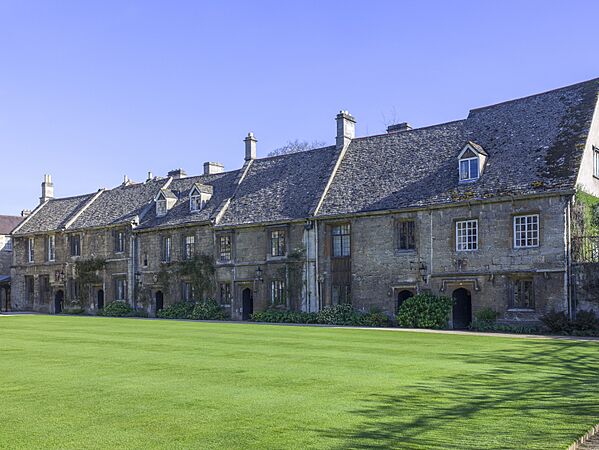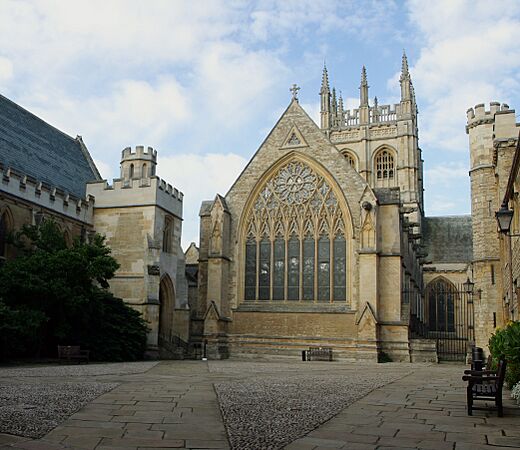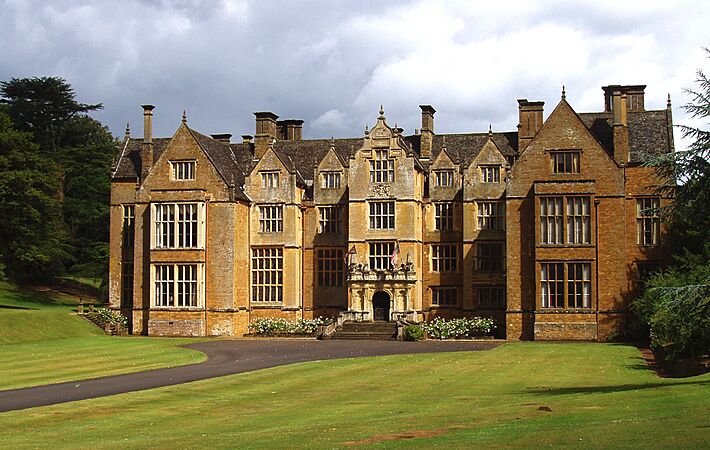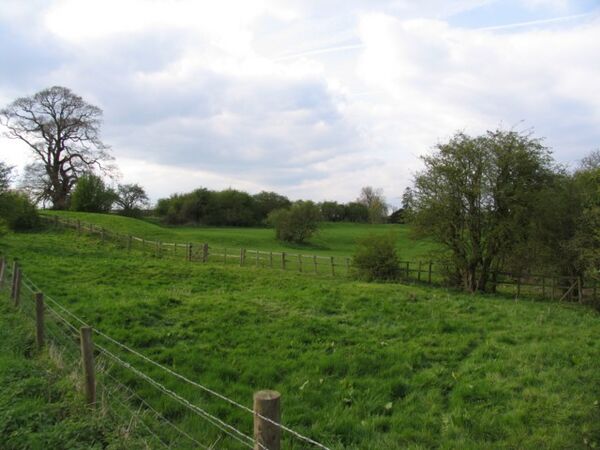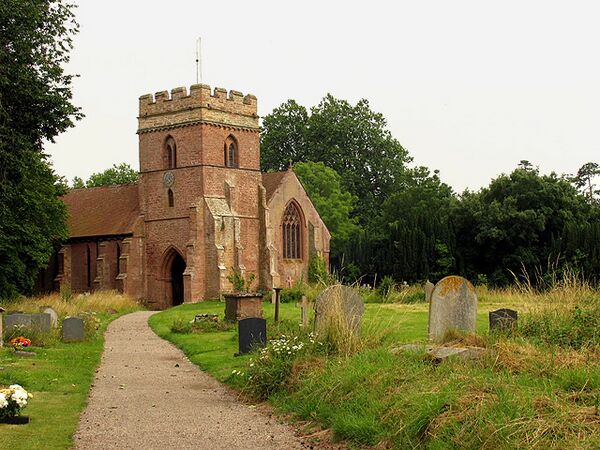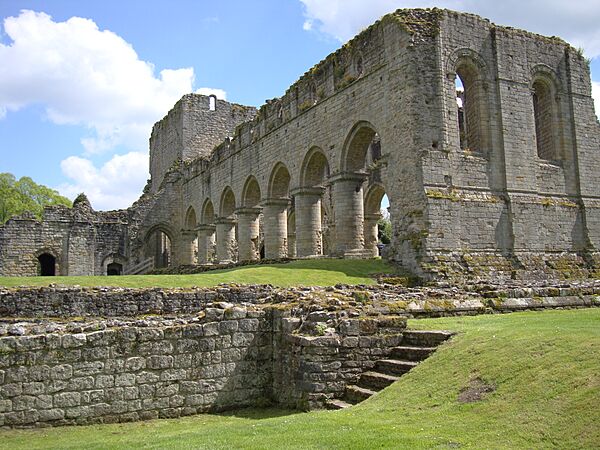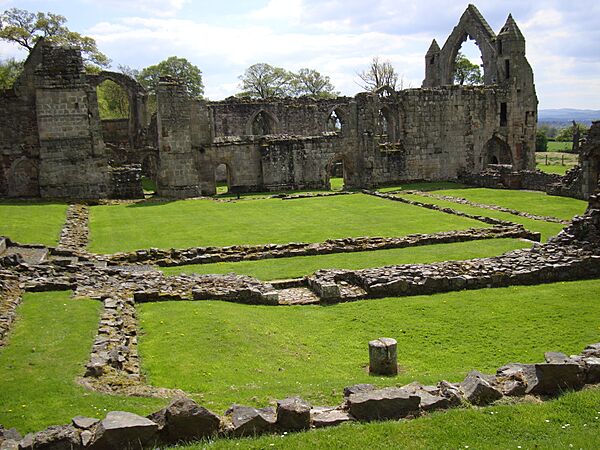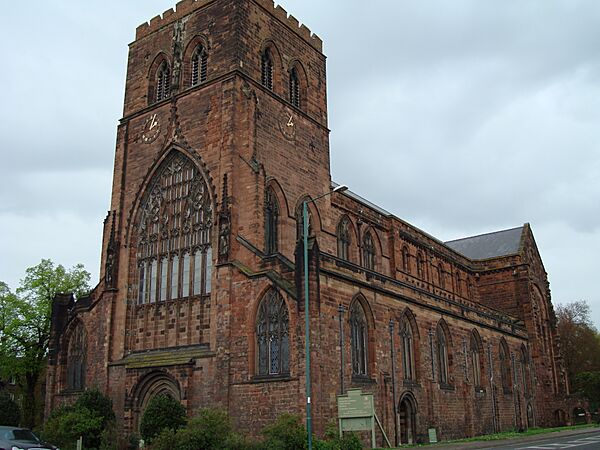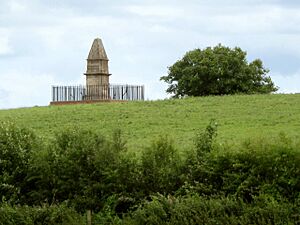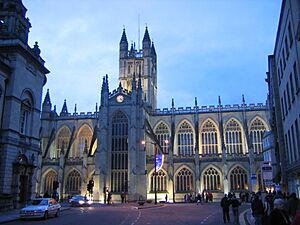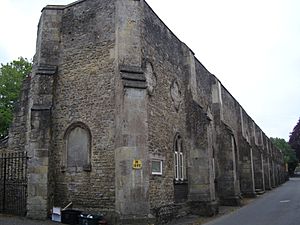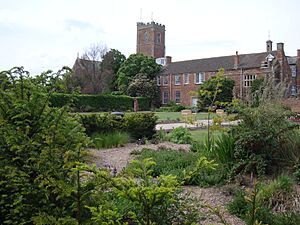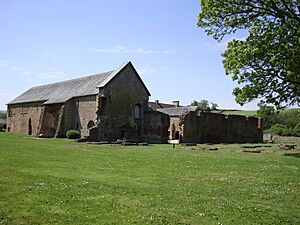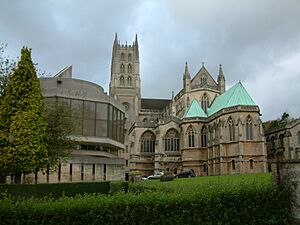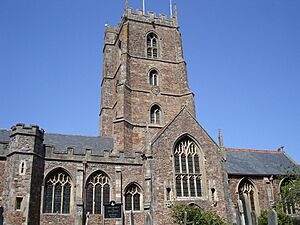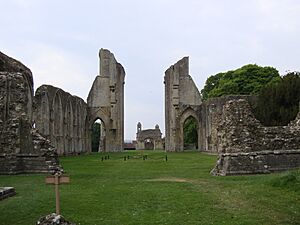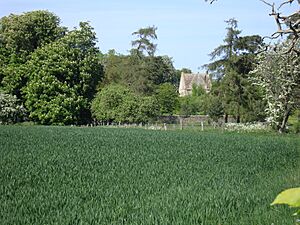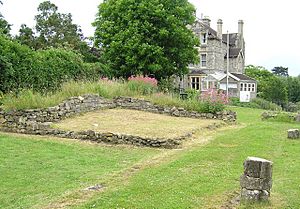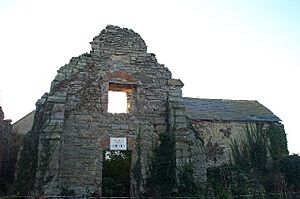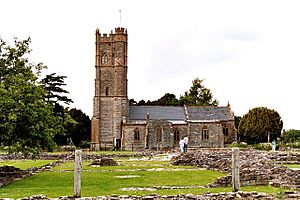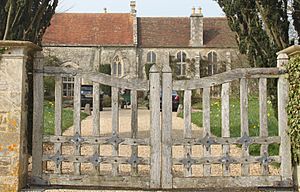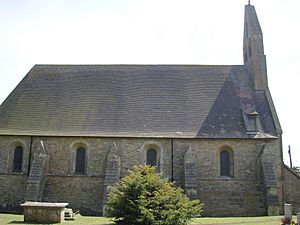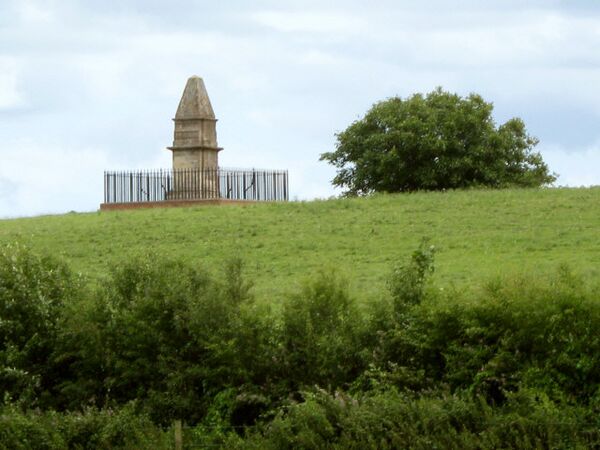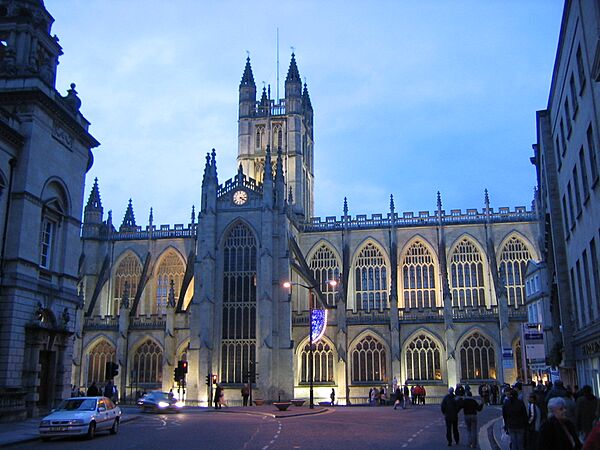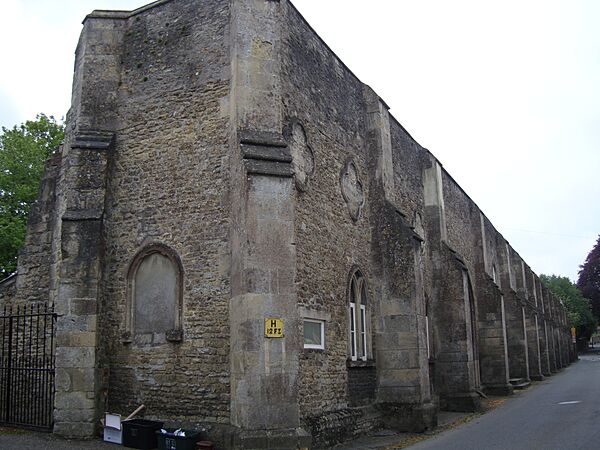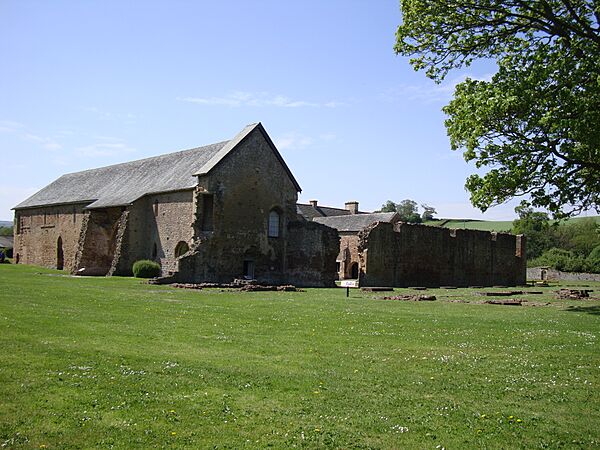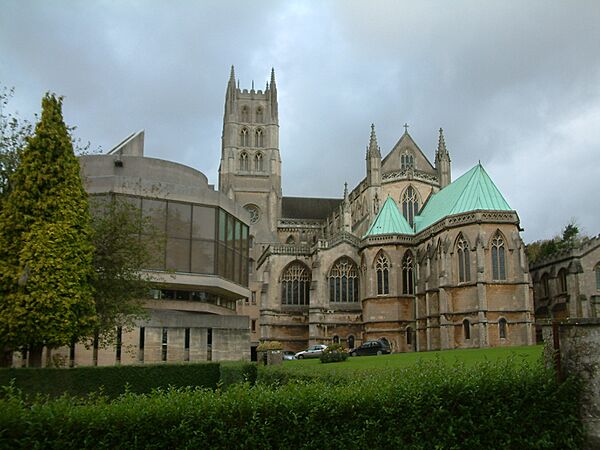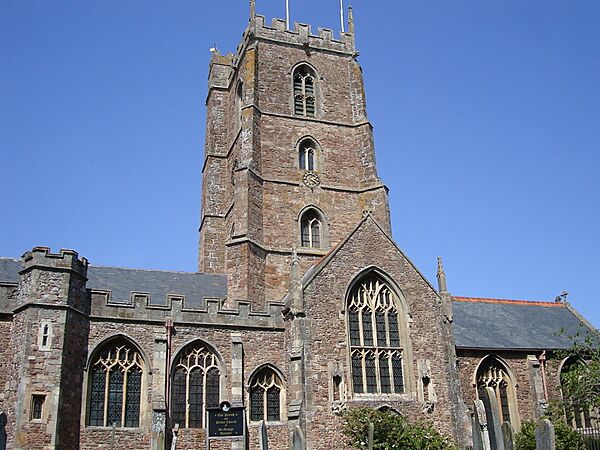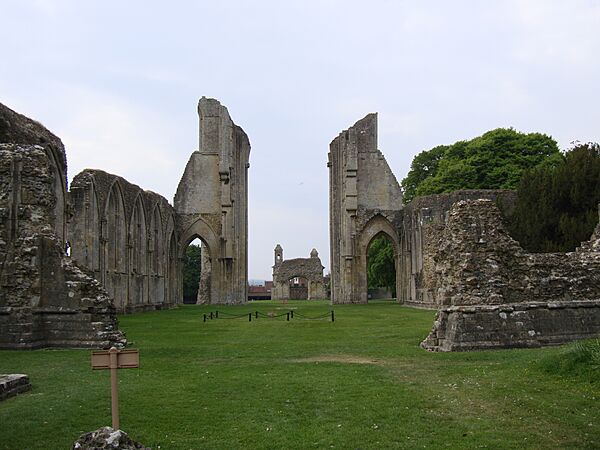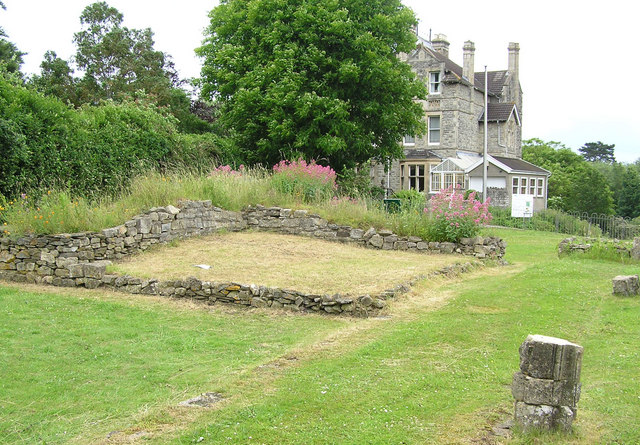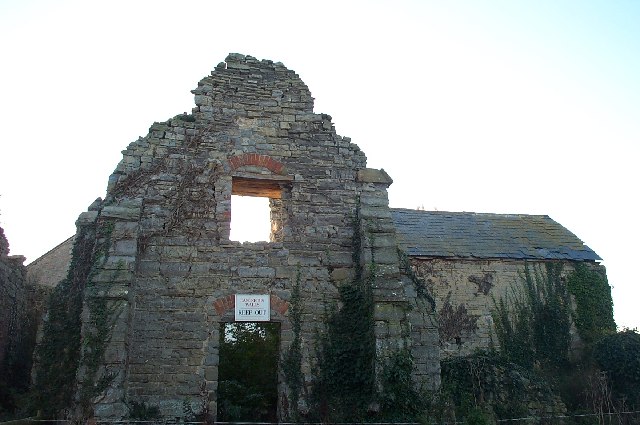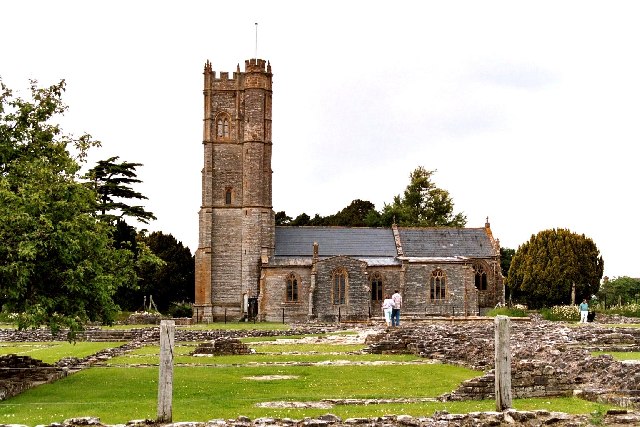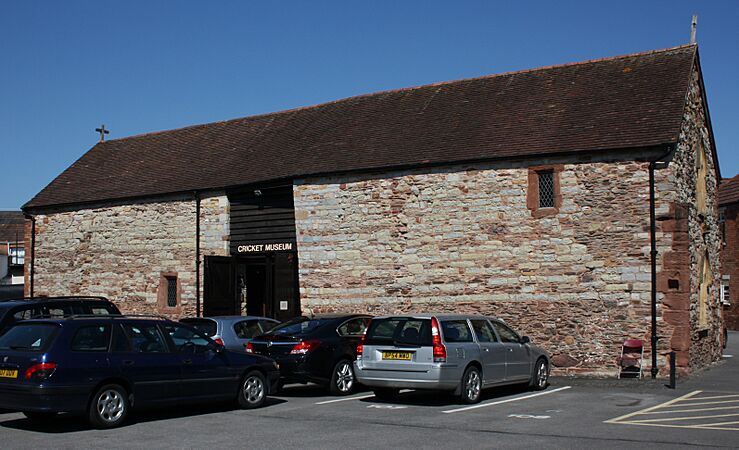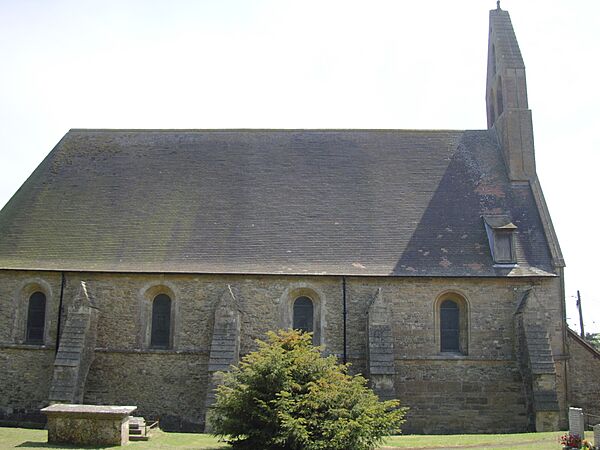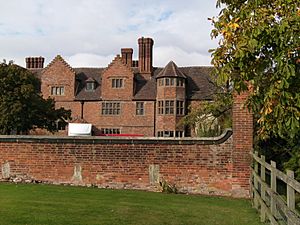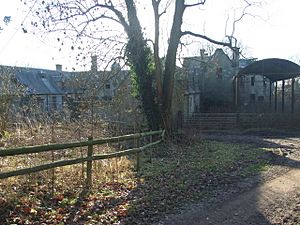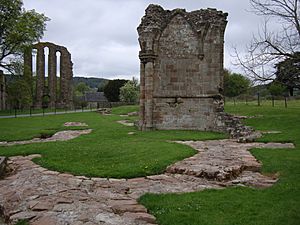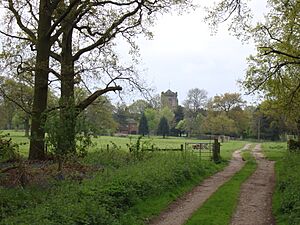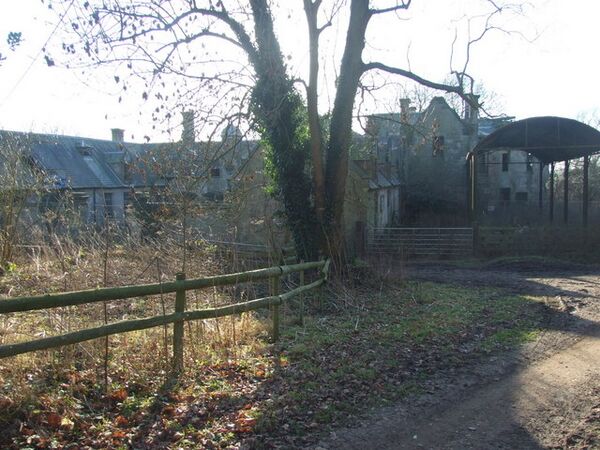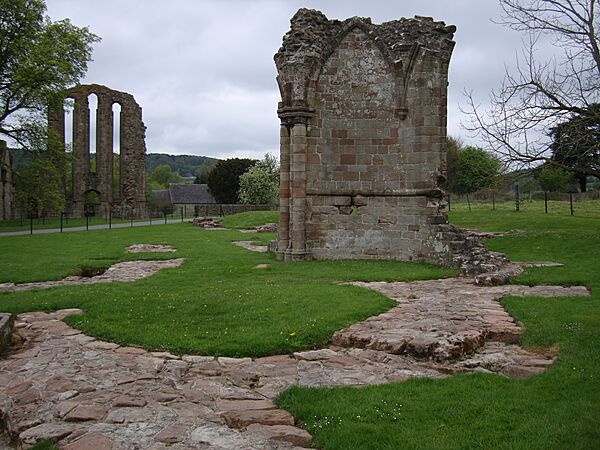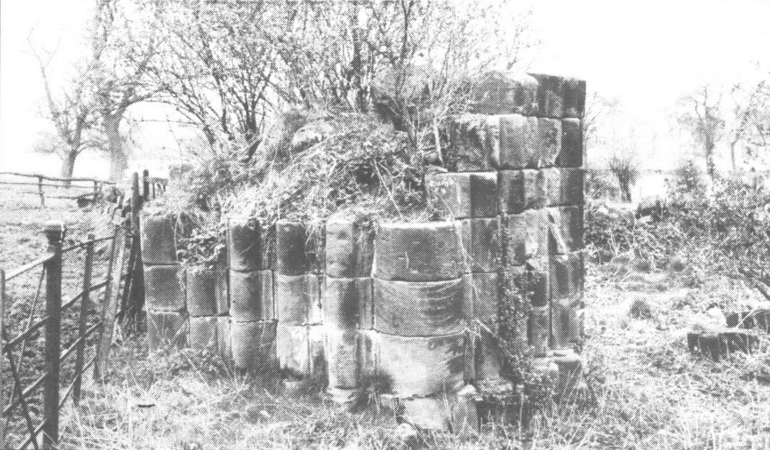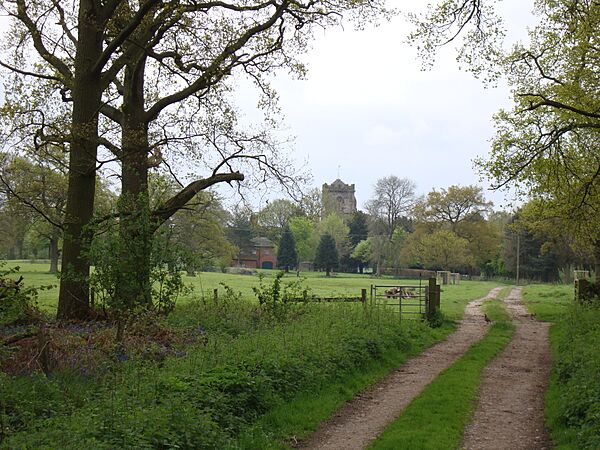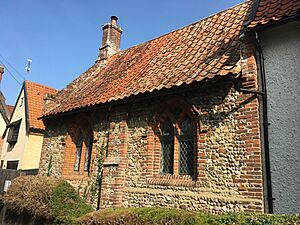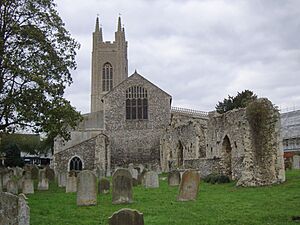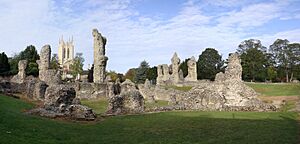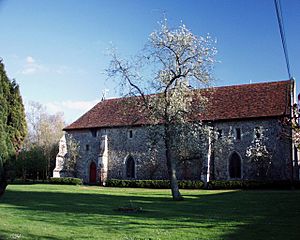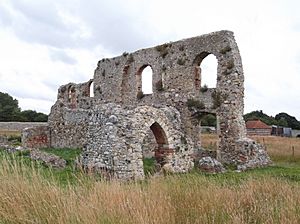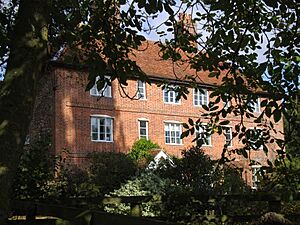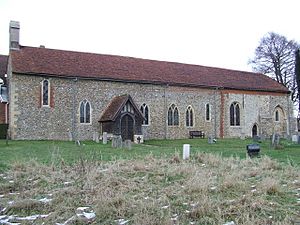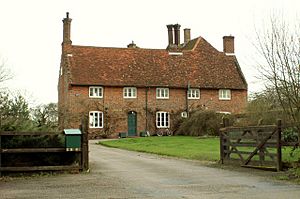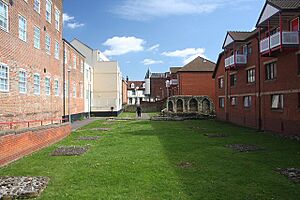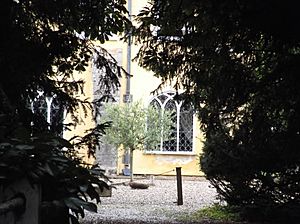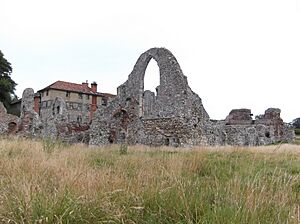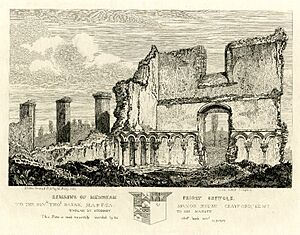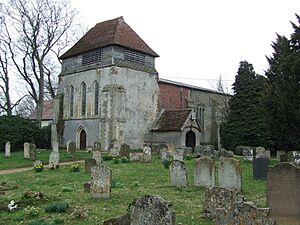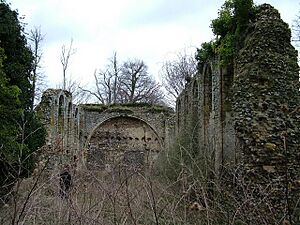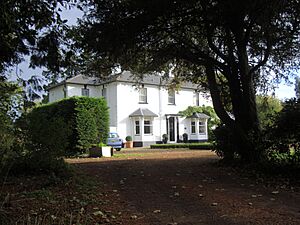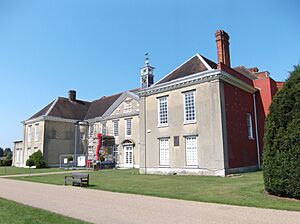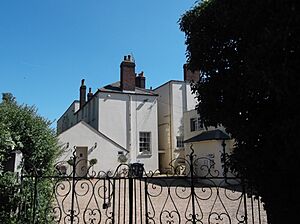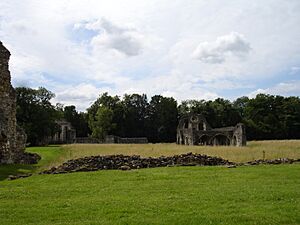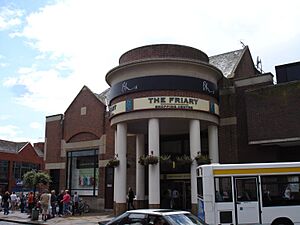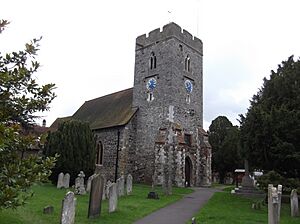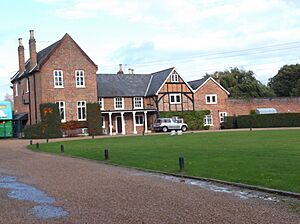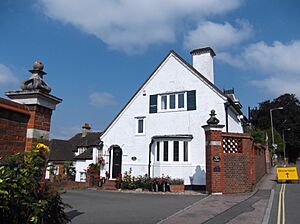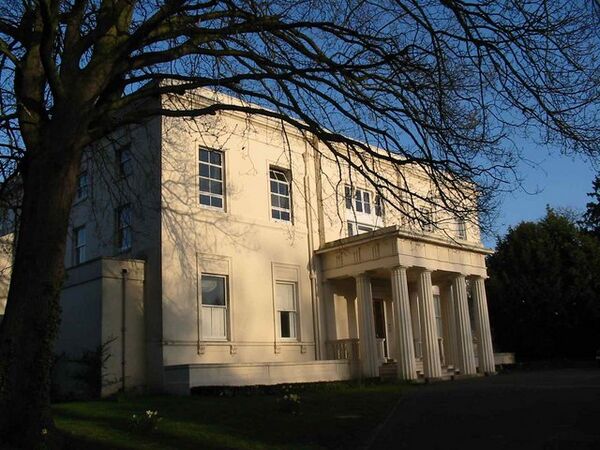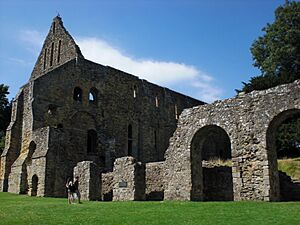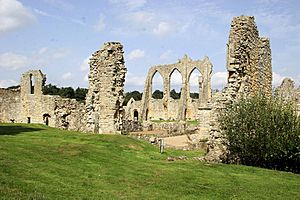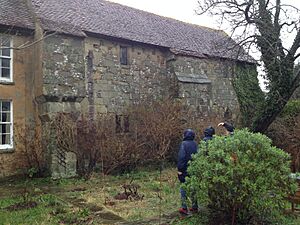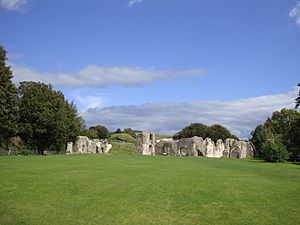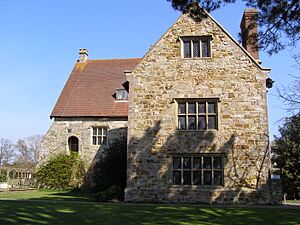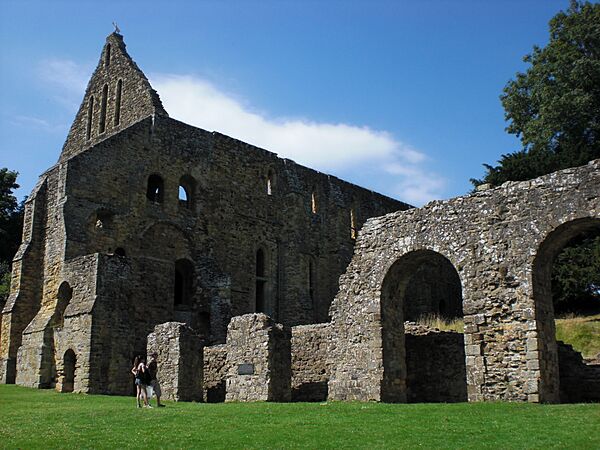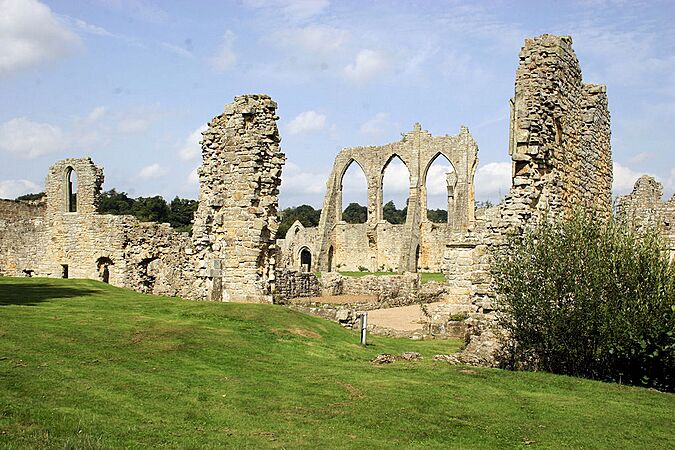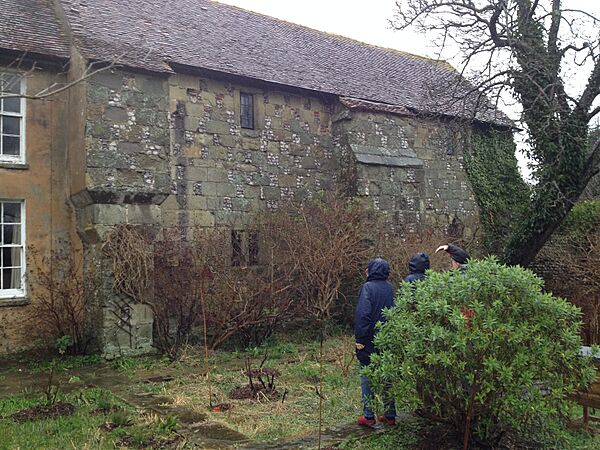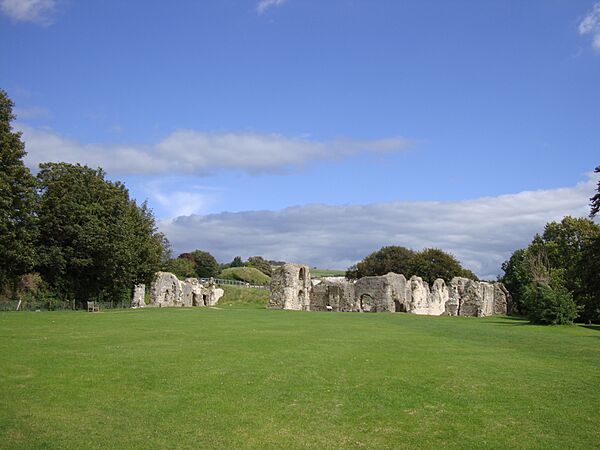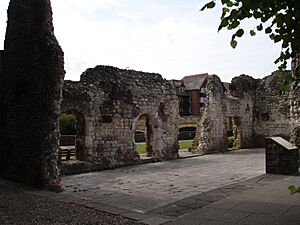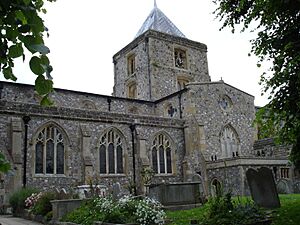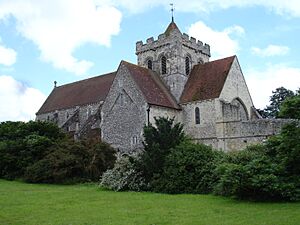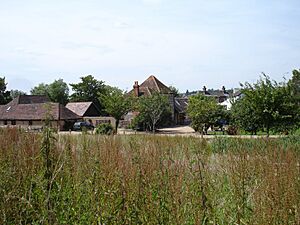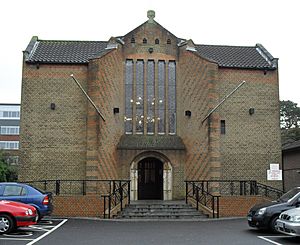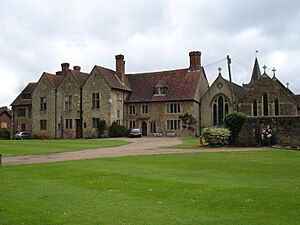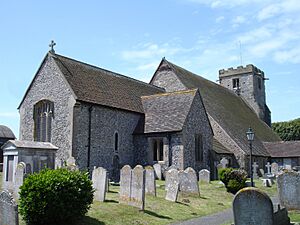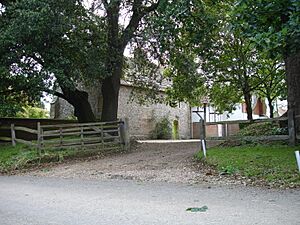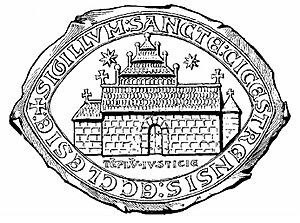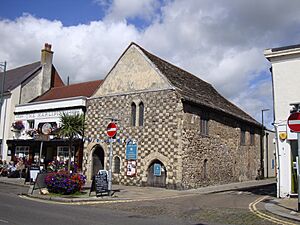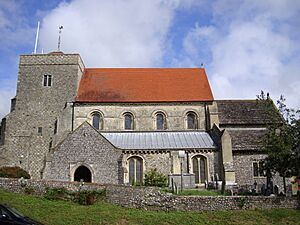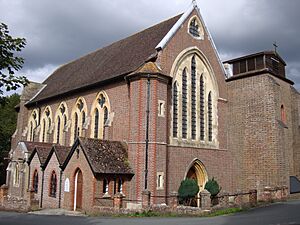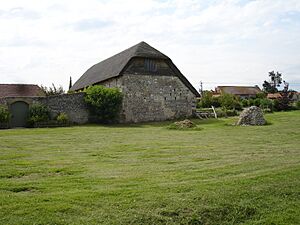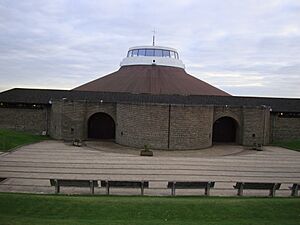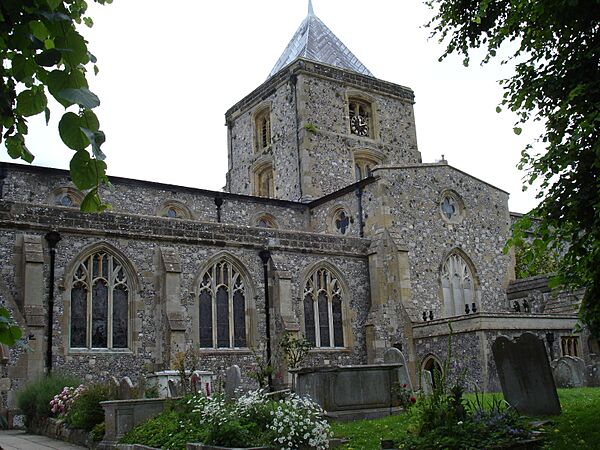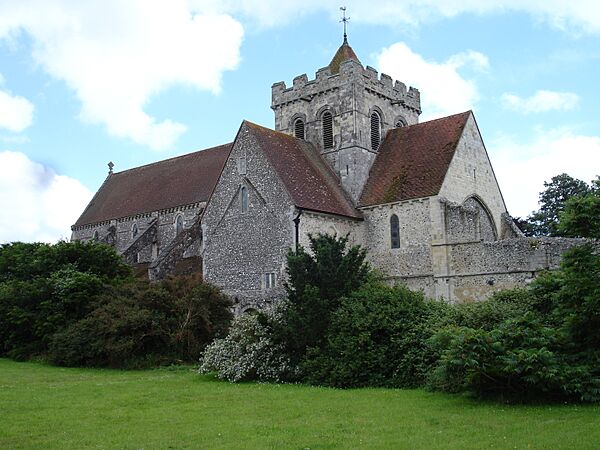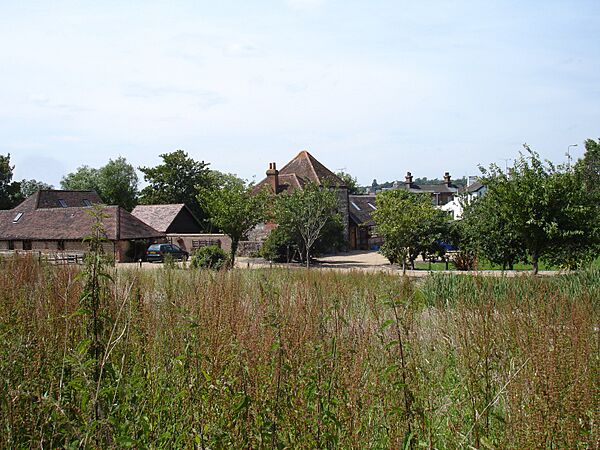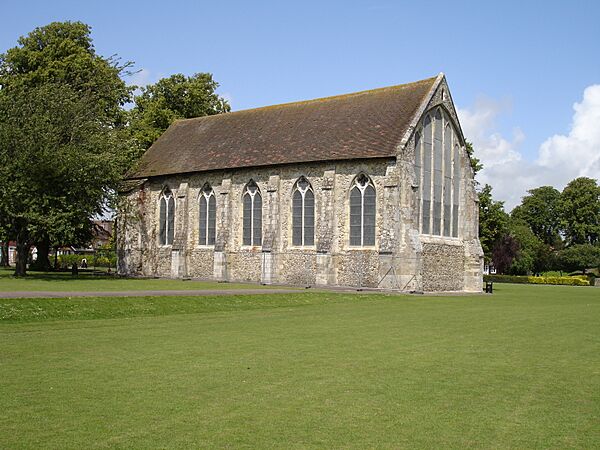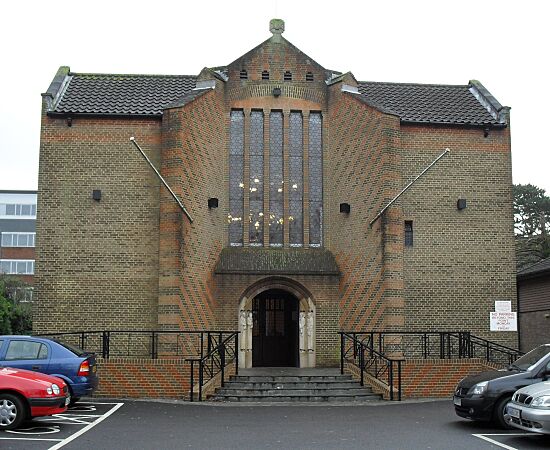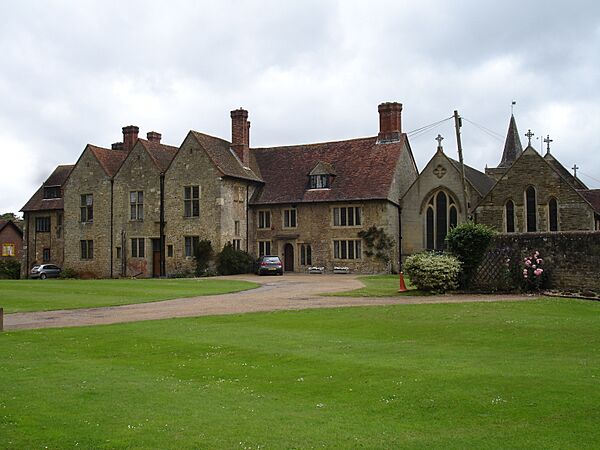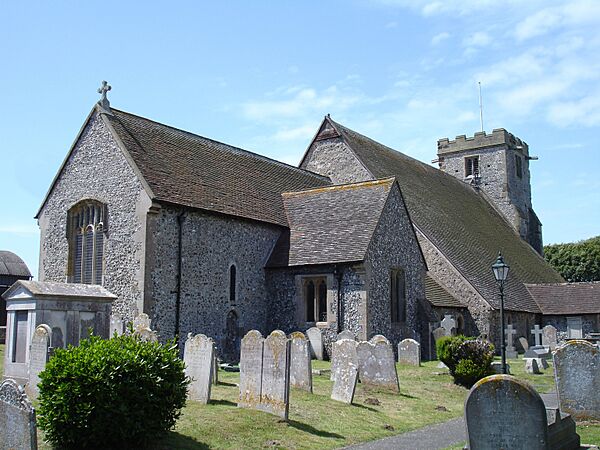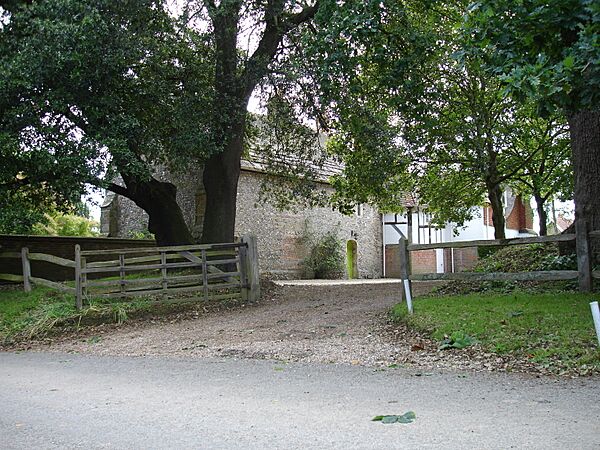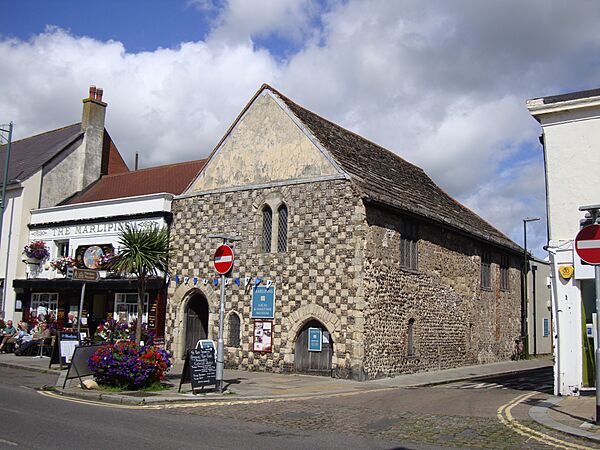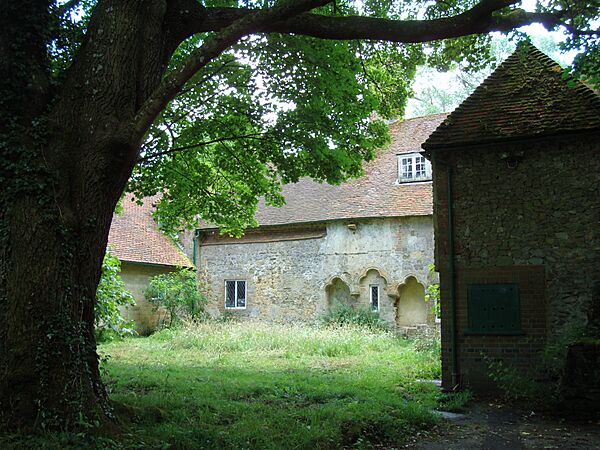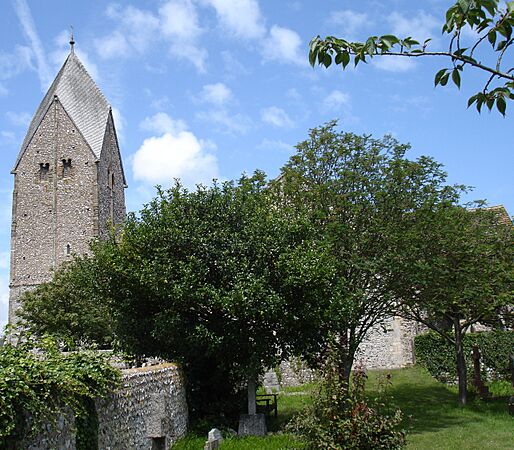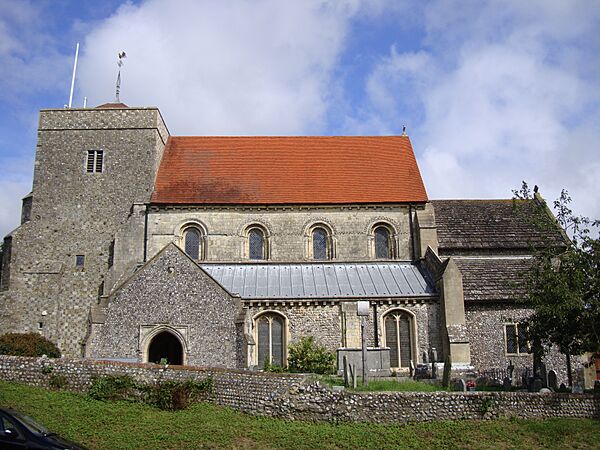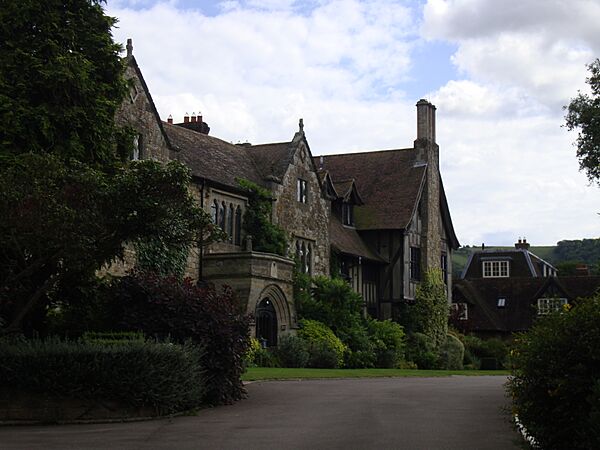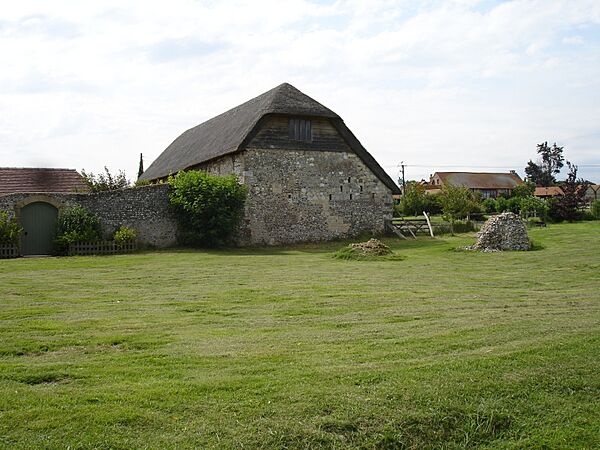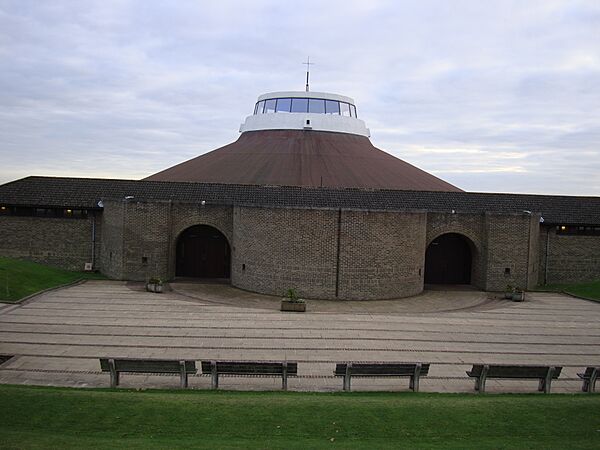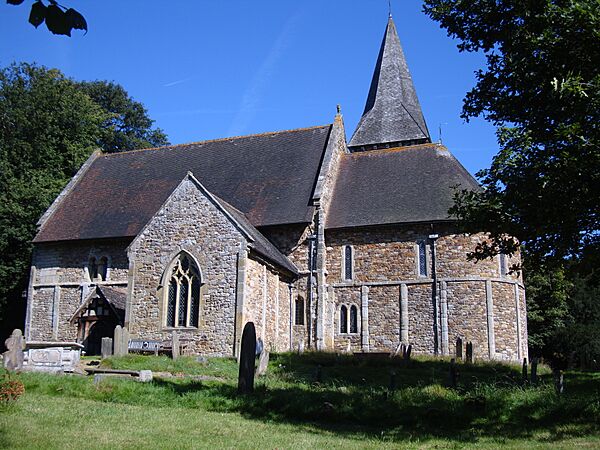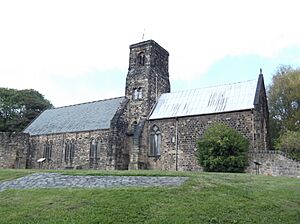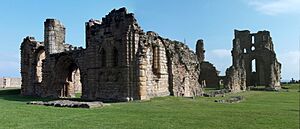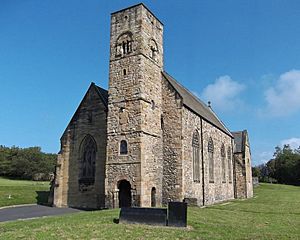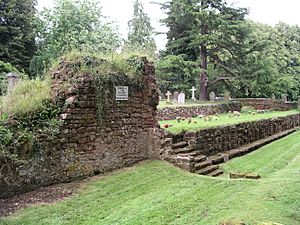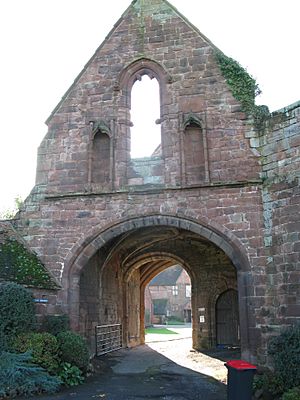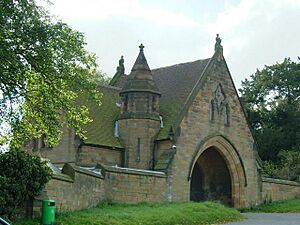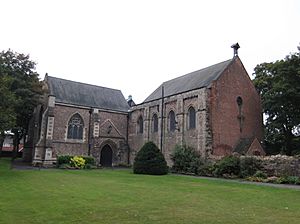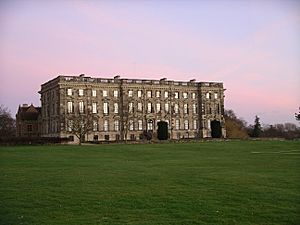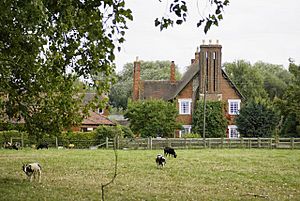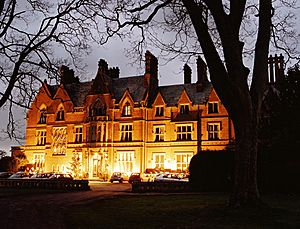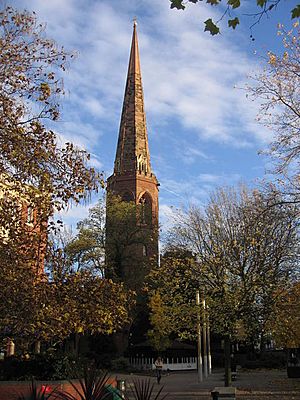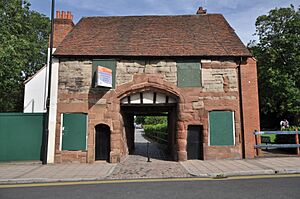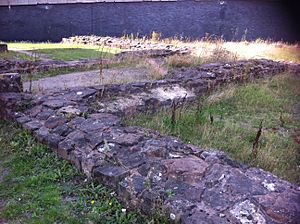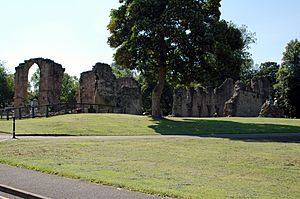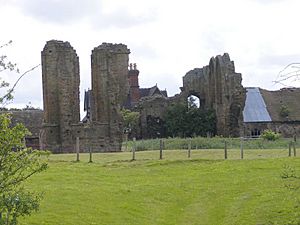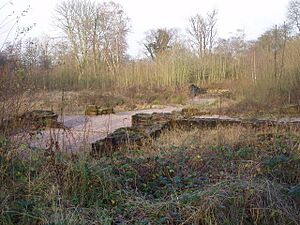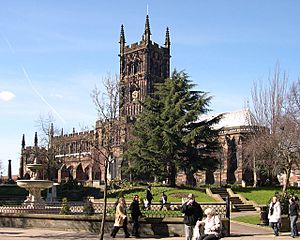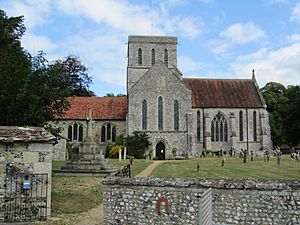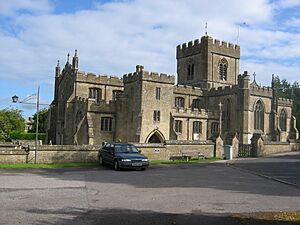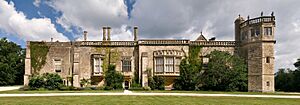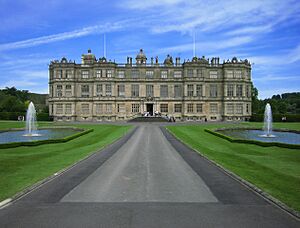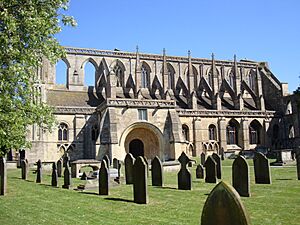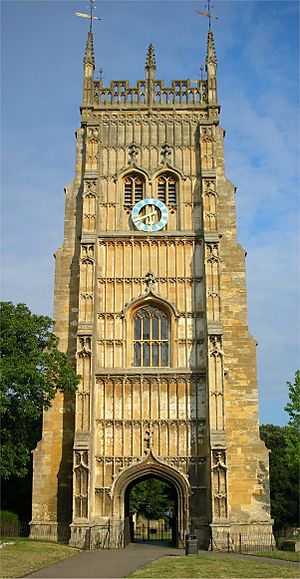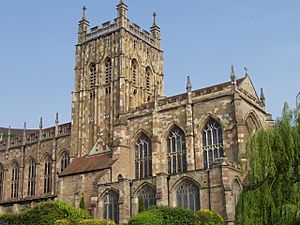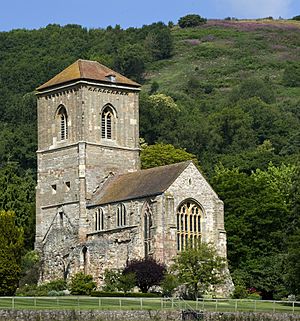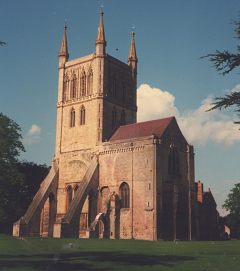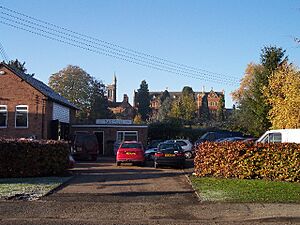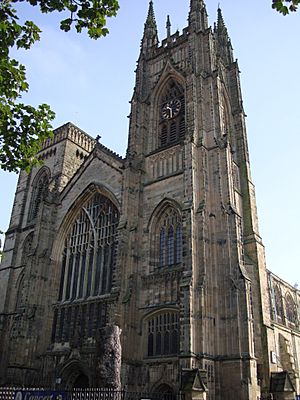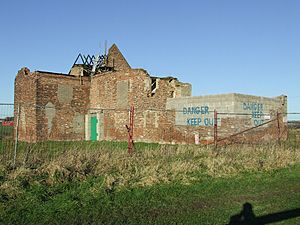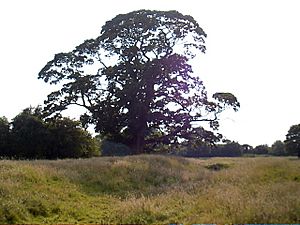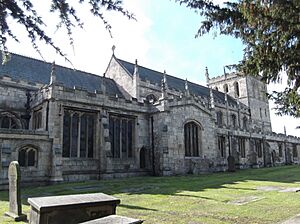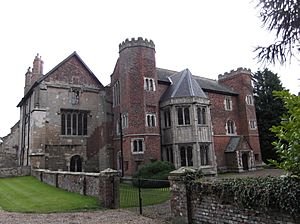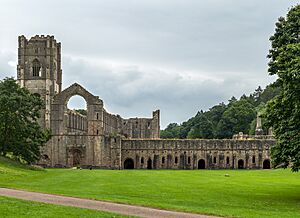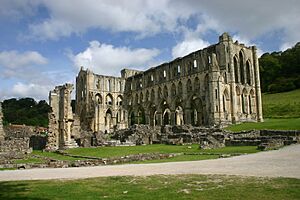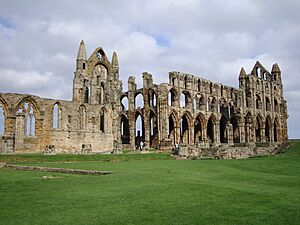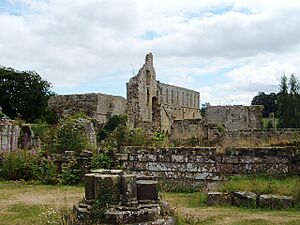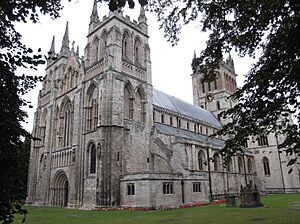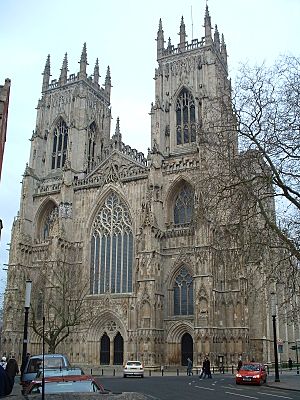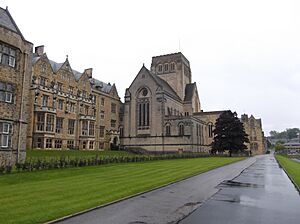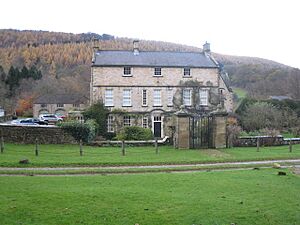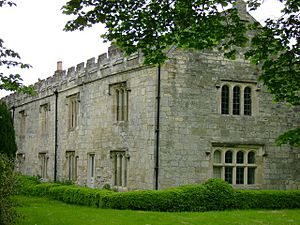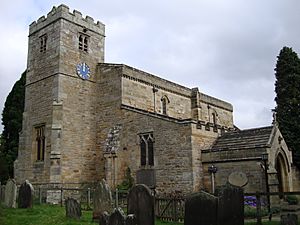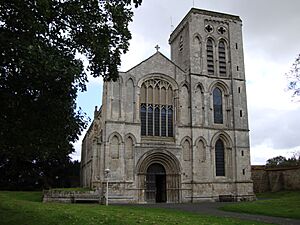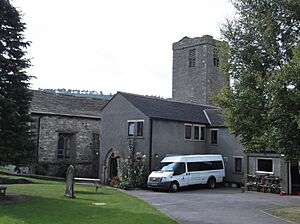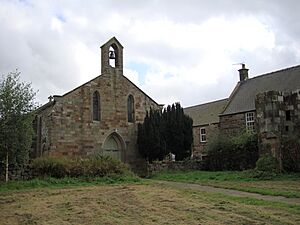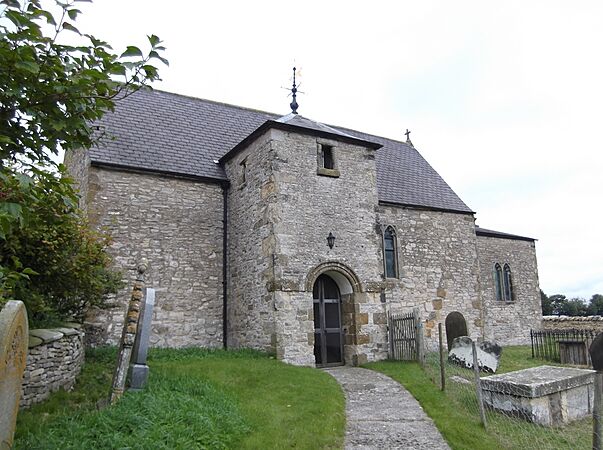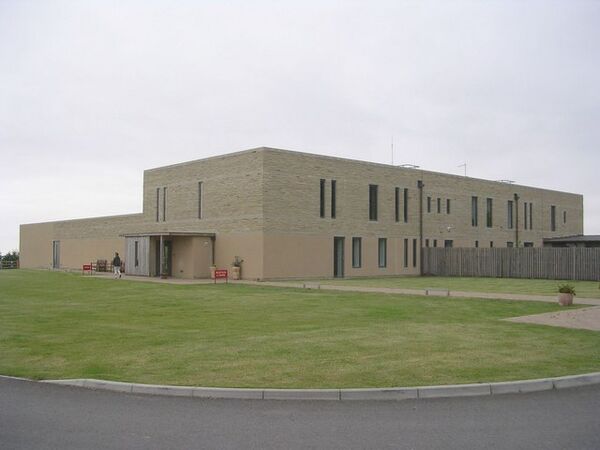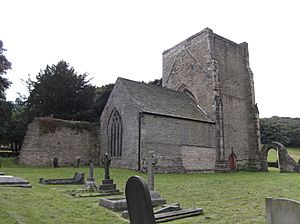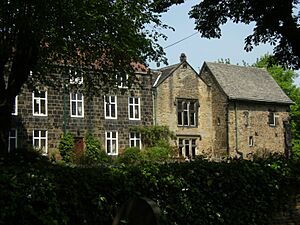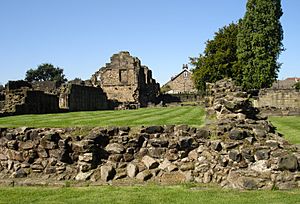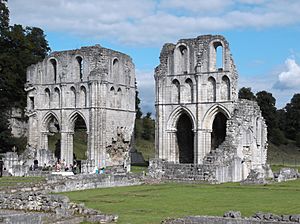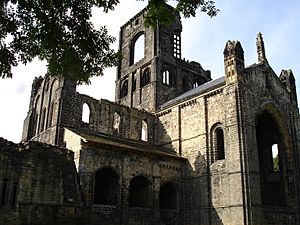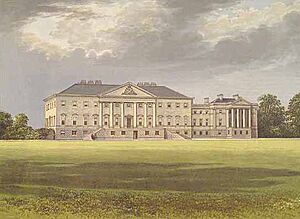List of monastic houses in England facts for kids
Monastic houses in England are special religious buildings like abbeys, priories, and friaries. These were homes for groups of monks or nuns who lived together under religious rules. This article lists many of these important historical sites across England.
The places are listed by their modern county names (counties created after 1974).
What Are Monastic Houses?
This list shows all the monastic houses in England. They are grouped by county, and then listed in alphabetical order within each county.
Each entry tells you about the communities that lived there, like monks or nuns, and when the house was active. It also explains what happened to the building after the Dissolution of the Monasteries (when King Henry VIII closed many of them down) and what the site is used for today.
The formal name or dedication is the official name of the building or the saint it was named after. Sometimes, these places had different names over time, and those are included too.
This list includes different types of monastic sites:
- Alien houses: These were smaller monasteries in England that belonged to larger monasteries in other countries.
- Cells: Very small monastic places, sometimes with only a few monks.
- Monastic granges: Farms owned by monasteries, especially those where monks lived.
- Camerae: Places belonging to military orders like the Knights Templars and Knights Hospitaller, who were both monks and soldiers.
We haven't included most monastic hospitals here, unless they were also considered an abbey, priory, friary, or a place for a preceptor (a leader in a military order).
If a monastic house is mentioned that is in a different county, that county's name is given. If a county's name changed after the house closed, the modern county name is shown in brackets. For very old foundations that existed before England was united, the old kingdom is mentioned, followed by the modern county in brackets.
Understanding the List: Key Symbols
Here's what the symbols in the list mean. Most sites are ruins unless something else is noted.
| * | This place is still used as a monastery today. |
|---|---|
| + | This place is now used for other church activities, or parts of it are in a modern church. |
| ^ | This place is used for something else (not religious), or the building is still standing but not used for its original purpose. |
| $ | Only the earthworks (like mounds or ditches) of the site remain. |
| # | There is no clear sign of the original monastic building left. |
| ~ | We don't know the exact spot where the monastic house was. |
| ≈ | The identification of this site is unclear or might be mixed up with another place. |
If a name is in italics, it might mean:
- It's a mistake and refers to another place.
- It's a place that was planned but never built.
- It's a church that sounds like a monastery but wasn't actually one.
Here are some organizations that look after these sites:
| EH | English Heritage |
| LT | Landmark Trust |
| NT | National Trust for Places of Historic Interest or Natural Beauty |
Alphabetical Listing by County
Bedfordshire
This article is about the old monastic houses in Bedfordshire, England. These were special places where groups of religious people, like monks, nuns, or friars, lived and worked together. They followed strict rules and dedicated their lives to prayer and study.
Some of these places were called alien houses. This means they belonged to a larger monastery in another country, usually France. Smaller places like cells (tiny monasteries) and granges (farmhouses with monks) are also included. We'll also look at places run by military orders, like the Knights Templars and Knights Hospitaller, who were both monks and soldiers.
We won't include regular hospitals here, unless they were also a type of abbey, priory, friary, or preceptory.
What are Monastic Houses?
Monastic houses were communities where people lived a religious life. Monks and nuns lived in abbeys and priories. Friars lived in friaries. These places were very important in medieval England. They were centers for learning, farming, and helping the poor.
Most of these houses were closed down in the 1530s by King Henry VIII. This event is known as the Dissolution of the Monasteries. Many buildings were destroyed, but some parts still stand today.
Monastic Houses in Bedfordshire
Beadlow Priory
Beadlow Priory was home to Benedictine monks. They came from a larger monastery in St Albans, Hertfordshire. Henry d'Albini founded it between 1140 and 1146. The priory was dedicated to Saint Mary Magdalen. The monks left in 1435, and the buildings slowly fell apart.
Bedford Greyfriars
The Franciscan Friars Minor lived at Bedford Greyfriars. They were also known as Greyfriars because of their grey robes. Mabilea de Plateshull founded this friary in 1238. It was closed around 1539.
Bedford Abbey
Bedford Abbey was an early home for Benedictine monks. It was founded before 971. Sadly, it stopped existing many years before 1066. It might have been destroyed during raids by the Danes in 1010.
Bedford Priory
Bedford Priory started as a college for secular canons before 1066. Later, around 1165, it became home to Augustinian Canons Regular. The community moved to a new site at Newnham around 1080. Today, the parish church of St Paul stands on the old site.
Bushmead Priory
Bushmead Priory housed Augustinian Canons Regular. Hugh Beauchamp founded it in 1195. It was dedicated to Saint Mary. The priory was closed in 1536. Today, the old refectory (dining hall) is part of a mansion built on the site. English Heritage looks after it.
Caldwell Priory
Augustinian Canons Regular lived at Caldwell Priory. It was founded around 1154, possibly by Simon Basket. The priory was dedicated to Saint John the Baptist. It was closed in 1536.
Chicksands Priory
Chicksands Priory was a special "double house" for both Gilbertine Canons and Canonesses. This means both monks and nuns lived there, but in separate areas. Pain de Beauchamp and his wife Rose founded it around 1150. The priory was dedicated to Saint Mary. It closed in 1538. Parts of the old cloisters (covered walkways) are now part of a private house. The site was later used as a military base.
Dunstable Blackfriars
The Dominican Friars, also known as Blackfriars, lived at Dunstable Blackfriars. They were invited by King Henry III and his wife in 1259. The friary was closed before May 1539.
Dunstable Priory
Dunstable Priory was home to Augustinian Canons Regular. King Henry I founded it in 1131. The priory was dedicated to Saint Peter. It was closed in 1540. The nave (main part) of the church is still used as a local parish church today.
Elstow Abbey
Elstow Abbey was a community of Benedictine nuns. Judith, who was the niece of William the Conqueror, founded it in 1078. The abbey was dedicated to Saint Mary and Saint Helena. It was closed in 1539. Like Dunstable, the nave of the abbey church is now used as a parish church.
Grovebury Priory
Grovebury Priory in Leighton Buzzard was an alien house for Fontévrault Benedictine monks and nuns. It was a "double house" like Chicksands, but it was dependent on Fontévrault Abbey in France. King Henry II granted the land after 1164. The priory was founded after 1189. It might never have been fully set up as a proper monastery, possibly just a chapel. It was closed in 1414. A farmhouse was later built on the site.
Hardwick Preceptory
Hardwick Preceptory was a base for the Knights Hospitaller. These were military monks who cared for pilgrims and the sick. It was founded before 1279 and closed before 1489.
Harrold Priory
Harrold Priory was home to Augustinian Canonesses. Sampson le Forte founded it in 1138. It was originally an alien house, connected to Arrouaise in Normandy, France. However, it became independent in 1188. The priory was dedicated to the Blessed Virgin Mary and Saint Peter. It was closed in 1536. Today, a farmhouse and a mansion called 'Harrold Hall' are on the site.
Harrold Priory Cell
A small cell for Augustinian Canons Regular was attached to Harrold Priory. It was founded around 1136-1138 and closed before 1181.
Leighton Buzzard Cell
This was a small cell or grange for Cistercian monks. It was dependent on Woburn Abbey. It was founded before 1159.
Melchbourne Preceptory
Melchbourne Preceptory was another base for the Knights Hospitaller. Lady Alice de Claremonte founded it before 1176. It was closed in 1486. The Knights Hospitaller briefly got it back under Queen Mary.
Millbrook Priory
Millbrook Priory was a small priory cell for Benedictine monks. It was dependent on St Albans Abbey. The church was granted to St Albans between 1097 and 1119. It was later merged with Beadlow Priory around 1143.
Newnham Priory
Newnham Priory was home to Augustinian Canons Regular. The community originally started at Bedford Priory around 1165. They moved to Newnham around 1180. The priory was dedicated to Saint Paul. It was closed in 1540.
Pulloxhill Grange
Pulloxhill Grange was a farm belonging to Dunstable Priory. It was run by Augustinian Canons Regular. After the Dissolution, it was granted to Sir William Pagett in 1547.
Ruxox Cell
Ruxox Cell was a small cell or chapel for retired Augustinian Canons Regular from Dunstable Priory. It was founded before 1189 and closed after 1290. The chapel was dedicated to Saint Nicholas.
Turvey Abbey
Turvey Abbey is unique because it is still active today! It is home to Benedictine nuns. It is next to a Benedictine monastery.
Turvey Monastery
Turvey monastery is a modern monastery for Benedictine monks. It was founded in 1980 and is still active. It is located next to Turvey Abbey.
Warden Abbey
Warden Abbey was a large abbey for Cistercian monks. Walter Espec founded it in 1136. It was dedicated to the Blessed Virgin Mary. The abbey was closed on December 4, 1538. An Elizabethan house was later built on the site, and some parts of it still remain. The Landmark Trust renovated it in 1974.
Woburn Abbey
Woburn Abbey was another important abbey for Cistercian monks. It was a "daughter house" of Fountains Abbey in Yorkshire, meaning it was founded by monks from Fountains. Hugh de Bolebec founded it on May 28, 1145. The abbey was dedicated to the Blessed Virgin Mary. It was closed in 1538. Today, a large mansion, estate, and safari park are on the site.
See also
- List of monastic houses in EnglandReturn to top of page
Berkshire
Monastic houses are special places where groups of people, like monks or nuns, lived together. They dedicated their lives to religious practices, prayer, and often helped their local communities. In England, many of these houses were built a long time ago, some even before the Norman Conquest in 1066! This article tells you about the different monastic houses that once existed, or still exist, in the county of Berkshire.
You can see where these old houses were located on the maps below. The first map shows the main locations across Berkshire, and the second map zooms in on the town of Reading.
This list includes different types of monastic places:
- Alien houses: These were smaller monasteries in England that were controlled by a larger monastery in another country.
- Cells: Very small monastic communities, often with just a few monks or nuns.
- Monastic granges: These were farms owned by monasteries, sometimes with monks living there to manage the land.
- Camerae: These were special places for military orders, like the Knights Templars and Knights Hospitaller. These groups were both monks and soldiers!
We haven't included hospitals here, unless they were also known as an abbey, priory, friary, or preceptory.
Alien houses are included, as are smaller establishments such as cells and notable monastic granges (particularly those with resident monks), and also camerae of the military orders of monks (Knights Templars and Knights Hospitaller). Monastic hospitals are included where they had the status or function of an abbey, priory, friary or preceptor/commandery.
- Abbreviations and key
| Symbol | Status |
|---|---|
| None | Ruins |
| * | Current monastic function |
| + | Current non-monastic ecclesiastic function (including remains incorporated into later structure) |
| ^ | Current non-ecclesiastic function (including remains incorporated into later structure) or redundant intact structure |
| $ | Remains limited to earthworks etc. |
| # | No identifiable trace of the monastic foundation remains |
| ~ | Exact site of monastic foundation unknown |
| ≈ | Identification ambiguous or confused |
Locations with names in italics indicate possible duplication (misidentification with another location) or non-existent foundations (either erroneous reference or proposed foundation never implemented) or ecclesiastical establishments with a monastic name but lacking actual monastic connection.
| EH | English Heritage |
| LT | Landmark Trust |
| NT | National Trust |
Monastic Houses in Berkshire
Ankerwycke Priory
This priory was home to Benedictine nuns. It was started around 1160 by Gilbert de Mountfitchet. The priory was closed down before 1536. Today, you can still see some of its ruins in the grounds of Ankerwycke House.
Ascot Priory
Unlike many old monastic houses, Ascot Priory is still active today! It was founded in 1861 and is home to Anglican nuns.
Bisham Abbey and Preceptory
Bisham has a long history with two different monastic groups.
- Bisham Priory: First, Augustinian Canons Regular started a priory here in 1337. It was closed in 1536.
- Bisham Abbey: Then, in 1537, King Henry VIII refounded it as an abbey for Benedictine monks. These monks had moved from Chertsey Abbey. This abbey was closed just a year later in 1538.
- Bisham Preceptory: Before the priory, the Knights Templar had a preceptory here, founded before 1139. A preceptory was like a local headquarters for these military monks. The Knights Templar group was dissolved between 1308 and 1312.
Today, the site of Bisham Abbey and Preceptory is the headquarters for the National Sports Council.
Bradfield Abbey
This was a place for monks that was recorded in 1066. King Ine of Wessex gave land to Abbot Hean of Abingdon to start a monastery here between 688 and 690. We don't know much more about it or its exact location.
Bradley Priory
This was a small place for Benedictine monks that belonged to Abingdon Abbey. It was described as a 'priory' in 1547, but its exact status and location are not fully known.
Bromhall Priory
This priory in Sunningdale was home to Benedictine nuns. It was a daughter house of Chertsey Abbey in Surrey. It was founded before 1200 by Edward, the Black Prince. Sadly, it was accidentally burnt down in 1462. It closed in 1521 when the last prioress died. The land was then given to St John's College, Cambridge. Any remains of the priory were either destroyed or built into farm buildings.
Cold Ash Centre
This is a modern monastic house for Franciscan Friars Minor and sisters. It was founded in the 1930s and is still active today as a novitiate house, where new members train.
Cookham Abbey
This was likely a 'double monastery', meaning it housed both monks and nuns. It was founded before 726. The land was given to Canterbury Cathedral, then taken by Kings Æthelbald and Coenwulf, and later given back. Today, the local church stands on what is thought to be the site of the old abbey.
Donnington Friary
This friary was for the Crouched Friars, also known as Crossed Friars. It was founded before 1404. It was closed in 1538. Today, a country house called 'The Priory' stands on the site.
Douai Abbey
This abbey is home to Benedictine monks. The community originally started in Douai, Belgium, in 1615. They moved to Woolhampton in Berkshire in 1903 and are still active today. It is known as The Abbey Church of Saint Edmund, King and Martyr.
Greenham Preceptory
This was a preceptory for the Knights Hospitaller, another military order. It was founded around 1180. The last leader (preceptor) died in 1442. By 1445, it became part of the larger estate of the prior of England. It was closed in 1540 but was briefly reopened under Queen Mary I.
Hurley Priory
This priory was for Benedictine monks. It was founded before 1087, possibly in 1065. It was given by Godfrey de Magna Villa to the Benedictines of Westminster to start a small community (a 'cell'). It was closed in 1536. Today, the nave (main part) of the old priory church is still used as a local church.
Kintbury Abbey
This might have been a Saxon abbey, minster, or small chapel. It was founded before 931. Later, in 1147, land was given to Fontevrault Benedictine nuns and brothers to start a monastery. This community later moved to Nuneaton. A plan to restart a monastery here probably never happened.
Poughley Priory
This priory was for Augustinian Canons Regular. It was founded around 1160 by Ralph de Chaddleworth. It was closed in 1524 and given to Cardinal Wolsey's college at Oxford. Some remains of the priory, like a cellar, are now part of a farmhouse, but you can't visit them.
Reading Abbey
This was a very important abbey for Cluniac monks, founded in 1121 by King Henry I. It was refounded for Benedictine monks around 1210. The abbey was closed in 1539. After it closed, its stones were used to build other things, and it was slowly taken apart between 1550 and 1643. Today, you can still see its impressive ruins.
Reading Nunnery
This was a place for nuns founded in 979. It was closed in 1016 and later given to Battle Abbey. It is believed to have been on the site where St Mary's Minster Church stands today. This church was rebuilt using stones from the demolished Reading Abbey.
Reading Greyfriars
This was a house for Franciscan Friars Minor.
- Earlier site: It was first founded in 1233.
- Later site: The friars moved to a new site between 1285 and 1286. Their church was built in 1311. It was closed on September 15, 1538. After it closed, the building was used as a hospital, a poorhouse, and even a town jail. Later, it was changed back into a parish church.
Sandleford Priory
This priory was for Augustinian Canons Regular. It was founded between 1193 and 1202. There were plans in 1274 to refound it as a double house for Fontevrault Benedictine nuns and brothers, but this never happened. It was closed in 1478. Today, the remains of the priory have been turned into a country house and are now used as an Anglican convent school.
Shalford Preceptory
This was a preceptory for the Knights Templar, founded around 1198. After the Knights Templar were dissolved, it passed to the Knights Hospitaller. By 1338, it had become part of the Greenham Preceptory.
Sheffield Lesser Priory
This was a small place for Benedictine monks. It was an 'alien house', meaning it was controlled by a monastery in France. It was founded after 1086. It was known locally as a 'priory' but was more like a large farm (manor-grange). It was closed around 1166-1167 and later passed to Reading Abbey in 1270.
Sonning Minster
This was a Saxon minster, which was an early type of monastery or church center. It was held by the Bishop of Ramsbury/Sherborne in the 10th and 11th centuries. The current local church dates back to the 9th century, but it was largely rebuilt in the 1800s.
Stratfield Saye Priory
This was another 'alien house' for Benedictine monks, controlled by Valmont Abbey in France. It was founded in 1169 or 1170. It started as a hermitage (a place for a hermit) and was given to Valmont. It was closed in 1399. Today, a house called 'The Priory' stands on the site.
Templeton Camera
This was a place for the Knights Templar, possibly a small hospice or hostel with a chapel. After the Knights Templar were dissolved, it passed to the Knights Hospitaller in 1311. By the time of the Dissolution of the Monasteries, it was privately owned. A large house called 'Templeton House' was built on the site in 1895.
Images
See also
- List of monastic houses in EnglandReturn to top of page
Bristol
(For more details and locations, see List of monastic houses in Bristol edit)
Bristol, a historic city in England, was once home to many important religious buildings called monastic houses. These were places where monks, nuns, or friars lived and prayed together. They played a big role in the community, often providing education, healthcare, and charity.
This article explores the different types of monastic houses that existed in Bristol, including abbeys, priories, and friaries. You'll learn about when they were founded and what happened to them over time.
Alien houses are included, as are smaller establishments such as cells and notable monastic granges (particularly those with resident monks), and also camerae of the military orders of monks (Knights Templars and Knights Hospitaller). Monastic hospitals are included where they had the status or function of an abbey, priory, friary or preceptor/commandery.
- Abbreviations and key
| Symbol | Status |
|---|---|
| None | Ruins |
| * | Current monastic function |
| + | Current non-monastic ecclesiastic function (including remains incorporated into later structure) |
| ^ | Current non-ecclesiastic function (including remains incorporated into later structure) or redundant intact structure |
| $ | Remains limited to earthworks etc. |
| # | No identifiable trace of the monastic foundation remains |
| ~ | Exact site of monastic foundation unknown |
| ≈ | Identification ambiguous or confused |
Locations with names in italics indicate possible duplication (misidentification with another location) or non-existent foundations (either erroneous reference or proposed foundation never implemented) or ecclesiastical establishments with a monastic name but lacking actual monastic connection.
| EH | English Heritage |
| LT | Landmark Trust |
| NT | National Trust |
Monastic Houses in Bristol's History
Friaries: Homes for Friars
Friaries were homes for groups of religious men called friars. Unlike monks who often lived in isolated monasteries, friars usually lived in towns and cities. They focused on helping people in the community and often begged for their food and supplies.
Austin Friars
The Austin Friars were a group of Augustinian Friars. They set up their house in Bristol in 1313. This friary was also used as a place for students from other countries to stay and study. It closed down in 1538.
Blackfriars
The Blackfriars were Dominican Friars, known for their black cloaks. Their friary was founded around 1227 or 1228. It closed in 1528 or 1538. The site has been used for different purposes over the years, including a Quaker meeting house and now a restaurant.
Eremites Friars
The Bristol Eremites Friars also had a house in the city. Not much is known about their specific history in Bristol, but they were another type of friar community.
Friars of the Sack
The Friars of the Sack were a smaller group of friars. They were established in Bristol before 1266. This friary didn't last very long, closing down after 1286. The friars had left by 1322, though their church was still used for a while.
Greyfriars
The Greyfriars were Franciscan Friars Minor, named for their grey robes. Their house was founded between 1230 and 1234. It was dedicated to Saint Francis. The friary closed in 1538, and its land was given to the Mayor and citizens of Bristol around 1541.
Whitefriars
The Whitefriars were Carmelite Friars. They were founded in Bristol between 1256 and 1267 by Edward, who later became King Edward I. This friary also closed in 1538. Today, the site where it once stood is occupied by the Colston Hall.
Priories and Abbeys: Monks and Nuns
Priories and abbeys were larger religious houses where monks or nuns lived under strict rules. Abbeys were usually bigger and more important than priories.
St James's Priory
St James's Priory was home to Benedictine monks. It was founded in the 1120s by Robert, Earl of Gloucester, who was the son of King Henry I. The priory closed in 1539. Part of the church has been used by the local community since 1374. Since 1996, it has been cared for by the Little Brothers of Nazareth.
St Mary Magdalen Nunnery
St Mary Magdalen Nunnery was a house for Augustinian Canonesses (nuns). It was founded in 1173. The nunnery closed in 1536. Today, the King David Inn stands on the site where the nunnery once was.
St Philip's Priory
Bristol — St Philip's Priory was another Benedictine monk community. It was founded around 900 AD. The church of Saint Philip and Saint Jacob still stands today.
St Stephen's Priory
Bristol — St Stephen's Priory was also a Benedictine monk house. It was connected to the famous Glastonbury Abbey in Somerset.
Bristol Cathedral Abbey
Bristol Cathedral Abbey, also known as St Augustine's Abbey, was founded by Augustinian Canons Regular between 1140 and 1142. It closed as an abbey in 1539. However, it was then reopened as a cathedral in 1542 and is still an important church today, known as The Cathedral Church of the Holy and Undivided Trinity.
Bristol Preceptory
The Bristol Preceptory was a house for the Knights Templar. These were a military-religious order. The church built on the site of their original church is now in ruins.
Westbury Priory
Westbury Priory has a long history. It started as a Saxon minster (an early church community) in 716 AD. It was likely destroyed by Viking raids. Later, it was refounded several times as a Benedictine priory for monks. By 1194, it became a college of secular priests. Today, a local church stands on the site.
See also
- List of monastic houses in EnglandReturn to top of page
Buckinghamshire
(For more details and locations, see List of monastic houses in Buckinghamshire edit)
Monastic houses were special places where groups of people, like monks, nuns, and friars, lived together. They dedicated their lives to prayer, study, and work, following strict religious rules. These communities played a big part in medieval England. They ran schools, cared for the sick, and helped the poor.
In Buckinghamshire, many different types of monastic houses existed. These included large abbeys, smaller priories, and friaries for different religious orders. Some were even Knights Templar or Knights Hospitaller sites, which were military-religious groups. Most of these places were closed down by King Henry VIII in the 1500s during a time called the Dissolution of the Monasteries.
Monastic Houses in Buckinghamshire
Aylesbury Friary
- Type: Franciscan Friars Minor (a type of friar).
- Founded: 1387 by James Butler, Earl of Ormond.
- Status: Closed down on October 1, 1538.
Aylesbury Monastery
- Type: Possibly a house for nuns.
- Status: Its existence is uncertain. It might have been a temporary holding place rather than a full monastery.
Biddlesden Abbey
- Type: Cistercian monks, who came from Garendon Abbey in Leicestershire.
- Founded: July 10, 1147, by Ernald de Bosco.
- Status: Closed down on September 29, 1538. The original buildings were taken down around 1727. Today, a private house called 'Biddlesden Park' stands on the site.
- Dedicated to: Saint Mary.
Bradwell Priory
- Type: Benedictine monks. It was a "cell," meaning it was a smaller part of a larger monastery called Luffield.
- Founded: Sometime between 1136 and 1144 by Meinfelin, Lord of Wolverton.
- Status: Closed down around 1524-1526 by Cardinal Wolsey. The land was later given to Arthur Longfield in 1542-43. Today, it's privately owned and used as an urban studies center.
- Dedicated to: Saint Mary.
Bulstrode Preceptory
- Type: A base for the Knights Templar, a military-religious order.
- Founded: Before 1276.
- Status: Closed down between 1308 and 1312. The land later went to the Knights Hospitaller, another military-religious order, but they didn't build a commandery there. Its location is known from old earthworks.
Burnham Abbey
- Type: Augustinian canonesses (nuns).
- Founded: 1265 or 1266 by Richard, King of the Romans.
- Status: Closed down on September 19, 1539. The land was given to William Tyldesly in 1544-45. Interestingly, an Anglican Augustinian group of nuns moved here in 1916, and they are still there today.
- Dedicated to: Saint Mary.
Chetwode Priory
- Type: Augustinian Canons Regular (monks).
- Founded: 1244 or 1245 by Ralph de Norwich.
- Status: It became a smaller "cell" of Notley Abbey in 1460-61 and was fully closed in 1535. The priory church became a local parish church around 1480, dedicated to St Mary and St Nicholas.
- Dedicated to: Saint Mary and Saint Nicholas.
Crawley Monastery
- Type: A monastery, but the specific religious order is not known.
- Founded: Before 1042.
- Status: Its exact history after 1086 is unclear.
- Dedicated to: St Firmin.
Gare Nunnery
- Type: Benedictine nuns.
- Founded: 1163 in Stoke Goldington by Robert de Salcey and others.
- Status: It was given to Delapré in Northamptonshire in the late 1100s or early 1200s. By 1438, it was mostly used as a farm (a "grange") and was later destroyed.
Hogshaw Nunnery
- Type: Nuns of the Order of Saint John of Jerusalem.
- Founded: The exact founding date is unknown.
- Status: The nuns moved to Buckland in Somerset around 1180. The site was then used by the Knights Hospitaller.
Hogshaw Commandery
- Type: A base for the Knights Hospitaller, a military-religious order.
- Founded: Around 1180, on the same spot where the nunnery used to be. It was given to them by William Peverel.
- Status: Closed down in 1470. The church on the site was used until 1650 but was in ruins by 1700.
Lavendon Abbey
- Type: Premonstratensian Canons (monks).
- Founded: Around 1154-1158 by John de Bidun.
- Status: Closed down in 1536. The land was given to Sir Edmund Peckham in 1543. Today, a house called 'Lavendon Grange' stands on the site.
- Dedicated to: Saint John the Baptist.
Little Marlow Priory
- Type: Benedictine nuns.
- Founded: Around 1195 or before 1218. Some records say 1244 by Jeffrey, Lord Spensar.
- Status: Closed down in or before 1536. The land was given to John Tiltey and E. Restwold in 1540.
- Dedicated to: Saint Mary.
Luffield Priory
- Type: Benedictine monks.
- Founded: After 1118 (around 1123-1124 or 1133) by Robert II le Bossu, Earl of Leicester.
- Status: The Pope allowed it to be closed in 1494, but it stayed open until 1504 after the leader (prior) died.
- Dedicated to: The Blessed Virgin Mary.
Medmenham Abbey
- Type: Cistercian monks, who came from Woburn Abbey in Bedfordshire.
- Founded: 1201-1204, or in 1202, by Hugh de Bolbec. The buildings were finished in 1213.
- Status: Closed down before July 8, 1536. The land was given to Robert Mone and others in 1547. It was later turned into a large manor house.
- Dedicated to: The Blessed Virgin Mary.
Missenden Abbey
- Type: Augustinian/Arroasian Canons (monks). It was an "alien house," meaning it was controlled by a parent monastery in France.
- Founded: 1133 by William de Missenden.
- Status: It accepted the King's authority in 1536 and was closed in 1538. The land was given to the Duke of Northumberland. Today, it's a college that is rarely open to the public.
- Dedicated to: Saint Mary the Virgin.
Newton Longville Priory
- Type: Cluniac monks. It was an "alien house," controlled by Longville Ste Foi Abbey in France.
- Founded: Around 1150 or before 1102 by Walter Giffard, Earl of Buckingham.
- Status: Closed down in 1414. The land was given to New College, Oxford in 1441. A manor house was built on the site around 1550. St Faith's Church nearby has parts from the 12th century that might have been part of the priory church.
- Dedicated to: St Faith.
Notley Abbey
- Type: Augustinian Canons Regular (monks).
- Founded: Before 1162 by Walter Giffard, Earl of Buckingham, and Lady Ermgard.
- Status: Closed down on December 9, 1538. The land was given to Sir William Paget in 1547. Today, a private house stands on the site.
- Dedicated to: The Blessed Virgin and Saint John the Baptist.
Ravenstone Priory
- Type: Augustinian Canons Regular (monks).
- Founded: 1255 by Peter de Chaseport.
- Status: Closed down in 1525 (or 1544). The land was given to Sir Francis Byran in 1548. Today, a 19th-century farm called 'Abbey Farm' is on the site.
- Dedicated to: St Mary.
Risborough Priory
- Type: Possibly Benedictine monks.
- Status: Its existence is uncertain. It was supposedly a small monastery linked to Canterbury Cathedral before the Norman Conquest.
Snelshall Priory
- Type: First, Premonstratensian Canons (monks), as a "cell" of Lavendon. Founded before 1166. They left after 1203-1204. Then, Benedictine monks took over.
- Founded: The Benedictine house was founded 1203-1219 by Ralph Mortel.
- Status: Closed down in 1535. The land was given to Francis Piggot in 1538. Today, you can still see earthworks (changes in the ground) where it once stood.
- Dedicated to: St Leonard.
Tickford Priory
- Type: Benedictine-Cluniac monks. It was an "alien house," a "cell" of Marmoutier Abbey in France.
- Founded: 1140 or around 1100 by Fulk Paynell.
- Status: Closed down in 1524. King James I later sold it to Henry Atkins.
- Dedicated to: Blessed Virgin Mary.
Widmere Commandery
- Type: A base for the Knights Hospitaller.
- Founded: Before 1248.
- Status: Closed down before 1338.
Wing Priory
- Type: Originally a Saxon monastery in the 7th century. Later, Benedictine monks, as an "alien house" dependent on St Nicholas, Angers, in France.
- Founded: Before 1086.
- Status: It was under the control of the English Crown at different times (1342-1361 and 1393-1423). It was closed down in 1416. The land was later given to Sir Robert Dormer by King Henry VIII.
Other Sites
- Wycombe Abbey: This is an independent girls' school today and does not have a known monastic history.
See also
- List of monastic houses in EnglandReturn to top of page
Cambridgeshire
(For more details and locations, see List of monastic houses in Cambridgeshire edit)
Welcome to a guide about the old religious buildings in Cambridgeshire, England! These buildings are called monastic houses, and they were once homes for groups of people who dedicated their lives to religion. Think of them as special communities where monks, nuns, or friars lived, prayed, studied, and worked together.
These communities played a huge role in history. They were often centers of learning, charity, and farming. Many of them were very powerful and wealthy. But over time, things changed, especially during the 1500s when King Henry VIII closed many of them down in what was called the Dissolution of the Monasteries.
This list will tell you about some of these fascinating places in Cambridgeshire, from grand abbeys to smaller priories and friaries.
What Were Monastic Houses?
Monastic houses were homes for religious orders. These orders were groups of people who followed specific rules and lived a life of prayer and service.
- Monks and Nuns: These groups lived in abbeys or priories. They usually stayed within their community, praying, working, and studying. They often took vows of poverty, chastity, and obedience.
- Friars: Unlike monks and nuns, friars often traveled and preached to people outside their monasteries. They lived in friaries and relied on donations from the public. Different groups of friars had different names, like Augustinian Friars, Franciscan Friars (Greyfriars), Dominican Friars (Blackfriars), and Carmelite Friars (Whitefriars).
- Canons Regular: These were priests who lived in a community under a religious rule, similar to monks, but they also often served local churches.
- Knights Templar and Knights Hospitaller: These were military religious orders. They were warrior-monks who protected pilgrims and cared for the sick, especially during the Crusades. Their homes were called preceptories.
Many of these places were dissolved, meaning they were closed down, and their lands and buildings were taken by the King. Some were completely destroyed, while others were turned into private homes or colleges.
Monastic Houses in Cambridgeshire
Here's a list of some of the monastic houses that once existed in Cambridgeshire. You'll see when they were founded, who lived there, and what happened to them.
| Foundation | Image | Communities and History | Formal Name or Other Names |
|---|---|---|---|
| Anglesey Priory, Lode, Cambridgeshire | Augustinian Canons Regular (a type of priest living in community) Started around 1135 by King Henry I as a hospital, then became a priory around 1212. It was closed down before 1536. Today, parts of it are part of a private house called 'Anglesey Abbey', which is looked after by the National Trust. |
The Priory Church of the Blessed Virgin Mary and Saint Nicholas, Anglesey | |
| Barham Friary | Crutched Friars (a group of friars known for wearing a cross) Founded before 1272. It was closed in 1538. The chapel was used until a house called 'Barham Hall' was built on the site in 1830. |
St Margaret Barkham Priory; Bercham Priory |
|
| Barnwell Priory, Cambridge | Augustinian Canons Regular Moved from another site (St Giles, Castle Hill) and refounded around 1112. It was attacked by townspeople in 1381. Closed on November 11, 1538. The ruins were mostly destroyed in 1810. |
St Giles and St Andrew | |
| Cambridge Austin Friars | Augustinian Friars First founded before 1289, then moved to a new site in 1290. |
||
| Augustinian Friars Moved to this site in 1290. |
|||
| Cambridge Augustinian Priory, Castle Hill, Lode | Augustinian Canons Regular Founded around 1092. The community later moved to Barnwell Priory around 1112. |
St Giles | |
| Cambridge, Bethlehemite Friary (?) | Bethlehemite Friars Mentioned in 1257, but probably never actually built. |
||
| Cambridge Blackfriars | Dominican Friars (also known as Blackfriars because of their black cloaks) Founded before 1238. Closed in 1538. Emmanuel College was built on this site in 1584. |
||
| Blackfriars, Cambridge | Dominican Friars This is a modern foundation, started in 1938, and is still active today. |
The Priory of Saint Michael the Archangel, Cambridge | |
| Cambridge, Buckingham College Priory | Benedictine monks This was a college for monks from Crowland to study in Cambridge. It moved here in 1428. Closed around 1540, then refounded in 1542 as the College of St Mary Magdalene. |
Monk's College | |
| Cambridge, Ely Hostel Priory | Benedictine monks Founded in 1321 for monks from Ely and other places to study. It later moved to a new site. |
||
| Cambridge, Border Hostel Priory | Benedictine monks Moved here in 1350, then moved again to Cambridge, Buckingham College in 1428. |
||
| Cambridge Greyfriars | Franciscan Friars Minor, Conventual (also known as Greyfriars) Founded around 1226, with help from King Edward I. Rebuilt before 1330. Closed in 1538. Sidney Sussex College, Cambridge was founded on this site in 1595. |
||
| Cambridge Pied Friars | Pied Friars (a lesser-known order of friars) Founded around 1256, then moved to a new site in 1273. |
||
| Pied Friars Moved here between 1273 and 1279. Closed after 1319. |
|||
| Cambridge White Friars | Carmelite Friars (also known as Whitefriars) Originally founded in Chesterton in 1247, then moved here in 1249. Closed in 1538. |
||
| Cambridge — Friars of the Sack | Friars of the Sack (a mendicant order, meaning they begged for their living) Founded in 1258 with funding from King Edward I. The site is now occupied by the Fitzwilliam Museum. |
||
| Cambridge — St Mary's Friars | Friars of St Mary Founded around 1279. Closed after 1319. |
||
| Cambridge — St Edmund's Priory | Gilbertine Canons (the only English religious order) Founded before 1291. Closed in 1539. |
The Priory Church of Saint Edmund, Cambridge | |
| Cambridge — St Radegund's Priory | Benedictine nuns Founded around 1133-8. It faced destruction several times. Closed in 1496 to make way for the founding of Jesus College, Cambridge, which is still there today. |
The Priory Church of the Blessed Virgin Mary and Saint Radegund | |
| Chatteris Abbey | Benedictine nuns Founded between 1006 and 1016. Destroyed between 1306 and 1310. Closed on September 3, 1538. |
The Abbey Church of the Blessed Virgin Mary, Chatteris Chateris Abbey |
|
| Chesterton Whitefriars | Carmelite Friars Founded in 1247 or 1249. The community moved to a new site at Newnham in 1249. |
||
| Cherry Hinton | Bridgettine monks and nuns A charter was given for its founding in 1406, but the house was never actually built. |
||
| Chippenham Preceptory | Knights Hospitaller (a military religious order) Founded in 1184. Closed in 1535. |
||
| Denny Abbey | Benedictine monks (1159-1169) Founded in 1159. Then became a Knights Templar preceptory (1169-1308). Later, it was refounded as a home for Franciscan nuns (1423-1539). Closed before 1539. Today, it's part of the Farmland Museum and cared for by English Heritage. |
The Abbey Church of Saint James and Saint Leonard, Denny (1159-69); The Nunnery of the Blessed Virgin Mary and Saint Clare (1342-1539); Denney Abbey; Denney Preceptory |
|
| Duxford Preceptory | Knights Templar (another military religious order) Founded in 1273. Closed between 1308 and 1312. It was attacked during the Peasants' Revolt in 1381. Today, Temple Farm is on the site. |
Duxford Temple | |
| Eltisley Priory | Benedictine nuns Possibly founded in the 9th century, destroyed by the Danes around 870. Refounded before 1066, then closed before 1087. |
||
| Ely Cathedral Priory | This site has a long history! It was a monastery for nuns (and possibly monks) around 673, destroyed by the Danes in 870. Refounded for secular canons (priests not bound by monastic vows) in the 9th century. Then became a home for Benedictine monks in 970. It was dissolved in 1539, but the church became an episcopal (bishop's) cathedral in 1109 and is still active today. |
The Abbey Church of Saint Peter and Saint Etheldreda The Cathedral Church of the Holy and Undivided Trinity and Saint Etheldreda |
|
| Fordham Priory | Gilbertine Canons Founded before 1227. Closed on September 1, 1538. Today, a private house called 'Fordham Abbey' stands on the site. |
The Priory Church of Saint Peter and Saint Mary Magdalene, Fordham | |
| Great Wilbraham Preceptory | Knights Templar Founded in 1170. Closed between 1308 and 1312. Then became a Knights Hospitaller site in 1312, closed around 1350. A house called 'Wilbraham Temple' was built on or near the site in the 17th century. |
Wilbraham Temple | |
| Hinchingbrook Priory | Benedictine nuns Founded before 1087. Closed in 1536. Parts of the priory are now part of the 16th-century Hinchingbrooke House. |
The Priory Church of Saint James, Hinchinbrook The Priory of Saint James without Huntingdon |
|
| Horningsea Monastery | An early Saxon monastery. Destroyed during raids by the Danes in 870. |
Biggin Abbey | |
| Holme Friary | An unknown order of friars, mentioned in 1260. | ||
| Huntingdon Austin Friars | Augustinian Friars Founded in August 1258. Destroyed in 1286 but rebuilt. Closed in 1539. Oliver Cromwell's birthplace, Cromwell House, was built on this site. |
St Mary | |
| Huntingdon Priory, earlier site | Benedictine monks Founded before 973 by King Edgar. Closed before 1086, and the community moved to a new site. |
||
| Huntingdon Priory | Benedictine monks (moved from earlier site) Then became Augustinian Canons Regular around 1086-1091, and again around 1108. Closed on July 11, 1538. |
St Mary | |
| Ickleton Priory | Benedictine nuns Founded in 1190. Closed in 1536. The site is now Abbey Farm. |
The Priory Church of Saint Mary Magdalene, Ickleton Ikelington Priory |
|
| Isleham Priory | Benedictine monks This was an alien house, meaning it was a daughter community of a monastery in France. Founded in 1086 or around 1100. The monks moved to Linton in 1254. Closed in 1414. The church was turned into a barn, and the monastery was demolished. It's now cared for by English Heritage. |
The Priory Church of Saint Margaret of Antioch, Isleham Isleham Cell |
|
| Linton Priory | Benedictine monks Another alien house, also a daughter of the French St-Jacut-de-Mer. Founded before 1163. Monks transferred here from Isleham in 1254. It was restored in the late 19th century. |
St Mary the Virgin | |
| Marmont Priory | Gilbertine Canons Founded before 1204. Closed in 1538. |
The Priory Church of the Blessed Virgin Mary, Marmont Mirmaud Priory; Marmonde Priory; Welle Priory; Welles Priory; Upwell Priory |
|
| Newnham Whitefriars | Carmelite Friars Originally from Chesterton, they moved here in 1249. They stayed until around 1292, then moved to a new site in Cambridge. |
||
| Oxney Priory | Benedictine monks This was a small priory dependent on Peterborough Abbey. Founded before 1272. Closed in 1538. |
St Mary | |
| Peterborough Abbey | This site has a very long history! A Saxon monastery was founded around 655, destroyed by the Danes in 870. It was refounded for Benedictine monks around 966. Closed on November 29, 1539. However, it became an episcopal cathedral in 1540 and is still a major church today. |
The Cathedral Church of Saint Peter, Saint Paul and Saint Andrew, Peterborough Medeshamstede Abbey; Peterburgh Abbey |
|
| Ramsey Abbey | Benedictine monks Founded in 969. Closed on November 22, 1539. Parts of the church were made into a mansion called 'Ramsey House' around 1600. It's now used as a school and is cared for by the National Trust. |
The Abbey Church of Saint Mary and Saint Benedict, Ramsey | |
| St Ives Priory | Benedictine monks This was a small priory dependent on Ramsey. Founded around 1017. Closed in 1539. The site is now a car park. |
St Ive | |
| St Neots Priory | Benedictine monks Founded in 974. It became independent in 1412. Closed in 1539. The site is now a Market Place car park. |
The Priory Church of St Neot, St Neots Eynesbury Priory |
|
| Sawtry Abbey | Cistercian monks (a strict order of Benedictine monks) Founded in 1147. Closed between 1536 and 1537. |
The Blessed Virgin Mary Sawtrey Abbey |
|
| Shingay Preceptory | Knights Hospitaller Founded between 1144 and 1162. It also had a nuns' cell for the Sisters of St. John which moved around 1180. Closed in 1540-1541. |
Shengay Preceptory | |
| Soham Monastery | Saxon monks Founded around 630 or 631. Destroyed during raids by the Danes in 870 or 871. The parish church of St Andrew is believed to be on the same site. |
Seham Monastery | |
| Spinney Abbey | Augustinian Canons Regular Founded between 1216 and 1228. It became dependent on Ely in 1449, then housed Benedictine monks from 1449. Closed in 1538. The site is now a house and farm. |
Priory of St Mary and the Holy Cross, Spinney Spinney Priory |
|
| Stamford — St Michael's Priory | Benedictine nuns Dependent on Peterborough. Founded around 1155. It may have claimed to be Cistercian before 1268. Closed in 1536. |
St Mary and St Michael Stamford Baron Priory; Stamford St Michael's Priory |
|
| Stamford St Sepulchre Priory | Augustinian Canons Regular — Holy Sepulchre Founded around 1170. It later became a hospital, continuing until after 1227. |
||
| Stonely Priory | Possibly started as a hospital. Then became Augustinian Canons Regular around 1180. Closed in 1536. |
The Priory Church of the Blessed Virgin Mary, Stonely | |
| Swaffham Bulbeck Priory | Benedictine nuns Founded around 1150-1163. Closed in 1536. |
The Nunnery of Saint Mary, Swaffham Swaffham Nunnery; Swafam Nunnery |
|
| Swavesey Priory | Benedictine monks This was an alien house, dependent on a French abbey. Founded before 1086. Today, a private house called 'The Priory' is believed to be on or near the site. |
St Andrew | |
| Thirling Cell | Augustinian Canons Regular This was a grange (a farm owned by a monastery) or a small cell. |
Thirling Priory | |
| Thorney Abbey | This site started with anchorites or hermits before 972. Then became a home for Benedictine monks in 972. Closed in 1539. The church is still used by the local parish today. |
The Priory Church of Saint Mary and Saint Botulph, Thorney | |
| Trokenholt Priory | Started as a hermitage. Then became a cell for Benedictine monks dependent on Thorney Abbey. Founded between 1154 and 1169. Closed in the 14th century. |
||
| Waterbeach Abbey | Franciscan nuns Founded in 1294. The community gradually moved to Denny Abbey by 1351 because of flooding. Closed in 1351. |
The Nunnery of the Piety of Our Lady and Saint Clare The Nunnery of Our Lady of Pity and Saint Clare |
|
| Whittlesey Mere Friary | Hermit friars The exact order and founding are uncertain, and there isn't much more information about it. |
||
| Wittering Priory | The order and founding are unknown. A priory was recorded here in 1308. |
Other Places to Know
Some places in Cambridgeshire might sound like monastic houses but aren't:
- Barnwell Priory Abbey: This is actually a church built next to the old Priory Church.
- Buckden Abbey: This is an Elizabethan mansion, not a monastery.
See also
- List of monastic houses in EnglandReturn to top of page
Cheshire
(For more details and locations, see List of monastic houses in Cheshire edit)
This article lists the monastic houses in Cheshire, England. Monastic houses were special places where groups of people, like monks or nuns, lived together. They dedicated their lives to religious practices, prayer, and often worked to help their communities. These places were very important in medieval times.
What are Monastic Houses?
Monastic houses include different types of religious communities. Monks lived in abbeys or priories, while nuns lived in convents or priories. Friars were different; they often traveled and preached, living in friaries. These communities followed strict rules and played a big role in education, healthcare, and farming.
Types of Religious Communities
- Monks: Men who lived apart from the world in monasteries. They followed rules like the Rule of Saint Benedict.
- Nuns: Women who lived in convents or nunneries, similar to monks but for women.
- Canons Regular: Priests who lived in communities under a religious rule, often connected to a church.
- Friars: Members of religious orders who lived among people, often begging for food. Examples include Dominicans (Blackfriars) and Franciscans (Greyfriars).
- Knights Hospitaller: A military and religious order that cared for sick pilgrims and defended Christian lands.
The Dissolution of Monasteries
Many of these monastic houses were closed down in the 1530s. This event is known as the Dissolution of the Monasteries. King Henry VIII ordered this to gain wealth and power. After this, many buildings were destroyed or changed for other uses.
Monastic Houses in Cheshire
Here's a look at some of the important monastic houses that once existed or still exist in Cheshire:
Barrow Camera
This was a place linked to the Knights Hospitaller. It was given to them by Robert de Bachepuz. However, some historians think this might be a mistake and it was actually in Derbyshire.
Chester Abbey (now Chester Cathedral)
- Early History: There might have been a community of nuns here before 875. It was possibly destroyed by Viking raids.
- Secular Canons: After 907, a group of secular canons (priests living in a community) started here.
- Benedictine Monks: In 1092 or 1093, it became an abbey for Benedictine monks. This was thanks to Hugh I, Earl of Chester.
- Dissolution and Today: It was closed in 1540. In 1541, it became the Cathedral Church of Christ and the Blessed Virgin Mary. It is still a cathedral today.
Chester Abbey (St John the Baptist)
- Early History: This site might have had secular canons as early as 689. It was possibly destroyed by Danes after 875.
- Refoundation: It was refounded around 906-907.
- Cathedral Role: For a short time (around 1072-1102), it served as a cathedral.
- Later Use: From 1102, it became a parish church. It was closed in 1547.
Chester Blackfriars
- Dominican Friars: This friary was home to Dominican Friars. They were also known as Blackfriars because of their dark robes.
- Foundation: It was founded before 1236 by Alexander Stavensby, a bishop.
- Dissolution: It was closed in 1538. The land was later sold.
Chester Franciscan Friary
- Capuchin Franciscan Friars: This community of Capuchin Franciscan Friars started in 1858 at an earlier site.
- New Site: They moved to their current site in 1862.
- Still Active: The church here opened in 1875 and is still in use today.
Chester Greyfriars
- Franciscan Friars: This was a home for Franciscan Friars Minor, also known as Greyfriars.
- Foundation: It was founded around 1237-1240.
- Dissolution: It was closed in 1537 or 1538.
Chester Friars of the Sack
- Friars of the Sack: This was a small community of Friars of the Sack.
- Short-lived: They were founded before 1274 but closed down quickly in 1284. The community likely died out before 1300.
Chester — St Michael's Monastery
- Uncertain Order: It's not clear what kind of religious order lived here.
- Foundation: It was founded before 1162.
- Current Use: The building was rebuilt in the 19th century and is now a Heritage Centre.
Chester Whitefriars
- Carmelite Friars: This was a home for Carmelite Friars, also known as Whitefriars.
- Foundation: They were founded in 1279.
- Dissolution: The friary was closed in 1538.
Chester Priory (St Mary)
- Benedictine Nuns: An earlier community of Benedictine nuns existed before 1066.
- Refoundation: They moved and were refounded around 1140 by Ranulph de Gernon, Earl of Chester.
- Dissolution: The priory was closed around 1537. The site was later excavated.
Combermere Abbey
- Savignac Monks: This abbey was first home to Savignac monks, founded in 1133.
- Cistercian Monks: In 1147, the Savignac order merged with the Cistercian monks.
- Dissolution: The abbey was closed in 1538.
Curzon Park Abbey, Chester
- Benedictine Nuns: This is a modern community of Benedictine nuns.
- Transfer: They moved here in 1988 from Talacre in Wales.
- Still Active: This abbey is still active today.
Darnhall Abbey
- Cistercian Monks: This abbey was founded for Cistercian monks by King Edward I between 1271 and 1274.
- Transfer: The community later moved to a new site at Vale Royal Abbey in 1281.
Mobberley Priory
- Augustinian Canons: This priory was for Augustinian Canons Regular.
- Foundation: It was founded around 1203-1204.
- Later Use: It became a smaller part of a larger monastery in Staffordshire. A manor house was built on the site in 1625.
Norton Priory
- Augustinian Canons: The community of Augustinian Canons Regular started in Runcorn around 1115.
- Transfer and Abbey Status: They moved to Norton in 1134. It was later made into an abbey around 1391.
- Dissolution and Museum: It was closed in 1536. Part of it became a private house. Today, it is a museum open to the public.
Poulton Abbey
- Savignac and Cistercian Monks: This abbey was founded for Savignac monks in 1153. They later became Cistercian monks in 1147.
- Transfer: The community moved to Dieulacres in Staffordshire in 1214 because of attacks from the Welsh.
- Later Use: The site was then used as a farm for the monastery. It was ruined by the 17th century.
Runcorn Priory
- Early Foundation: There's a belief that a monastic house was founded here around 912.
- Augustinian Canons: A priory for Augustinian Canons Regular was founded in 1115.
- Transfer: This community later moved to Norton Priory in 1134. The site might be where All Saints parish church is today.
Saighton Grange
- Benedictine Monks: This was a large farm (grange) for Benedictine monks from Chester Abbey.
- Residential Use: In the 15th century, it became a home for the abbots of Chester.
- Current Use: Most of the old buildings were taken down in 1861. A new house was built, which became a school called 'Abbey Gate College' in 1977.
Stanlow Abbey
- Cistercian Monks: This abbey was for Cistercian monks, founded in 1172.
- Transfer: The community moved to Whalley in Lancashire in 1296.
- Later Use: It was still used as a smaller part of Whalley Abbey until 1442. Today, there are no major remains.
Stanney Grange
- Cistercian Monks: This was another farm (grange) for Cistercian monks. It was connected to Stanlow Abbey.
- Foundation: It was founded in 1172.
Vale Royal Abbey
- Cistercian Monks: The community of Cistercian monks started at Darnhall Abbey.
- Transfer: They moved to Vale Royal in 1281. King Edward I planned for it to be a very grand abbey, but it was never fully finished.
- Dissolution: It was closed in 1545.
Warrington Austin Friars
- Augustinian Friars: This friary was for Augustinian Friars.
- Foundation: It was founded before 1272, possibly built in 1379, on the site of an older hospital.
- Dissolution: It was closed in 1539. The church was used until the 17th century.
Images
See also
- List of monastic houses in England
- List of monastic houses in WalesReturn to top of page
Cornwall
(For more details and locations, see List of monastic houses in Cornwalledit)
This article is about the old monastic houses in Cornwall, England. These were special places where monks or nuns lived together, dedicating their lives to religious practices, prayer, and work. They were very important centers for learning, farming, and helping the local communities in the past.
Where Were Monasteries in Cornwall?
Types of Monastic Houses
Monastic houses came in different forms, each with its own rules and traditions. Here are some of the main types you'll find in Cornwall:
- Monastery: A general term for a community of monks or nuns.
- Priory: A smaller monastic house, often dependent on a larger abbey.
- Abbey: A large and important monastic house, led by an abbot or abbess.
- Friary: A house for friars, who were like monks but lived among people and often begged for food.
- Cell: A very small monastic house, usually dependent on a larger one.
- Grange: A farm or estate owned and managed by a monastery to produce food and other goods.
- Preceptory: A house for military religious orders like the Knights Templar or Knights Hospitaller.
A Look at Cornwall's Monastic Past
Cornwall has a rich history of monastic life, dating back to early Celtic times. Many of these places were founded centuries ago.
Early Celtic Monasteries
Before the Norman Conquest in 1066, Cornwall had many "Celtic monasteries." These were often simple communities of monks. They focused on prayer and spreading Christianity.
- Altarnon Monastery: This was likely a monastery before 1066.
- Bodmin Priory: This site might have been an abbey for Celtic monks around the 6th century. It later became a priory for Augustinian Canons.
- Crantock Monastery: Probably started by a saint named Carrock. It was a community of Celtic monks.
- Kea Monastery, Old Kea: This is thought to be the site of an early Celtic monastery.
- Lammana Priory, Looe Island: Believed to have been founded by Benedictine monks in the 6th century. It later became a small cell connected to Glastonbury Abbey.
- Lannachebran Cell, St Keverne: Monks lived here around the 6th century. It later became a farm (grange) for Cistercian monks.
- Lanwethinoc Monastery (Padstow): Founded by Bishop Wethinoc. The medieval church of St Petroc might be on its site.
- Madron Monastery: A Celtic monastery existing before the 12th century.
- Manaccan Monastery: Another site of Celtic monks.
- Minster Priory: Possibly a Celtic monastery before 1066. It later became a Benedictine priory.
- Probus Monastery: Said to be founded by King Athelstan in 924. It was a community of Celtic monks or secular clergy.
- St Anthony's Monastery, St Anthony-in-Meneage: An early Celtic monastery that later became a grange (farm) for a larger priory.
- St Buryan's Monastery, St Buryan: A Celtic monastery, supposedly founded by King Athelstan around 930.
- St Carrok's Monastery, St Winnow: A Celtic monastery that was later taken over by Cluniac monks.
- St German's Priory: Possibly founded by Celtic monks in the 7th century. It became a very important church and later an Augustinian priory.
- St Goran's Monastery, St Goran: Founded in the 6th century by Celtic monks.
- St Kew Cell: Monks lived here in the 6th century. It later became a collegiate church with secular canons.
- St Mawgan Monastery: Another Celtic monastery where the lands later went to the Bishop.
- St Neot's Monastery, St Neot: A Celtic monastery possibly from the 6th century.
- St Piran's Monastery, Perranzabuloe: A Celtic monastery believed to be from the 6th century.
- Scilly Priory: Started as Celtic monastic cells on the Isles of Scilly. It later became a Benedictine priory.
- Tintagel Monastery: Remains here suggest an early Celtic monastic site, possibly from around 350 AD.
Medieval Monastic Houses
After the Norman Conquest, new types of monastic orders arrived in Cornwall.
- Bodmin — Abbey of St Mary & St Petroc: This was founded much later, in 1881, by Augustinian Canons and became an abbey in 1953.
- Bodmin Greyfriars: A house for Franciscan Friars, founded before 1260. They were known as "Greyfriars" because of their grey robes. It closed in 1538.
- Launceston Priory: An important Augustinian Priory founded in 1127. It was dissolved (closed down) in 1539.
- St Anthony-in-Roseland Priory: A small priory for Augustinian Canons, connected to Plympton Priory in Devon. It closed in 1538.
- St Michael's Mount Priory: This famous island had Benedictine monks living there from the 8th century. It was connected to a large monastery in Normandy, France. It was used as both a fortress and a monastery.
- Tregony Priory: A priory for Augustinian Canons, connected to a monastery in France. It was later given to Merton Priory in Surrey.
- Truro Blackfriars: A house for Dominican Friars, founded before 1259. They were called "Blackfriars" because of their black cloaks. It closed in 1538.
- Tywardreath Priory: A Benedictine priory founded around 1088. It was also connected to a French monastery but later became independent before closing in 1536.
Military Orders and Later Foundations
Some monastic houses were for special military orders or were founded much more recently.
- Temple property: This land was owned by the Knights Templar, a military religious order. After they were dissolved, the land went to the Knights Hospitaller.
- Temple Templars Preceptory: A house for the Knights Templar, founded in the 12th century.
- Trebeigh Preceptory: Another house for the Knights Hospitaller, founded before 1199.
- Sclerder Abbey: This abbey has a more recent history, with different groups of nuns living there from the 1840s onwards, including Carmelites and Franciscans. A new community, Chemin Neuf, has been there since 2014.
- Truro — Convent of the Epiphany: This is a more modern Anglican community of nuns.
Images
See also
- List of monastic houses in EnglandReturn to top of page
Cumbria
(For more details and locations, see List of monastic houses in Cumbria edit)
This page lists the old monastic houses in Cumbria, England. Monastic houses were places where groups of monks or nuns lived together. They dedicated their lives to religious practices. These places were often called abbeys, priories, or friaries.
Monks and nuns followed strict rules. They spent their days praying, studying, and working. Many monastic houses also helped the poor and sick. They were important centers for learning and farming in medieval times.
Most of these houses were closed down in the 1530s. This happened during the time of King Henry VIII. It was known as the Dissolution of the Monasteries. After this, many buildings became ruins. Some were turned into private homes or churches.
Monastic Houses in Cumbria
Here is a list of some important monastic houses in Cumbria:
Appleby Whitefriars
- Type: Carmelite Friars
- Founded: Around 1281
- Closed: 1539
- What happened: The friary was dissolved.
Armathwaite Nunnery
- Type: Benedictine Nuns
- Founded: Before 1200
- Closed: 1537
- What happened: The nunnery was dissolved.
Calder Abbey
- Type: Started as Savignac Monks, then became Cistercian Monks
- Founded: 1135-1137
- Closed: 1536
- What happened: The abbey became ruins and is now privately owned.
Carlisle Cathedral Priory
- Type: Augustinian Canons Regular
- Founded: 1122
- Closed: 1540
- What happened: The priory became Carlisle Cathedral. It is still a working cathedral today.
Carlisle Blackfriars
- Type: Dominican Friars
- Founded: Before 1233
- Closed: 1539
- What happened: The friary was dissolved.
Carlisle Greyfriars
- Type: Franciscan Friars Minor
- Founded: 1233
- Closed: 1539
- What happened: The friary was dissolved.
Cartmel Priory
- Type: Augustinian Canons Regular
- Founded: 1189-1194
- Closed: 1536-1537
- What happened: The church is still used by the local community today.
Chapel-le-Wood Cell
- Type: Premonstratensian Canons
- What happened: This was a smaller religious house, or "cell," linked to Cockersand Abbey.
Conishead Priory, Ulverston
- Type: Started as a hospital, then Augustinian Canons Regular
- Founded: Hospital around 1160, Priory around 1188
- What happened: A country house was built on the site. It is now a Buddhist meditation centre.
Dacre Abbey
- Type: Monks
- Founded: Before 731
- Closed: Destroyed around 875 by Vikings
- What happened: A parish church was later built nearby.
Furness Abbey
- Type: Started as Savignac Monks, then Cistercian Monks
- Founded: 1124 (at Tulketh), moved to Furness in 1126
- Closed: 1537
- What happened: The abbey is now a ruin managed by English Heritage.
Hawkshead Grange
- Type: Cistercian Monks
- Founded: Around 1160
- What happened: This was a farm (grange) belonging to Furness Abbey. Parts of it are now in a farmhouse.
Holmcultram Abbey, Abbeytown
- Type: Cistercian Monks
- Founded: 1150
- Closed: 1538
- What happened: The church is still used by the local community. It was damaged by fire in 2006 but has been restored.
Holme Eden Abbey
- Type: Benedictine Nuns
- Founded: Nuns moved here in 1921
- Closed: 1983
- What happened: The building is now used as a nursing home.
Lanercost Priory
- Type: Augustinian Canons Regular
- Founded: Around 1166
- Closed: 1537
- What happened: Part of the priory was turned into a private house. The church is still used by the local community.
Nunnery near Kirkoswald
- Type: Benedictine Nuns
- What happened: A house called 'Nunnery House' was built on the site.
Penrith Friary
- Type: Augustinian Friars
- Founded: Around 1291
- Closed: 1539
- What happened: A house called 'The Friarage' was built on the site.
Preston Patrick Abbey
- Type: Premonstratensian Canons
- Founded: After 1192
- What happened: The community moved to Shap Abbey before 1201. A house called 'Challons Hall' was built nearby.
Ravenstonedale Priory
- Type: Gilbertine Canons
- Founded: Before 1200
- Closed: Around 1539
- What happened: A parish church was built next to the site.
St Bees Priory
- Type: Benedictine Monks (earlier possible nun cells)
- Founded: Monks founded around 1120
- Closed: 1539
- What happened: The church is still used by the local community today.
St Constantine's Cells
- Type: Benedictine Monks
- Founded: Before 1112
- What happened: These were small hermitages linked to Wetheral Priory.
Seaton Priory
- Type: Benedictine Nuns
- Founded: Around 1190-1200
- Closed: 1540
- What happened: A farmhouse called 'Seaton Hall' now stands on the site.
Shap Abbey
- Type: Premonstratensian Canons
- Founded: Community moved here in 1201
- Closed: 1540
- What happened: The abbey is now a ruin managed by English Heritage.
Wetheral Priory
- Type: Benedictine Monks
- Founded: 1106
- Closed: 1538
- What happened: The priory was dissolved.
See also
- List of monastic houses in EnglandReturn to top of page
Derbyshire
(For more details and locations, see List of monastic houses in Derbyshireedit)
This article lists the monastic houses that once existed in Derbyshire, England. These were places where groups of religious people, like monks, nuns, or friars, lived together under special rules. They dedicated their lives to prayer, study, and work.
Many of these houses were dissolved, or closed down, in the 1530s during the time of King Henry VIII. Today, only ruins or parts of these old buildings remain.
Alien houses are included, as are smaller establishments such as cells and notable monastic granges (particularly those with resident monks), and also camerae of the military orders of monks (Knights Templars and Knights Hospitaller). Monastic hospitals are included where they had the status or function of an abbey, priory, friary or preceptor/commandery.
- Abbreviations and key
| Symbol | Status |
|---|---|
| None | Ruins |
| * | Current monastic function |
| + | Current non-monastic ecclesiastic function (including remains incorporated into later structure) |
| ^ | Current non-ecclesiastic function (including remains incorporated into later structure) or redundant intact structure |
| $ | Remains limited to earthworks etc. |
| # | No identifiable trace of the monastic foundation remains |
| ~ | Exact site of monastic foundation unknown |
| ≈ | Identification ambiguous or confused |
Locations with names in italics indicate possible duplication (misidentification with another location) or non-existent foundations (either erroneous reference or proposed foundation never implemented) or ecclesiastical establishments with a monastic name but lacking actual monastic connection.
| EH | English Heritage |
| LT | Landmark Trust |
| NT | National Trust |
Monastic Houses in Derbyshire
What are Monastic Houses?
Monastic houses were communities where people lived a religious life. Monks lived in monasteries or abbeys, and nuns lived in convents or priories. They followed strict rules, often focusing on prayer, farming, and helping their local communities.
Different groups, called "orders," had their own specific rules. For example, the Augustinian Canons Regular were priests who lived in communities, while Benedictine nuns were women who lived apart from the world. Knights Hospitaller were a military-religious order who also cared for the sick.
A Look at Derbyshire's Monasteries
Here's a list of some of the important monastic sites in Derbyshire. Many of these places have a rich history, even if only small parts of them are left today.
Barrow Camera
This was a property belonging to the Knights Hospitaller, a military-religious order. It was established before 1189. It's thought that the Knights didn't live here for long periods. The site was later connected to Yeaveley before 1433. Today, parts of Arleston House, built in the 16th or 17th century, might include remains of the original building.
Bradbourne Priory
This priory was home to Augustinian Canons Regular. It was founded in 1238 and was likely a smaller part, or "cell," of Dunstable Priory in Bedfordshire. The priory eventually closed down, but the Church of All Saints, Bradbourne, remains.
Breadsall Priory
Another home for Augustinian Canons Regular, this priory was founded between 1220 and 1266. It was closed in 1536. In 1552, the land was given to Henry, Duke of Suffolk. Today, an Elizabethan mansion stands on the site, which became the 'Marriott Breadsall Priory Hotel' in 1980. You can still see a 13th-century arch in the basement of the hotel.
Calke Priory
This priory was also for Augustinian Canons Regular. It was founded around 1131 by Maud, the widow of the Earl of Chester. The canons later moved to Repton Priory between 1153 and 1172. Calke Priory was dissolved in 1538. A large house called 'Calke Abbey' was built on the site later. The priory was dedicated to Saint Giles.
Dale (Stanley Park) Abbey
This site has a long history, starting as a hermitage in the 12th century. It was home to Augustinian Canons Regular and later Premonstratensian Canons. The canons moved here from other abbeys like Tupholme and Welbeck. The abbey managed to avoid being closed in 1536 by paying a large fine, but it was finally dissolved on October 24, 1538. The Abbey Church of the Blessed Virgin Mary, Dale, was its formal name.
Darley Priory
Darley Priory was a daughter house of St Helen's in Derby, home to Augustinian Canons Regular. It was founded around 1146 by Robert de Ferraris. The priory was dissolved on October 22, 1538. An 18th-century house called 'Darley Park' was built on the site, but it was demolished in 1962. Today, a 15th-century building, likely the priory's guest house, is now 'The Abbey Public House'.
Derby Blackfriars
This was a home for Dominican Friars, also known as Blackfriars because of their black cloaks. It was founded before 1239 and dissolved on January 3, 1539. An 18th-century Friary Hotel was built on the site, which later became a public house and is now a nightclub. The friary was dedicated to the Annunciation.
Derby — King's Mead Priory
This priory was home to Benedictine nuns. It was founded between 1149 and 1159 by the abbess of Derby. The priory was dissolved in 1536. The land was given to Francis, Earl of Shrewsbury, in 1543 or 1544. A 16th or 17th-century building now stands on the site. The priory was dedicated to St Mary.
Derby Priory (Augustinian)
This priory was for Augustinian Canons Regular. It was founded in 1137 by Towyne, a citizen of Derby. Most of the monks moved to Darley around 1146, and this site became a smaller "cell" by 1154. It later became a hospital in 1160 and stopped operating before 1360. It was known as The Priory Church of Saint Helen, Derby.
Derby Priory (Cluniac)
This priory was for Cluniac monks. It was a "cell," or smaller part, of Bermondsey Abbey in Surrey. It was founded before 1140. The priory was accidentally destroyed by fire but rebuilt around 1335. By 1395, it became independent from Bermondsey. It was dissolved in 1536. The priory was dedicated to Saint James.
Gresley Priory
This priory was home to Augustinian Canons Regular. It was founded around 1135-1140 by William de Greisley. The priory was dissolved in 1536. The land was granted to Henry Cruche in 1543 or 1544. The nave (main part) of the priory church is still used today as the local church for Church Gresley. It was dedicated to Saint Mary and Saint George.
Lees Priory
This priory was for Augustinian Canons Regular. It might have been a "cell" dependent on Rocester Abbey in Staffordshire. It was likely founded before 1160 and dissolved sometime after 1517. It was also known as 'Leyes Priory'.
Locko Preceptory
This was a St. Lazarus Hospitallers site, which was a military-religious order that also ran a leper hospital. It was founded around 1297 and dissolved in 1375. It was known as The Hospital of Saint Mary Magdalene.
Repton Priory
Repton has a very old religious history. It was first home to Anglo-Saxon monks and nuns in a "double monastery" before 660. This early monastery was destroyed by Danish raids in 874. Later, Augustinian Canons Regular from Calke rebuilt it around 1153-1159. The priory was dissolved on October 25, 1538. Today, parts of the priory are included in the buildings of Repton School, which was founded in 1557. St Wystan's Church on the site also has significant parts of the original Anglo-Saxon foundation.
Yeaveley Preceptory, Stydd
This was another site for the Knights Hospitaller. It was founded around 1136. The preceptory was dissolved in 1535 or 1540. The land was given to Charles, Lord Montjoy, in 1543 or 1544. Some of the original buildings are now part of a farmhouse. The Church of St Saviour was also part of the Hospitallers' property. It was dedicated to St Mary and St John the Baptist.
Other Sites
Beightonfields Priory: This is a country house built between the 17th and 19th centuries. Despite its name, it doesn't have a history as a monastic house.
See also
- List of monastic houses in EnglandReturn to top of page
Devon
(For more details and locations, see List of monastic houses in Devon edit)
Here is a list of the monastic houses in Devon, England. These were special places where groups of people, like monks or nuns, lived together under religious rules. They dedicated their lives to prayer, work, and study. Many of these houses were closed down by King Henry VIII in the 1500s during an event called the Dissolution of the Monasteries.
Alien houses are included, as are smaller establishments such as cells and notable monastic granges (particularly those with resident monks), and also camerae of the military orders of monks (Knights Templars and Knights Hospitaller). Monastic hospitals are included where they had the status or function of an abbey, priory, friary or preceptor/commandery.
- Abbreviations and key
| Symbol | Status |
|---|---|
| None | Ruins |
| * | Current monastic function |
| + | Current non-monastic ecclesiastic function (including remains incorporated into later structure) |
| ^ | Current non-ecclesiastic function (including remains incorporated into later structure) or redundant intact structure |
| $ | Remains limited to earthworks etc. |
| # | No identifiable trace of the monastic foundation remains |
| ~ | Exact site of monastic foundation unknown |
| ≈ | Identification ambiguous or confused |
Locations with names in italics indicate possible duplication (misidentification with another location) or non-existent foundations (either erroneous reference or proposed foundation never implemented) or ecclesiastical establishments with a monastic name but lacking actual monastic connection.
| EH | English Heritage |
| LT | Landmark Trust |
| NT | National Trust |
| Name | Image | Who Lived There & History | Formal Name or Other Names |
|---|---|---|---|
| Allerton Cell | Benedictine hermits lived here. It was a small religious house connected to Tavistock Abbey. | ||
| Axminster Monastery | This place was home to monks or canons (priests living by rules) before 757. It was later linked to York Abbey in 1060. It closed in 1535. | ||
| Axmouth Priory | Benedictine monks lived here. This was an alien house, meaning it was controlled by a monastery in another country (Montebourg). It was founded before 1387 and closed in 1414. | ||
| Barnstaple Priory | Cluniac monks lived here. It was also an alien house, connected to St-Martin-des-Champs in Paris. It became independent in 1403 and closed in 1535. | The Priory Church of Saint Mary Magdalene, Barnstaple
The Church of Saint Mary the Virgin |
|
| Barnstaple Austin Friary (?) | Augustinian Friars tried to set up a house here in 1348 and 1353, but it seems it was never actually built. | ||
| Bodmiscombe Preceptory | This was a house for the Knights Hospitaller, a military religious order. It was founded after 1200 and likely closed before the 15th century. | Bothemescomb Preceptory | |
| Braunton Monastery | People believe a monastery was founded here in the 5th century by Saint Branock. | ||
| Brightley Priory | Cistercian monks from Waverley started this priory in 1136. They left in 1141 and moved to Forde. Today, Brightley Farm stands on the site. | ||
| Buckfast Monastery | Benedictine monks founded this monastery in 1018. The current Buckfast Abbey was later built on this same site. | ||
| Buckfast Abbey | Savignac monks started this abbey in 1136, on the site of an older Benedictine monastery. The Savignac and Cistercian orders merged in 1147. It closed in 1539. Benedictine monks rebuilt it from 1884 to 1938, and it is still active today! | The Abbey Church of Our Lady, Buckfast
Buckfastre Abbey |
|
| Buckland Abbey | Cistercian monks from Quarr founded this abbey in 1278. It closed in 1539. The building was later turned into a mansion and was owned by Sir Francis Drake. It is now a museum. | The Abbey Church of Saint Benedict, Buckland | |
| Canonsleigh Abbey | This site first had a priory for Augustinian Canons around 1161. It closed before 1285. Then, Augustinian Canonesses (nuns) founded an abbey here before 1285. It closed in 1539. Some of the old buildings are now part of farm buildings. | The Priory Church of the Blessed Virgin Mary and Saint John the Evangelist, Leigh (1161–1285)
The Priory Church of the Blessed Virgin Mary and Saint John the Evangelist and Saint Etheldreda, Leigh (1285–1539) Leigh Abbey; Canon's Leigh |
|
| Chudleigh Abbey | Brigittine nuns moved here from Spettisbury in 1887. They later moved to Marley House in 1925. | The Abbey Church of Saint Bridget of Syon, Chudleigh | |
| Churchill Monastery | The type of religious order and when it was founded are not clear for this monastery. | ||
| Cornworthy Priory | Augustinian Canonesses (nuns) founded this priory between 1205 and 1238. It closed in 1539. | Court Prior | |
| Cove | This was a small part of the Bodmiscombe Preceptory, run by the Knights Hospitaller. | ||
| Cowick Priory | Benedictine monks from Bec-Hellouin in France founded this priory in 1144. It was an alien house but later became independent. It closed in 1538. | The Priory Church of Saint Andrew, Cowick
Cowick Priory |
|
| Crediton Monastery | This was a monastery for monks founded in 739. It became a cathedral in 909, but the main church moved to Exeter in 1050. It closed in 1548. | St Gregory (possibly) | |
| Dartmouth Austin Friars | Augustinian Friars started a house here in 1331, but it closed before 1348. The church of St Petrox was later built on this site. | ||
| Dartmouth Monastery | It's unclear what religious order lived here. A chapel in the castle was linked to a "great abbey." | ||
| Denbury Priory | Benedictine monks from Tavistock founded this priory in 1086. It closed in 1539. | Denbury Cell; Denbury Grange | |
| Dunkeswell Abbey | Cistercian monks from Forde founded this abbey in 1201. It closed in 1539. Today, a parish chapel stands on the site. | ||
| Exeter Cathedral Priory | This site has a long history. It was a monastery before 690. It became a cathedral in 1050, and it is still a cathedral today. | The Priory Church of the Blessed Virgin Mary and Saint Peter
The Cathedral Church of Saint Peter in Exeter |
|
| Exeter Monastery | A Saxon monastery was founded here in 868 by King Etheldred. | ||
| Exeter Monastery | Benedictine monks founded another monastery here in 932. They had to flee during Danish raids but returned. | ||
| Exeter Nunnery (?) | It was thought that Augustinian Canonesses (nuns) founded a house here around 968. However, later information suggests it might not have existed. | ||
| Exeter Priory (?) | A license was given in 1331/2 for Carthusian monks to build a monastery here, but it seems it was never built. | ||
| Exeter Blackfriars | Dominican Friars founded this house before 1232. It closed in 1538. A house called 'Bedford House' was later built on the site. | Exeter Blackfriars | |
| Exeter Greyfriars (earlier site) | Franciscan Friars founded this house before 1240. They moved to a new site around 1292-1303. It closed in 1538. | ||
| Exeter Greyfriars (later site) | Franciscan Friars moved to this new site around 1292-1303. | ||
| Exeter — Polsloe Priory | Benedictine nuns founded this priory around 1160. It closed in 1536 or 1538. Most of it was torn down, and the rest became a country house. | The Priory Church of Saint Katherine, Polsloe
Polleshoo Priory |
|
| Exeter — St James Priory | Cluniac monks founded this priory before 1143. It was connected to an abbey in Paris. It later closed, and a house called 'The Old Abbey' was built on the site. | St James | |
| Exeter — St Nicholas Priory | Benedictine monks founded this priory in 1087 by William the Conqueror. It closed in 1536. Today, it is a museum open to the public. | The Priory Church of Saint Nicolas, Exeter
Benedictine Priory of St Nicholas |
|
| Exminster Monastery | This was a religious community before the Norman Conquest in the 8th century. | ||
| Frithelstock Priory | Augustinian Canons founded this priory around 1220. It closed in 1536. | The Abbey Church of Saint Mary and Saint Gregory, Frithlestock
Frethelstoke Priory; Fristoke Priory |
|
| Hartland Abbey | This was first a college for priests before 1066. Then, Augustinian Canons founded an abbey here between 1161 and 1169. It closed in 1539. Parts of the old buildings are now part of a house called 'Hartland Abbey'. | Hertland Abbey | |
| Indio Monastery | The type of religious order and when it was founded are not clear for this monastery. | ||
| Ipplepen Priory | Augustinian Canons founded this priory around 1143. It was an alien house connected to a priory in France. It closed around 1414. | ||
| Ivybridge Priory | Sisters of the Sacred Hearts of Jesus & Mary moved here in 1910. Later, Augustinian Recollects founded a priory here in 1932. It closed in 2016, and the building is now used as a church. | St Austin's Priory | |
| Kerswell Priory | Cluniac monks founded this priory between 1119 and 1129. It was an alien house linked to Montacute Priory. It became independent in 1407 and closed in 1538 or 1539. A 16th-century house now stands on the site. | Careswell Cell | |
| Leigh Cell | This was a small religious house, possibly a farm, for Savignac monks around 1137. When the Savignac and Cistercian orders merged in 1147, it became a Cistercian house. | Leigh Grange | |
| Marsh Barton Priory | Augustinian Canons founded this priory in 1142, connected to Plympton. It closed in 1539. | St Mary
St Mary de Marsh |
|
| Modbury Priory | Benedictine monks founded this priory around 1140. It was an alien house connected to St-Pierre-sur-Dives in France. It closed around 1441. | St George | |
| Newenham Abbey | Cistercian monks from Beaulieu founded this abbey in 1246 or 1247. It closed in 1539. | The Priory Church of the Blessed Virgin Mary, Newenham
Neuham Abbey |
|
| Otterton Priory | Benedictine monks founded this priory before 1087. It was an alien house connected to Mont-St-Michel in Normandy. It closed in 1414. Part of the old building was turned into a mansion. | Otterington Priory | |
| Ottery St Mary Monastery | It was once thought there was a monastery here before the Norman Conquest, but this has been disproven. | ||
| Pilton Priory | Benedictine monks supposedly founded this priory before the 12th century, possibly by King Athelstan, but there isn't strong evidence. It closed in 1539. | The Priory Church of Saint Mary the Virgin, Pilton | |
| Plymouth — St Dunstan's Abbey | Sisters of the Most Holy Trinity founded this abbey. They moved to Berkshire in 1906. | The Abbey Church of Saint Dunstan, Plymouth;
St Dunstan of Glastonbury |
|
| Plymouth Blackfriars(?) | It's believed that Dominican Friars founded a house here in 1431. The site is now home to the Black Friars Distillery. There might be some confusion with the Greyfriars. | ||
| Plymouth Greyfriars | Franciscan Friars founded this house in 1383. It closed in 1538. | Plymouth Friary | |
| Plymouth Whitefriars | Carmelite Friars founded this house before 1296-97. It closed in 1538. | ||
| Plympton Priory | This was first a college for priests founded in 904. Then, Augustinian Canons built a church on the site in 1121. It closed in 1539. | The Priory Church of Saint Peter and Saint Paul, Plympton | |
| St Michael's Monastery | This was supposedly a small house for Benedictine monks connected to Malmesbury Abbey. | St Michael | |
| Sidmouth Priory (Augustinian) (?) | It was thought that Augustinian Canons founded a house here, but it's likely a mix-up with the Benedictine priory. | ||
| Sidmouth Priory | Benedictine monks founded this priory in the 11th century. It was an alien house linked to Mont St Michel. It closed around 1414. Later, it became a farm for Bridgettine monks. Parts of it are now in the Marlborough Hotel. | ||
| Tavistock Abbey | Benedictine monks founded this important abbey between 961 and 980. It closed in 1539. A mansion was built on the site, which is now 'The Bedford Hotel'. | The Abbey Church of the Blessed Virgin Mary and Saint Rumon, Tavistock
Tavestock Abbey |
|
| Teignmouth Abbey | Benedictine nuns moved here from London in 1862. The building is now divided into private homes. | The Abbey Church of Saint Scholastica, Teignmouth | |
| Torre Abbey | Premonstratensian Canons from Welbeck founded this abbey in 1196. It closed in 1539. A country house was built on the site, which is now owned by Torbay Corporation. | Torr Abbey | |
| Totnes Priory | Benedictine monks founded this priory around 1088. It was an alien house connected to St-Serge in France. It became independent before 1416 and closed in 1536. The priory church was rebuilt and is now used as a parish church. | ||
| Totnes Trinitarian Priory | Trinitarian monks founded this priory in 1271. It closed in 1509. | Little Totnes Priory; Werland Priory; Warland Priory | |
| Townstall Monastery, Dartmouth | This was supposedly a small alien house (controlled from abroad). | ||
| Yodby Monastery | The type of religious order and when it was founded are not clear for this monastery. |
See also
- List of monastic houses in EnglandReturn to top of page
Dorset
(For more details and locations, see List of monastic houses in Dorset edit)
Monastic houses were special places where groups of people, like monks and nuns, lived together a long time ago. They dedicated their lives to prayer, study, and helping others. These communities were often called abbeys or priories.
In Dorset, England, there were many such houses. They played a big part in the history of the area. Some were very old, even from before the Norman Conquest in 1066. Over time, many of these places changed. Some were destroyed, others became private homes, and a few are still used today. This list tells you about the different monastic houses that once existed in Dorset.
Alien houses are included, as are smaller establishments such as cells and notable monastic granges (particularly those with resident monks), and also camerae of the military orders of monks (Knights Templars and Knights Hospitaller). Monastic hospitals are included where they had the status or function of an abbey, priory, friary or preceptor/commandery.
- Abbreviations and key
| Symbol | Status |
|---|---|
| None | Ruins |
| * | Current monastic function |
| + | Current non-monastic ecclesiastic function (including remains incorporated into later structure) |
| ^ | Current non-ecclesiastic function (including remains incorporated into later structure) or redundant intact structure |
| $ | Remains limited to earthworks etc. |
| # | No identifiable trace of the monastic foundation remains |
| ~ | Exact site of monastic foundation unknown |
| ≈ | Identification ambiguous or confused |
Locations with names in italics indicate possible duplication (misidentification with another location) or non-existent foundations (either erroneous reference or proposed foundation never implemented) or ecclesiastical establishments with a monastic name but lacking actual monastic connection.
| EH | English Heritage |
| LT | Landmark Trust |
| NT | National Trust |
Monastic Houses in Dorset
| Foundation | Image | What Kind of Community? | Formal Name or Other Names | ||||
|---|---|---|---|---|---|---|---|
| Abbotsbury Abbey | Started around 1026 by Orcus, a steward for King Canute. | Later became a home for Benedictine monks from Cerne Abbey in 1044. | It closed down in 1539. Today, parts of it are privately owned or used by the local church. | The Abbey Church of Saint Peter | Abbotesbury Abbey; Abbodesbirig Abbey | ||
| Beaminster | This was a very old community, possibly monastic, existing before 862. | Bebingmynster | |||||
| Bindon Abbey | Home to Cistercian monks. | They moved here from Little Bindon in 1172. | The abbey closed in 1539 and is now privately owned. | ||||
| Blackmoor Priory Hermitage | This was a hermitage, a place for hermits, by 1300. | The brothers there seemed to follow rules similar to Augustinian Friars. | It was abandoned after 1424. | Hermitage | |||
| Bridport Whitefriars (?) | Thought to be a place for Carmelite Friars, started in 1261. | It probably stopped existing before 1365. | |||||
| Bridport Priory | The type of religious group here is not fully known. | It was later turned into a home called 'St Jones'. | |||||
| Cerne Abbey | A monastic site before 604, possibly founded by St Augustine. | It became home to Benedictine monks before 987. | The abbey closed in 1539. Its remains are now part of a private house. | St Peter; St Mary, St Peter and St Benedict; St Edwold (St Athelwold) | Cernell Abbey | ||
| Charminster | An old monastic or religious community from before the Norman Conquest. | The current parish church of St Mary might be built on its site. | |||||
| Chilcombe Camera | This was a place for the Knights Hospitaller, a military religious order. | It closed before 1308. | |||||
| Christchurch Priory | There's a long tradition of a monastery here. | It became home to Augustinian Canons Regular in 1150. | The priory closed in 1539. Its church is still used as a local church today. | The Priory Church of Christ, Christchurch; Church of the Holy Trinity, Twyneham | Twyneham Priory; Twinham Priory | ||
| Cranborne Priory | An early monastery, possibly started around 980 for Benedictine monks. | It later became a smaller priory, dependent on Tewkesbury Abbey. | It closed in 1540. | The Abbey Church of the Blessed Virgin Mary and Saint Bartholomew; The Priory Church of The Blessed Virgin Mary and Saint Bartholomew, Cranborne | Cranbourne Priory; Cranburn Cell | ||
| Dorchester Greyfriars | This was a home for Franciscan Friars Minor, started before 1267. | It closed in 1538. | |||||
| Forde Abbey | A home for Cistercian monks. | The community moved here from Brightley in Devon around 1146. | It closed in 1539. Today, the old monastery buildings are part of a mansion that people can visit. | ||||
| Frampton Priory | This priory was for Benedictine monks. | It was an alien house, meaning it was controlled by a monastery in Normandy, France. | It was founded before 1077 by William the Conqueror. | It closed before 1414. | |||
| Fryer Mayne Preceptory | This was a base for the Knights Hospitaller. | It was founded before 1275. | It later merged with another house and closed down. | Friary Mayne Preceptory; Friar Mayne Preceptory; Freyer Mayne Preceptory; Mayne Preceptory; Mayne Ospitalis | |||
| Gillingham Friary | Possibly a home for Dominican Friars, started around 1267. | There isn't much information about it after that time. | |||||
| Gillingham Minster | This was a Saxon minster, an early type of church community. | The current St Mary's Parish Church might be on its original site. | |||||
| Hilfield Friary | This is a modern community for Franciscan Friars. | It was founded in 1921 and is still active today. | The Friary of Saint Francis, Hilfield | ||||
| Holme Priory | Home to Cluniac monks. | It was an alien house, dependent on Montacute, but became independent in 1407. | Founded around 1142, it closed in 1539. | The Blessed Virgin Mary | East Holme Priory; Holne Priory; Holme Cell | ||
| Horton Priory | An abbey for Benedictine monks, founded in 961. | It was likely destroyed by Danish raids, then refounded around 1050. | It became a smaller priory, dependent on Sherborne, in 1122. | It closed in 1539. An 18th-century church now stands on its site. | St Wolfrida | Horton Abbey; Horton Cell | |
| Iwerne Minster | An old monastic or religious community from before the Norman Conquest. | The parish church of St Mary might be built on its site. | |||||
| Kingston Camera | Another place for the Knights Hospitaller. | It was connected to Fryer Mayne. | |||||
| Little Bindon Abbey | This was the first home for Cistercian monks who later moved to Bindon Abbey in 1172. | Founded in 1149, much of its stone was used to build Lulworth Castle. | |||||
| Loders Priory | Started around 1107 for Benedictine monks. | It was an alien house, controlled by a monastery in Normandy. | Later, it was used by Carthusian monks and then Brigetine nuns. | The Priory Church is now used as a local church. | St Mary Magdalen | Lodres Priory | |
| Lulworth Abbey | A community for Trappist monks who came from Switzerland in 1795. | It became an abbey in 1813 but the monks had to leave England in 1817. | The Monastery of the Most Holy Trinity, Lulworth | ||||
| Lyme Friary (?) | This was planned to be a home for Carmelite Friars, but it seems it was never actually built. | Lyme Regis Friary | |||||
| Lytchett Minster | An old monastic or religious community from before the Norman Conquest. | ||||||
| Melcombe Priory, Melcombe Regis | A home for Dominican Friars, founded in 1418. | It closed in 1538. | Milton Friary; Melcombe Regis Friary | ||||
| Milton Abbey | First a college founded by King Athelstan in 938. | It became a home for Benedictine monks in 964. | The abbey was rebuilt after a fire in 1309. | It closed in 1539. Today, the Abbey Church is used by Milton Abbey School and is open to the public. | The Priory Church of Saint Michael and Saint Mary, Milton; The Abbey Church of The Blessed Virgin Mary, Saint Samson and Saint Branwalader, Milton | Middleton Abbey | |
| Muckleford Grange | Possibly a small community for Tironensian monks. | It was an alien house, connected to Tiron Abbey in Normandy. | |||||
| Piddletrenthide Priory | A small community for Benedictine monks, connected to Hyde Abbey. | It closed around 1354. | Piddletrenthide Cell | ||||
| Poole — St George's Friary | This was a property of the Friars of St George, likely a guild. | ||||||
| Povington Priory | An alien house for Benedictine monks, connected to Bec Abbey in France. | It closed in 1230. | Povington Grange | ||||
| Shaftesbury Abbey | Founded around 888 by King Alfred for Benedictine nuns. | It was refounded later and became a very important abbey. | It closed on March 2, 1539. Its ruins are now part of a walled garden. | The Abbey Church of Saint Mary, Shaftesbury; The Abbey Church of Saint Mary, Saint Edward, King and Martyr, Shaftesbury | |||
| Shaftesbury Minster | A very old Saxon nunnery, possibly from before 670. | It might have been destroyed by Danish raids. Shaftesbury Abbey was possibly built on its site. | |||||
| Shapwick Grange | This was thought to be a priory, but its exact history is unclear. | It was later acquired by the Carthusians. | Shapwick Priory | ||||
| Sherborne Abbey | Founded before 672, it was a Saxon minster and a bishop's seat. | It became a cathedral priory for Benedictine monks around 993. | It was raised to abbey status in 1172. | It closed in 1539. The church is now used as a local church, and the old monastic buildings are part of a public school. | The Blessed Virgin Mary | Shireburn Abbey | |
| Spettisbury Priory | An alien house for Benedictine nuns, connected to a monastery in France. | Founded before 1100, it closed in 1535. | dedication unknown | Spetisbury Priory; Spectesbury Priory | |||
| St Monica's Priory, Spetisbury | This priory had several different religious groups over time. | It was home to Augustinian Canonesses Regular, then Bridgettine Nuns, Canons Regular, and Ursuline Nuns. | It was sold in 1927. | The Priory of Saint Monica, Spetisbury | |||
| Stour Provost Grange | An alien house for Benedictine monks, connected to a monastery in France. | Founded around 1070, it closed around 1471. | |||||
| Sturminster Marshall | An old monastic or religious community from before the Norman Conquest. | ||||||
| Sturminster Newton | An old monastic or religious community from before the Norman Conquest. | ||||||
| Tarrant Abbey | First, it was a place for "Anchoresses" (women who lived alone for religious reasons) around 1186. | It became a home for Cistercian nuns around 1100. | It was raised to abbey status before 1228. | It closed in 1539. Today, Abbey Farm is on its site. | St Mary and All Saints | Tarrant Crawford Abbey; Tarrant Kains Abbey; Tarrent Abbey; Tarrant Cell; possibly 'Camesterne' ('Camestrum') (St Mary Magdalene) | |
| Wareham Nunnery | Reputedly founded around 672 for Benedictine? nuns. | It was said to be destroyed several times by Danish raids. | A Benedictine priory was later built on its site. | The Blessed Virgin Mary | monasterium of holy virgins | ||
| Wareham Priory | An alien house for Benedictine monks, connected to Lyre Abbey in France. | Founded in the 12th century on the site of the earlier nunnery. | It closed in 1414, then was granted to the Carthusians. | It closed again in 1536. A house called 'The Priory' was built on its site in the 16th century. | Lady St Mary Priory | Warham Priory | |
| West Lulworth Priory | A community for Cistercian monks from Forde Abbey. | Founded in 1149, they moved to Bindon in 1172. | |||||
| Wilcheswood Monastery | The type of religious group here is not fully known. | It was founded in 1373 and seems to have closed in 1536. | St Leonard | Wilcheswood Priory; Wilkswood Priory | |||
| Wimborne Minster | Founded before 705 by Cuthburh for Benedictine? nuns and monks. | It was later changed into a college for secular canons. | It closed in 1547. | St Cuthburga | Winburn Priory; Twinborn Priory | ||
| Winterborn Monkton Grange | An alien house for Cluniac monks, connected to Cluny in France. | Founded before 1214, it closed around 1450. | Winterborn Grange; Winterborn Monckton | ||||
| Yetminster | An old Saxon minster, an early type of church community. |
See also
- List of monastic houses in EnglandReturn to top of page
County Durham
(For more details and locations, see List of monastic houses in County Durham edit)
County Durham, located in the northeast of England, is home to many historical sites, including the remains of old monasteries, priories, and nunneries. These places were once busy homes for groups of monks, nuns, or friars who dedicated their lives to religious study and prayer. They played a big role in the history and culture of the area, often serving as centers for learning, charity, and farming.
Monastic houses were religious communities where people lived under specific rules. Monks were men, and nuns were women. Friars were also men, but they often lived among people in towns and cities, rather than in isolated monasteries. These communities were usually led by an abbot (for an abbey) or a prior (for a priory).
Alien houses are included, as are smaller establishments such as cells and notable monastic granges (particularly those with resident monks), and also camerae of the military orders of monks (Knights Templars and Knights Hospitaller). Monastic hospitals are included where they had the status or function of an abbey, priory, friary or preceptor/commandery.
- Abbreviations and key
| Symbol | Status |
|---|---|
| None | Ruins |
| * | Current monastic function |
| + | Current non-monastic ecclesiastic function (including remains incorporated into later structure) |
| ^ | Current non-ecclesiastic function (including remains incorporated into later structure) or redundant intact structure |
| $ | Remains limited to earthworks etc. |
| # | No identifiable trace of the monastic foundation remains |
| ~ | Exact site of monastic foundation unknown |
| ≈ | Identification ambiguous or confused |
Locations with names in italics indicate possible duplication (misidentification with another location) or non-existent foundations (either erroneous reference or proposed foundation never implemented) or ecclesiastical establishments with a monastic name but lacking actual monastic connection.
| EH | English Heritage |
| LT | Landmark Trust |
| NT | National Trust |
Monastic Houses in County Durham
Here is a list of some of the important monastic houses that existed in County Durham, organized alphabetically.
| Foundation | Image | Community Type and History | Formal Name or Other Names | |
|---|---|---|---|---|
| Barnard Castle Friary (?) | Augustinian Friars This friary was planned in 1381, but it might never have been built. If it was, it probably closed very quickly. |
|||
| Baxterwood Priory | Augustinian Canons Regular Founded around 1180, this priory was likely moved from a place called Haswell. It closed in 1196, and its lands were taken over by Finchale Priory. |
Priory Church of the Blessed Virgin Mary, Baxterwood Bactanesford Priory |
||
| Bradbury Cell | Benedictine monks This was a small religious house, or "cell," that belonged to a larger monastery in Yorkshire. It was founded in the 12th century. |
|||
| Clare Abbey, Darlington | Franciscan nuns Founded in 1857, these nuns later moved to Herefordshire. |
The Abbey Church of Saint Clare, Darlington | ||
| Durham Cathedral Priory | 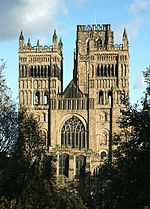 |
Secular canons (priests who followed certain rules but weren't monks) first lived here, starting around 997. Later, in 1093, Benedictine monks took over. This important priory closed in 1539. | The Abbey Church of Saint Mary and Saint Cuthbert at Durham The Cathedral Church of Christ and Blessed Mary the Virgin, Durham |
|
| Durham Greyfriars | Franciscan Friars Minor These friars were established before 1239. They later moved to Hartlepool. |
Hartlepool Friary | ||
| Durham — St Anthony's Priory | Minoresses (a type of Franciscan nun) This community was founded at a former church building and is still active today. |
St Antony's Priory, Durham | ||
| Ebchester Nunnery | Nuns This nunnery was founded before 660 by Saint Ebba. It was destroyed around 875 during raids by the Danes. |
St Ebbas Nunnery | ||
| Egglestone Abbey |  |
Premonstratensian Canons Founded between 1190 and 1195, this abbey was a "daughter house" of Easby Abbey in Yorkshire. It closed on January 5, 1540. The buildings were later turned into a house and cottages. |
The Blessed Virgin Mary and St John the Baptist Egleston Abbey |
|
| Finchale Priory | 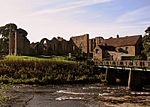 |
Benedictine monks This priory started as a hermitage (a place for a religious hermit) around 1115. It became a priory linked to Durham Cathedral in 1196 and closed in 1538. |
The Blessed Virgin Mary and St John the Baptist St John the Baptist and St Godric |
|
| Gateshead House | Monks Founded before 653, this community was abandoned when the monks left for Ireland. |
|||
| Hartlepool — St Hilda's Monastery | 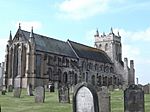 |
Probably a community of both monks and nuns Founded around 640 by Hieu (possibly Saint Bega), this monastery was likely destroyed around 800. |
St Hilda's Monastery | |
| Hartlepool Greyfriars | 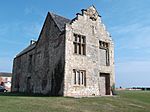 |
Franciscan Friars Minor These friars moved here from Durham before 1240 and their friary closed in 1538. |
||
| Hartlepool Friary? | Dominican Friars This is likely a mistake and refers to the Franciscan Friary mentioned above. |
|||
| Haswell Grange | Benedictine monks This was an endowment (a gift of land or money) that was later transferred to Baxterwood. It became a "grange," which is like a farm belonging to a monastery, under Finchale Priory. |
|||
| Jarrow Priory | This priory is now located in Tyne and Wear, a different historical county. | |||
| Jarrow Friar? | This is also located in Tyne and Wear. | |||
| Neasham Priory | Benedictine nuns Founded before 1156, this priory closed between 1539 and 1540. A house called 'Neasham Abbey' was built near the site in the 19th century. |
St Mary Nesham Priory; Nesseham Priory |
||
| Norton Monastery? | The local St Mary's Church has parts of a church built around 1000. While there's no clear record of a monastery, its size suggests it was more than just a regular church. | |||
| Owton Priory | Gilbertine Canons A charter from 1204 mentions this priory, but it was probably never fully established. It might have been a grange (monastery farm). |
St Mary Oveton in Hartness Priory;Owton in Harness Priory |
||
| Samford Priory? | Benedictine monks This is likely a confusion with Stamford Priory in Lincolnshire. |
|||
| South Shields Monastery | Saxon monks and nuns Founded in 648 by Saint Aidan for Saint Hilda. It was likely destroyed around 865–875. |
Wherhale Monastery?; Wyrale Monastery |
||
| Wearmouth Abbey | This abbey is now located in Tyne and Wear, a different historical county since 1974. | |||
See also
- List of monastic houses in EnglandReturn to top of page
Essex
(For more details and locations, see List of monastic houses in Essex edit)
This page lists the monastic houses that once existed in Essex, England. Monastic houses were places where groups of people, like monks, nuns, or friars, lived together under religious rules. They dedicated their lives to prayer, study, and work. These places played a big role in history, often serving as centers for learning and charity.
Alien houses are included, as are smaller establishments such as cells and notable monastic granges (particularly those with resident monks), and also camerae of the military orders of monks (Knights Templars and Knights Hospitaller). Monastic hospitals are included where they had the status or function of an abbey, priory, friary or preceptor/commandery.
- Abbreviations and key
| Symbol | Status |
|---|---|
| None | Ruins |
| * | Current monastic function |
| + | Current non-monastic ecclesiastic function (including remains incorporated into later structure) |
| ^ | Current non-ecclesiastic function (including remains incorporated into later structure) or redundant intact structure |
| $ | Remains limited to earthworks etc. |
| # | No identifiable trace of the monastic foundation remains |
| ~ | Exact site of monastic foundation unknown |
| ≈ | Identification ambiguous or confused |
Locations with names in italics indicate possible duplication (misidentification with another location) or non-existent foundations (either erroneous reference or proposed foundation never implemented) or ecclesiastical establishments with a monastic name but lacking actual monastic connection.
| EH | English Heritage |
| LT | Landmark Trust |
| NT | National Trust |
Monastic Houses in Essex
This section lists the different monastic houses found in Essex. You'll find out what kind of religious community lived there and when they were founded and closed.
Ancient Monasteries and Early Communities
These are some of the earliest religious communities in Essex. They often started as simple groups of monks or nuns.
Assandun Minster
This was a community founded around 1020 by Canute, a famous king. Its exact location is debated, possibly in Ashingdon or Hadstock.
Bradwell Minster
Also known as St Cedd's Monastery, this site was originally a Roman fort. St Cedd founded a Celtic-style monastery here around 654 AD. It was likely destroyed by Viking raids in the 9th century. Today, part of it is a chapel.
Colne Minster
This early community was founded before 1045. Later, Earl's Colne Priory was built on or near this site.
Hadstock Minster
Some believe this church, St Botolph's, might be the Assandun Minster built by King Canute around 1020. It's an important Anglo-Saxon church.
Southminster
This was a Saxon minster, an early type of monastery.
Tilbury Monastery
St Cedd founded this Saxon monastery around 654 AD. It was probably destroyed during Viking raids in the 9th century.
Abbeys and Priories in Essex
Abbeys and priories were homes for monks or nuns who followed specific rules, like the Benedictine or Augustinian orders.
Beeleigh Abbey
This abbey was for Premonstratensian Canons. They moved here in 1180. The abbey closed in 1536. Today, its remains are part of a private house.
Berden Priory
This priory was home to Augustinian Canons Regular. It was founded in the 12th century, possibly as a hospital first. It closed in 1536. A mansion called 'Berden Priory' now stands on the site.
Bicknacre Priory
Starting as a hermitage, it became a priory for Augustinian Canons Regular in 1175. It closed in 1507 when no canons were left.
Blackmore Priory
This priory for Augustinian Canons Regular was founded between 1152 and 1162. It was closed in 1525. Its church is now the local parish church.
Castle Hedingham Priory
This priory was for Benedictine nuns. It was likely founded before 1190. It closed in 1536.
Coggeshall Abbey
Founded by King Stephen in 1140 for Savignac monks. They became Cistercian monks in 1147. The abbey closed in 1538. Parts of it are now a private house.
Earl's Colne Priory
This priory for Benedictine monks was founded around 1107. It was built near an older minster. It closed in 1536. A 17th-century house now stands on the site.
Hatfield Broad Oak Priory
This priory was for Benedictine monks and was founded around 1135. It was an "alien house," meaning it was linked to a monastery in France. It closed in 1534.
Hatfield Peverel Priory
This began as a secular college before 1087. It became a priory for Benedictine monks before 1100. It closed in 1536, and its church is still used today.
Latton Priory
This priory for Augustinian Canons Regular was founded before 1292. It was abandoned in 1534. Its remains are now part of farm buildings.
Leez Priory
This priory for Augustinian Canons Regular was founded before 1200. It closed in 1536. A 16th-century mansion now stands on its site.
Little Dunmow Priory
This priory for Augustinian Canons Regular was founded in 1106. It closed in 1536. Part of its church is still used as a parish church.
Little Horkesley Priory
This priory was for Cluniac monks. It was founded before 1127 and was an "alien house" linked to a monastery in Sussex. It closed in 1525. The church was destroyed in 1940.
Panfield Priory
This priory for Augustinian Canons Regular was another "alien house" linked to a monastery in France. It was founded around 1069. It closed in 1413.
Parndon Abbey
This abbey for Premonstratensian Canons Regular was founded before 1172. The community later moved to Beeleigh Abbey.
Prittlewell Priory
This priory for Cluniac monks was founded between 1086 and 1121. It was an "alien house" that later became independent. It closed in 1536. Today, it's a museum in a public park.
St Osyth's Abbey
This abbey for Augustinian Canons Regular was founded before 1118 on the site of an older nunnery. It was later raised to abbey status. It closed in 1539. It's now a private home with some public access.
Stansgate Priory
This priory for Cluniac monks was founded in 1122. It was an "alien house" that later became independent. It closed in 1525.
Takeley Priory
This priory for Benedictine monks was an "alien house" linked to a monastery in France. It was founded between 1066 and 1086. It closed around 1391.
Thoby Priory
This priory for Augustinian Canons Regular was founded between 1141 and 1151. It closed in 1525.
Thremhall Priory
This priory for Augustinian Canons Regular was founded around 1150. It closed in 1536. A modern house now stands on its site.
Tilty Abbey
This abbey for Cistercian monks was founded in 1153. It closed in 1536. Its church is still used by the local community.
Tiptree Priory
This priory for Augustinian Canons Regular was founded in the 12th century. It closed down at some point, and a 16th-century house was built on its site.
Walden Abbey
This abbey for Benedictine monks was founded in 1136 and became an abbey in 1190. It closed in 1538. Audley End House now stands on its site.
Waltham Abbey
This important site started as a community of secular canons around 1016. It was refounded by Earl Harold and then became a priory for Augustinian Canons Regular in 1177. It closed in 1540. Part of its church is still used as a parish church.
West Mersea Priory
This priory for Benedictine monks was an "alien house" linked to a monastery in France. It was founded around 1046. It closed in 1400. Its church is now the local parish church.
Wix Priory
This priory for Benedictine nuns was founded between 1123 and 1133. It closed in 1525. The site is now occupied by Abbey Farmhouse, and parts of the old priory church are still visible.
Friaries and Preceptories
Friaries were homes for friars, who were religious men who lived among people and helped them. Preceptories were bases for military-religious orders like the Knights Templar.
Chelmsford Blackfriars
This friary was for Dominican Friars. It was founded before 1277 and closed in 1538.
Colchester Crutched Friary
This friary for Crutched Friars was founded between 1230 and 1235. It became a hospital for a while, then was refounded as a friary in 1496. It closed in 1538.
Colchester Greyfriars
This friary was for Franciscan Friars Minor. It was founded before 1237 and closed in 1538.
Colchester — St Botolph's Priory
This priory started as a secular community around 1093. It was refounded for Augustinian Canons Regular around 1100. It closed in 1536.
Colchester — St John's Abbey
This abbey for Benedictine monks was founded in 1096 or 1097. It closed in 1539.
Cressing Preceptory
This was a base for the Knights Templar, a military-religious order, founded in 1136. After 1312, it was taken over by the Knights Hospitaller. It was dissolved after 1381.
Little Maplestead Preceptory
This preceptory for Knights Hospitaller was probably founded before 1186. It closed around 1463.
Maldon Whitefriars
This friary for Carmelite Friars was founded in 1293. It closed in 1538.
Witham Preceptory
This preceptory was founded between 1138 and 1148. It was later combined with Cressing Preceptory.
Other Monastic Sites
These are other places that were once connected to monastic life.
Burstead Grange
This was a grange (a farm or estate) or cell for Cistercian Monks, dependent on Stratford Abbey. The monks stayed here when their main abbey was flooded.
Frating Abbey
Details about this abbey are not widely known.
Halstead Cell
This was a small community of Benedictine monks founded in the late 11th century. It was later dissolved.
Hockley
This is considered another possible location for the ancient Assandun Minster.
Tolleshunt Major Grange
This was a grange, likely connected to a monastic house.
Tolleshunt Knights — St John's Monastery
This is a modern monastery for Orthodox monks and nuns, founded in 1959 and still active today.
See also
- List of monastic houses in EnglandReturn to top of page
Gloucestershire
(For more details and locations, see List of monastic houses in Gloucestershire edit)
Monastic houses were places where groups of religious people, like monks or nuns, lived together. They followed strict rules and dedicated their lives to prayer and work. These houses were very important in England's history, especially during the Middle Ages. They served as centers for learning, charity, and farming.
This article lists the main monastic houses that existed in Gloucestershire, England. Some were large abbeys, while others were smaller priories or granges. Many of them were closed down in the 1500s during a time called the Dissolution of the Monasteries.
Alien houses are included, as are smaller establishments such as cells and notable monastic granges (particularly those with resident monks), and also camerae of the military orders of monks (Knights Templars and Knights Hospitaller). Monastic hospitals are included where they had the status or function of an abbey, priory, friary or preceptor/commandery.
- Abbreviations and key
| Symbol | Status |
|---|---|
| None | Ruins |
| * | Current monastic function |
| + | Current non-monastic ecclesiastic function (including remains incorporated into later structure) |
| ^ | Current non-ecclesiastic function (including remains incorporated into later structure) or redundant intact structure |
| $ | Remains limited to earthworks etc. |
| # | No identifiable trace of the monastic foundation remains |
| ~ | Exact site of monastic foundation unknown |
| ≈ | Identification ambiguous or confused |
Locations with names in italics indicate possible duplication (misidentification with another location) or non-existent foundations (either erroneous reference or proposed foundation never implemented) or ecclesiastical establishments with a monastic name but lacking actual monastic connection.
| EH | English Heritage |
| LT | Landmark Trust |
| NT | National Trust |
| Name of House | Image | Who Lived There & History | Formal Name or Other Names |
|---|---|---|---|
| Berkeley Abbey | This house was home to nuns before the year 807. It was later destroyed. A new group, secular collegiate (meaning priests who lived together but weren't monks), started here around 1019-1053. It closed around 1135 or later. The local church of St Mary might be on its original site. | Berkeley Minster
possibly Oldminster |
|
| Brimpsfield Priory | Benedictine monks lived here before 1100. It was an alien house, meaning it was controlled by a larger monastery in France. It closed in 1414. | Brimpsfield Grange | |
| Cheltenham Minster | This was an Anglo-Saxon minster (an early church with a community of clergy) from the 8th century. It was a collegiate church, not a monastery with monks. It was absorbed by Worcester before 890. | ||
| Cirencester Abbey | A Saxon minster and secular college existed here before 839. Later, Augustinian Canons Regular founded an abbey in 1131. King Henry I helped start it. The abbey closed on December 19, 1539. Today, its site is a public park. | The Blessed Virgin Mary | |
| Daylesford Monastery | This Saxon monastery was founded in 718. Land was given by King Æthelbald of Mercia. It was later given to Worcester in 841. | Daeglesford Priory | |
| Deerhurst Abbey | A Saxon minster was here in the late 7th century. Benedictine monks lived here, possibly from 715. It was destroyed around 878. It was rebuilt around 970 and again before 1056. It became an alien house, controlled by St-Denis in France. Later, it became independent in 1443. The church is now the Parish Church of St Mary. | St Mary the Virgin
St Mary the Virgin and St Denis Derehures Abbey |
|
| Farmcote Grange | This was a Cistercian monks grange. A grange was like a farm or outpost that belonged to a larger abbey. This one belonged to Hailes Abbey. | ||
| Flaxley Abbey | Cistercian monks founded this abbey on September 30, 1151. It was a "daughter house" of Bordesley Abbey. This means it was started by monks from Bordesley. It closed in 1536-7. Parts of the abbey are now part of a private house. | The Blessed Virgin Mary
Flexley Abbey Dene Abbey |
|
| Gloucester Blackfriars | Dominican Friars (also known as Blackfriars because of their black robes) started this house in 1239. It was consecrated in 1284. It closed in 1538. The building was later used as a cloth-making house. | ||
| Gloucester Greyfriars | Franciscan Friars Minor (known as Greyfriars for their grey robes) were here before 1230. King Henry III helped them. It closed in 1538. The church building was later turned into a brewery. | ||
| Gloucester Whitefriars | Carmelite Friars (Whitefriars) were founded here before 1268. Queen Eleanor was said to be one of the founders. It closed around July 25, 1538. | ||
| Gloucester Cathedral Abbey | This was a "double house" for both Benedictine monks and nuns, founded before 679. It was destroyed by Danish raids. Later, secular canons (priests) lived here. It was refounded for Benedictine monks around 1022 and again around 1058. It closed on January 2, 1540. The church then became Gloucester Cathedral in 1541 and is still active today. | The Abbey Church of Saint Peter, Gloucester
The Cathedral Church of Saint Peter and the Holy and Indivisible Trinity in Gloucester (1541) |
|
| St Oswald's Priory, Gloucester | This was a church for secular canons, traditionally founded in 660. It was refounded for Augustinian Canons Regular in the 890s by Æthelflæd. It became a priory before 1153. It closed in 1539-40. The church was later used as a parish church but was destroyed in 1643. | St Oswald, King and Martyr | |
| Hailes Abbey | Cistercian monks from Beaulieu Abbey founded this house on July 17, 1246. Richard, Earl of Cornwall, started it. It closed on December 24, 1539. Today, it is managed by the National Trust. | The Blessed Virgin Mary
Hayles Abbey Tray Abbey |
|
| Hazleton Abbey | This was a house for Cistercian monks, a "daughter house" of Tintern Abbey. The community moved here from Kingswood around 1149-50. It closed around 1150-4 and the monks moved to Tetbury. | The Blessed Virgin Mary | |
| Horsley Priory | Benedictine monks lived here. It was an alien house, dependent on a monastery in France. It was founded between 1066 and 1087. Later, it became independent and was given to Bruton Priory in 1260. It closed down, and the site is now partly a parish church and possibly a hotel. | dedication unknown
Horkeslegh Priory |
|
| Kingswood Abbey, earlier site | Cistercian Monks from Tintern Abbey founded this first site on September 7, 1139. It was later moved to a new site, but this original spot was kept as a grange (a farm). It closed on February 1, 1538. Only the gatehouse remains today. | Kingswood Grange | |
| Kingswood Abbey | This abbey was for Cistercian Monks. The community moved here from Tetbury around 1164-70. It closed on February 1, 1538. | ||
| Lechlade Priory | Augustinian Canons Regular founded this priory in the 13th century. Richard, Earl of Cornwall, helped start it. | The Priory Church of Saint John the Baptist, Lechlade
Lechelade Priory |
|
| Leonard Stanley Priory | Benedictine monks founded this priory around 1130. It was later confirmed to Gloucester Abbey in 1146. It closed in 1538. The church building is still used as a parish church today. | The Priory Church of Saint Leonard of Stanley
Stanley St Leonard Priory Stanley Priory |
|
| Llanthony Secunda Priory | Augustinian Canons Regular from Llanthony Priory in Wales founded this "daughter house" in 1136. It closed in 1538. | The Priory Church of the Blessed Virgin Mary
Lantony Priory Lanthony Priory |
|
| Minchinhampton Priory | This was for Benedictine nuns and was an alien house, controlled by a monastery in France. It was likely a grange (a farm) rather than a place where nuns lived. It was given to Syon Abbey in 1424 and later reverted to the Crown. | Minchin Hampton Priory | |
| Newent Priory | Benedictine monks lived here. It was an alien house, dependent on a French priory. It was founded before 1086. It closed in 1411. St Mary's Parish church might be the original priory church. | The Blessed Virgin Mary
Noent Priory Newenton Priory |
|
| Poulton Priory | A chantry chapel (a small chapel for prayers for the dead) was founded here in 1348. Gilbertine Canons (a type of religious order) founded a priory in 1350. It closed in 1539. The original church was demolished and replaced in 1873. | The Priory Church of Saint Mary, Poulton | |
| Prinknash Abbey | Benedictine monks founded this abbey in 1928 at St Peter's Grange. They moved to a new abbey building in 1972, but then moved back to St Peter's Grange in 2008. It is still active today. | ||
| Prinknash Abbey – former site | This was the site where the Benedictine monks of Prinknash Abbey lived from 1972 until 2008, when they moved back to their original location. | ||
| Quenington Preceptory | This was a preceptory for the Knights Hospitaller, a military religious order. It was founded between 1144 and 1162. It closed in 1540 and was demolished in the 17th century. Quenington House now stands on its site. | Queinington Preceptory | |
| Temple Guiting Preceptory | This was a preceptory for the Knights Templar, another military religious order. It was founded around 1150. It closed between 1308 and 1311. | Guiting Preceptory | |
| Temple Guiting Grange | This was possibly a grange (farm) belonging to the Knights Templars of Temple Guiting Preceptory. | ||
| Tetbury Monastery | This was a Saxon monastery founded before 680. Land was given by King Æthelred of Mercia. The site might be near the current parish church. | Tettan Monastery | |
| Tetbury Abbey | This abbey was for Cistercian monks. The community moved here from Hazleton around 1150-4, but the site wasn't suitable. They then moved to Kingswood around 1164-70. Some parts of the monastery are now in homes in Tetbury. | The Blessed Virgin Mary | |
| Tewkesbury Abbey | This began as a hermitage (a place for a hermit) around 715. It was for Benedictine monks and was a "cell" (a smaller house) dependent on Cranborne Priory. It was destroyed by Danish raids in the 9th century. It was refounded around 980 and became a large abbey in 1102. It closed on January 9, 1540. Today, it is used as a parish church. | The Abbey Church of the Blessed Virgin Mary, Tewkesbury
Theokesbury Abbey |
|
| Winchcombe Nunnery | This was a house for nuns founded in 787 by King Offa. A Benedictine monastery was later built on its site. | ||
| Winchcombe Abbey | Benedictine monks founded this abbey in 798 on the site of the former nunnery. It became a full abbey around 969. It was destroyed by fire in 1151 but rebuilt and rededicated in 1239. It closed in 1540 and was mostly demolished in 1815. | The Abbey Church of St Mary and St Kenelm, Winchcombe
Winchcombe Priory Winchelcombe Abbey |
|
| Wotton under Edge Friary | This was for Crutched Friars, a religious order. It was founded around 1349 with permission from King Edward III. It likely closed after only a few years. |
Images
See also
- List of monastic houses in England
- List of monastic houses in WalesReturn to top of page
Greater London
(For more details and locations, see List of monastic houses in London edit)
This page lists the monastic houses that once existed in Greater London, England. Monastic houses were places where groups of people, like monks or nuns, lived together under religious rules. They dedicated their lives to prayer, study, and work. These communities were very important in medieval times, acting as centers for learning, charity, and even healthcare.
Many of these houses were dissolved, or closed down, during the time of Henry VIII in the 1530s, a period known as the Dissolution of the Monasteries. Some were completely destroyed, while others were turned into homes or churches. The maps above show where these historical sites were located across London.
Alien houses are included, as are smaller establishments such as cells and notable monastic granges (particularly those with resident monks), and also camerae of the military orders of monks (Knights Templars and Knights Hospitaller). Monastic hospitals are included where they had the status or function of an abbey, priory, friary or preceptor/commandery.
- Abbreviations and key
| Symbol | Status |
|---|---|
| None | Ruins |
| * | Current monastic function |
| + | Current non-monastic ecclesiastic function (including remains incorporated into later structure) |
| ^ | Current non-ecclesiastic function (including remains incorporated into later structure) or redundant intact structure |
| $ | Remains limited to earthworks etc. |
| # | No identifiable trace of the monastic foundation remains |
| ~ | Exact site of monastic foundation unknown |
| ≈ | Identification ambiguous or confused |
Locations with names in italics indicate possible duplication (misidentification with another location) or non-existent foundations (either erroneous reference or proposed foundation never implemented) or ecclesiastical establishments with a monastic name but lacking actual monastic connection.
| EH | English Heritage |
| LT | Landmark Trust |
| NT | National Trust |
Monastic Houses in London: A-Z Guide
| Name of House | Image | Who Lived There & Their Story | Other Names |
|---|---|---|---|
| Aldgate Priory | Augustinian Canons Regular (a type of monk) Started in 1107-8 by Queen Maud. The main church was rebuilt from 1339. It was in bad shape by 1532 and closed in 1534. Most of it was torn down after it closed. |
Christchurch, Aldgate | |
| Aldgate Abbey | 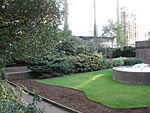 |
Franciscan nuns (nuns who followed St. Francis's teachings) Founded in 1293-4 by Edmund, Earl of Lancaster. Closed in March 1539. |
The Abbey Church of the Grace of the Blessed Virgin Mary and Saint Francis, without Aldgate ____________________ The Minories, London; Holy Trinity, Minories |
| Barking Abbey |  |
Benedictine nuns and monks (a double house for both) First started around 666 by St Erkenwald. Destroyed by Danish raids in 870. Refounded (started again) in 946-951. Later, it was only for Benedictine nuns, refounded in 965-75 by King Edgar. Closed on November 14, 1539. |
St Mary St Mary and St Ethelburgha ____________________ Berking Abbey; Bedenham Abbey |
| Bentley Priory | Augustinian Canons Regular Founded in 1171 by Ranulf de Glanville. Closed before 1532. A house called 'The Priory' was later built on the site. Today, it's owned by the R.A.F. (Royal Air Force). |
The Priory Church of Saint Mary Magdalen, Bentley | |
| Bermondsey Minster | A Saxon monastery (very old, from Anglo-Saxon times). Started between 708-715. Not much is known about it, possibly destroyed by Danish raids in the 9th century. |
||
| Bermondsey Abbey | 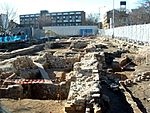 |
Cluniac monks (a branch of Benedictine monks) It was an alien house, meaning it was controlled by a monastery in another country (France). Founded in 1082 by Alvin Child. Became denizen (independent) in 1381. Became an abbey in 1399. Closed on January 1, 1538, and torn down soon after. |
St Saviour |
| Brockley Abbey | Premonstratensian Canons (another type of monk) Founded before 1182 by Countess Juliana. Closed between 1199–1208. The community moved to Bayham, Sussex. |
The Abbey Church of the Blessed Virgin Mary, Brockley | |
| Bromley-by-Bow Priory | Benedictine nuns Founded before 1122. Closed in 1536. |
Bromley Priory; Stratford-at-Bow Priory; Stratford-by-Bow Priory |
|
| Clerkenwell Priory | Knights Hospitaller (a military religious order) Founded around 1144. Closed in 1540. Much of its material was used to build Somerset House. |
St John's Clerkenwell | |
| Clerkenwell Priory (Augustinian) | Augustinian Canonesses (nuns following Augustinian rules) Founded around 1100 or 1144. Also sometimes called Benedictine nuns. Closed around 1539. |
The Priory Church of Saint Mary de Fonte The Priory Church of Saint Mary of the Assumption |
|
| Ealing Abbey | 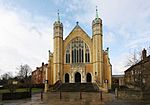 |
Benedictine monks Started in 1897 from Downside Abbey. Became a priory in 1916. Became an abbey in 1955. It is extant (still exists today). |
The Abbey Church of Saint Benedict, Ealing |
| Eastminster Abbey | Cistercian monks (another branch of Benedictine monks) Founded on March 20, 1350, by King Edward III. Closed in 1538. |
New Abbey; The Abbey of St Mary de Graciis; St Mary Graces Abbey |
|
| Elsing Spital Priory | Started as a secular college (a non-monastic religious community) before 1329. Later became a conventual hospital (a hospital run by a religious community) for nuns. Then for Augustinian Canons Regular. Closed in 1539-40. The church was used by the local parish after it closed. |
Elsing Spittle Priory; Priory and Hospital of St Mary-within-Cripplegate Church of St Alphage, London Wall |
|
| Feltham Priory | Anglican Benedictine nuns Founded on June 24, 1868. Later moved to Twickenham. |
SS Mary and Scholastica ____________________ Feltham Nunnery |
|
| Greenwich Blackfriars | Dominican Friars (a type of friar, like monks but often living among people) Founded in 1376 by King Edward III. Closed, then briefly reopened by Queen Mary, and closed again by Queen Elizabeth I. |
||
| Greenwich Greyfriars | Observant Franciscan Friars (a strict branch of Franciscans) Started in 1482. Closed in 1534 because they didn't accept the King's new religious rules. Refounded, then closed again in 1538. Refounded again in 1555, then closed for good in 1559 and torn down. |
||
| Haliwell Priory | Augustinian Canonesses Founded before 1127. Also sometimes called Benedictine nuns. Closed around 1539. |
The Priory Church of Saint John the Baptist, Holywell ____________________ Holywell Priory; Holywell Nunnery, Shorditch |
|
| Hampton Cell then, later, Hampton Preceptory | Sisters of St John of Jerusalem Founded before 1180. Later moved to Buckland, Somerset. |
||
| Knights Hospitaller A "camera" (a small property) by 1338. Closed in 1338. Hampton Court was later built on this site. |
|||
| Harmondsworth Priory | Benedictine monks An alien house dependent on a monastery in France. Founded between 1066 and 1087. Closed before 1391. |
||
| Hornchurch Priory | Augustinian Canons An alien house dependent on a hospital in Savoy. Founded in 1158-9 by King Henry II. Closed in November 1390. |
Saint Nicholas and Saint Bernard | |
| Hounslow Priory | Started as a hospital before 1200. Then became a house for Trinitarians (a religious order). Founded after 1224. Closed in 1538. The Parish Church of the Holy Trinity was built on the site in 1828. |
The Holy Trinity ____________________ Hounslow Friary |
|
| Kilburn Priory |  |
Started as an anchoress's cell (a place for a religious recluse) around 1130. Became a house for Benedictine nuns in 1139. Possibly Augustinian Canonesses at some point. Closed in 1537. |
Kylburn Nunnery |
| Lesnes Abbey |  |
Augustinian Canons Regular Founded in June 1178 by Richard de Luci. Closed in 1525. |
The Abbey Church of Saint Thomas the Martyr, Lesnes ____________________ Westwood Abbey |
| Lewisham Priory | Benedictine monks An alien house dependent on a monastery in Belgium. Founded on September 11, 918. Confiscated and destroyed, then restored in 1044 by Edward the Confessor. Closed in 1414. |
||
| London Areno Friars | Friars of St Mary de Areno Founded in 1267. Stopped existing in 1317. (This seems to be the same group as the London Pied Friars and Westminster Pied Friars). |
||
| London Austin Friars | Augustinian Friars Founded in 1253. Closed in 1538. The nave (main part) of the church was later used by Walloon refugees. The church was destroyed by fire in 1862, rebuilt, then bombed in World War II, and rebuilt again as the Dutch Church, Austin Friars. |
||
| London Charterhouse |  |
Originally planned as a college in 1348. Became a house for Carthusian monks in 1371. Closed in 1537. Later, an almshouse (for poor people) and Charterhouse School were founded on the site. |
House of the Salutation of the Mother of God |
| London, Cornhill Greyfriars | Franciscan Friars Minor Founded in 1224. Moved to Newgate in 1225. |
||
| London Crutched Friars | Crutched Friars (a religious order known for carrying a cross) Founded before 1269. Closed in 1538. |
||
| London, Friars of the Sack, Aldersgate | Friars of the Sack (a mendicant order, meaning they begged for a living) Founded in 1257. Moved to Lothbury before 1271-2. |
||
| London, Friars of the Sack, Lothbury | Friars of the Sack (Moved here from Aldersgate). Abandoned in 1305. |
||
| London, Holborn Blackfriars | Dominican Friars Founded before 1224. Moved to Ludgate after 1275. |
Monumenta Conventus Londinensis | |
| London, Ludgate Blackfriars | Dominican Friars (Moved here from Holborn). Closed on November 12, 1538. Briefly reopened under Queen Mary. |
||
| London, Newgate Greyfriars | Franciscan Friars (Moved here from Cornhill in 1225). A school was founded here. The church was finished in 1327. Closed on November 12, 1538. Later used as Christ Hospital. |
||
| New Temple, London | 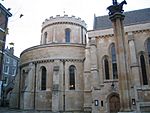 |
Knights Templar (a famous military religious order) (Moved here from an earlier site in 1161). Closed between 1308-12. Then taken over by the Knights Hospitaller in 1324. Part of it was leased to lawyers. The church was badly damaged in World War II in 1941 but was restored. |
|
| London, Old Temple | Knights Templar Founded in 1121. Moved to the New Temple site in 1161. |
Camden Preceptory | |
| London Pied Friars | Pied Friars (another mendicant order) (Seems to be the same as London Areno Friars and Westminster Pied Friars). |
||
| London — St Dominic's Priory | 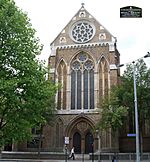 |
Dominican Friars Opened in 1867, with the church finished in 1882. It is extant (still exists today). |
The Priory of Our Holy Father St Dominic Our Lady of the Rosary and Saint Dominic |
| London — St Helen's, Bishopsgate | 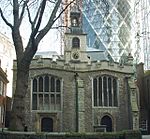 |
Benedictine nuns Founded before 1216. Closed on November 25, 1538. The church is now used as the Parish Church of St Helen, Bishopsgate. It was damaged by an IRA bomb in 1992 but was restored. |
St Helen |
| London — St James Monkswell Chantry | Carthusian monks (a very strict monastic order) A small house or cell. Founded in 1341. |
||
| London, St Mary Spital | Augustinian Canons Regular A conventual hospital or priory. Founded in 1197. Later, the land was granted to Stephen Vaughan. |
St Mary the Virgin ____________________ St Mary Spittle, without Bishopsgate; Domus Dei |
|
| London, St Mary of Bethlehem Friary | Augustinian Canons Regular — Order of Bethlehem A conventual hospital. Also had St Mary of Bethlehem Sisters. Founded in 1247. The hospital later moved to Moorfields and then to the South side of the Thames, becoming Bethlem Royal Hospital. |
The Bethlehem Hospital; Bedlam |
|
| London, St Thomas of Acon Hospital | Augustinian Canons Regular A conventual hospital. |
||
| London, Smithfield Blackfriars | Dominican Friars Briefly founded under Queen Mary. |
||
| London Whitefriars | Carmelite Friars (another mendicant order) Founded in 1247. The church was built in 1253 and rebuilt in the mid-14th century. Closed in 1538. The former refectory (dining hall) was converted into The Whitefriars Theatre in 1608. |
||
| London within Cripplegate (?)Priory | Possibly for nuns or a conventual hospital. Founded before 1329. Became run down and was abandoned in 1329. |
||
| Merton Priory | Augustinian Canons Regular Founded in 1114 by Gilbert Norman. Closed in 1538. Today, a shopping center stands on the site, with some remains visible in the basement. |
The Priory Church of Saint Mary, Merton The Priory Church of Saint Mary of Merton ____________________ Merton Abbey St Mary's Priory; St Mary of Merton |
|
| Moor Hall Preceptory | Knights Hospitaller Founded around 1176. Became a "camera" (small property) by 1338. Closed in 1338. The chapel was torn down in 1960. |
Harefield Preceptory; Harefield Camera; Moor Hall Camera |
|
| Richmond Greyfriars | Observant Franciscan Friars Founded in 1499 or 1500. Closed in 1534. Probably then became a house for Augustinian Friars. Refounded in 1534, then likely closed in 1536. |
Richmond Austin Friars (1534-6) Sheen Friary |
|
| Ruislip Priory | Benedictine monks An alien house dependent on a monastery in France. Founded during the reign of William the Conqueror. Closed in 1404. Manor Farm House was built on the site in the 16th century. |
Riselipp Priory | |
| St Bartholomew's Priory |  |
Augustinian Canons Regular Founded in 1123 by Roahere. Became a priory with a separate hospital. Closed in October 1539. Now it's St Bartholomew's Hospital, and the priory church is used as a parish church. |
The Priory Church of St Bartholomew-the-Great, Smithfield |
| Sheen Priory | Carthusian monks Founded around 1414 by King Henry V. Closed in 1539. Briefly restored in 1557 by Queen Mary, then closed again by Queen Elizabeth I. |
The Priory Church of Jesus of Bethlehem ____________________ Richmond Priory; Shene Priory |
|
| Sheen Whitefriars | Carmelite Friars Founded around 1315. Closed around 1318, and the community moved to Oxford. |
||
| Southwark Cathedral Priory | A Saxon minster church (an early type of monastery) existed before 1066. Augustinian Canons Regular Refounded in 1106. Largely destroyed by fire in 1212 but rebuilt. Closed on October 27, 1539. It became a cathedral on May 1, 1905, and is extant (still exists today). |
The Priory Church of Saint Mary Overie, Southwark | |
| Stratford Langthorne Abbey |  |
Savignac monks (an order that later joined the Cistercians) Founded on July 25, 1135. Became Cistercian monks in 1147. Closed in 1538. |
The Abbey Church of Saint Mary, Stratford Langthorne ____________________ West Ham Abbey |
| Stratford Friary | Franciscan Friars Minor It is extant (still exists today). |
||
| Syon Abbey | Bridgetine nuns (an order founded by St. Bridget of Sweden) Founded in 1431. Closed in 1539. |
Charterhouse at Sheen | |
| Tooting Priory | Benedictine monks An alien house dependent on a monastery in France. Founded before 1086. Closed before 1315. Granted to Eton College in 1440. |
Tooting Bec Priory | |
| Twickenham Abbey | Bridgetine nuns Founded in 1415 by King Henry V. Moved to Syon in 1431. |
||
| Twickenham Priory | Anglican Benedictine nuns Moved here from Feltham. Later moved to West Malling, Kent. |
||
| Upminster | 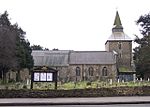 |
A Saxon 'minster' (an early church or monastery). Possibly on the site of the current Parish Church of St Laurence. |
|
| Westminster Abbey |  |
A very old foundation, possibly a monastery founded around 616. Destroyed by Danish raids around 871-2, then restored. Became a house for Benedictine monks around 960. Closed on January 16, 1540. Briefly a cathedral, then restored as a monastery, then closed again in 1559. Became a collegiate church in 1560. Now a Royal Peculiar (meaning it belongs directly to the monarch, not a bishop). |
The Abbey Church of Saint Peter in Westminster |
| Westminster Pied Friars | Pied Friars (Seems to be the same as the London Areno Friars and London Pied Friars). |
||
| Woodford Green Friary | Franciscan Friars Minor It is extant (still exists today). |
Friary and Parish of St Thomas of Canterbury |
See also
- List of monastic houses in EnglandReturn to top of page
Greater Manchester
For more details or to add information, please check the individual article for each monastic house.
Have you ever wondered about the old buildings in Greater Manchester? Many years ago, long before cities looked like they do today, there were special places called monastic houses. These were homes for groups of religious people, like monks or friars, who dedicated their lives to prayer and work. They often lived together in communities, following strict rules.
These houses played an important role in medieval society. They were not just places of worship; they were also centers for learning, farming, and helping the poor. Some of them were very large and powerful, while others were small and simple.
In Greater Manchester, several of these monastic houses existed. Let's explore some of them and learn about their history.
Exploring Monastic Houses in Greater Manchester
Here are some of the interesting monastic houses that were once found in the Greater Manchester area.
Gorton Monastery
The Church and Friary of St Francis in Gorton Monastery is a special place. It was home to the Franciscan Friars. Unlike many older monastic houses that were closed down centuries ago, Gorton Monastery is still around today. It's a beautiful building that shows how these religious communities lived and worshipped.
Kersal Priory
Kersal Priory was a monastic house dedicated to St Leonard. It started as a small hermitage, which is a place where a single religious person lives alone. Later, it became home to Cluniac monks.
This priory had an interesting history. It was founded sometime between 1145 and 1153. For a long time, it was an "alien house," meaning it was controlled by a larger monastery in Lenton, Nottinghamshire. This changed in 1392 when Kersal Priory became independent. However, like many other monasteries in England, it was eventually closed down in 1538.
Marland Grange
Marland Grange was a place connected to Cistercian monks. A "grange" was like a farm or estate that belonged to a monastery. Marland Grange was first part of Stanlow Abbey in Cheshire. Later, it became linked to Whalley Abbey. This grange was established before the year 1212. Its exact location today is not fully known, but it was an important part of the Cistercian monks' farming activities in the region.
Warburton Priory
Warburton Priory was a small monastic community, sometimes called a "cell." It was home to Premonstratensian Canons. This priory was a daughter house, meaning it was dependent on a larger monastery called Cockersand Abbey in Lancashire.
Warburton Priory was founded around the year 1200. The church of St Mary and St Werburgh was given to Cockersand Abbey by a person named Adam of Dutton. Sadly, this small priory was abandoned before 1271, meaning the canons left and it stopped being an active monastic house. It was also known as Warburton Cell.
See also
- List of monastic houses in EnglandReturn to top of page
Hampshire
(For more details and locations, see List of monastic houses in Hampshire edit)
Monastic houses are special places where groups of people, often called monks or nuns, lived together. They dedicated their lives to religious practices, prayer, and work. These communities followed strict rules and often lived separately from the rest of society.
In Hampshire, a county in England, there were many such places. Some were large abbeys, while others were smaller priories or friaries. These buildings were important centers for learning, farming, and helping the local community. Many of them were built hundreds of years ago, during the Middle Ages.
What Were Monastic Houses?
Monastic houses were buildings where religious people lived together. They followed specific rules for their daily lives. These groups included:
- Monks: Men who lived in monasteries or abbeys. They often belonged to orders like the Benedictines or Cistercians.
- Nuns: Women who lived in convents or nunneries. They also followed strict religious rules.
- Canons: Priests who lived in communities, often serving a cathedral or large church. They were called Canons Regular if they followed a specific rule like St. Augustine's.
- Friars: Unlike monks, friars often lived in towns and cities. They would travel and preach to people. Examples include Franciscans (Greyfriars), Dominicans (Blackfriars), and Carmelites (Whitefriars).
- Knights Hospitaller and Knights Templar: These were military religious orders. They protected pilgrims and cared for the sick. Their homes were called preceptories.
Many of these houses were founded by kings, queens, or wealthy nobles. They were given land and money to support their communities.
Important Monastic Houses in Hampshire
Beaulieu Abbey
Beaulieu Abbey was a large and important Cistercian monastery. It was founded in 1203 by King John. The monks here followed a very strict way of life. They focused on prayer, manual labor, and living simply.
The abbey was dissolved in 1538. This means it was closed down by the king. Today, the ruins of Beaulieu Abbey are part of the Beaulieu Palace House estate. You can still visit and see the impressive remains of this once-great building.
Netley Abbey
Netley Abbey was another Cistercian monastery, founded in 1239. It was a "daughter house" of Beaulieu, meaning it was started by monks from Beaulieu. King Henry III helped to found it.
Like many monasteries, Netley Abbey was dissolved in 1536. After it closed, parts of the abbey were turned into a grand house. Over time, it fell into ruin, but its remains are still very beautiful. They are managed by English Heritage and are a popular place to visit.
Romsey Abbey
Romsey Abbey was a significant Benedictine nunnery. It was likely founded around 907 by Edward the Elder, an early English king. Nuns lived here, dedicating their lives to God.
When the monasteries were dissolved in 1539, Romsey Abbey was also closed. However, the local people bought the church building. This saved it from being destroyed. Today, the abbey church is still used as a parish church. It is a wonderful example of medieval architecture.
Winchester's Monastic Houses
The city of Winchester was a very important religious center. It had many monastic houses, including:
- Winchester Cathedral Priory: This was a large Benedictine monastery connected to Winchester Cathedral. It was founded in 964 and was a major center of power and learning. The cathedral itself is still a working church today.
- Hyde Abbey: Originally called the New Minster, this Benedictine monastery was founded in 901. It moved to Hyde in 1110. It was dissolved in 1539.
- St. Mary's Abbey, Winchester: Also known as Nunnaminster, this was a Benedictine nunnery. It was founded around 902 by Alfred the Great and his wife. It was dissolved in 1539.
- Friaries: Winchester also had several friaries, including Blackfriars, Greyfriars, and Whitefriars. These were homes for different orders of friars who preached and lived among the people in the city.
Other Notable Houses
Alton Abbey
Unlike most entries on this list, Alton Abbey is a modern monastic house. It was founded in 1895 by Anglican Benedictine monks. It is still an active community today, showing that monastic life continues in Hampshire.
Mottisfont Abbey
Mottisfont Abbey was an Augustinian priory founded in 1201. After it was dissolved in 1536, the buildings were turned into a grand mansion. Today, it is a beautiful country house managed by the National Trust.
Pamber Priory
Pamber Priory was a small Benedictine priory founded around 1100. It was an "alien house," meaning it was dependent on a monastery in France. The priory church is still standing and is used as a local parish church.
Portchester Priory
Portchester Priory was an Augustinian priory founded in 1128 within the walls of Portchester Castle. The site was not ideal, so the community moved to Southwick around 1145. The original priory church at Portchester is still used as a parish church today.
Titchfield Abbey
Titchfield Abbey was a Premonstratensian monastery founded in 1232. It was dissolved in 1537. Like Mottisfont, parts of the abbey were converted into a mansion called 'Palace House'. The ruins are now managed by English Heritage.
The Dissolution of the Monasteries
Most of the monastic houses in Hampshire, and across England, were closed down in the 1530s. This event is known as the Dissolution of the Monasteries. It happened during the reign of King Henry VIII. The king wanted more control over the Church and its wealth.
After the dissolution, the lands and buildings of the monasteries were taken by the Crown. Many were sold off to wealthy families. Some buildings were completely destroyed, while others were turned into private homes or used for other purposes. This changed the landscape of England forever.
Images
Herefordshire
(For more details and locations, see List of monastic houses in Herefordshire edit)
This article explores the monastic houses in Herefordshire, England. These special places were once homes for groups of people who dedicated their lives to religious service. They lived together under strict rules. Monastic houses include abbeys, priories, and preceptories.
What are Monastic Houses?
Monastic houses were buildings where monks, nuns, or friars lived. They followed specific religious rules. These communities played a big role in medieval society. They were centers for learning, prayer, and helping the poor.
- Monks and Nuns lived in abbeys or priories. They usually stayed within their community.
- Friars were different. They often traveled to preach and help people in towns.
- Preceptories were like military bases for groups like the Knights Templar and Knights Hospitaller. These were warrior monks who protected pilgrims.
Many of these houses were closed down in the 1500s. This event is known as the Dissolution of the Monasteries.
Monastic Houses in Herefordshire
Herefordshire was home to many different types of monastic houses. Some were very old, dating back to Saxon times. Others were built much later. Let's look at some of the most important ones.
Abbeys and Priories
These were the most common types of monastic houses. An abbey was a large, independent community led by an abbot or abbess. A priory was usually smaller. It might be independent or linked to a larger abbey.
Aconbury Priory
Aconbury Priory was founded around 1200. It was first home to the Sisters of St John of Jerusalem. Later, it became a home for Augustinian Canonesses. These were nuns who followed the rules of St. Augustine. The priory was closed in 1539. Its church is still used today.
Belmont Abbey
Belmont Abbey is a more recent foundation. It was started in 1859 for Benedictine monks. Unlike many old houses, Belmont Abbey is still active today. It was even a cathedral for a short time.
Clifford Priory
Clifford Priory was founded between 1129 and 1130. It was home to Cluniac monks. These monks were part of a large network connected to Lewes Priory in Sussex. At first, it was an "alien house," meaning it was controlled by a foreign monastery. Later, it became independent. The priory closed in 1536.
Craswall Priory
Craswall Priory was founded around 1225. It housed Grandmontine monks. This was another "alien house," linked to Grandmont in France. The priory closed in 1462. Its lands were then given to a college in Cambridge.
Dore Abbey
Dore Abbey was a Cistercian monastery. It was founded on April 26, 1147. Cistercian monks lived a very simple life. The abbey was dissolved in 1537. However, parts of its church were restored in 1633. It is still used as a church today.
Flanesford Priory
Flanesford Priory was founded in 1346 or 1347. It was home to Augustinian Canons Regular. After it closed in 1537, the priory was turned into a farm. Today, its remains are part of a private house.
Hereford Cathedral Priory
Hereford Cathedral has a very long history. It was founded around 669. For a time, it was home to Benedictine monks. The cathedral was damaged and rebuilt many times over the centuries. It remains an important religious site today.
Saint Guthlac's Priory, Hereford
Saint Guthlac's Priory in Hereford had two locations. The first site was founded before 1066. It was a Benedictine monastery. After being damaged in a war around 1143, the monks moved to a new site. The priory was eventually dissolved in 1538.
Leominster Priory
Leominster Priory has a very old history. It was possibly founded around 660 for nuns and monks. It was destroyed by Danish raids in the 9th century. Later, it was refounded for Benedictine monks. The priory was rebuilt in the 12th century. It closed in 1539.
Limebrook Priory
Limebrook Priory was founded around 1189. It was home to Augustinian Canonesses, a group of nuns. The priory was dissolved on December 28, 1539.
Wigmore Abbey
Wigmore Abbey was home to Augustinian Canons Regular. The community originally started at Shobdon between 1131 and 1135. They moved to Wigmore between 1172 and 1179. The abbey was dissolved in 1538. Its remains are now part of a farm.
Wormsley Priory
Wormsley Priory was founded in the 13th century. It housed Augustinian Canons Regular. The priory was dissolved in 1539.
Knights' Houses (Preceptories)
Preceptories were special monastic houses. They belonged to military religious orders like the Knights Templar and the Knights Hospitaller. These knights combined religious life with military duties.
Bosbury Preceptory
Bosbury Preceptory was first founded for the Knights Templar around 1217-1219. The Knights Templar were a powerful order. When they were dissolved in 1308-1312, the preceptory was given to the Knights Hospitaller. It later merged with other preceptories.
Dinmore Preceptory
Dinmore Preceptory was a house for the Knights Hospitaller. It was founded before 1189. The Hospitallers were known for caring for sick pilgrims. The preceptory was dissolved before 1535. Its chapel was restored in 1886.
Garway Preceptory
Garway Preceptory was founded for the Knights Templar between 1185 and 1188. After the Templars were dissolved, it also passed to the Knights Hospitaller. It later merged with Dinmore.
Other Monastic Sites
Herefordshire also had other types of early religious communities. Some were very ancient, dating back to Celtic times.
Hentland Monastery
Hentland Monastery is said to have been founded in the 6th century. It was a Celtic monastery. These early communities were often led by a saint.
Kilpeck Priory
Kilpeck Priory was a Benedictine monastery. It was founded around 1134. The priory was linked to Gloucester Cathedral. It was dissolved in 1428.
Titley Priory
Titley Priory was founded between 1120 and 1121. It housed Tironensian monks. This was another "alien house," connected to Tiron in France. The priory was dissolved in 1391. A house called "Priory Cottage" was built on the site in the 16th century.
|
See also
- List of monastic houses in England
- List of monastic houses in WalesReturn to top of page
Hertfordshire
(For more details and locations, see List of monastic houses in Hertfordshire edit)
Hertfordshire, a county in England, was once home to many monastic houses. These were special places where groups of people, like monks, nuns, or friars, lived together under religious rules. They dedicated their lives to prayer, study, and often helped their local communities. These houses were important centers for learning, healing, and farming in medieval times.
This article lists some of the most important monastic houses that existed in Hertfordshire. Many of these were closed down in the 1500s during a time known as the Dissolution of the Monasteries.
Types of Monastic Houses
There were different kinds of monastic houses, each with their own rules and traditions:
- Abbey: A large and important monastery led by an abbot (for monks) or an abbess (for nuns).
- Priory: A smaller monastery, often led by a prior or prioress. Some priories were independent, while others were like branches of a larger abbey.
- Friary: A house for friars, who were different from monks because they often traveled and preached, and lived by begging.
- Preceptory: A house for military religious orders like the Knights Templar or Knights Hospitaller. These knights combined religious life with military duties.
- Cell: A very small monastic house, usually dependent on a larger monastery.
Notable Monastic Houses in Hertfordshire
Ashridge Priory
Ashridge Priory was a monastery for a group of monks called Bonshommes monks. It was founded in 1283 by Edmund, Earl of Cornwall. This priory was dedicated to the Precious Blood. It was closed down on November 16, 1539.
Cathale Priory
This priory was home to Benedictine nuns. It was likely founded around 1200. The priory was closed before 1240, and its land was given to the nuns of Cheshunt. A chapel from Cathale Priory was still standing in the 1830s.
Cheshunt Priory
Cheshunt Priory was another home for Benedictine nuns, founded before 1183. It was dissolved (closed) in 1536, and its property was given to Sir Anthony Deny.
Flamstead Priory
Flamstead Priory was a priory for Benedictine nuns, founded around 1150 during the reign of King Stephen. It was closed in 1537. Today, the site is where Beechwood Park School stands.
Hertford Priory
Hertford Priory housed Benedictine monks. It was founded before 1093 by Ralph de Limesy and was connected to St Albans Cathedral. The priory was closed in 1538, and its church was later torn down. The site is now occupied by a parish church.
Hertford Trinitarian Priory
This site started as a hospital for people with leprosy, founded before 1199. It was later taken over by Trinitarian monks around 1261. This priory was likely abandoned before 1535.
Hitchin Priory
Hitchin had two important monastic houses:
- Hitchin Whitefriars: This was a friary for Carmelite Friars, founded around 1317. It was closed on October 17, 1538. Today, the site is occupied by the Hitchin Priory Hotel, and you can still see parts of the old cloister arches.
- Hitchin Priory (Gilbertine): This priory was for Gilbertine Canons, founded in 1361-1362. It was closed in 1538.
Hitchin Minster
This was a very old Saxon church, or minster, existing before the 11th century. It became a regular parish church before 1086.
Ivinghoe (Muresley) Priory
Also known as Muresley Priory, this was a home for Benedictine nuns. It was founded between 1107 and 1129. The community was later removed, and the property was given to Sir John Dance around 1537.
King's Langley Priory
King's Langley Priory was a house for Dominican Friars, founded before 1308. It was closed in 1538. Interestingly, it was briefly refounded for Dominican nuns in 1557 but closed again in 1558.
Lannock
This site was associated with the Knights Templar before 1148, though a full preceptory (a knight's house) might not have been built there. Later, it was used by the Knights Hospitaller.
Markyate Priory
Markyate Priory started as a hermitage before 1145 and then became a priory for Benedictine nuns in 1145. It was dedicated to the Holy Trinity. The priory was closed in 1537. Today, a manor house called 'Markyate Cell' stands on the site, and the local church was built nearby.
New Biggin Priory
New Biggin Priory was a smaller cell of a Gilbertine Priory, founded in 1361-1362. It was closed in 1538. A residence was built on the site in 1585, which later became almshouses.
Redbourn Priory
Redbourn Priory was a cell for Benedictine monks, connected to St Albans Abbey. It was founded in 1178 and dedicated to St Amphibalus. The priory was attacked by the French in 1217 and seems to have been abandoned before 1535.
Rowney Priory
This priory was for Benedictine nuns, founded around 1164. It was attacked in the early 15th century and officially closed on September 11, 1457. A 19th-century house now stands on the site, possibly using some of the old priory's materials.
Royston Priory
Royston Priory was home to Augustinian Canons Regular, founded between 1173 and 1179. It was closed on April 9, 1537. The priory church was later converted into the Parish Church of St John the Baptist, which is still in use today.
St Albans Abbey
St Albans Abbey was a very important and large monastery for Benedictine monks. It was founded around 793. Over time, it also housed nuns and secular clergy. From 1140, it was mainly for Benedictine monks. The abbey was dissolved on December 5, 1539, but its church became a parish church and later a cathedral in 1877, which it remains today.
St Albans Nunnery
This was a community of Benedictine nuns connected to St Albans Abbey. It was founded before 940 but later moved to Sopwell in 1140.
St Mary de Pre Priory
St Mary de Pre Priory started as a hospital for lepers in 1194. It later became a priory for Benedictine nuns around 1328. The priory was abandoned in 1528 and its property was given to Ralph Rawlet in 1540-1541.
Sawbridgeworth Priory
Sawbridgeworth Priory was likely a small cell for Benedictine monks connected to Westminster Abbey. It was founded around 1135. Its church is now the Parish Church of St Mary the Great.
Sopwell Priory
Sopwell Priory was a priory for Benedictine nuns, founded in 1140 by Geoffrey, the Abbot of St Albans. It was closed in 1537.
Standon Monastic Houses
Standon had a few different religious sites:
- Standon Cell: This was for the Sisters of the Order of St John of Jerusalem but was closed around 1180.
- Standon Preceptory: This was a house for the Knights Hospitaller, founded in 1147. It was dissolved before 1443-1444.
- Standon Priory: This was a hermitage that became a cell for Benedictine monks around 1173-1178. It was closed around 1306.
Temple Dinsley Preceptory
Temple Dinsley Preceptory was first for the Knights Templar, founded in 1147. When the Templars were dissolved (closed down) between 1308 and 1312, the site was refounded for the Knights Hospitaller in 1324. The original buildings were torn down in 1712, and the Princess Helena College was built on the site in 1714.
Ware Priory
Ware Priory was a priory for Benedictine monks, founded before 1081. It was closed in 1414. The old rectory or manor house was built on the site in the early 17th century. The priory's church is now the parish church of St Mary the Virgin.
Ware Friary
Ware Greyfriars was a house for Franciscan Friars Minor, founded in 1338. It was closed in 1538 and later became a private residence.
Wormley Priory
Wormley Priory was a cell for Augustinian Canons Regular, connected to Waltham Abbey in Essex. It was founded after 1177 and before 1260. The priory was closed around 1510. Its church was restored in the 19th century and is now the parish church of St Laurence.
Wymondley Priory
Wymondley Priory, located near Little Wymondley, started as a hospital before 1218. It soon became a priory for Augustinian Canons Regular. It was closed on April 6, 1537. Today, a Tudor Tithe barn stands on the site.
Images
-
St Albans Cathedral, once the grand St Albans Abbey.
See also
- List of monastic houses in EnglandReturn to top of page
Isle of Wight
Monastic houses are special places where groups of people, often called monks or nuns, live together. They dedicate their lives to religious practices, prayer, and sometimes work like farming or teaching. These communities have existed for hundreds of years, and many old buildings on the Isle of Wight were once homes to these monks and nuns. This article explores some of these fascinating historical sites.
Appuldurcombe House
Appuldurcombe House, located in Wroxall, was once home to Benedictine monks. It was founded around the year 1100. The land was given to Montebourg Abbey, a monastery in France, even before 1090. This meant it was a "dependent" house, linked to the larger abbey.
The monastery was closed down in 1414. Later, in the 16th century, a grand Elizabethan house was built on the same spot. Over the years, it became a hotel and even a college for young gentlemen. Interestingly, Benedictine monks returned to the site for a short time between 1901 and 1908.
During the two World Wars, the house was used to house soldiers. It was badly damaged by a mine in 1943. Today, Appuldurcombe House is mostly a ruin inside, but its history is still very clear.
Barton Priory
Barton Priory was a home for Augustinian Canons Regular. These were priests who lived in a community under a strict rule. This priory was founded in 1275 by John Insula and Thomas de Winton. They were both rectors, which means they were in charge of churches.
The priory was dedicated to The Holy Trinity. It was also known as Barton Oratory or Burton College. The community was closed in 1439, and the property was then given to Winchester College, a famous school.
St Mary's Priory, Carisbrooke
St Mary's Priory in Carisbrooke had a long and interesting history with different groups of monks. It started around 1156 as a home for Cistercian monks. This priory was also an "alien house," meaning it was connected to Lire Abbey in France. The land was originally given to Lire Abbey by William fitz Osbern, a powerful figure during the time of William the Conqueror.
Later, the priory was given to Mount Grace Priory in Yorkshire by Richard II of England. Then, under Henry IV of England, the Benedictine monks restored it. However, it was closed again in 1414. Finally, Henry V of England gave it to the Carthusian monks at Sheen in Surrey. The church here was dedicated to Saint Mary the Virgin.
Carisbrooke Priory
Carisbrooke Priory is a modern monastic house, home to Dominican nuns. Unlike many of the older priories that are now ruins, this one is still active today. It is owned by the Carisbrooke Priory Trust, which is a registered charity. The priory is also known as The Open Door.
Quarr Abbey
The original Quarr Abbey was founded on April 27, 1132, by Baldwin de Redvers. It was first home to Savignac monks. These monks followed a specific set of rules. However, in 1147, their order merged with the Cistercian monks, so Quarr Abbey became a Cistercian monastery.
The abbey was dedicated to Our Lady of the Quarry, and was sometimes called Quarrer Abbey. Like many monasteries in England, it was closed down in 1536 during the time of King Henry VIII. The land was later given to John and George Mills. Today, you can still see the ruins of this ancient abbey.
Quarr Abbey (New)
A new Quarr Abbey was founded on May 24, 1907, by Benedictine monks. These monks came from Appuldurcombe House, which they had briefly re-established. The current abbey building was constructed using stones from the ruined old Quarr Abbey. This new abbey is still active today, continuing the long tradition of monastic life on the Isle of Wight.
St Cecilia's Abbey, Ryde
St Cecilia's Abbey in Ryde is a home for Benedictine nuns. The community originally started in Ventnor in 1882. They were a "daughter" house of Liege Abbey in Belgium.
In 1922, the nuns moved to Appley House in Ryde. Their priory became an abbey in 1926, which means it gained more independence. In 1950, they joined the Solesmes Community, a larger group of Benedictine monasteries. This abbey is still active and is known as the Priory or Abbey of the Peace of the Heart of Jesus.
St Cross Priory
St Cross Priory was an "alien house" for Tironensian monks, meaning it was connected to Tiron Abbey. It was founded before 1132, possibly around 1120. The church was established by Robert Colaws.
This priory was closed in 1391 and later given to Winchester College. Today, the original site of St Cross Priory is believed to be covered by a viaduct and railway lines, so there are no visible remains.
St Helen's Priory
St Helen's Priory was home to Cluniac monks. It was another "alien house," dependent on Wenlock Priory in Shropshire. The priory was founded around 1090, or before 1155. It operated for many years before being closed down in 1414.
Ventnor Priory
Ventnor Priory was a community of Benedictine nuns. It was founded in 1882 and was a "daughter" house of Liege Abbey in Belgium. This was the first home for the nuns who later moved to St Cecilia's Abbey in Ryde.
The original house in Steephill View, Ventnor, has since been demolished. A new building called Priory Lodge was built on the site in 1970. The priory was known by the name Pax Cordis Jesu, which means "Peace of the Heart of Jesus".
Images
See also
- List of monastic houses in EnglandReturn to top of page
Kent
A monastic house is a special place where groups of people, like monks or nuns, lived together under religious rules. They dedicated their lives to prayer, study, and work. These places were very important in history, acting as centers for learning, charity, and farming. In Kent, a county in England, there were many such houses, each with its own story.
Alien houses are included, as are smaller establishments such as cells and notable monastic granges (particularly those with resident monks), and also camerae of the military orders of monks (Knights Templars and Knights Hospitaller). Monastic hospitals are included where they had the status or function of an abbey, priory, friary or preceptor/commandery.
- Abbreviations and key
| Symbol | Status |
|---|---|
| None | Ruins |
| * | Current monastic function |
| + | Current non-monastic ecclesiastic function (including remains incorporated into later structure) |
| ^ | Current non-ecclesiastic function (including remains incorporated into later structure) or redundant intact structure |
| $ | Remains limited to earthworks etc. |
| # | No identifiable trace of the monastic foundation remains |
| ~ | Exact site of monastic foundation unknown |
| ≈ | Identification ambiguous or confused |
Locations with names in italics indicate possible duplication (misidentification with another location) or non-existent foundations (either erroneous reference or proposed foundation never implemented) or ecclesiastical establishments with a monastic name but lacking actual monastic connection.
| EH | English Heritage |
| LT | Landmark Trust |
| NT | National Trust |
Monastic Houses in Kent
This table lists many of the monastic houses that once existed in Kent. You'll find out what kind of religious community lived there, when they were founded, and what happened to them.
| Name | Image | Who Lived There & Their Story | Other Names | Location |
|---|---|---|---|---|
| Aylesford Priory | 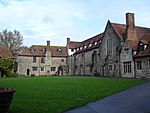 |
Carmelite Friars (a type of monk) started this priory in 1242. The church was built between 1242 and 1248. It was rebuilt later, from 1348 to 1417. The priory closed in 1538. The church was taken down, and the other buildings became a private home. After a fire in 1930, it was rebuilt. Carmelite Friars returned in 1949 and still live there today. | The Friars | 51°18′11″N 0°28′19″E / 51.3030815°N 0.4720098°E |
| Badlesmere Priory | Augustinian Canons Regular (another type of monk) founded this house in the 8th century. | |||
| Badmonden Priory | Augustinian Canons Regular lived here. It was a small house that belonged to Beaulieu Abbey in Normandy, France. It closed in 1414 and was given to St Andrew's Priory, Rochester. It closed again in 1540 and was given to the Rochester Cathedral. | |||
| Bilsington Priory |  |
Augustinian Canons Regular founded this priory in 1253. It was started by John Mansell, who was a very important judge. The priory closed on February 28, 1536. It was then given to the Archbishop of Canterbury. Today, its old buildings are part of a farmhouse. | 51°04′57″N 0°54′57″E / 51.0826112°N 0.9159355°E | |
| Blakwose Priory | Premonstratensian Canons (a religious order) founded this house before 1158. It was a small part of Lavendon Abbey in Buckinghamshire. After 1203, it was moved to St Radegund's Abbey and became a farm for them. It closed around 1377. | Blackwose Priory | 51°04′27″N 1°04′04″E / 51.074034°N 1.0677485°E | |
| Boxley Abbey | 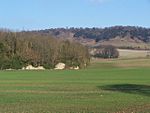 |
Cistercian monks (a strict order of monks) founded this abbey on October 23, 1143. It was a "daughter house" of Clairvaux Abbey in France. William de Ipre, the Earl of Kent, started it. The abbey closed on January 21, 1538. Its remains are now part of a private house. | The Priory Church of the Blessed Virgin Mary, Bilsington | 51°18′00″N 0°31′29″E / 51.3000261°N 0.5246937°E |
| Canterbury Austin Friars, earlier site | Augustinian Friars started here in 1318. They moved to a new site in 1324. | 51°16′37″N 1°04′54″E / 51.276936°N 1.081654°E | ||
| Canterbury Austin Friars | The Augustinian Friars moved to this site in 1324. Their buildings were rebuilt in 1408. The friary closed in December 1538. | 51°16′37″N 1°04′54″E / 51.276936°N 1.0816544°E | ||
| Canterbury Blackfriars |  |
Dominican Friars (also known as Blackfriars) started here around 1236, founded by King Henry III. Their church was built from 1237 onwards. The friary closed in 1538. Today, part of the old building is used as a church. | 51°16′53″N 1°04′45″E / 51.2813435°N 1.0792083°E | |
| Canterbury Cathedral Priory |  |
This site was first a Roman church, restored around 600 by St Augustine and King Æthelberht. It became a cathedral. Benedictine monks lived here from 997. The cathedral was rebuilt in 1070. The priory closed in 1539, but the cathedral is still active today. | The Cathedral and Abbey Church of Christ, Canterbury | 51°16′47″N 1°04′59″E / 51.279689°N 1.083183°E |
| Canterbury Friars of the Sack | The Friars of the Sack (a smaller religious order) were founded before 1274. They closed after 1314. | 51°16′50″N 1°04′39″E / 51.2804644°N 1.0776365°E | ||
| Canterbury Greyfriars | 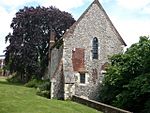 |
Franciscan Friars Minor (also known as Greyfriars) first started in Canterbury in 1224. They moved to this site around 1268. The friary closed in 1538. | 51°16′44″N 1°04′36″E / 51.2788839°N 1.0767943°E | |
| Canterbury — St Augustine's Abbey | 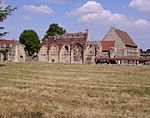 |
Benedictine monks started this abbey around 598, with help from King Æthelberht and St Augustine. It was refounded around 960. The abbey closed on July 30, 1538. Today, it's a historic ruin managed by English Heritage. | St Peter and St Paul | 51°16′41″N 1°05′17″E / 51.278126°N 1.088156°E |
| Canterbury — St Gregory's Priory | This was a religious community founded by Archbishop Lanfranc before 1086. It was refounded for Augustinian Canons Regular around 1123. The church burned down in 1145 but was rebuilt. The priory closed in 1536. | St Gregory's Hospital | 51°16′58″N 1°05′04″E / 51.2827159°N 1.0843608°E | |
| Canterbury — Priory of St Sepulchre | Benedictine nuns founded this priory around 1100, started by Archbishop Anselm. It closed in 1536. | St Sepulchre's Nunnery | 51°16′26″N 1°05′05″E / 51.2739107°N 1.0846424°E | |
| Canterbury — St Mary of the Angels Friary | Franciscan Friars Minor run this friary, which is involved with the Franciscan International Study Centre. It is still active today. | Friary of St Mary of the Angels | 51°17′45″N 1°03′42″E / 51.2957075°N 1.0615915°E | |
| Combwell Priory | Augustinian Canons Regular founded this abbey around 1220. It became a priory because it didn't have enough money. It closed in 1536. | Cumbwell Priory | 51°04′26″N 0°26′02″E / 51.0738537°N 0.4338795°E | |
| Darenth Priory | Benedictine monks lived here. It was a small part of Rochester Cathedral. It was founded after 971. We don't know when it closed. | 51°25′00″N 0°14′31″E / 51.4165689°N 0.2420104°E | ||
| Dartford Blackfriars | Dominican Friars started here in 1356, connected to the nunnery nearby. It closed in 1539. | |||
| Dartford Priory | 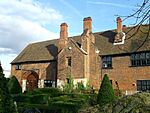 |
Dominican nuns founded this priory in 1346, started by King Edward III. It closed after 1539. King Henry VIII built a manor house on the site. Dominican nuns returned briefly in 1558 but it closed again after 1559. | St Mary and St Margaret | 51°26′58″N 0°12′53″E / 51.4494672°N 0.2148342°E |
| Davington Priory | 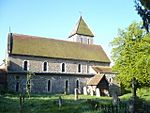 |
Benedictine nuns founded this priory in 1153. It closed in 1535. The church is still used today, and the priory buildings are now a private home. | The Priory Church of Saint Mary Magdalen, Davington | 51°19′09″N 0°53′03″E / 51.3191235°N 0.8842975°E |
| Dover Priory, earlier site | 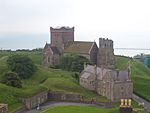 |
This was a Saxon minster (an early monastery) with secular canons (priests who lived in a community but weren't monks). It was founded in 640. The church was rebuilt in the 10th century. It fell into ruins but was restored in the 1800s. | St Mary in Castro | 51°07′42″N 1°19′24″E / 51.128374°N 1.3233697°E |
| Dover Priory | This priory was first for secular canons around 696. It was refounded for Augustinian Canons Regular in 1131. Later, Benedictine monks from Canterbury took over. It closed in 1535. The remains are now part of Dover College, a private school. | The Priory Church of Saint Mary the Virgin and Saint Martin | 51°07′37″N 1°18′27″E / 51.1270341°N 1.3075729°E | |
| Dover Minster | This was a Saxon minster founded in 691. It was rebuilt in the 1070s. It was used as a parish church but was later demolished. | 51°07′30″N 1°18′45″E / 51.1250006°N 1.3125336°E | ||
| Dover Preceptory (?) | This was a house for the Knights Templar (a military religious order) founded around 1128. It seems to have moved to Temple Ewell before 1185. | 51°07′09″N 1°18′12″E / 51.1190578°N 1.3034517°E | ||
| Faversham Abbey |  |
Cluniac monks (another Benedictine order) founded this abbey in 1148, started by King Stephen and Queen Maud. It became a Benedictine monks abbey by the 13th century. It closed on July 8, 1538. | St Saviour | 51°19′08″N 0°53′42″E / 51.318774°N 0.8948708°E |
| Folkestone Priory, earlier site | This was a Saxon minster and possibly for Benedictine nuns, founded before 640. It was destroyed by Danish raids before 927. Later, Benedictine monks from Lonlay, France, started a house here in 1095. They moved to a new site in 1137. | St Mary and St Eanswith | 51°04′45″N 1°11′01″E / 51.0790314°N 1.1837474°E | |
| Folkestone Priory | Benedictine monks moved here in 1137 from their earlier site. They were originally connected to Lonlay Abbey in France but became independent in 1399. The priory closed in November 1539 because it was in ruins. | Falkstone Priory | 51°04′43″N 1°10′53″E / 51.0786935°N 1.1813951°E | |
| Higham Priory | Benedictine nuns founded this priory around 1148, started by King Stephen. They were connected to St-Sulpice-la-Forêt in France but became independent after 1227. The priory closed in 1521-22. | Lillechurch Priory | 51°26′27″N 0°28′11″E / 51.4408812°N 0.4697406°E | |
| Hoo Monastery | This monastery for Benedictine monks was founded around 686-687. It was likely destroyed by Danish raids in the 9th century. | 51°27′24″N 0°29′19″E / 51.4565357°N 0.4886945°E (possible) or 51°24′36″N 0°33′29″E / 51.410135°N 0.558055°E (more likely) |
||
| Horton Priory | 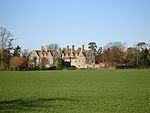 |
Cluniac monks (another Benedictine order) founded this priory around 1142. It was a small part of Lewes Priory in Sussex but became independent later. It closed in 1536. Its remains are now part of a private house. | The Priory Church of St John the Evangelist, Horton | 51°06′52″N 1°00′28″E / 51.1143114°N 1.0078186°E |
| Leeds Priory | Augustinian Canons Regular founded this priory in 1119. It closed around 1540. | St Mary and St Nicholas | 51°14′51″N 0°36′42″E / 51.2474614°N 0.611659°E | |
| Lossenham Friary | Carmelite Friars founded this friary around 1242-1247. It was destroyed by fire in 1275 but rebuilt. It closed in 1538. | Lossenham Whitefriars | 51°01′12″N 0°37′27″E / 51.0199877°N 0.6241071°E | |
| Lydd Monastery | This was a Saxon minster, possibly a monastery, founded after 774. It was destroyed by Danish raids in 893. Parts of the old monastery are now in the All Saints' parish church. | 50°57′06″N 0°54′25″E / 50.9517832°N 0.90693°E | ||
| Lyminge Abbey | This abbey was for Benedictine nuns and was founded around 633. It was later refounded for monks and nuns before 736. It was attacked by Danes but continued until after 964. | Liming Abbey | 51°07′35″N 1°05′13″E / 51.1262732°N 1.0869813°E | |
| Maidstone Friary | Carmelite Friars bought Allington Castle in 1951. It is now privately owned. | 51°17′36″N 0°30′41″E / 51.2934382°N 0.5114543°E | ||
| Minster in Sheppey Priory | This priory was for Benedictine nuns and was founded around 670. It was destroyed by Danish raids before 900. It was refounded several times, including for Augustinian Canonesses. It closed in 1536. Parts of the old church are now in the local parish church. | St Sexburga | 51°25′20″N 0°48′43″E / 51.422169°N 0.812071°E | |
| Minster in Thanet Priory, earlier site | This Saxon minster for Benedictine nuns was founded in 669. It was destroyed by Danish raids in 1011. | St Domneva | 51°19′49″N 1°18′56″E / 51.3303703°N 1.3156772°E (purported) | |
| Minster in Thanet Priory | Benedictine nuns moved to this site from the earlier one. | St Mary Virgin | 51°19′53″N 1°19′03″E / 51.331287°N 1.3175547°E | |
| Minster Abbey | Benedictine nuns founded this abbey in 1937 on the site of the older abbey. It is still active today. | |||
| Moatenden Priory | Trinitarian monks founded this priory in 1224. It closed in 1538. The site is now a house called 'Moatenden Manor'. | Mottenden Priory | 51°11′16″N 0°36′05″E / 51.1878755°N 0.601421°E | |
| New Romney Priory | This was a "double house" for Cistercian monks and nuns, founded in 1264. It was a farm belonging to Pontigny Abbey in France. It closed around 1414. | St John | 50°59′09″N 0°56′23″E / 50.9859411°N 0.9397951°E | |
| New Romney Greyfriars | Franciscan Friars Minor founded this friary before 1241. It closed around 1287. | Romney Greyfriars | 50°58′43″N 0°56′00″E / 50.9785373°N 0.9332371°E | |
| Newington Priory | This priory was for Benedictine nuns. Its founding date is unknown. It may have become a college for secular canons before 1179. | 51°20′42″N 0°39′18″E / 51.3449619°N 0.6549847°E (alleged) or 51°05′27″N 1°06′42″E / 51.0908601°N 1.1117005°E (possible) | ||
| Patrixbourne Priory | 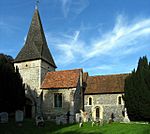 |
This was a Saxon minster. Later, Augustinian Canons Regular founded a priory here around 1200. It was connected to Beaulieu in Normandy, France. It closed in 1409. The church is still used today as the Parish Church of St Mary. | St Mary | 51°15′12″N 1°08′11″E / 51.2534448°N 1.1364627°E |
| Reculver Abbey |  |
Benedictine monks founded this abbey in 669. It was attacked by Danes. It was later joined to Canterbury in 949. | Raculfe Abbey | 51°22′46″N 1°11′59″E / 51.3795322°N 1.1997628°E |
| Rochester Cathedral Priory | This site was first for secular canons in 604. It became a cathedral and is still active today. Benedictine monks refounded the priory in 1080. It closed in 1540. | The Cathedral and Priory Church of Saint Andrew, Rochester | 51°23′20″N 0°30′12″E / 51.3889331°N 0.5032146°E | |
| St Radegund's Abbey | Premonstratensian Canons founded this abbey in 1193. It closed in 1536. It is now privately owned. | Bradsole Abbey | 51°07′55″N 1°15′03″E / 51.1318449°N 1.2507623°E | |
| Sandwich Whitefriars | Carmelite Friars founded this friary before 1268. It closed in 1538. | 51°16′24″N 1°20′18″E / 51.2733301°N 1.3384169°E | ||
| Shoreham Minster | This was a Saxon minster founded before 700. The current church on the site was built between 1230 and 1270. | 51°19′59″N 0°11′04″E / 51.3330517°N 0.1844019°E | ||
| Sutton-at-Hone Preceptory | This was a hospital founded before 1199. It was given to the Knights Hospitaller (another military religious order) in 1214, who set up a preceptory (a type of commandery). It closed in 1358. The remains are now a chapel and private home. | St John's Jerusalem | 51°24′39″N 0°14′25″E / 51.4108076°N 0.2403098°E | |
| Swingfield Preceptory | This was a house for the Knights Hospitaller founded before 1180. It closed in 1540. | St John's Commandery | 51°09′07″N 1°11′26″E / 51.151887°N 1.1904824°E | |
| Temple Ewell Preceptory |  |
Knights Templar founded this preceptory around 1185. It closed between 1308 and 1312. Knights Hospitaller refounded it in 1312. It closed in 1540. Its remains are now part of the local parish church. | 51°09′52″N 1°16′04″E / 51.164581°N 1.2677246°E | |
| Thanington Nunnery | This was St James's hospital, founded before 1164. It seems to have become a nunnery before 1343. It closed in 1551. | Tanington Hospital | 51°15′48″N 1°03′06″E / 51.2633583°N 1.0516995°E | |
| Throwley Priory | Benedictine monks founded this priory around 1150. It was a small part of St Bertin Abbey in France. It closed in 1414. A house called 'Glebe Cottage' is now on the site. | Thurleigh Priory | 51°16′00″N 0°51′23″E / 51.2667384°N 0.8563542°E | |
| Tonbridge Priory | Augustinian Canons Regular founded this priory before 1192. It closed on February 8, 1525. The site later became a railway goods station. | St Mary Magdalen | 51°11′28″N 0°16′24″E / 51.1911183°N 0.2733278°E | |
| West Langdon Abbey | Premonstratensian Canons founded this abbey in 1189. It closed in 1535. The site is now a 16th-century farmhouse used as a holiday cottage. | St Mary and St Thomas Martyr of Canterbury | 51°10′28″N 1°19′36″E / 51.1745237°N 1.3266903°E | |
| West Malling Abbey | 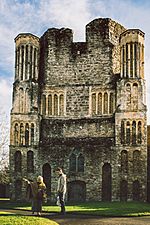 |
Benedictine nuns founded this abbey around 1090. It closed in 1538. | The Abbey Church of Saint Mary, West Malling | 51°17′36″N 0°24′45″E / 51.2932051°N 0.4124084°E |
| West Peckham Preceptory | Knights Hospitaller founded this preceptory in 1337. It closed in 1540. | West Peccham Hospital | 51°14′58″N 0°21′37″E / 51.2494727°N 0.360269°E |
See also
- List of monastic houses in EnglandReturn to top of page
Lancashire
(For more details and locations, see List of monastic houses in Lancashire edit)
This article is about the old monastic houses in Lancashire, England. Monastic houses were special buildings where groups of people, like monks or nuns, lived together. They followed strict religious rules and dedicated their lives to prayer, study, and work. These places were very important in medieval times, acting as centers for learning, charity, and farming.
In Lancashire, many different types of monastic houses existed. These included abbeys (led by an abbot or abbess), priories (smaller houses often linked to a larger abbey), and friaries (where friars lived, who were different from monks because they often traveled and preached). Over time, many of these houses were closed down, especially during the 1500s when King Henry VIII dissolved them.
Here's a look at some of the monastic houses that once stood in Lancashire:
Monastic Houses in Lancashire
Barnoldswick Abbey
Barnoldswick Abbey was home to Cistercian monks. These monks were known for living simple lives and often settling in remote areas. This abbey was founded on May 19, 1147. However, the monks moved to Kirkstall Abbey in Yorkshire just five years later, in 1152. After they left, Barnoldswick was used as a grange, which was like a large farm run by the monastery. Today, its remains are in a field called 'Monk's Royd'.
Beaumont Grange
Beaumont Grange was first home to Savignac monks. These monks were part of an order that later joined the Cistercians. It was founded around 1130. It was a large and important place. When the Savignac and Cistercian orders merged on September 17, 1147, the monks here became Cistercian.
Burscough Priory
Burscough Priory was a home for Augustinian Canons Regular. These canons were priests who lived together under a rule, similar to monks. The priory was founded around 1186 or 1190 by Robert Fitz Henry. It was dedicated to St Nicholas. Burscough Priory was closed down in 1536 during the Dissolution of the Monasteries.
Cockerham Priory
Cockerham Priory also housed Augustinian Canons Regular. It was a smaller house, known as a 'cell', connected to a larger abbey in Leicester. It was founded around 1207 or 1208. By the late 1200s, most of the canons had left, and a secular chaplain (a priest not part of a monastic order) was appointed. The priory was dissolved in 1477.
Cockersand Abbey
Cockersand Abbey started as a hospital dedicated to St Mary before 1184. It was founded by a hermit named Hugh Garth. Later, it became home to Premonstratensian Canons, who were also known as White Canons because of their white habits. It was made an abbey in 1192. The abbey was dissolved on January 29, 1539, and its land was later given to a private owner. Today, it is still privately owned.
Heysham Monastery
There is a suggestion that an early monastic settlement existed at Heysham. The church of St Peter, built in the 14th or 15th century, stands on this site. It includes parts that are much older, from before the Norman Conquest (around 800-950 AD). This suggests that religious activity has been happening here for a very long time.
Hornby Priory
Hornby Priory was a cell for Premonstratensian Canons, connected to Croxton Abbey. It might have started as a hospital between 1160 and 1172. The priory itself was likely founded around 1172. It was dedicated to St Wilfrid. Hornby Priory was dissolved in September 1538.
Lancaster Blackfriars
Lancaster Blackfriars was a home for Dominican Friars. Friars were different from monks because they often lived among people in towns and cities, preaching and helping the poor. The Dominicans were also known as 'Blackfriars' because of their black cloaks. This friary was founded in 1259 or 1260 by Sir Hugh Harrington. It was dissolved in 1539.
Lancaster Greyfriars
Lancaster also had a house for Franciscan Friars. These friars were known as 'Greyfriars' because of their grey habits. There is some evidence that a Franciscan house existed here, but its exact location and the dates it was founded and dissolved are not fully known.
Lancaster Priory
Lancaster Priory was home to Benedictine monks. The Benedictines are one of the oldest monastic orders. This priory was founded around 1094 by Earl Roger of Poictiers. It was an 'alien house', meaning it was dependent on a larger monastery in Séez, France. Lancaster Priory was dissolved in 1428.
Lytham Priory
Lytham Priory was another house for Benedictine monks. It was a 'cell' connected to Durham Cathedral. It was founded between 1189 and 1194 by Richard Fitz Rogers. The priory was dissolved in 1535 or 1534. The original building was demolished, and a country house was built on its site in the 17th century. It was dedicated to St Mary and St Cuthbert.
Penwortham Priory
Penwortham Priory was also a home for Benedictine monks. It was founded around 1104, thanks to the generosity of Warine Bussel. This priory was dissolved around 1535.
Preston Greyfriars
Preston Greyfriars housed Franciscan Friars Minor, Conventual. Like the Greyfriars in Lancaster, they wore grey habits and lived among the people. This friary was founded around 1256 or 1260 by Edmond, Earl of Lancaster. It was dissolved in 1539.
Sawley Abbey
Sawley Abbey was a home for Cistercian monks. These monks came from Newminster Abbey in Northumberland. The abbey was probably founded on January 6, 1147, by William de Percy. The monks likely arrived a year later. Sawley Abbey was dissolved in 1536. Today, its ruins are cared for by English Heritage.
Staining Grange
Staining Grange was a grange (a monastic farm) for Cistercian monks. It belonged first to Stanlow Abbey and then to Whalley Abbey. It was founded before 1240.
Tulketh Priory
Tulketh Priory was home to Savignac monks. It was founded on July 4, 1124, by Stephen, who later became King of England. However, the monks moved to Furness Abbey in Cumbria just three years later, in 1127.
Upholland Priory
Upholland Priory started as a chantry and collegiate chapel, which means it was a place for prayers and a college for priests. It was founded between 1307 and 1310. Later, in 1319, it became a priory for Benedictine monks or friars, founded by Walter Langton, who was a bishop. Upholland Priory was dissolved in 1536. Today, its remains are part of the Parish Church of St Thomas the Martyr.
Whalley Abbey
Whalley Abbey was a large and important house for Cistercian monks. The community of monks first lived at Stanlow Abbey in Cheshire, starting in 1172. They then moved to Whalley and founded the abbey there on April 4, 1296. Whalley Abbey was dissolved on March 10, 1537. Today, parts of the abbey are owned by the Anglican Diocese of Blackburn and the Catholic Church. It was dedicated to The Blessed Virgin Mary.
Wyresdale Abbey
Wyresdale Abbey was intended for Cistercian monks from Furness Abbey and Savigny Abbey. It was founded around 1193 or 1196. However, the monks later moved to Ireland. Traditionally, the site of this abbey is believed to be near the Abbeystead reservoir.
Images
See also
- List of monastic houses in EnglandReturn to top of page
Leicestershire
(For more details and locations, see List of monastic houses in Leicestershire edit)
Imagine a time long ago when people dedicated their lives to prayer, study, and helping others, living together in special communities. These places were called monastic houses. In Leicestershire, England, there were many such houses, including abbeys, priories, and friaries.
- Monks and nuns lived in abbeys and priories. They followed strict rules and spent their days in prayer, work, and study.
- Friars were similar but often lived in towns and went out to preach and help people.
- A preceptory was a base for military-religious orders like the Knights Templar or Knights Hospitaller.
Most of these houses were closed down in the 1530s by King Henry VIII during an event called the Dissolution of the Monasteries. Today, only ruins or new buildings remain at many of these historic sites.
Ancient Monastic Sites
Some of the earliest monastic sites in Leicestershire date back to Anglo-Saxon times.
Holy Hill Monastery, Breedon
This was likely the oldest monastic site in Leicestershire. It was founded in the late 600s by Benedictine monks from Peterborough. Sadly, it was abandoned around 874 during raids by the Vikings.
Breedon Priory
Later, between 1109 and 1122, an Augustinian Priory was built on the same site. It was called Breedon Priory. The church of Saints Mary and Hardulph was given to Nostell Priory in Yorkshire. This priory was closed in 1539.
Priories and Abbeys
Many different types of monastic houses existed across Leicestershire.
Belvoir Priory
Belvoir Priory was a home for Benedictine monks. It was founded between 1076 and 1088 by Robert de Todeni, the lord of Belvoir. This priory was a "cell," meaning it was a smaller house dependent on the much larger St Albans Abbey in Hertfordshire. It was closed in 1539.
Croxton Abbey
Croxton Abbey was founded before 1160 by William Porcarius. It was home to Premonstratensian Canons, who were a type of religious order. The abbey was closed in 1538. Today, only ruins remain.
Garendon Abbey
This abbey was founded on October 28, 1133, by Robert Bossu, the Earl of Leicester. It was home to Cistercian monks. Garendon Abbey was likely a "daughter house" of Waverley Abbey in Surrey. It was closed in 1536. A house called 'Garendon Hall' was later built on the site, but it was demolished in 1964.
Grace Dieu Priory
Grace Dieu Priory was founded around 1239 or 1240 by Rose de Verdon. It was home to Augustinian Canonesses, also known as the 'White Nuns of St Augustine'. The priory was closed in 1538. Today, some remains are part of a cottage, and the site is open to the public.
Hinckley Priory
Hinckley Priory was an "alien house," meaning it was a cell dependent on a monastery in another country, Lyre in France. It was home to Benedictine monks and was founded before 1173. The priory was closed in 1409. Later, a mansion and then private houses were built on the site.
Kirby Bellars Priory
This priory started as a college or chantry in 1316. It later became home to Augustinian Canons Regular in 1359. After a fire around 1511, the buildings were rebuilt. The priory was closed in 1536. Today, you can still see earthworks that mark the site in a field north of the local church.
Langley Priory
Langley Priory was founded around 1150 by William Pantulf and his wife. It was home to Benedictine nuns. For a time, it was thought to be a Cistercian nunnery, but this claim was dropped. The priory was closed in 1536. Parts of the medieval building are still part of a house today.
Launde Priory
Launde Priory was founded between 1119 and 1125 by Richard Basset and his wife Maud. It housed Augustinian Canons Regular. The priory was closed in 1539. Today, the site is home to a manor house called 'Launde Abbey', which is now a retreat and conference centre.
Mount St Bernard Abbey
This is a unique case because it's still active! The first Mount St Bernard Abbey was founded in 1835 by Cistercian monks (also known as Trappists). A new, larger monastery was built in 1844, and the original site became a guest house. The new abbey is still active today, with monks living there.
Owston Abbey
Owston Abbey was founded before 1161 by Sir Robert Grimbald. It was home to Augustinian Canons Regular. The abbey was closed in 1536. The site is now private property, known as Manor Farm, but the church has been restored and is still used by the local community.
Ulverscroft Priory
Ulverscroft Priory was founded before 1174 by Robert, Earl of Leicester. It was home to Augustinian Canons Regular. Although many monasteries were closed in 1536, Ulverscroft managed to avoid this for a few years. It was finally closed on September 15, 1539. The site is now privately owned.
Monastic Houses in Leicester
The city of Leicester itself was home to several important monastic communities.
Leicester Abbey
Leicester Abbey was founded in 1143 by Robert Bossu, the Earl of Leicester. It housed Augustinian Canons Regular. The abbey was a very important religious centre in the region. It was closed in 1538. Its formal name was "The Abbey Church of the Assumption of the Blessed Virgin Mary."
Leicester Friaries
Leicester had several friaries, which were homes for different orders of friars:
- Austin Friars: These Augustinian hermits founded their house in 1254. It was closed in November 1538.
- Blackfriars: These were Dominican Friars, founded before 1284. Their house was closed in 1538.
- Greyfriars: These were Franciscan Friars Minor, founded before 1230. This friary is famous as the burial place of King Richard III after he died at the Battle of Bosworth Field in 1485. His body was found there in 2013! The friary was closed in 1538.
- Holy Cross Priory: This is a modern Dominican Friary founded in 1882. Its church was consecrated in 1958, and it is still active today.
- Friars of the Sack: This was a smaller order of friars, founded before 1274. Their house was abandoned by 1295.
Preceptories
Preceptories were bases for military-religious orders.
Dalby and Heather Preceptory
This preceptory was home to the Knights Hospitallers, a famous military-religious order. It was founded before 1206. The preceptory was closed in 1538.
Rothley Temple
Rothley Temple was first home to the Knights Templar, another famous military order, founded in 1231. Their chapel was built around 1240. Later, in 1312, the property was transferred to the Knights Hospitaller. It was eventually taken over by the Crown. A manor house was later built on the site.
Swinford Preceptory
This preceptory was also for the Knights Hospitaller, founded before 1199. It was managed under the Dalby preceptory for a time. It was closed in 1538.
Images
See also
- List of monastic houses in EnglandReturn to top of page
Lincolnshire
(For more details and locations, see List of monastic houses in Lincolnshire edit)
Monastic houses were special places where groups of people, like monks or nuns, lived together under religious rules. They dedicated their lives to prayer, work, and study. In Lincolnshire, England, there were many such houses, including abbeys, priories, and friaries. These places played a big role in society, offering education, healthcare, and shelter, especially during the Middle Ages.
This article explores some of the most important monastic sites in Lincolnshire. It explains who lived there, when they were founded, and what happened to them. Many of these ancient buildings are now ruins, while others have become parts of modern churches or homes.
Alien houses are included, as are smaller establishments such as cells and notable monastic granges (particularly those with resident monks), and also camerae of the military orders of monks (Knights Templars and Knights Hospitaller). Monastic hospitals are included where they had the status or function of an abbey, priory, friary or preceptor/commandery.
- Abbreviations and key
| Symbol | Status |
|---|---|
| None | Ruins |
| * | Current monastic function |
| + | Current non-monastic ecclesiastic function (including remains incorporated into later structure) |
| ^ | Current non-ecclesiastic function (including remains incorporated into later structure) or redundant intact structure |
| $ | Remains limited to earthworks etc. |
| # | No identifiable trace of the monastic foundation remains |
| ~ | Exact site of monastic foundation unknown |
| ≈ | Identification ambiguous or confused |
Locations with names in italics indicate possible duplication (misidentification with another location) or non-existent foundations (either erroneous reference or proposed foundation never implemented) or ecclesiastical establishments with a monastic name but lacking actual monastic connection.
| EH | English Heritage |
| LT | Landmark Trust |
| NT | National Trust |
Understanding Monastic Houses
What is a Monastic House?
A monastic house is a building or group of buildings where monks or nuns live together. They follow a specific set of religious rules. These communities were very important in medieval times. They were centers of learning, prayer, and charity.
Different Types of Monastic Houses
There were several types of monastic houses in England:
- Abbeys: These were large, independent communities led by an Abbot (for monks) or an Abbess (for nuns).
- Priories: Smaller than abbeys, priories could be independent or dependent on a larger abbey. They were led by a Prior or Prioress.
- Friaries: These were homes for friars, who were different from monks. Friars lived among people in towns and cities, often begging for food and helping the poor.
- Preceptories: These were houses for military religious orders, like the Knights Templar or Knights Hospitaller. They managed lands and recruited members.
- Nunnery: A general term for a monastic house for nuns.
- Cell: A very small monastic house, usually dependent on a larger abbey.
- Alien House: This term means the monastic house was controlled by a larger monastery in another country, usually France.
Why were they "Dissolved"?
The term "dissolved" means that these monastic houses were officially closed down. This happened mostly during the reign of Henry VIII of England in the 1530s. The King wanted to take control of their wealth and lands. Many buildings were destroyed, while others were sold off.
Notable Monastic Houses in Lincolnshire
Lincolnshire had many monastic houses. Here are some interesting examples:
Bardney Abbey: A Story of Destruction and Rebirth
- Saxon Monastery: The first monastery at Bardney was founded around 697 by King Æthelred of Mercia. He even became a monk and abbot there!
- Viking Raids: Sadly, this early monastery was destroyed by Viking raiders in 870.
- Benedictine Abbey: It was rebuilt as a Benedictine priory in 1087. Later, it became a full abbey in 1115.
- Dissolution: Bardney Abbey was dissolved in 1538. Its lands were given to Sir Robert Tirwhit. Today, you can visit its ruins.
Alvingham Priory: A Double House Community
- Gilbertine Order: This priory was unique because it was a "double house." This meant both Gilbertine Canons (monks) and Canonesses (nuns) lived there.
- Foundation: It was founded between 1148 and 1154.
- Dissolution: Alvingham Priory was dissolved in 1538. Some parts of it are still used as a church today.
Aslackby Preceptory: Home of the Knights Templar
- Knights Templar: This was a preceptory, a base for the Knights Templar. They were a military religious order, famous for protecting pilgrims. It was founded around 1164.
- Knights Hospitaller: After the Templars were dissolved, the preceptory was transferred to the Knights Hospitaller in the early 1300s.
- Modern Remains: Today, parts of the old preceptory are built into an 18th-century farmhouse.
Axholme Priory: A Quiet Carthusian Life
- Carthusian Monks: This priory housed Carthusian monks. They lived a very strict and quiet life, often in separate cells.
- Foundation: It was founded between 1395 and 1396 by Thomas Mowbray.
- Conversion: After its dissolution in 1538, the priory was turned into a manor house.
Barlings Abbey: A Premonstratensian Community
- Premonstratensian Canons: This abbey housed Premonstratensian canons, who were a type of religious order.
- Foundation: It was first founded in 1154-55. The community moved to a new site shortly after.
- Dissolution: Barlings Abbey was dissolved in 1537. Its stones were used to build other structures.
Crowland Abbey: A Long History of Faith
- Early Beginnings: A Saxon monastery existed here before 757. It was destroyed by Viking raiders in 870.
- Benedictine Restoration: The monastery was rebuilt and restored in 948.
- Dissolution and Survival: It was dissolved in 1539. The eastern part of the church was destroyed. However, a large part of the church is still used as a parish church today.
Deeping St James Priory: A Dependent Cell
- Benedictine Monks: This was a small priory, or "cell," dependent on Thorney Abbey in Cambridgeshire.
- Foundation: It was founded in 1139.
- Parochial Use: The priory church is still used as the Parish Church of St James today.
Eagle Preceptory: Another Templar Stronghold
- Knights Templar: This preceptory was founded before 1154 by Stephen of England. It served as a hospital and a base for the Templars.
- Knights Hospitaller: Like Aslackby, it was transferred to the Knights Hospitaller in 1312.
- Dissolution: It was dissolved in 1540.
Kirkstead Abbey: A Cistercian Foundation
- Cistercian Monks: Kirkstead Abbey was home to Cistercian monks, known for their simple and strict lives.
- Relocation: The community first settled at an earlier site in 1139. They moved to the current site in 1187.
- Dissolution: The abbey was dissolved in 1537. Its gatehouse chapel is still used as a local church.
Monastic Houses in Major Towns
Lincoln's Friaries: Urban Religious Life
The city of Lincoln was home to several friaries, different from abbeys and priories because friars lived and worked directly within towns.
- Austin Friars: Founded around 1269-70.
- Blackfriars (Dominican Friars): Founded before 1238.
- Greyfriars (Franciscan Friars): Founded around 1230. Part of their building now houses the City Museum.
- Whitefriars (Carmelite Friars): Founded before 1260.
- St Catherine's Priory: A Gilbertine priory founded after 1148.
- St Mary Magdalen Priory: A Benedictine cell, refounded around 1135. Its remains are now in a public park.
Boston's Friaries: A Hub of Religious Orders
The town of Boston was an important port and had several friaries:
- Boston Austin Friars: Founded in 1317-18.
- Boston Blackfriars: Founded before 1288. Parts of their buildings, like Shodfriars Hall, still exist.
- Boston Greyfriars: Founded before 1268.
- Boston Whitefriars: Founded in 1293, they moved to a new site in 1307.
- Boston Priory: A Benedictine priory founded around 1089. The famous Boston Stump was built on its site.
Grimsby's Monastic Past
Grimsby also had its share of monastic communities:
- Grimsby Abbey (Wellow Abbey): An Augustinian abbey founded around 1132.
- Grimsby Nunnery: An Augustinian nunnery founded before 1184.
- Grimsby Austin Friars: Founded in 1293.
- Grimsby Greyfriars: Likely founded before 1240.
Stamford's Rich Monastic History
Stamford was another important town with many religious houses:
- Stamford Austin Friars: Founded in 1343.
- Stamford Blackfriars: Founded before 1241.
- Stamford Friars of the Sack: Existed before 1274 but closed by 1300.
- Stamford Greyfriars: Founded before 1230.
- Stamford Whitefriars: Founded before 1268.
- Stamford — St Leonard's Priory: A Benedictine priory founded after 1083 on the site of an even older Saxon monastery.
Images
See also
- List of monastic houses in EnglandReturn to top of page
Merseyside
(For more details and locations, see List of monastic houses in Merseyside edit)
This article is about the monastic houses in Merseyside, England. Monastic houses were special places where groups of people, like monks or nuns, lived together. They dedicated their lives to religious practices, prayer, and often helped their local communities. These places were very important in medieval times, acting as centers for learning, healing, and charity.
What are Monastic Houses?
Monastic houses were buildings or groups of buildings where monks or nuns lived according to specific religious rules. These communities were often led by an abbot or a prior. They spent their days in prayer, study, and work. Many monasteries also had farms, libraries, and even hospitals. They played a huge role in society, preserving knowledge and helping the poor.
Famous Monastic Houses in Merseyside
Merseyside was home to a few important monastic sites. Here's a look at some of them:
Birkenhead Priory
Birkenhead Priory was a home for Benedictine monks. It was started around 1150 by a powerful person named Hamon de Masci. The monks here followed the rules of St. Benedict, which included living simply and dedicating their lives to God.
The priory was named after St James the Great. Over time, it was also known by names like Birkenhedde Priory or Byrkett Priory. Monasteries like this were very common across England during the Middle Ages.
However, in 1536, a big change happened. King Henry VIII decided to close down all monasteries in England. This event is known as the "Dissolution of the Monasteries." After it closed, Birkenhead Priory was given to a person named Ralph Worseley in 1544 or 1545. Today, parts of the priory still stand and can be visited.
Bromborough Monastery
Bromborough Monastery was another early religious site in Merseyside. It was built by Aethelflaed, a powerful Anglo-Saxon queen known as the "Lady of the Mercians." She was a very important figure in English history.
This monastery was later given to the Abbey of St Werburgh in 1152. Sadly, over many years, the building fell apart. By 1827, it was completely ruined and had to be demolished. Later, new churches were built on or near the site, sometimes even using materials from the old monastery.
Hilbre Island Monastery
Hilbre Island Monastery was a unique monastic site located on Hilbre Island. This island is off the coast of the Wirral Peninsula. This monastery was also home to Benedictine monks and was founded after 1093.
It was a "cell" of Our Lady of monks, Chester. This means it was a smaller branch or outpost of a larger monastery in Chester. It might have been more of a hermitage, which is a quiet place where a single hermit (a person living alone for religious reasons) would live. Even so, a "prior" (a leader of a small monastery) was linked to it.
The monastery was dedicated to St Mary. Like other monasteries, it was closed during the Dissolution of the Monasteries in 1539.
See also
- List of monastic houses in EnglandReturn to top of page
Norfolk
Monastic houses are special places where groups of people, like monks or nuns, lived together a religious life. They followed strict rules, prayed, studied, and often helped their local communities. These places, which included abbeys, priories, and friaries, were very important in England many centuries ago.
This list tells you about the different monastic houses that once existed in Norfolk, a county in England. Many of these buildings are now ruins, but some parts are still used today, perhaps as churches or even homes!
Alien houses are included, as are smaller establishments such as cells and notable monastic granges (particularly those with resident monks), and also camerae of the military orders of monks (Knights Templars and Knights Hospitaller). Monastic hospitals are included where they had the status or function of an abbey, priory, friary or preceptor/commandery.
- Abbreviations and key
| Symbol | Status |
|---|---|
| None | Ruins |
| * | Current monastic function |
| + | Current non-monastic ecclesiastic function (including remains incorporated into later structure) |
| ^ | Current non-ecclesiastic function (including remains incorporated into later structure) or redundant intact structure |
| $ | Remains limited to earthworks etc. |
| # | No identifiable trace of the monastic foundation remains |
| ~ | Exact site of monastic foundation unknown |
| ≈ | Identification ambiguous or confused |
Locations with names in italics indicate possible duplication (misidentification with another location) or non-existent foundations (either erroneous reference or proposed foundation never implemented) or ecclesiastical establishments with a monastic name but lacking actual monastic connection.
| EH | English Heritage |
| LT | Landmark Trust |
| NT | National Trust |
Monastic Houses in Norfolk
This section lists the various monastic houses that existed in Norfolk. Each entry includes details about who lived there, when it was founded, and what happened to it.
| Name | Image | Who Lived There and Their Story | Other Names | Location |
|---|---|---|---|---|
| Aldeby Priory |
|
Benedictine monks lived here. It was founded around 1100-1119 by Bishop Herbert de Losinga. The monks likely used the local church for their services. The priory was later given to Norwich Cathedral. | The Priory Church of Saint Mary, Aldeby Priory | 52°28′43″N 1°35′56″E / 52.4785591°N 1.5989614°E |
| Beeston Regis Priory | First, Augustinian Canons Regular lived here, founded around 1216. Later, it was refounded for Carmelite Friars in 1400. It closed in 1539. | The Priory Church of Saint Mary, Beeston Regis Beeston Priory |
52°56′19″N 1°13′27″E / 52.9387429°N 1.2241763°E |
|
| Binham Priory | Benedictine monks from St Albans Abbey founded this priory around 1091. It closed in 1539. Today, the main part of the church is still used by the local community. | The Priory Church of Saint Mary the Virgin, Binham Priory | 52°55′12″N 0°56′48″E / 52.920026°N 0.94667°E | |
| Blackborough Priory | First, Benedictine monks founded this priory around 1150. Later, it became a "double house" for both monks and nuns around 1170. By 1200, only Benedictine nuns lived there. It closed in 1537. | The Priory Church of the Blessed Virgin Mary and Saint Catherine, Blackborough | 52°41′54″N 0°28′30″E / 52.6982645°N 0.4749656°E |
|
| Blakeney Friary | Carmelite Friars started this friary between 1304-1316. The buildings were finished by 1321. It closed in 1538, and parts of it are now part of a farmhouse. | Snitterley Whitefriars; Sniterley Whitefriars | Blakeney52°57′19″N 1°01′24″E / 52.9553103°N 1.0234076°E | |
| Bradmer Friary | Carmelite Friars founded this place around 1241. They later moved to a new site at Burnham Norton around 1253. | |||
| Bromehill Priory | Augustinian Canons Regular founded this priory before 1224. It was closed down in 1528 to help fund a college. | The Priory Church of the Blessed Virgin Mary and Saint Thomas the Martyr, Bromehill | 52°27′26″N 0°37′59″E / 52.4572156°N 0.6331784°E | |
| Bromholm Priory | Cluniac monks founded this priory in 1113. It was an alien house, meaning it was controlled by a monastery in another country, but later became independent. It closed in 1536. | The Priory Church of St Andrew, Bromholm Broomholm Priory |
52°50′46″N 1°28′57″E / 52.8460646°N 1.4823765°E |
|
| Burnham Norton Friary | Carmelite Friars moved here in 1253 from Bradmer. The friary closed in 1538. | 52°57′04″N 0°44′06″E / 52.9510297°N 0.7349038°E | ||
| Carbrooke Preceptory | This was a base for the Knights Templar before 1173, and then for the Knights Hospitaller around 1182. Both were military-religious orders. It closed in 1540. | Carbroke Preceptory | 52°34′54″N 0°52′42″E / 52.5816927°N 0.878225°E | |
| Carbrook Cell | This was a small house for Sisters of the Order of St John of Jerusalem. It was later moved around 1180. | |||
| Carrow Priory | Benedictine nuns moved here in 1146. The priory closed in 1536. Parts of the prioress's house are still used today. | The Priory Church of Saint Mary of Carhowe | 52°37′06″N 1°18′41″E / 52.6182939°N 1.3114795°E |
|
| Castle Acre Priory | Cluniac monks founded this priory in 1089. It was an alien house but became independent later. It closed in 1537. The prior's living quarters are now a residence. | The Priory Church of Saint Mary, Castle Acre Priory Church of Saint Mary, Saint Peter and Saint Paul Castleacre Priory |
52°42′00″N 0°41′06″E / 52.7000346°N 0.6850147°E |
|
| Choseley Monastery | This monastery was for the Lazarites, founded before 1273. It closed in 1544-1545. | |||
| Coxford Priory | Augustinian Canons Regular moved here around 1216 from Rudham. The priory closed in 1536. | Cokesford Priory | 52°49′37″N 0°44′30″E / 52.82698°N 0.74172°E | |
| Crabhouse Priory | Augustinian Canonesses founded this priory around 1181. It was rebuilt several times due to floods. It closed in 1536, and a house called 'Crabb's Abbey' was built on the site. | The Priory Church of the Blessed Virgin Mary and Saint John the Evangelist St Mary, St John and St Thomas |
52°38′40″N 0°21′55″E / 52.6444045°N 0.3653544°E |
|
| Creake Abbey | This started as a hospital with a chapel before 1189. It became a priory for Augustinian Canons Regular in 1206, and then an abbey in 1231. Sadly, the canons were wiped out by the plague in 1506. | The Priory Church of Saint Mary de Pratis North Creake Abbey; Creek Abbey |
|
|
| Custhorpe Cell(?) | This was possibly a small cell (a dependent house) for Augustinian Canons Regular from West Acre. | 52°42′05″N 0°38′41″E / 52.701421°N 0.6448487°E |
||
| Docking Priory | Benedictine monks lived in this alien house (a cell or grange) from the 12th century. It closed in 1455. | 52°53′34″N 0°36′53″E / 52.8926583°N 0.6147945°E |
||
| East Dereham Monastery | This was a nunnery for Saxon nuns founded before 743. It was likely destroyed by the Danes around 870. Only a holy well remains today. | 52°40′51″N 0°56′14″E / 52.6809578°N 0.937132°E | ||
| Field Dalling Grange | This was a grange (a farm managed by monks) for Savignac monks from 1138, which later became Cistercian monks when the orders merged. It closed in 1414. | Dallingfield Priory; Field-Dalling Priory; Fieldallyng Priory | 52°54′17″N 0°59′09″E / 52.9045926°N 0.9858727°E |
|
| Flitcham Priory | Augustinian Canons Regular founded this priory around 1217. It was in poor condition by 1528 and closed in 1538. A house was built on the site in the 16th century. | St Mary ad Fontes | 52°48′32″N 0°34′20″E / 52.8088678°N 0.5723405°E |
|
| Gorleston Friary | Augustinian Friars founded this friary before 1267. It closed in 1538. | |||
| Great Massingham Priory | This was first a hospital, then became a priory for Augustinian Canons Regular around 1260. It was in disrepair by 1475 and later closed in 1538. | St Mary and St Nicholas Massingham Magna |
52°46′30″N 0°39′43″E / 52.7748649°N 0.6618565°E |
|
| Great Witchingham Grange | This was a grange for Cluniac monks after 1093. It closed after 1414. | |||
| Great Yarmouth — St Nicholas's Priory | Benedictine monks founded this priory in 1101. The church was associated with the priory. It closed in 1539, was restored, but then destroyed by bombing in World War II. It has been restored again and is now a parish church. | The Priory Church of Saint Nicholas, Great Yarmouth; | 52°36′39″N 1°43′38″E / 52.610967°N 1.7273158°E |
|
| Great Yarmouth Austin Friary | Augustinian Friars supposedly had a cell here, with royal permission granted in 1339. Its exact end date is unknown. | 52°35′11″N 1°43′29″E / 52.5864042°N 1.724622°E |
||
| Great Yarmouth Blackfriars | Dominican Friars founded this friary before 1267. It was flooded in 1287 and the church was destroyed by fire in 1525. It closed in 1538. | 52°36′01″N 1°43′43″E / 52.6002293°N 1.7287427°E |
||
| Great Yarmouth Greyfriars | Franciscan Friars Minor founded this friary between 1226 and 1271. It closed in 1538. Parts of the monastic buildings are still visible today. | 52°36′19″N 1°43′34″E / 52.6051815°N 1.7262161°E |
||
| Great Yarmouth Whitefriars | Carmelite Friars founded this friary before 1277. It was destroyed by fire in 1509 and closed in 1538. A house was built on the site in the 17th century. | 52°36′30″N 1°43′25″E / 52.6082046°N 1.7236733°E |
||
| Haddiscoe Preceptory | This was a base for the Knights Templar before 1218. It closed between 1308 and 1312. | 52°30′58″N 1°35′41″E / 52.5162065°N 1.5948173°E |
||
| Heacham Grange | This was a grange (farm) for Cluniac monks from Lewes Priory before 1088. It's debated whether monks actually lived here full-time. | 52°54′16″N 0°28′54″E / 52.9045214°N 0.481655°E |
||
| Hempton Priory | This started as a hospital before 1135 and then became a priory for Augustinian Canons Regular. It closed in 1536. | The Priory Church of Saint Stephen, Hempton Fakenham Priory; Hampton Priory |
52°49′25″N 0°50′34″E / 52.8235448°N 0.8428064°E |
|
| Hickling Priory | Augustinian Canons Regular founded this priory in 1185. It closed in 1536. | The Priory Church of Saint Mary, Saint Augustine and All Saints, Hickling | 52°46′03″N 1°35′01″E / 52.7674128°N 1.5834769°E |
|
| Hitcham Cell | Cluniac monks had a cell here during the reign of William II. It closed and was granted to the Duke of Norfolk. | |||
| Horsham St Faith Priory | Benedictine monks founded this alien house around 1105. It became independent in 1390 and closed in 1536. | The Priory Church of Saint Faith, Horsham | 52°41′17″N 1°16′39″E / 52.6881677°N 1.2774611°E |
|
| Horstead Priory | This was an alien house for Benedictine monks (or a grange) founded around 1090. It closed in 1414. | Horestead Grange; Horstead Priory | 52°43′17″N 1°20′42″E / 52.7214974°N 1.3451278°E |
|
| Ingham Priory | This started as a college for secular canons around 1355, then became a priory for Trinitarian Canons in 1360. It closed in 1536. A pub, The Swan Inn, now stands on part of the site. | The Priory Church of the Holy Trinity and All Saints, Ingham | 52°46′45″N 1°32′38″E / 52.7790672°N 1.5437937°E |
|
| King's Lynn Benedictine Priory | Benedictine monks founded this priory in 1095. It closed in 1538. Parts of the site are now within St Margaret's churchyard. | The Priory & Parish Church of Saint Margaret with Saint Mary Magdalen and All the Virgin Saints, King's Lynn | 52°45′05″N 0°23′43″E / 52.7514867°N 0.3953362°E |
|
| King's Lynn Austin Friars | Augustinian Friars founded this friary before 1295. It closed in 1538. | 52°45′23″N 0°23′49″E / 52.7563277°N 0.3970152°E |
||
| King's Lynn Blackfriars | Dominican Friars founded this friary before 1256. It closed in 1539. | 52°45′13″N 0°23′59″E / 52.75349°N 0.3997242°E |
||
| King's Lynn Greyfriars | Franciscan Friars Minor founded this friary around 1230. It closed in 1538. | 52°45′04″N 0°23′58″E / 52.7511068°N 0.3993326°E |
||
| King's Lynn Sack Friary | Friars of the Sack founded this friary before 1266. It closed after 1307. | 52°44′59″N 0°23′50″E / 52.7497821°N 0.3972834°E |
||
| King's Lynn Whitefriars | Carmelite Friars founded this friary before 1260. It closed in 1538. | White Friars, King's Lynn | 52°44′56″N 0°23′49″E / 52.7488859°N 0.3969616°E |
|
| Kirkscroft Priory | Benedictine monks had an alien house here around 1105. They soon moved to Horsham St Faith. | The Blessed Virgin Mary | ||
| Langley Abbey | Premonstratensian Canons founded this abbey in 1198. It closed in 1536. | 52°34′20″N 1°29′08″E / 52.572177°N 1.4856005°E |
||
| Lessingham Priory | This was an alien house (cell or grange) for Benedictine monks from Bec-Hellouin around 1090. It closed around 1414. | 52°48′04″N 1°32′49″E / 52.8010377°N 1.5470606°E |
||
| Ling Priory | This was a priory for Benedictine nuns. Its founding date is unknown, but it closed around 1160. | |||
| Ludham, St Benet's Abbey |
|
This site was first home to hermits and Saxon monks around 800, but was destroyed by Danes. It was rebuilt for Benedictine monks by Cnut. It was never officially closed, but was abandoned before 1539. | St Benet of Holm Abbey; St Benet's of Hulme Abbey | 52°41′09″N 1°31′30″E / 52.6859386°N 1.525088°E |
| Marham Abbey | Cistercian nuns founded this abbey in 1249. It closed in 1536. | The Blessed Virgin Mary, St Barbara and St Edmund, Marham | 52°39′33″N 0°31′22″E / 52.6592°N 0.5227°E |
|
| Modeney Priory | Benedictine monks lived here before 1291. It closed around 1536. | Modney Priory | 52°32′24″N 0°22′06″E / 52.5400383°N 0.3682941°E |
|
| Molycourt Priory | Benedictine monks lived here from before the Norman Conquest. It was a cell of Ely and closed in 1539. | St Mary Bello Loco Mullicourt Priory |
52°36′09″N 0°15′39″E / 52.6023699°N 0.2607536°E |
|
| Mountjoy Priory | This was first a cell for Benedictine monks after 1189, then given to Augustinian Canons Regular after 1199. It closed in 1529. | St Laurence St Mary the Virgin, St Michael and St Laurence Monte Jovis Priory |
52°43′31″N 1°11′40″E / 52.7253868°N 1.1943475°E |
|
| Narford Cell | This was a supposed cell for Augustinian Canons Regular from West Acre, where a canon might have served in the Chapel of St Thomas a Becket. | 52°41′10″N 0°36′09″E / 52.6860866°N 0.6024671°E |
||
| Newbridge Hermitage | This was a hermit's chapel, founded in 1094. | |||
| Normansburgh Priory | First, Augustinian Canons Regular founded this priory around 1160. Then, it became an alien house for Cluniac monks around 1200. It became independent later and closed in 1537. | The Priory Church of Saint Mary the Virgin and Saint John the Evangelist Norman's Burrow Priory |
52°46′50″N 0°48′03″E / 52.7805015°N 0.8008325°E |
|
| Norwich Austin Friars | Augustinian Friars founded this friary between 1277 and 1289. It closed in 1538. | 52°37′35″N 1°18′02″E / 52.6265183°N 1.3006675°E |
||
| Norwich Blackfriars, earlier site | Dominican Friars founded this friary in 1226. They moved to a new site in 1307, but returned here after their new building burned down in 1413. | Black Hall; Old House | 52°38′02″N 1°17′45″E / 52.6340005°N 1.2957054°E |
|
| Blackfriars, Norwich | Dominican Friars moved to this site before 1307. Their building burned down in 1413, but they rebuilt it and returned. It closed in 1538 and is now Blackfriars Hall. | 52°38′00″N 1°17′41″E / 52.6333364°N 1.2946969°E |
||
| Norwich, Friary de Domina | This friary was for the Friars of St Mary (also known as Pied Friars), founded before 1275. The community died out during the Black Death in 1349. | 52°37′29″N 1°18′05″E / 52.6246219°N 1.3014735°E |
||
| Norwich Friars of the Sack | Friars of the Sack were here around 1258. They closed before 1307. | |||
| Norwich Greyfriars | Franciscan Friars Minor founded this friary in 1226. It closed in 1538. | 52°37′45″N 1°17′58″E / 52.6292079°N 1.2994766°E |
||
| Norwich Pied Friars | Pied Friars were here before 1290. They closed around 1307. | 52°37′38″N 1°17′58″E / 52.6273609°N 1.2994605°E |
||
| Norwich Priory | Benedictine nuns founded this priory between 1100 and 1135. They moved to Carrow around 1146. | St Mary and St John | ||
| White Friars, Norwich | Carmelite Friars founded this friary in 1256. It closed in 1538, with few remains visible today. | 52°38′09″N 1°18′04″E / 52.6357195°N 1.3010216°E |
||
| Great Hospital, Norwich St Giles Hospital |
This was a hospital founded in 1249. From 1310, the staff wore the habit of Augustinian Canons Regular. Much of the original building is still used today. | The Great Hospital; Hospital of St Giles | 52°37′58″N 1°18′16″E / 52.6328187°N 1.3045782°E |
|
| St. Leonard's Priory, Norwich | Benedictine monks founded this priory around 1095 to house monks while Norwich Cathedral was being built. It continued as a cell of the Cathedral until it closed in 1539. | The Priory Church of Saint Leonard, Norwich | 52°37′52″N 1°18′43″E / 52.6311615°N 1.3118684°E |
|
| Norwich — St William's Cell | This was a cell for Benedictine monks dependent on Norwich, founded before 1150. | St Catherine St William |
||
| Norwich Cathedral Priory | Benedictine monks founded this priory between 1096 and 1101. It closed in 1539 but continues to be used as the city's cathedral today. | The Cathedral and Priory Church of the Holy and Undivided Trinity, Norwich | 52°37′55″N 1°18′04″E / 52.6318648°N 1.3012469°E | |
| Norwich, Christ Church Priory | Benedictine monks founded this priory before 1076. It closed before 1076. | 52°37′26″N 1°17′36″E / 52.6239214°N 1.2932968°E |
||
| Old Buckenham Priory | Augustinian Canons Regular founded this priory around 1146. It closed in 1536. | The Priory Church of Saint Mary, Saint James and All Saints, Buckenham Oldbuckenham Priory; Buckenham Priory |
52°29′28″N 1°02′58″E / 52.4909795°N 1.0495202°E |
|
| Pentney Priory | Augustinian Canons Regular founded this priory around 1130. It closed in 1537. Parts of the ruins are now part of Abbey Farm. | 52°40′45″N 0°30′57″E / 52.6792442°N 0.5158639°E 52°40′49″N 0°30′53″E / 52.6803913°N 0.5147531°E |
||
| Peterstone Priory | Augustinian Canons Regular founded this priory before 1200. It suffered from floods and was joined with Walsingham in 1449, stopping its function as a separate priory. Remains are now part of a farmhouse. | St Peter's Priory and Hospital | 52°57′07″N 0°46′11″E / 52.9520057°N 0.7696652°E |
|
| Rudham Priory | Augustinian Canons Regular founded this priory around 1140. The community later moved to Coxford in 1216. | St Mary East Rudham Priory |
52°49′16″N 0°42′38″E / 52.8210098°N 0.7105386°E |
|
| Sheringham Cell | This was a cell for Augustinian Canons Regular (Arroasian order) before 1164. It closed before 1345. | |||
| Shouldham Priory | This was a "double house" for both Gilbertine Canons and nuns, founded after 1193. It closed in 1538. The remaining buildings were demolished around 1831, and a farmhouse now stands on the site. | The Priory Church of the Holy Cross and the Blessed Virgin Mary, Shouldham | 52°39′23″N 0°28′56″E / 52.6562866°N 0.4823524°E |
|
| Slevesholm Priory | Cluniac monks had an alien house here, dependent on Castle Acre, founded before 1290. It became independent later and closed in 1537. | The Blessed Virgin Mary and St Giles Slevesholm Priory |
52°32′07″N 0°30′31″E / 52.5353451°N 0.5086863°E |
|
| Sporle Priory | This was an alien house (cell) for Benedictine monks from St Florent-de-Saumur, founded before 1123. It was empty for a while after the Black Death and closed around 1414. | 52°40′08″N 0°44′05″E / 52.6688242°N 0.7347161°E |
||
| Stove Cell | This was an alleged cell for Cluniac monks dependent on Castle Acre, but there's no record of monks actually living there. | |||
| Thetford Austin Friars | Augustinian Friars founded this friary around 1387. It closed in 1538. Only foundations are believed to remain underground. | 52°24′37″N 0°45′21″E / 52.4101643°N 0.7558411°E |
||
| Thetford Blackfriars | This site was first a cathedral from 1072. It later became a friary for Dominican Friars in 1335. It closed in 1538, and parts of the friary church are now in school buildings. | 52°24′49″N 0°44′40″E / 52.4136533°N 0.7444364°E |
||
| Thetford — Holy Sepulchre Priory | Augustinian Canons Regular (Holy Sepulchre order) founded this priory after 1139. It later became an independent Augustinian Canons Regular house before 1260. It closed in 1536. | The Canon's Priory; The Canons | 52°24′49″N 0°44′26″E / 52.4137285°N 0.7406223°E |
|
| Thetford Priory, earlier site | This was first a cathedral from 1072. It then became an alien house for Cluniac monks from Lewes Priory in 1103-1104. The monks moved to a new site in 1114. | 52°24′49″N 0°44′40″E / 52.4136°N 0.7444°E |
||
| Thetford Priory | Cluniac monks moved here in 1114 from their earlier site. It was an alien house but became independent in 1376. It closed in 1540. The ruins are now managed by English Heritage. | St Mary | 52°25′00″N 0°44′33″E / 52.4166798°N 0.7426232°E |
|
| Thetford — St George's Priory | This was a cell for Benedictine monks after 1020, but was abandoned in 1160. It was then refounded for Benedictine nuns around 1160. It closed in 1537. | The Priory Church of Saint George, Thetford | 52°24′21″N 0°45′08″E / 52.4059273°N 0.7521987°E |
|
| Toft Monks Priory | This was an alien house for Benedictine monks from St-Pierre, Preaux, founded between 1087 and 1100. It closed in 1414. | 52°29′57″N 1°33′50″E / 52.4991249°N 1.5639853°E |
||
| Walsingham Friary | Franciscan Friars founded this friary in 1347. It closed in 1538. | Walsginham Greyfriars | 52°53′31″N 0°52′19″E / 52.8920758°N 0.8719057°E |
|
| Walsingham Priory | This site had a chapel before 1066. Augustinian Canons Regular founded the priory in 1153, including the famous Chapel of Our Lady of Walsingham. It closed in 1538 and is now privately owned, but you can still visit. | Little Walsingham Priory | 52°53′37″N 0°52′31″E / 52.8936066°N 0.8754033°E |
|
| Welle Priory, in Gayton | This was an alien house (cell) for Benedictine monks from St-Etienne, Caen, founded around 1081. It closed in 1415. An 18th-century house, 'Well Hall', now stands on the site. | Well Hall Priory; Welles Priory | 52°45′09″N 0°33′19″E / 52.7523764°N 0.555169°E |
|
| Wendling Abbey | Premonstratensian Canons founded this abbey around 1267. It closed between 1536 and 1537. | The Abbey Church of the Blessed Virgin Mary, Wendling | 52°40′42″N 0°52′01″E / 52.6783742°N 0.8668095°E |
|
| Wereham, Priory of St. Winwaloe | This was an alien house (cell) for Benedictine monks from Montreuil, founded before 1199. It closed around 1321. Parts of the old monastery are now part of Winnold House. | St Winwaloe Wirham Priory |
52°36′26″N 0°29′28″E / 52.6072029°N 0.4910964°E |
|
| West Acre Priory | This priory was for Black canons (Augustinian Canons Regular), probably founded before 1100. It closed in 1538. | The Priory Church of Saint Mary and All Saints, West Acre Westacre Priory |
52°42′11″N 0°38′01″E / 52.7031715°N 0.6337202°E |
|
| West Dereham Abbey | Premonstratensian Canons founded this abbey in 1188. It closed in 1539. | The Abbey Church of the Blessed Virgin Mary | 52°34′41″N 0°27′01″E / 52.5780915°N 0.4502356°E |
|
| Weybourne Priory | Augustine Canons Regular founded this priory in 1199. It became independent in 1314 and closed in 1536. | The Priory Church of Saint Mary and All Saints, Weybourne Waburn Priory |
52°56′37″N 1°08′29″E / 52.9435323°N 1.1414033°E |
|
| Weybridge Priory | Augustinian Canons Regular founded this priory cell before 1225. It closed in 1536. | St Mary | 52°38′52″N 1°34′05″E / 52.6477585°N 1.5680623°E |
|
| Witchingham Priory | This was an alien house (cell or grange) for Cluniac monks from Longueville, founded around 1093. It closed in 1414. | 52°44′10″N 1°05′59″E / 52.7361138°N 1.0996923°E |
||
| Wormegay Priory | Augustinian Canons Regular founded this priory between 1189 and 1199. It became dependent on Pentney in 1468 and closed in 1537. | The Priory Church of the Blessed Virgin Mary, the Holy Cross and Saint John the Evangelist, Wormegay | 52°41′12″N 0°26′36″E / 52.6867101°N 0.4433249°E |
|
| Wretham Grange | This was an alien house (grange) for Benedictine monks from Conches, founded around 1260. Its closing date is unknown, but the church was rebuilt later and is now in ruins. | West Wretham Grange; Werteham Grange | 52°29′17″N 0°47′49″E / 52.4880593°N 0.7968441°E |
|
| Wymondham Abbey | Benedictine monks founded this priory in 1107. It became an abbey in 1449 and closed in 1538. Parts of the church are still used by the local community today. | The Abbey Church of Saint Mary the Virgin, Wymondham Wymondham Priory |
52°34′14″N 1°06′27″E / 52.5704359°N 1.1074305°E |
Images
See also
- List of monastic houses in England
Northamptonshire
(For more details and locations, see List of monastic houses in Northamptonshire edit)
Monastic houses were special places where groups of people, called monks or nuns, lived together. They dedicated their lives to prayer, study, and work, following strict rules set by their religious orders. These houses, like abbeys and priories, were very important in medieval England. They often served as centers for learning, charity, and farming.
In Northamptonshire, England, many monastic houses were built over hundreds of years. They played a big role in the local communities before they were mostly closed down in the 1530s during a time known as the Dissolution of the Monasteries.
Alien houses are included, as are smaller establishments such as cells and notable monastic granges (particularly those with resident monks), and also camerae of the military orders of monks (Knights Templars and Knights Hospitaller). Monastic hospitals are included where they had the status or function of an abbey, priory, friary or preceptor/commandery.
- Abbreviations and key
| Symbol | Status |
|---|---|
| None | Ruins |
| * | Current monastic function |
| + | Current non-monastic ecclesiastic function (including remains incorporated into later structure) |
| ^ | Current non-ecclesiastic function (including remains incorporated into later structure) or redundant intact structure |
| $ | Remains limited to earthworks etc. |
| # | No identifiable trace of the monastic foundation remains |
| ~ | Exact site of monastic foundation unknown |
| ≈ | Identification ambiguous or confused |
Locations with names in italics indicate possible duplication (misidentification with another location) or non-existent foundations (either erroneous reference or proposed foundation never implemented) or ecclesiastical establishments with a monastic name but lacking actual monastic connection.
| EH | English Heritage |
| LT | Landmark Trust |
| NT | National Trust |
Early Monasteries in Northamptonshire
Some of the earliest monastic sites in Northamptonshire date back to Anglo-Saxon times. These were often simple communities that were sometimes destroyed during Viking raids.
Brixworth Abbey
Brixworth Abbey was a Saxon monastery, possibly for Benedictine monks, founded after 675. It was a daughter church of Medehamstede (now Peterborough Cathedral). Sadly, it was likely destroyed around 870 during raids by the Danes. Today, the church building is known as All Saints' Church, Brixworth and is used by the local community.
Castor Priory
Castor Priory was a home for Saxon nuns, founded before 664–5. Like Brixworth, it was destroyed by the Danes around 870, or possibly in 1010.
Weedon Monastery
Weedon Monastery was founded around 680 by St Werburgh, possibly on the site of an old Anglo-Saxon royal palace. This monastery, likely for Benedictine nuns, was also destroyed by the Danes in 870.
Priories and Abbeys for Monks
Many different orders of monks established homes in Northamptonshire. Each order had its own rules and way of life.
Canons Ashby Priory
Canons Ashby Priory was founded between 1147 and 1151 by Stephen de Leye for the Augustinian Canons Regular. These canons were priests who lived in a community under a strict rule, similar to monks. The priory was closed in 1536. Part of its church is still used today.
Chacombe Priory
Chacombe Priory was another home for Augustinian Canons Regular, founded between 1216 and 1272. It was dissolved in 1536. A house named 'Chacombe Priory' was built on the original site in the 17th century.
Daventry Priory
Daventry Priory was home to Cluniac monks. It was first founded at Preston Capes around 1090 and then moved to Daventry in 1107–8. For a long time, it was an alien house, meaning it was dependent on a larger monastery in France called La Charité. It became independent in 1405 and was closed in 1525. The Holy Cross Church, which was once connected to the priory, was rebuilt in the 19th century.
Pipewell Abbey
Pipewell Abbey was a Cistercian monastery founded on September 13, 1143. Cistercian monks were known for their simple lives and often lived in remote areas. The abbey was closed in 1538 and was mostly in ruins by 1548. Its stones were used to build other structures.
Sulby Abbey
Sulby Abbey was founded in 1155 for the Premonstratensian Canons. This order was similar to Augustinians. The abbey was dissolved in 1538.
Priories and Abbeys for Nuns
Nuns also had their own communities where they lived and prayed.
Catesby Priory
Catesby Priory was initially for Benedictine nuns, founded around 1175. Later, it became a home for Cistercian nuns. It was closed in 1536. A house was built on the site in the 16th century, but it was demolished in 1863.
Delapré Abbey
Delapré Abbey was a significant home for Cluniac nuns, founded around 1145 by Simon de St Liz II. It was dedicated to St Mary. The abbey was dissolved on December 15, 1538.
Fotheringhay Nunnery
Fotheringhay Nunnery was a short-lived community for Cluniac nuns, founded around 1141. The nuns moved to Delapré around 1145. Later, a secular college was founded on the site in 1411.
Sewardsley Priory
Sewardsley Priory was a home for Cistercian nuns, founded between 1216 and 1272. It was closed in 1538.
Monastic Houses in Northampton
The town of Northampton itself was home to several monastic communities, including different orders of friars. Friars were different from monks because they often lived among the people and begged for their support, rather than staying within a monastery's walls.
Northampton Abbey
Northampton Abbey was founded around 1145-50 for the Augustinian Canons Regular. It was known as the Abbey Church of Saint James. The abbey was dissolved in August 1538, and a housing estate now stands on its former site.
Northampton Friaries
Northampton had several friaries:
- Austin Friars: These were Augustinian Friars, founded between 1275 and 1290. They were closed in 1538.
- Blackfriars: These were Dominican Friars, founded before 1233. They were also dissolved in 1538.
- Friars of the Sack: This was a smaller order of friars, founded before 1271, but they left the site before 1303.
- Greyfriars: These were Franciscan Friars, first founded in 1226 and then moved to a new site around 1235. They were dissolved in 1538.
- Whitefriars: These were Carmelite Friars, founded before 1265. They were closed in 1538.
Northampton — St Andrew's Priory
Northampton — St Andrew's Priory was a home for Cluniac monks, founded between 1093 and 1100. Like Daventry, it was an alien house dependent on a French monastery until it became independent in 1405. It was dissolved in 1538.
Other Notable Monastic Sites
Dingley Preceptory
Dingley Preceptory was a base for the Knights Hospitallers, a military religious order, founded before 1154. They were dissolved in 1540.
Preston Capes Priory
Preston Capes Priory was an early home for Cluniac monks, founded around 1090. This community later moved to Daventry in 1107–8.
Images
See also
- List of monastic houses in EnglandReturn to top of page
Northumberland
(For more details and locations, see List of monastic houses in Northumberland edit)
This article is about the monastic houses in Northumberland, England. Monastic houses were special places where groups of people, like monks, nuns, or friars, lived together. They followed strict religious rules and dedicated their lives to prayer, study, and work. These communities played a big role in society long ago.
Northumberland had many such places, from large abbeys to smaller priories and friaries. Some were very old, dating back to Saxon times. Others were built much later, during the Middle Ages. Many of these houses were closed down in the 1500s during a time called the Dissolution of the Monasteries.
Famous Monastic Houses in Northumberland
Alnwick Abbey
Alnwick Abbey was home to Premonstratensian Canons. These were priests who lived together in a community. The abbey was founded in 1147 by Eustace FitzJohn. It was dedicated to the Blessed Virgin Mary.
The abbey was closed between 1536 and 1539. This was part of the Dissolution of the Monasteries. Today, you can still see parts of the old abbey.
Bamburgh Monastery
Bamburgh had a very old Saxon monastery. It was founded in the 8th century. Sadly, it was destroyed around 875 during raids by the Danes. Today, St Aidan's Church, Bamburgh stands on the same spot.
Blanchland Abbey
Blanchland Abbey was another home for Premonstratensian Canons. It was founded in 1165 by Walter de Bolbec II. The abbey was dedicated to the Blessed Virgin Mary.
It was dissolved in 1539. Interestingly, part of the church is still used as a parish church today. Other old buildings are also still in use, owned by the Lord Crewe Trust.
Brinkburn Priory
Brinkburn Priory housed Augustinian Canons Regular. It was founded around 1135 by William Bertram I. The priory was dedicated to Saint Peter and Saint Paul.
The priory was closed in 1536. Today, it is a beautiful ruin managed by English Heritage.
Chibburn Preceptory
Chibburn Preceptory was a base for the Knights Hospitaller. This was a military religious order. It was founded before 1313.
Hexham Priory
Hexham Priory has a long history. It started as a Saxon monastery and cathedral in 674. It was founded by St Wilfrid and St Etheldreda. The cathedral status was removed in 821. It was then abandoned around 875 due to Danish raids.
Later, in 1113, Augustinian Canons Regular refounded it as a priory. It was dissolved between 1536 and 1537. Today, the church is still used and is known as Hexham Abbey.
Hulne Friary
Hulne Friary was home to Carmelite Friars. It was founded around 1242 by John de Vesci.
The friary was dissolved in 1539. Parts of the church were demolished. In the 18th century, some parts were turned into a house and a summerhouse. It is now called Hulne Priory.
Lindisfarne Priory, Holy Island
Lindisfarne Priory on Holy Island is very famous. It began as a Celtic monastery in 635, founded by St Aidan. It was a very important religious center.
The monastery was attacked and destroyed by the Danes in 793 and abandoned in 875. Later, in 1083, Benedictine monks from Durham refounded it.
The priory was dissolved in 1537. Today, its ruins are a popular historical site managed by English Heritage.
Newminster Abbey
Newminster Abbey was a home for Cistercian monks. It was founded on January 5, 1138, by Ranulph de Merlay.
The abbey was dissolved in 1537. Today, Abbey Farmhouse is built on the site. You can visit with permission.
Other Monastic Houses
- Bamburgh Friary: Home to Dominican Friars, founded before 1265 and dissolved in 1539.
- Bamburgh Priory: A cell of Augustinian Canons Regular dependent on Nostell Priory. It was founded in 1121 and dissolved around 1537.
- Berwick Friaries: Berwick had several friaries, including Augustinian Friars, Dominican Friars (Blackfriars), Franciscan Friars (Greyfriars), Trinitarians (Red Friars), and Carmelite Friars (Whitefriars). Most were founded in the 13th century and dissolved in the 1530s.
- Berwick Priory: A house for Cistercian nuns, founded before 1153. It was dissolved around 1390.
- Bywell Monastery: Records suggest a Saxon monastery existed here.
- Carham Priory: A cell of Augustinian Canons Regular dependent on Kirkham Priory. It was founded in 1131 and dissolved in 1539.
- Coquet Island Priory: First a Benedictine monastery founded before 684, destroyed by Danes. Refounded before 1125 as a cell dependent on Tynemouth.
- Corbridge Monastery: A Saxon monastery for monks, probably from Hexham. Founded before 786 and abandoned before 877 due to Danish raids.
- Farne Island Cell: This was a hermitage for Anchorites (people living alone for religious reasons) before 651. It was abandoned around 800.
- Farne Island Priory: A Benedictine cell dependent on Durham, founded around 1193 on the site of the old hermitage. It was dissolved around 1538.
- Guyzance Priory: First home to Premonstratensian Canonesses around 1147. After the Black Death, it became a cell for Premonstratensian Canons from Alnwick.
- Holystone Priory: Started as a Benedictine nunnery before 1124, then became home to Augustinian canonesses in the 13th century. It was dissolved in 1539.
- Lambley Priory: A house for Benedictine nuns, founded before 1190. It was burned by the Scots in 1297 and dissolved in 1537.
- Merchingley Priory: A cell for Tironensian monks, founded around 1168.
- Ovingham Priory: A cell of Augustinian Canons Regular dependent on Hexham. Founded in 1378 and dissolved in 1537.
- Temple Thornton Camera: A base for the Knights Templar, founded before 1205. It was dissolved between 1308 and 1312.
- Warkworth Priory: A cell of Benedictine monks dependent on Durham. It was ruinous and disused before 1567.
- Warmington Cell(?): This cell of Benedictine monks is cited but has not been clearly identified in Northumberland.
- Yeavering Monastery (?): Crop markings suggest there might have been a monastic settlement here.
See also
- List of monastic houses in EnglandReturn to top of page
Nottinghamshire
(For more details and locations, see List of monastic houses in Nottinghamshire edit)
This article is about the monastic houses in Nottinghamshire, England. Monastic houses were special places where groups of religious people, like monks or nuns, lived together. They dedicated their lives to prayer, study, and work. These places were often called priories, abbeys, or friaries, depending on the type of religious order that lived there.
In Nottinghamshire, many of these houses were built centuries ago. They played an important role in local communities before they were closed down, mostly in the 1500s. This happened during a time known as the Dissolution of the Monasteries, when King Henry VIII of England made big changes to religious life in England.
Types of Monastic Houses
There were different kinds of religious groups living in these houses:
- Monks lived in monasteries or abbeys. They followed strict rules and often lived away from towns.
- Nuns lived in convents or priories, similar to monks but for women.
- Canons were priests who lived in communities, often serving a church.
- Friars were different from monks because they often lived in towns and went out to preach and help people.
Many of these places were "founded" (started) by wealthy people or kings. When they were "dissolved," it meant they were closed down, and their buildings and lands were taken by the Crown (the king or queen). Sometimes, the buildings were destroyed, but often parts were used for new houses or churches.
Important Monastic Sites in Nottinghamshire
Here are some of the key monastic houses that once existed in Nottinghamshire:
Beauvale Priory
Beauvale Charterhouse was a home for Carthusian monks. These monks lived very strict, quiet lives. It was founded in 1343 by Nicholas de Cauntlow. The priory was dedicated to the Holy Trinity and Saint Mary the Virgin with All Saints. It was closed down in 1539.
Blyth Priory
Blyth Priory was a home for Benedictine monks. It was founded in 1088 by Roger de Builly. For a long time, it was an "alien house," meaning it was controlled by a larger monastery in Rouen, France. Later, it became "denizen," which meant it became independent. The priory was dissolved in 1536, but its church is still used by the local community today.
Felley Priory
Felley Priory housed Augustinian Canons Regular. It started around 1152 as a small church and hermitage connected to Worksop Priory. By 1260, it became independent. This priory was closed in 1536.
Fiskerton Cell
Fiskerton Cell was likely a small chapel or a very small monastic house, possibly served by Augustinian Canons Regular from Thurgarton Priory. It was founded around 1139.
Lenton Priory
Lenton Priory was home to Cluniac monks. It was founded between 1102 and 1108 by William Peverell. Like Blyth, it was an "alien house" connected to the famous Cluny Abbey in France, but it became independent in 1392. It was dissolved in 1538.
Mattersey Priory
Mattersey Priory was a home for Gilbertine Canons. This was a unique English religious order. It was founded around 1185. Sadly, a fire destroyed much of it in 1279. The priory was dissolved in 1538, and its ruins are now looked after by English Heritage.
Newark Greyfriars
Newark Greyfriars was a friary for Observant Franciscan Friars, founded around 1507, possibly by King Henry VII of England. It was dissolved in 1534. Later, Augustinian Friars took it over, but it was dissolved again in 1539. A house called 'The Friary' was later built on its site.
Newstead Priory
Newstead Priory was founded around 1163 by King Henry II of England for Augustinian Canons Regular. It was dissolved in 1539. After it closed, it was turned into a grand house known as Newstead Abbey. The famous poet George Gordon Byron (Lord Byron) lived here and restored parts of it around 1800. Today, it belongs to Nottingham City Council.
Nottingham Friaries
Nottingham had several friaries:
- Nottingham Greyfriars: This was a home for Franciscan Friars Minor, founded before 1230. It was dissolved in 1539.
- Nottingham Whitefriars: This was for Carmelite Friars, founded before 1271. It was dissolved in 1539.
Ossington Preceptory
Ossington Preceptory was a base for the Knights Hospitaller. This was a military religious order that helped pilgrims and defended Christian lands. It was founded before 1154. The site of their church is probably where the Holy Rood church was built in 1782.
Rufford Abbey
Rufford Abbey was a Cistercian monastery, founded in 1136. Cistercian monks were known for their simple lives and often built their abbeys in remote areas. It was dissolved in 1536. Today, it's a country house owned by Nottinghamshire County Council.
Shelford Priory
Shelford Priory was for Augustinian Canons Regular, founded during the reign of King Henry II. It was dissolved in 1536. Parts of the priory were used to build 'Shelford House', which was later rebuilt after a fire.
Thurgarton Priory
Thurgarton Priory was home to Augustinian Canons Regular. It was founded between 1119 and 1139. The priory was dissolved in 1538. Parts of its church are still used as a local church today.
Wallingwells Priory
Wallingwells Priory was a priory for Benedictine nuns, founded around 1130-1144. It was dissolved in 1539. Some parts of the priory might be included in the Wallingwells Hall, a country house built much later.
Welbeck Abbey
Welbeck Abbey was a monastery for Premonstratensian Canons, founded in 1153. It was dissolved in 1538. The remains of the abbey were later made into a large private home, which has been changed and rebuilt over the years.
Worksop Priory
Worksop Priory was for Augustinian Canons Regular, founded after 1119. It was dissolved in 1538. Like some other priories, its church is still used by the local community today. It was once known as Radford Priory.
Images
See also
- List of monastic houses in EnglandReturn to top of page
Oxfordshire
(For more details and locations, see List of monastic houses in Oxfordshire edit)
A monastic house is a special place where groups of people, like monks or nuns, lived together. They dedicated their lives to religious practices, prayer, and often, helping their communities. These places, which included abbeys, priories, and friaries, were very important in medieval England. They were centers of learning, charity, and farming.
This article explores the different monastic houses that once existed in Oxfordshire, England. You'll learn about the various types of religious orders that lived there and what happened to their homes over time.
What Were Monastic Houses?
Monastic houses were buildings where religious communities lived. These communities followed strict rules and devoted their lives to prayer and work. There were different types of houses for different groups:
- Abbeys were large communities led by an abbot (for monks) or abbess (for nuns).
- Priories were smaller communities, often led by a prior or prioress. Some priories were also "cells," meaning they were smaller branches of a larger abbey.
- Friaries were homes for friars, who were different from monks because they often lived among the public and focused on preaching and helping the poor.
- Preceptories and Cameras were places for military-religious orders like the Knights Templar or Knights Hospitaller. They were like headquarters or smaller branches for these groups.
- Granges were farms or estates owned by monastic houses, used to produce food and income.
Most of these houses were closed down in the 1530s during the "Dissolution of the Monasteries" by King Henry VIII.
Monastic Houses in Oxfordshire
Oxfordshire was home to many different monastic houses. Here are some of the most important ones:
Abbeys and Priories for Monks and Nuns
Abingdon Abbey
Abingdon Abbey was a very old abbey, possibly started around 675 AD. It was home to Benedictine monks. The abbey was destroyed by the Danes around 872 but was rebuilt in 954. It was eventually closed in 1538. Today, parts of it are still visible in the town.
Bruern Abbey
Bruern Abbey was founded in 1147 by Cistercian monks. This order was known for its simple life and farming. The abbey was dissolved in 1536, and an 18th-century house now stands on its site.
Burford Priory
Burford Priory started as a hospital in the 13th century. It was dissolved in 1538. Later, in 1901, an Anglican Benedictine community lived there. Today, it's a country house.
Cholsey Abbey
Cholsey Abbey was founded in 986 by King Ethelred II for Benedictine monks. It was likely destroyed by the Danes in 1006. Some parts of the medieval parish church might include remains of the old abbey.
Cogges Priory
Cogges Priory was an "alien house," meaning it was dependent on a monastery in another country (Fécamp in France). It was founded in 1103 for Benedictine monks and closed in 1414.
Dorchester Abbey
Dorchester Abbey has a long history. It was first a cathedral in 634. Later, around 1140, it became home to Augustinian Canons Regular. It was dissolved in 1536, but the church was restored and is still used as a parish church today.
Eynsham Abbey
Eynsham Abbey was founded in 1005 for Benedictine monks. It faced destruction after the Norman Conquest but was restored. It was finally dissolved in 1539.
Godstow Abbey
Godstow Abbey was a home for Benedictine nuns, founded around 1133. It also had a small group of Benedictine monks. The abbey was dissolved in 1539.
Goring Priory
Goring Priory was founded in the 12th century for Augustinian Canonesses (nuns). It was dissolved around 1539, and part of its church is still used as a parish church.
Littlemore Priory
Littlemore Priory was a smaller house for Benedictine nuns, founded before 1154. It was closed in 1525.
Minster Lovell Priory
Minster Lovell Priory was another "alien house" for Benedictine monks, dependent on Ivry in France. It was founded around 1200 and dissolved in 1414.
Oseney Abbey
Oseney Abbey started as a priory in 1129 for Augustinian Canons Regular and became an abbey around 1154. It was a very important monastery but was dissolved in 1539. Its site was later used for a cathedral, which then moved to Christ Church, Oxford.
Rewley Abbey
Rewley Abbey was founded in 1143 for Cistercian monks, dependent on Thame Abbey. It was dissolved around 1536.
Studley Priory
Studley Priory was a home for Benedictine nuns, founded in the 12th century. It was dissolved in 1536 and later became an Elizabethan manor house, now a hotel.
Thame Abbey
Thame Abbey was a Cistercian monks abbey, moved from Otley around 1140. It was dissolved in 1539, and its remains are part of an 18th-century country house.
Wallingford Priory
Wallingford Priory was a cell (smaller branch) of St Albans Abbey, founded around 1097 for Benedictine monks. It was dissolved in 1525.
Wroxton Abbey
Wroxton Abbey was founded around 1217 for Augustinian Canons Regular. It was dissolved around 1537, and a mansion called 'Wroxton Abbey' was built on its site.
Military and Other Orders
Clanfield Preceptory
Clanfield Preceptory was a house for the Knights Hospitaller, a military-religious order, founded before 1279.
Sandford Preceptory
Sandford Preceptory was first for the Knights Templar (founded around 1240) and later for the Knights Hospitaller. Today, some remnants are part of a hotel.
Sibford Camera
Sibford Camera was a smaller house for the Knights Templar, founded before 1185 and dissolved in 1312.
Temple Cowley Preceptory
Temple Cowley Preceptory was founded in 1136 by Queen Matilda for the Knights Templar.
Westcot Camera
Westcot Camera was another house for the Knights Templar (13th century) and later for the Knights Hospitaller.
Monastic Houses in Oxford City
Oxford, being a major city and home to a famous university, had many monastic houses, often connected to colleges.
Oxford Austin Friars
Oxford Austin Friars was a friary for Austin Friars, founded between 1266-1268. It was dissolved in 1538, and Wadham College was later founded on its site.
Oxford Blackfriars
The Dominican Friars had two sites in Oxford. They first settled in St Aldate's in 1221, then moved to St Ebbe's in 1245. This friary was dissolved in 1538.
Oxford Cathedral Priory
Oxford Cathedral Priory was originally a community of Augustinian Canonesses from around 727. It was destroyed and rebuilt several times. In 1546, it became Christ Church, which is still a cathedral and college today.
Oxford — Canterbury College
Canterbury College was a college for Benedictine monks from Canterbury, founded in 1331. It became part of Christ Church in 1546.
Oxford Crutched Friars
The Crutched Friars had a presence in Oxford from 1342, but their church was never fully built, and the community dissolved before 1362.
Oxford — Durham College
Durham College was a cell for Benedictine monks from Durham Cathedral, founded between 1286-1291. It was dissolved in 1540, and Trinity College was founded on its site in 1554.
Oxford Friars of the Sack
The Friars of the Sack were in Oxford from 1261. They acquired a ruined church but their community was dissolved around 1309.
Oxford — Gloucester College
Gloucester College was a cell for Benedictine monks from Gloucester, founded in 1283. It was dissolved in 1538, and Worcester College was founded there in 1714.
Oxford Greyfriars
The Franciscan Friars Minor (Greyfriars) first arrived in Oxford in 1224 and moved to their main site in 1244-1245. Their friary was dissolved in 1538.
Oxford — St Albans Hall
St Albans Hall was a place for Benedictine monks around 1140 and is now part of Merton College.
Oxford Trinitarian Priory
The Trinitarians had a priory in Oxford from before 1286. They moved sites around 1313 and their priory was dissolved in 1538.
Oxford Whitefriars
The Carmelite Friars (Whitefriars) were in Oxford from 1256. They moved to a new site in 1317-1318, which was part of the King's manor. Their friary was dissolved in 1538.
Other Monastic Sites
- Barton Cell: A possible cell for Augustinian Canons Regular, linked to Oseney Abbey.
- Caversham Cell: A cell for Augustinian Canons Regular dependent on Notley Abbey, founded in 1162 and dissolved around 1538.
- Charlton on Otmoor Priory: An "alien house" for Benedictine monks from St Evroul in France, founded in 1086 and dissolved in 1414.
- Charney Manor: A residential manor and farm belonging to Abingdon Abbey before 1066. Today, it's a hotel.
- Clanfield Cell: A cell for Sisters of the Order of St John of Jerusalem, transferred to Buckland around 1180.
- Clattercote Priory: Started as a hospital for Gilbertine canons around 1148, then refounded as a priory. It was dissolved around 1538.
- Cold Norton Priory: A hospital and church for Augustinian Canons Regular, founded in 1148. It was dissolved in 1507.
- Coxwell Grange: A grange (farm) with a chapel for Cistercian Monks, dependent on Beaulieu Abbey. It was founded in 1205.
- East Hendred Cell: A grange for Carthusian monks dependent on Sheen Priory.
- Faringdon Abbey: A Cistercian monks house founded in 1203, later transferred to Beaulieu Abbey. It became a monastic cell or grange.
- Gosford Preceptory: A house for Knights Hospitaller, later united with Quenington.
- Gosford Cell: A cell for Sisters of the Order of St John of Jerusalem, transferred to Buckland around 1180.
- Helenstowe Nunnery, Abingdon: A nunnery founded around 675. The site is now occupied by St Helen's Church.
- Merton Preceptory: A house for Knights Templar founded around 1156, later becoming part of Sandford.
- Milton Cell: A supposed cell for Benedictine monks linked to Abingdon, but evidence is lacking.
- Minchery Priory: A priory for Benedictine nuns. The site is now Minchery Farm.
- Oddington Grange: A grange for Cistercian monks dependent on Thame Abbey, founded around 1141.
- Otley Abbey: An early site for Cistercian monks from Waverley, founded in 1137, but abandoned and transferred to Thame around 1141.
- Pheleley Priory: A possible priory for Benedictine monks founded after 1100, later linked to Eynsham.
- Steventon Priory: An "alien house" for Benedictine monks from Rouen, France, founded in the 12th century. It was dissolved in 1389.
- Wytham Abbey: A nunnery, purportedly transferred here after 700, with nuns dispersed around 780.
Images
See also
- List of monastic houses in EnglandReturn to top of page
Rutland
(For more details and locations, see List of monastic houses in Rutland edit)
This article is about the monastic houses in Rutland, England. Monastic houses were special places where groups of religious people, like monks or canons, lived together. They dedicated their lives to prayer, study, and work. These communities played a big part in medieval society, often running schools, hospitals, and farms.
In Rutland, there were a few such places. They were usually called priories because they were smaller than large abbeys. These religious houses were important centers for learning and faith hundreds of years ago.
What Were Monastic Houses?
Monastic houses were homes for people who wanted to live a very religious life. They followed strict rules and spent their days in prayer, reading, and manual labor. These communities were often self-sufficient, meaning they grew their own food and made their own clothes. They also helped the local community by providing charity and education.
There were different types of religious groups. For example, monks usually lived a quiet life, often staying within their monastery walls. Canons were also religious, but they often had more involvement with local churches and communities.
Monastic Houses in Rutland
Rutland, being England's smallest historic county, had a few important monastic sites. Here's a look at two of them:
Brooke Priory
Brooke Priory was a home for a group called the Augustinian Canons Regular. These canons were a type of religious community who followed the rules of St. Augustine. They lived together but were also involved in the local church.
This priory was like a smaller branch, or "cell," of a bigger monastery. It was connected to St Mary's Abbey, Kenilworth in Warwickshire. Brooke Priory was founded a long time ago, sometime before 1153, by a person named Hugh de Ferrero.
The priory was dedicated to St. Mary. It operated for many centuries until the mid-1530s. At that time, King Henry VIII decided to close down many monasteries across England. This event is known as the "Dissolution of the Monasteries." Brooke Priory was dissolved between 1535 and 1536. After it closed, its lands were given to Antony Coope in 1536 or 1537.
Edith Weston Priory
Edith Weston Priory was home to Benedictine monks. The Benedictines are one of the oldest and most famous orders of monks. They follow the "Rule of St. Benedict," which focuses on prayer, work, and community life.
This priory was an "alien house." This means it was a cell or branch of a monastery located in another country. Edith Weston Priory was dependent on a monastery called St-Georges, Bocherville, which was in France.
It was founded around 1114 by William de Tancarville. Later, in 1394, it was sold to another religious group, the Carthusians, who were based in Coventry. Like many other monastic houses, Edith Weston Priory eventually closed down. Its lands were granted to William, Marquis of Northampton, in 1550 or 1551.
See also
- List of monastic houses in England
Images
Shropshire
(For more details and locations, see List of monastic houses in Shropshireedit)
This article tells you about the monastic houses in Shropshire, England. Monastic houses were places where groups of religious people, like monks, nuns, or friars, lived together. They dedicated their lives to prayer, study, and work. These places were very important in medieval times.
In Shropshire, there were many different types of monastic houses. Some were large abbeys led by an abbot, while others were smaller priories led by a prior. There were also friaries, which were homes for friars who often lived among the public.
What Were Monastic Houses?
Monastic houses were communities where people chose to live a religious life. They followed strict rules, often focusing on prayer, work, and helping others.
Types of Monastic Communities
- Monks and Nuns: These groups lived in monasteries (for monks) or convents (for nuns). They usually stayed within their community walls.
- Benedictine monks followed the rules of St. Benedict. They were known for their scholarship and farming.
- Cistercian monks were a stricter branch of Benedictines, often living in remote areas.
- Cluniac monks were another Benedictine group, known for their grand churches and ceremonies.
- Savignac monks were similar to Cistercians and later joined their order.
- Canons Regular: These were priests who lived in a community under a religious rule, similar to monks. They often served local churches.
- Augustinian Canons Regular followed the Rule of St. Augustine.
- Friars: Unlike monks, friars often traveled and preached to people in towns and cities.
- Franciscan Friars (Greyfriars) focused on poverty and helping the poor.
- Dominican Friars (Blackfriars) were known for their preaching and teaching.
- Augustinian Friars (Austin Friars) also focused on preaching and study.
- Carmelite Friars (Whitefriars) were known for their simple lives and devotion.
- Knights Templar and Knights Hospitaller: These were military religious orders. They protected pilgrims and cared for the sick. Their homes were called preceptories.
The Dissolution of the Monasteries
Most of these monastic houses in England were closed down in the 1530s. This happened during the reign of King Henry VIII. He wanted to take control of the wealth and land of the monasteries. This event is known as the Dissolution of the Monasteries. After they were closed, many buildings were destroyed, while others became private homes or parish churches.
Monastic Houses in Shropshire
Abbeys and Priories
Shropshire was home to several important abbeys and priories.
- Alberbury Priory was first home to Augustinian Canons, then Grandmontine monks. It was dissolved around 1441. Later, its church became a farmhouse.
- Bromfield Priory started as a college of priests before 1061. Later, it became a Benedictine priory linked to Gloucester Cathedral. Its church is still used today.
- Buildwas Abbey was founded in 1135 by Savignac monks, who later joined the Cistercian order. It was dissolved in 1535, and parts of its buildings are now a private house.
- Chirbury Priory housed Augustinian Canons and was founded around 1190. It was dissolved in 1536.
- Haughmond Abbey was an Augustinian priory, possibly founded around 1110. It became an abbey and was dissolved in 1539. Today, its ruins are managed by English Heritage.
- Lilleshall Abbey was an Augustinian abbey that moved from Donnington Wood around 1148. It was dissolved in 1538. Its ruins are also managed by English Heritage.
- Morville Priory was a Benedictine priory, a smaller part of Shrewsbury Abbey. It was dissolved in 1540.
- Ratlinghope Priory was a small Augustinian priory, dissolved in 1538.
- Shrewsbury Abbey was a major Benedictine monastery founded around 1083. It was dissolved in 1540, but part of its church is still used as a parish church today.
- Wenlock Priory has a long history. It started as a Saxon nunnery around 680. Later, it became a Cluniac priory for monks. It was dissolved in 1540, and its ruins are a popular historical site.
- White Ladies Priory was home to Augustinian Canonesses (nuns) and was founded around 1199. It was dissolved around 1538, and a house was built on its site.
- Wombridge Priory was an Augustinian priory founded between 1130 and 1135. It was dissolved in 1536, and its church continued to be used by the local community.
Friaries in Shropshire
Friars lived differently from monks and nuns. They often lived in towns and cities, preaching and helping people.
- Bridgnorth Greyfriars was a home for Franciscan Friars, founded in 1244 and dissolved in 1538.
- Ludlow Austin Friars housed Augustinian Friars, founded in 1254. It was dissolved in 1538.
- Ludlow Whitefriars was a Carmelite Friary, founded in 1350 and dissolved in 1538.
- Shrewsbury Austin Friars was a community of Augustinian Friars that moved to a new site in Shrewsbury between 1290 and 1298. It was dissolved in 1538.
- Shrewsbury Blackfriars was a Dominican Friary, founded before 1232 and dissolved in 1539.
- Shrewsbury Greyfriars was a Franciscan Friary, founded around 1245-1246 and dissolved in 1538.
- Woodhouse Austin Friars was another Augustinian Friary, founded around 1250 and dissolved in 1538.
Other Monastic Sites
Shropshire also had other types of religious sites:
- Halston Preceptory was a home for the Knights Hospitaller, a military religious order. It was dissolved before 1540.
- Hatton Grange was a farm belonging to Buildwas Abbey, used by Cistercian monks.
- Lydley Keys Preceptory was a site for the Knights Templar, another military religious order. It was dissolved between 1308 and 1312.
- Stanton Long Camera was a smaller property or farm belonging to the Knights Templar.
Some places like Beth centuryote, Emstrey, Minsterley, and Whitchurch are thought to have been early religious sites, possibly Saxon minsters, but there is less clear evidence for them being large monastic houses. Lizard Abbey was an early site for Augustinian Canons before they moved to Donnington Wood and then Lilleshall. Snead Priory was also an early Augustinian site before its community moved to Chirbury. Stitt Cell is a possible small religious cell, but evidence is lacking.
Images
See also
- List of monastic houses in England
- List of monastic houses in Wales
Sources
- Bibliography
- Binns, Alison (1989) Studies in the History of Medieval Religion 1: Dedications of Monastic Houses in England and Wales 1066–1216, Boydell
- Cobbett, William (1868) List of Abbeys, Priories, Nunneries, Hospitals, And Other Religious Foundations in England and Wales and in Ireland, Confiscated, Seized On, or Alienated by the Protestant "Reformation" Sovereigns and Parliaments
- Knowles, David; Hadcock, R. Neville (1971). Medieval Religious Houses England & Wales.. Longman. ISBN 0582112303.
- Morris, Richard (1979) Cathedrals and Abbeys of England and Wales, J. M. Dent & Sons Ltd.
- Thorold, Henry (1986) Collins Guide to Cathedrals, Abbeys and Priories of England and Wales, Collins
- Thorold, Henry (1993) Collins Guide to the Ruined Abbeys of England, Wales and Scotland, Collins
- Wright, Geoffrey N., (2004) Discovering Abbeys and Priories, Shire Publications Ltd.
- English Cathedrals and Abbeys, Illustrated, Odhams Press Ltd.
- Map of Monastic Britain, South Sheet, Ordnance Survey, 2nd edition, 1954
Somerset
(For more details and locations, see List of monastic houses in Somerset edit)
Monastic houses were special places where groups of people, like monks or nuns, lived together. They dedicated their lives to religious practices, prayer, and often helped their local communities. These houses, which included abbeys, priories, and friaries, were very important in England, especially during the Middle Ages. They were centers of learning, farming, and charity.
Somerset, a county in England, was home to many of these monastic houses. Some were founded by kings, others by powerful families. Over time, many of them were closed down, especially during the 1500s when King Henry VIII changed the religion of England. Today, you can still find ruins or parts of these ancient buildings, which tell us a lot about history.
Alien houses are included, as are smaller establishments such as cells and notable monastic granges (particularly those with resident monks), and also camerae of the military orders of monks (Knights Templars and Knights Hospitaller). Monastic hospitals are included where they had the status or function of an abbey, priory, friary or preceptor/commandery.
- Abbreviations and key
| Symbol | Status |
|---|---|
| None | Ruins |
| * | Current monastic function |
| + | Current non-monastic ecclesiastic function (including remains incorporated into later structure) |
| ^ | Current non-ecclesiastic function (including remains incorporated into later structure) or redundant intact structure |
| $ | Remains limited to earthworks etc. |
| # | No identifiable trace of the monastic foundation remains |
| ~ | Exact site of monastic foundation unknown |
| ≈ | Identification ambiguous or confused |
Locations with names in italics indicate possible duplication (misidentification with another location) or non-existent foundations (either erroneous reference or proposed foundation never implemented) or ecclesiastical establishments with a monastic name but lacking actual monastic connection.
| EH | English Heritage |
| LT | Landmark Trust |
| NT | National Trust |
Monastic Houses in Somerset
Athelney Abbey
Athelney Abbey might have started as a small hermitage around 878. It was formally founded by King Alfred around 888 for Benedictine monks. The abbey was dissolved in 1539. Today, a monument from 1801 marks the spot where the church once stood.
Bablew Grange
Bablew Grange was a small farm and chapel run by Cluniac monks. It was connected to Montacute Priory.
Banwell Monastery
This was a Saxon monastery. It was given to Asser by King Alfred around 888. St Andrew's Church in Banwell might be on the same site, though other locations are also possible.
Barlinch Priory
Barlynch Priory was founded for Augustinian Canons Regular between 1154 and 1189. It was dissolved before July 1537. Today, its remains are on the site of Barlynch Farm.
Barrow Gurney Nunnery
Barrow Gurney Nunnery was established for Benedictine nuns around 1200. It was dissolved in 1536. Its buildings were later used as part of Barrow Court.
Bath Abbey
Bath Abbey has a long history. It started as a Saxon nunnery around 676. It was rebuilt many times and became a home for Benedictine monks in 963/4. The abbey was dissolved in 1539. Today, the main church is still used by the local community.
Brent Cell
This was a small cell (a tiny monastery) for Benedictine monks. It was thought to be connected to Glastonbury Abbey.
Bridgwater Greyfriars
Bridgwater Greyfriars was founded for Franciscan Friars around 1245. Its church was consecrated in 1445 after being rebuilt. The friary was dissolved in 1538.
Bruton Abbey
Bruton Abbey might have started as an abbey for Benedictine monks around 1005. It was refounded for Augustinian Canons Regular between 1127 and 1135. It became an abbey in 1511 and was dissolved in 1539.
Buckland Priory
Buckland Priory had a complex history. It began as an Augustinian Canons Regular priory around 1166 but was dissolved quickly. It was then refounded around 1180 for the Knights Hospitaller, a military religious order. It also housed the Sisters of St John of Jerusalem. The site is now Buckland Farm.
Burtle Priory
Burtle Priory started as a hermitage in 1199. It became a priory cell for Augustinian Canons Regular connected to Glastonbury Abbey in 1267. It became independent in 1275 and was dissolved in 1536. The local church, St Philip and St James, now stands on the site.
Cannington Nunnery
Cannington Priory was founded for Benedictine nuns around 1138. It was dissolved in 1536. Parts of the original buildings are now part of Cannington Court.
Charterhouse on Mendip
This was a grange (a farm) for Carthusian monks, likely connected to Witham.
Clevedon Friary
Clevedon Friary is a modern Franciscan Friars Minor community that still exists today.
Cleeve Abbey
Cleeve Abbey was founded for Cistercian monks between 1186 and 1191. The building work started around 1198. It was dissolved in 1536.
Downside Abbey
Downside Abbey is a modern Benedictine monks community. The original community was founded in Douai in 1607 and moved to Downside in 1814.
Dunster Priory
Dunster Priory was founded for Benedictine monks around 1100 and was connected to Bath Abbey. It was dissolved in 1539. The church is still used today as the Priory Church of St George, Dunster.
Glastonbury Abbey
Glastonbury Abbey is one of the most famous monastic sites. It may have been founded for Saxon monks as early as the 6th century. It became a Benedictine monks abbey around 960. It was dissolved in 1539. Its impressive ruins are now open to the public.
Green Ore Cell
This was a small 'cell' for Benedictine monks, likely a farm or grange connected to Hinton Charterhouse.
Hinton Priory
Hinton Priory was home to Carthusian monks. The community moved here in 1232 from Gloucestershire. It was dissolved in 1539. Today, it is private property.
Ilchester Friary
Ilchester Blackfriars was a home for Dominican Friars, founded between 1221 and 1260. It was dissolved in 1538 and later demolished.
Ilchester Nunnery
Ilchester Nunnery started as a hospital around 1217-1220. It was refounded for Augustinian Canonesses before 1281 and dissolved before 1463.
Keynsham Abbey
Keynsham Abbey was founded for Augustinian Canons Regular around 1170. It was dissolved in 1539.
Kilve Chantry
Kilve Chantry was founded in 1329. It was damaged by fire in 1848.
Montacute Priory
Montacute Priory was founded for Cluniac monks between 1078 and 1102. It was dissolved in 1539. Its remains are now part of Abbey Farmhouse.
Muchelney Abbey
Muchelney Abbey was founded for Benedictine monks before 693. It was dissolved in 1538. Its ruins are now managed by English Heritage.
Stavordale Priory
Stavordale Priory was founded for Augustinian Canons Regular before 1243. It merged with Taunton Priory in 1533. The church building was later turned into a private house.
Stogursey Priory
Stogursey Priory was a home for Benedictine monks, founded between 1100 and 1107. It was an "alien house," meaning it was dependent on a monastery in France. It was given to Eton College in 1440.
Taunton Priory
Taunton Priory started as a religious college before 904. It was refounded for Augustinian Canons Regular around 1120. It was dissolved in 1539. Part of its remains are now a cricket museum.
Templecombe Preceptory
Templecombe Preceptory was a base for the Knights Templar, a military religious order, founded around 1185. After they were dissolved, it was given to the Knights Hospitaller in 1312. It was dissolved in 1539.
Witham Friary
Witham Friary was founded for Carthusian monks in 1178/9. It was dissolved in 1539. The church building is now used by the local parish.
Woodspring Priory
Woodspring Priory was founded for Augustinian Canons Regular. The community moved here before 1226. It was dissolved in 1539. Today, it is used as an exhibition center for artwork.
Yenston Priory
Yenston Priory was a small cell or farm for Benedictine monks, connected to a monastery in France. It was founded before 1090. It's unclear if it ever fully became a priory.
Images
See also
- List of monastic houses in EnglandReturn to top of page
Staffordshire
(For more details and locations, see List of monastic houses in Staffordshire edit)
This article lists the monastic houses that once existed in Staffordshire, England. Monastic houses were places where groups of people, like monks or nuns, lived together under religious rules. They dedicated their lives to prayer, work, and study. These places were often called abbeys or priories.
What are Monastic Houses?
Monastic houses were communities where monks or nuns lived apart from the rest of society. They followed strict religious rules. These rules often included vows of poverty, chastity, and obedience. Monks and nuns spent their days in prayer, reading, and manual labor. They also contributed to society in many ways. They ran schools, cared for the sick, and copied books.
Different Types of Monastic Orders
There were several different types of monastic orders, each with its own rules and traditions:
- Benedictine monks and nuns: This was one of the oldest and most common orders. They followed the rules of Saint Benedict. Their motto was "Ora et Labora," meaning "Pray and Work."
- Augustinian Canons Regular: These were priests who lived in a community. They followed the Rule of Saint Augustine. They often served local churches.
- Cistercian monks: This order focused on a simple, strict life. They often built their abbeys in remote areas. They were known for their farming and wool production.
- Cluniac monks: This order was known for its grand churches and elaborate ceremonies. They were a branch of the Benedictines.
- Franciscan Friars Minor (Greyfriars): Friars were different from monks. They lived among people and begged for their food. Franciscans focused on helping the poor.
- Dominican Friars (Blackfriars): Dominicans were known for their preaching and teaching. They often lived in towns and cities.
- Knights Templar and Knights Hospitaller: These were military religious orders. They protected pilgrims and cared for the sick. They also fought in the Crusades.
How Monastic Houses Were Founded and Dissolved
Monastic houses were usually founded when a wealthy person donated land or money. This allowed a group of monks or nuns to build a monastery. They would then live there and follow their religious life.
Many monastic houses in England were dissolved (closed down) in the 1530s. This happened during the reign of King Henry VIII. He wanted to take control of the Church's wealth and power. The land and buildings of these monasteries were often sold off. Sometimes, new houses or farms were built on their sites.
Monastic Houses in Staffordshire
Staffordshire was home to many different monastic communities. Here is a list of some of the most important ones:
Baswich Priory
- Community: Augustinian Canons Regular
- Founded: Around 1174 by Gerard de Stafford.
- Dissolved: In 1538. Today, Priory Farm stands on the old site.
- Dedicated to: Saint Thomas the Martyr.
Blithbury Priory
- Community: First Benedictine monks, then Benedictine nuns.
- Founded: After 1129 by Hugh Malveysin.
- Dissolved: The monks' priory closed between 1158 and 1165. The nuns' priory closed before 1315.
Brewood Priory (Black Ladies Priory)
- Community: Benedictine nuns.
- Founded: Before 1150.
- Dissolved: In 1538. A country house was built on the site later.
- Dedicated to: Saint Mary.
Burton Abbey
- Community: Benedictine monks.
- Founded: In 1002 by Wulfric Spott. King Ethelred confirmed its founding in 1004.
- Dissolved: In 1539 by King Henry VIII. It was briefly refounded as a college but dissolved again in 1545.
- Dedicated to: Saint Mary and Saint Modwen.
Calwich Priory
- Community: Started as a hermitage, then Augustinian Canons Regular.
- Founded: Between 1125 and 1149. It was first a cell (a smaller branch) of Kenilworth Abbey.
- Dissolved: Between 1535 and 1536. A Georgian-style house was built there later.
- Dedicated to: Saint Margaret.
Canwell Priory
- Community: Benedictine monks.
- Founded: Around 1142 by Geva, daughter of Hugh, Earl of Chester.
- Dissolved: Between 1524 and 1526. Its property was used to help fund Cardinal Wolsey's college at Oxford.
- Dedicated to: Saint Mary, Saint Giles, and All Saints.
Colwich Abbey
- Community: Benedictine nuns. They came from Cannington, Somerset.
- Founded: The community started in Paris in 1651. They moved to England in 1795 after the French Revolution. They settled in Colwich in 1836.
- Status: It became an abbey in 1928.
- Dedicated to: Our Lady of Good Hope.
Cotton Abbey (Chotes Abbey)
- Community: Cistercian monks.
- Founded: In 1176.
- Transferred: The community moved to Croxden Abbey in 1178.
Croxden Abbey
- Community: Cistercian monks. They moved here from Cotton Abbey.
- Founded: The community arrived here on May 17, 1178.
- Dissolved: On September 17, 1538.
- Dedicated to: Saint Mary.
Dieulacres Abbey
- Community: Cistercian monks. They moved here from Poulton, Cheshire.
- Founded: In 1214.
- Dissolved: On October 20, 1539. The site is now privately owned.
- Dedicated to: Saint Mary and Saint Benedict.
Dudley Priory
- Community: Cluniac monks. It was first a "daughter house" of Wenlock Priory in Shropshire.
- Founded: In 1161 by Ralph Painell.
- Status: It became independent in 1395.
- Dissolved: In 1539.
- Dedicated to: Saint James.
Farewell Priory
- Community: Started with hermits, then Benedictine nuns.
- Founded: Before 1148 by Roger de Clinton.
- Status: It was briefly an abbey but became a priory again before 1210.
- Dissolved: In 1527. Today, St Bartholomew's Church stands on the site.
- Dedicated to: Saint Mary.
Hawkesyard Priory
- Community: Dominican Friars.
Hulton Abbey
- Community: Cistercian monks. It was a daughter house of Combermere Abbey in Cheshire.
- Founded: On July 26, 1219, by Henry de Audley.
- Dissolved: On September 18, 1538.
Hansury Nunnery
- Community: Possibly Benedictine nuns.
- Founded: Around 680 by Saint Werburgh.
- Destroyed: In 875 during raids by the Danes.
Keele Preceptory
- Community: First Knights Templar, then Knights Hospitaller.
- Founded: Land was granted to the Knights Templar in 1168–1169. The Knights Hospitaller took over around 1312.
- Dissolved: The Templars were dissolved between 1308 and 1312. The Hospitallers were dissolved after 1338. Keele Hall was built on the site later.
Lapley Priory
- Community: Benedictine monks. It was a "foreign house" dependent on St-Remi, Riems (in France).
- Founded: By Ælfgar (Algar), Earl of Chester.
- Dissolved: In 1415.
Lichfield Greyfriars
- Community: Franciscan Friars Minor.
- Founded: Around 1237 by Alexander, Bishop of Lichfield.
- Dissolved: In 1538.
Little Haywood Abbey
- Community: Benedictine nuns.
- Dedicated to: Saint Mary.
Newcastle-under-Lyme Blackfriars
- Community: Dominican Friars.
- Founded: Before 1277.
- Dissolved: In 1538. The site is now a superstore.
Oulton Abbey
- Community: Benedictine nuns.
- Founded: In 1853. It later became a care home.
- Dedicated to: Saint Mary.
Radmore Abbey
- Community: Started as a hermitage, then Cistercian monks.
- Founded: Between 1135 and 1139 by King Stephen.
- Transferred: The monks moved to Stoneleigh in 1155. The site became a royal hunting lodge.
- Dedicated to: Saint Mary.
Ranton Priory
- Community: Augustinian Canons Regular. It was first a cell of Haughmond Abbey in Shropshire.
- Founded: Between 1135 and 1166 by Robert fitz Noel.
- Status: It became independent from 1246–1247.
- Dissolved: In 1536.
- Dedicated to: Saint Mary.
Rocester Abbey
- Community: Augustinian Canons Regular.
- Founded: Around 1146 by Richard Bacon.
- Dissolved: In 1538.
- Dedicated to: The Blessed Virgin Mary.
Stafford Austin Friars
- Community: Augustinian Friars.
- Founded: In 1344 by Ralph de Stafford.
- Dissolved: In August 1538.
Stafford Greyfriars
- Community: Franciscan Friars Minor.
- Founded: Before 1274.
- Dissolved: On August 10, 1538. A house called 'Grey Friars' was built on the site later.
Stone Priory
- Community: Started as secular canons, then Benedictine nuns, then Augustinian Canons Regular.
- Founded: The first community was around 670 by King Wulfhere of Mercia. It was destroyed by Danes. The Augustinians were founded around 1135.
- Status: The Augustinians became independent after 1260.
- Dissolved: In 1536.
- Dedicated to: Saint Wulfad and Saint Rufin.
Trentham Priory
- Community: Possibly Benedictine monks, then Augustinian Canons Regular.
- Founded: The Augustinians were refounded before 1153–1155 by Ranuph II, Earl of Chester.
- Dissolved: In 1537.
- Dedicated to: The Blessed Virgin Mary and All Saints.
Tutbury Priory
- Community: Benedictine monks. It was a "foreign house" dependent on S-Pierre-sur-Dives (in France).
- Founded: After 1080 by Henry de Ferrers.
- Status: It became independent after 1431–1433.
- Dissolved: On September 14, 1538. Part of the old church is still used today.
- Dedicated to: Saint Mary Virgin.
Images
See also
- List of monastic houses in EnglandReturn to top of page
Suffolk
(For more details and locations, see List of monastic houses in Suffolk edit)
Suffolk, a county in England, was once home to many special religious communities called monastic houses. These were places where monks, nuns, or friars lived together, dedicating their lives to prayer, study, and work. They often ran schools, hospitals, and helped the poor.
This list tells you about the different monastic houses that existed in Suffolk, from ancient times until they were mostly closed down in the 1500s during a period known as the Dissolution of the Monasteries. Some of these places were large abbeys, while others were smaller priories or even just small cells.
Monastic Houses in Suffolk
This table lists the various religious communities that once thrived in Suffolk.
| Name of House | Who Lived There | When It Started and Ended | What's Left Today | |
|---|---|---|---|---|
| Alnesbourne Priory | Augustinian Canons (a type of monk) | Started around 1200. It was closed before 1514. | The land was given away in 1541/2. | |
| Babwell Greyfriars | Franciscan Friars (also known as Greyfriars) | Started on November 19, 1262, after moving from Bury St Edmunds. | Closed in December 1538. The land was given to Anthony Harvey in 1541. | |
| Battisford Preceptory | Knights Hospitaller (a military and religious order) | Started around 1154 with help from King Henry II. | Closed in 1540. | |
| Blakenham Priory | Benedictine Monks | Started before 1092. This was an alien house, meaning it was controlled by an abbey in France. | Closed before 1230. The land was given to Eton College in 1460. | |
| Blythburgh Blackfriars | Dominican Friars (also known as Blackfriars) | There was a plan in 1384 to move friars here from Dunwich, but it never happened. | N/A | |
| Blythburgh Priory | Augustinian Canons from St. Osyth's Abbey, Essex. Started before 1135. | Closed on February 12, 1537. The land was given to Sir Arthur Hopton. | ||
| Bruisyard Abbey | First, a group of secular clergy (priests not bound by monastic rules) from 1347 to 1366. Then, Franciscan Nuns from 1364-7. | The nuns' community closed in 1359. The land was given to Nicholas Hare in 1539. | ||
| Bungay Priory | Benedictine Nuns | Started in 1183. The nuns left before April 1536, and the priory was closed. | Most buildings were destroyed by fire in 1688 but rebuilt. Today, it's the Parish Church of St Mary. | |
| Bury St Edmunds Abbey | First, Saxon Benedictine Monks around 633, destroyed by Danes around 870. Then, a secular college from 903. Finally, Benedictine Monks again from 1020-2. | Closed on November 4, 1539. The remains are now in a public park. | ||
| Bury St Edmunds Greyfriars, earlier site | Franciscan Friars | An attempt to start in 1233 failed. Successfully started shortly after June 22, 1257. | The friars were forced to leave by the Abbey and moved to a new site. | |
| Bury St Edmunds Greyfriars | Franciscan Friars | Started in 1258 with help from King Henry III. | The Pope ordered the friars to demolish their buildings, and they moved to Babwell. | |
| Butley Priory | Augustinian Canons | Started in 1171. | Closed on March 1, 1538. Parts of the priory are now part of later buildings. | |
| Campsey Ash Priory | Augustinian Canonesses (a type of nun). Some records say they were Benedictine. | Started around 1195. | Closed in 1536. A house and barn now stand on the site. | |
| Cavenham Preceptory | Knights Templar (another military and religious order) | Started before 1311. | Closed between 1308 and 1312. | |
| Chipley Priory | Augustinian Canons | Started before 1291. | Closed in 1468. A farmhouse now stands on the site, using some old parts. | |
| Clare Friary | Augustinian Friars | Started in 1248/9. It was an alien house for a while. | Closed in 1538. It was re-established by Augustinian Friars from Ireland in 1953 and still exists today. | |
| Clare Priory | First, a secular collegiate church around 1045. Then, Benedictine Monks from 1090. This was an alien house. | The community moved to Stoke by Clare. | ||
| Coddenham Camera | Knights Hospitaller | This was a smaller part of the Battisford Preceptory. | N/A | |
| Coddenham Priory | First, there was a plan for Cistercian Nuns. Then, Augustinian Canons who were part of Royston Priory. | Started before 1184. | Closed in 1537. | |
| Creeting St Mary Priory | Benedictine Monks | Started before 1156. This was likely an alien house. | Closed before 1414. The land was given to Eton College in 1462. | |
| Creeting St Olave Priory | Benedictine Monks | Started before 1087. This was an alien house. | Closed in 1360 and sold. | |
| Dodnash Priory | Augustinian Canons | Started around 1188. | Closed in 1525 to help fund Cardinal Wolsey's new schools. A farmhouse now uses some of its old stones. | |
| Dunwich Blackfriars | Dominican Friars | Started before 1256. | Closed in 1538. This priory was lost to the sea due to coastal erosion. | |
| Dunwich, Greyfriars, earlier site | Franciscan Friars | Started before 1277. | Moved to a new site in 1290 because of coastal erosion. | |
| Dunwich Greyfriars | Franciscan Friars | Moved here in 1290 from an earlier site due to coastal erosion. | Closed in 1538. The land was given to John Eyre. | |
| Dunwich Preceptory | Knights Templar | Started before 1199. | Closed between 1308 and 1312. It was then given to the Knights Hospitaller. This site was also lost to the sea. | |
| Dunwich Priory | Benedictine Monks | Started after 1080. This was an alien house. | This priory was submerged by the sea between 1272 and 1307. | |
| East Bergholt Abbey | Benedictine Nuns | Land bought in 1857. | Still exists today. | |
| Edwardstone Priory | Benedictine Monks | Started in 1114. This was a cell (a small monastery) of Abingdon Abbey. | Closed around 1160, and the community moved to Earl's Colne. | |
| Eye Priory | Benedictine Monks | Started around 1080. It was an alien house but became independent around 1385. | Closed in 1534 or 1537. | |
| Felixstowe Priory, possible earlier site | Benedictine Monks | Started around 1105. This was a cell of Rochester Cathedral. | Possibly moved from this site in the 14th century. | |
| Felixstowe Priory | Benedictine Monks | Started around 1105 (possibly at an earlier site). It was a cell of Rochester Cathedral. | Closed in 1538 to help fund Cardinal Wolsey's college in Ipswich. | |
| Flixton Priory | Augustinian Canonesses | Started in 1258. | Closed in 1537. Remains of the church might be part of Abbey Farmhouse. | |
| Gislingham Preceptory | Knights Templar | Started before 1228. | Closed before 1308 and destroyed in 1338. The land was given away in 1553. | |
| Great Bricett Priory | Augustinian Canons | Started around 1110. This was an alien house. | Destroyed by fire in 1416 but re-occupied. Closed around 1444. Parts of the church are now part of the local parish church. | |
| Hadleigh Monastery | Supposedly a Saxon monastery. | N/A | N/A | |
| Hoxne Priory | First, a Secular collegiate church before 951, likely destroyed. Then, Benedictine Monks from 1101. | Closed in 1538. The land was given to Richard Gresham in 1546/7. | ||
| Icanho Monastery | Saxon Benedictine? monks | Started 653-4 by St Botolph. | Destroyed by Danish raids around 870. | |
| Ipswich Austin Friars | Augustinian Friars | Started during the reign of King Henry III. | Closed and given to William Sabyne in 1541/2. | |
| Ipswich Blackfriars | Dominican Friars | Started in 1263. | Closed in 1538. | |
| Ipswich Greyfriars | Franciscan Friars | Started before 1236. | Closed in 1535. | |
| Ipswich — Holy Trinity Priory | Augustinian Canons | Started around 1133. | Closed in 1537. It was rebuilt after a fire in 1194. | |
| Ss Peter & Paul Priory, Ipswich | Augustinian Canons | Started around 1190. | Closed in May 1528 to help fund Cardinal Wolsey's college. | |
| Ipswich Priory | Augustinian Canons | Started during the reign of William the Conqueror. | Closed and given to Richard Codington in 1538/9. | |
| Ipswich Whitefriars | Carmelite Friars (also known as Whitefriars) | Started before 1271. | Closed in 1538. The land was given to John Eyre in 1544/5. | |
| Ixworth Priory, earlier site | Augustinian Canons | An early attempt around 1100 failed. A community started around 1170 but was destroyed in war. | N/A | |
| Ixworth Priory | Augustinian Canons | Started around 1170 on a different site. | Closed in 1537. Remains are now part of a house called 'Ixworth Abbey'. | |
| Kersey Priory | First, a hospital started in 1218. Then, Augustinian Canons before 1219. | Closed between 1443 and 1444. | ||
| Lavenham Priory | Benedictine Monks | N/A | Later became a mansion and is now a hotel. | |
| Leiston Abbey | Premonstratensian Canons | Started in 1365, moving from Old Leiston Abbey. | Closed in 1536. Parts of the church are now part of a house called 'Abbey House'. | |
| Letheringham Priory | Augustinian Canons | Started around 1194. | Closed in 1537. | |
| Little Welnetham Priory | Trinitarian Friars | N/A | N/A | |
| Mendham Priory | Cluniac Monks | Started before 1155. It was an alien house but became independent later. | Closed in 1537. | |
| Old Leiston Abbey | Premonstratensian Canons | Started in 1183. | Moved to a new site at Leiston in 1365 due to flooding. The old site was still used as a small cell. | |
| Orford Austin Friars | Augustinian Friars | Started between 1295 and 1299. | Closed in December 1538. | |
| Redlingfield Priory | Benedictine Nuns | Started around 1120. | Closed on February 10, 1537. A house was rebuilt on the site in 1875, using some old parts. | |
| Ringshall Cell (?) | Benedictine Monks | Thought to be a small cell (a very small monastery). | N/A | |
| Rumburgh Priory | Possibly a Saxon monastery in the 11th century. Then, Benedictine Monks from between 1047 and 1064. | Closed in 1528 to help fund Cardinal Wolsey's college. The church is still used as the Parish Church of St Michael. | ||
| St. Olaves Priory, Herringfleet | Augustinian Canons | Started around 1216. | Closed in 1537. A house was built on the site, using old parts, but it was demolished later. | |
| Sibton Abbey | Cistercian Monks | Started on February 22, 1150. | Closed in 1536. A house was built on the site, but it's now a private estate. | |
| Snape Priory | Benedictine Monks | Started in 1155. It was a cell of St John's Abbey, Colchester. | Closed on January 19, 1525. Abbey Farm might be on the site. | |
| South Elmham Monastery | An old religious center from the 7th century. | N/A | N/A | |
| Stoke by Clare Priory | Benedictine Monks | Started in 1124, moving from Clare. It was an alien house but became a secular college later. | Closed in 1415 as a priory, then as a college in 1548. The main house is now a school, and the church is still used. | |
| Stoke-by-Nayland Monastery (?) | Monks or a secular college. | Possibly started before 946. | N/A | |
| BlackFriars, Sudbury | Dominican Friars | Started before 1247. | Closed in 1539. A house was built on the site. | |
| Sudbury Augustinian Priory | Augustinian Canons | N/A | N/A | |
| Sudbury Benedictine Priory | Benedictine Monks | Started around 1115. It was a cell of Westminster Abbey. | Closed around 1538. The priory house was demolished in 1779. | |
| Wangford Priory | Cluniac Monks | Started before 1160. It was a cell of Thetford Priory but became independent later. | Closed in 1540/1. The last parts were demolished in the 19th century. | |
| Welnetham Crutched Friars | Crutched Friars | Started before 1274. | Closed in 1538. | |
| Wherstead Priory | The type of community and when it started are unknown. It's only an alleged monastery from the 13th century. | N/A | N/A | |
| Wickham Skeyth Priory | Benedictine Monks | Started after 1135. It was part of St John's Abbey, Colchester. | Closed around 1164, and the community moved to Colchester. | |
| Woodbridge Priory | Augustinian Canons | Started around 1193. | Closed between 1534 and 1537. A building was constructed on the site, now used as a school called 'the Abbey'. | |
| Yenston Grange | Benedictine Monks | This was an alien house (a grange or farm) controlled by an abbey in France. | When it started and ended is unknown. |
See also
- List of monastic houses in EnglandReturn to top of page
Surrey
(For more details and locations, see List of monastic houses in Surrey edit)
This article explores the monastic houses in Surrey, England. Monastic houses were places where groups of people, like monks or nuns, lived together. They followed strict religious rules. These places were very important in history. They often served as centers for learning, prayer, and helping the local community.
Famous Monastic Houses in Surrey
Surrey was home to several important monastic sites. These included large abbeys and smaller priories. Each had its own unique story and purpose.
Chertsey Abbey: A Royal History
Chertsey Abbey was a very old and important place. It was first founded around 666 AD by Benedictine monks. These monks followed the rules of Saint Benedict. The abbey was destroyed by Viking raids around 872 AD.
Later, it was rebuilt before 964 AD. The monks lived there for many centuries. The abbey was dedicated to Saint Peter. It was a powerful and wealthy religious center. However, it was closed down in 1537 during the time of King Henry VIII. Today, you can still see parts of its old walls and learn about its rich history.
Newark Priory: By the River Wey
Newark Priory was a priory for Augustinian Canons Regular. These were priests who lived together under a strict rule. It was founded around 1189. Ruald de Calva and his wife Beatrice started this priory. It was dedicated to the Blessed Virgin Mary and Saint Thomas a Becket.
The priory was located near the River Wey. It was a peaceful place for prayer and community life. Like many other monastic houses, Newark Priory was closed in 1539. Its ruins are still visible today and are a popular spot to visit.
Reigate Priory: From Hospital to School
Reigate Priory has a very interesting past. It started as a hospital between 1217 and 1235. It was founded by William de Warren. Later, it became a priory for Augustinian Canons Regular in 1235. Some records also suggest it might have been home to Crutched Friars.
The priory was closed in 1535. Most of its original buildings were taken down. A new house was built in its place. This house was later rebuilt as a grand mansion in 1771. Since 1948, Reigate Priory has been used as a school. It also has a public museum. It is located in the beautiful Priory Park.
Tandridge Priory: A Small but Ancient Site
Tandridge Priory began as a hospital around 1189. It was founded by Odo de Dammartin. It later became a priory for Augustinian Canons Regular around 1200. The priory was dedicated to Saint James.
This priory was smaller than some of the larger abbeys. It played an important role in its local area. Tandridge Priory was closed in 1538. Today, you can still see parts of the historic site.
Waverley Abbey: England's First Cistercian Abbey
Waverley Abbey is very special. It was the first Cistercian abbey in England. Cistercian monks were known for their simple lives and hard work. The abbey was founded on November 24, 1128, by William Giffard. He was the Bishop of Winchester.
Waverley Abbey was dedicated to Saint Mary. It grew to be a large and influential community. The monks lived a life of prayer and farming. The abbey was closed in 1536. Today, its beautiful ruins are managed by English Heritage. They are a popular place to visit and explore.
Wanborough Grange: A Farm for Monks
Wanborough Grange was not a priory or an abbey itself. It was a grange for the Cistercian monks of Waverley Abbey. A grange was like a farm or an estate that belonged to a monastery. It helped provide food and resources for the monks.
Wanborough Grange was founded in 1130. It was closed along with Waverley Abbey in 1536. The large barn at Wanborough Grange has been restored. It is now owned by Guildford Borough Council and cared for by the Guildford Museum.
Other Monastic Sites in Surrey
Guildford Blackfriars: A Friary in the Town
Guildford Blackfriars was a home for Dominican Friars. Friars were different from monks because they often lived in towns and preached to people. This friary was founded in 1275 by Queen Eleanor of Provence. She was the wife of King Henry III.
The friary was dedicated to Saint Dominic. It was closed in 1538. Today, a shopping center called 'The Friary' stands on the site.
Woking Monastery: An Early Saxon Site
Woking Monastery was a very early Saxon monastery. It was thought to have been founded around 690 AD. It was likely a dependency of Peterborough. This means it was connected to a larger monastery.
The monastery was probably destroyed during Viking raids in 871 AD. It was dedicated to Saint Peter. Today, there are no visible remains of the monastery. However, its history is an important part of Woking's past.
Almners Priory
Almners Priory is a building from the 17th century. While it has the name "Priory," its connection to an older monastic community is not clear from historical records.
Horsley Priory
Horsley Priory was supposedly home to Benedictine nuns. It was thought to be located at Rowbarnes, East Horsley. However, not much is known about its history or when it closed.
Leatherhead Priory (Alleged)
There is an alleged monastery in Leatherhead. It was said to be for Cistercian monks and founded in 1263. However, there isn't strong evidence to prove it was a real monastery. A house called 'The Priory' was later built on the site.
Guildford Friars de Ordine Martyrum and Crutched Friars
These were two other groups of friars possibly in Guildford. The Friars de Ordine Martyrum were founded in 1260. They might have been a Polish group of Crutched Friars. The Crutched Friars were known for carrying a cross. It's possible these two groups were actually the same. Their exact history and when they closed are not fully known.
No Monastic Connection
- Nutfield Priory — This building is now a hotel in Nutfield, Surrey. It does not have a historical monastic connection.
See also
- List of monastic houses in England
Images
Sussex
East Sussex
(For more details and locations, see List of monastic houses in East Sussexedit)
Monastic houses were special places where groups of people, like monks, nuns, or friars, lived together following religious rules. They dedicated their lives to prayer, study, and work. In the past, these houses were very important centers for learning, farming, and helping the community.
This article explores some of the monastic houses that once existed in East Sussex, England. Many of these places were dissolved, or closed down, in the 1500s during a time called the Dissolution of the Monasteries when King Henry VIII changed the religion of England. Today, you can still find ruins or parts of these old buildings, which tell us stories about life long ago.
Alien houses are included, as are smaller establishments such as cells and notable monastic granges (particularly those with resident monks), and also camerae of the military orders of monks (Knights Templars and Knights Hospitaller). Monastic hospitals are included where they had the status or function of an abbey, priory, friary or preceptor/commandery.
- Abbreviations and key
| Symbol | Status |
|---|---|
| None | Ruins |
| * | Current monastic function |
| + | Current non-monastic ecclesiastic function (including remains incorporated into later structure) |
| ^ | Current non-ecclesiastic function (including remains incorporated into later structure) or redundant intact structure |
| $ | Remains limited to earthworks etc. |
| # | No identifiable trace of the monastic foundation remains |
| ~ | Exact site of monastic foundation unknown |
| ≈ | Identification ambiguous or confused |
Locations with names in italics indicate possible duplication (misidentification with another location) or non-existent foundations (either erroneous reference or proposed foundation never implemented) or ecclesiastical establishments with a monastic name but lacking actual monastic connection.
| EH | English Heritage |
| LT | Landmark Trust |
| NT | National Trust |
Monastic Houses in East Sussex
Here is a list of some of the important monastic houses in East Sussex:
Battle Abbey
Battle Abbey was a monastery for Benedictine monks. It was founded in 1067 by William the Conqueror to remember the Battle of Hastings. The abbey was dissolved in 1538. Today, it is managed by English Heritage and you can visit its impressive ruins.
Bayham Abbey
Bayham Abbey was home to Premonstratensian Canons, a type of religious community. It was founded around 1207. This abbey was created by joining two other smaller monasteries. It was dissolved in 1525. The ruins are now looked after by English Heritage.
Beddingham Monastery
This was a very old Saxon monastery, possibly from the time of King Offa (757–796). It might have been destroyed during Viking raids in the 9th century. Not much is known about its exact location or what happened to it.
Hailsham Cell
Hailsham Cell was a small religious house, or "cell," that belonged to Bayham Abbey. It was founded after 1260 for Premonstratensian Canons. The canons living there were expelled a few times but later restored.
Hastings Priory
Hastings Priory was a priory for Augustinian Canons Regular. It was founded between 1189 and 1199. Because the sea was eroding the land, the priory had to be moved further inland to Warbleton. It was dissolved in 1413 and again in 1539.
Hooe Grange
This was a "grange," which means a farm or estate, run by Benedictine monks. It was dependent on a larger monastery in France called Bec-Hellouin. It was founded in 1106 but closed before 1230.
Langney Priory
Langney Priory was a "grange" for Cluniac monks, connected to Lewes Priory. It was established before 1121. Today, the old priory building has been turned into a house.
Lewes Greyfriars
This was a house for Franciscan Friars Minor, also known as Greyfriars because of their grey robes. It was founded before 1241 and dissolved in 1538.
Lewes Priory
Lewes Priory was a very important monastery for Cluniac monks. It was founded in 1077 by Earl William de Warenne and his wife Gundreda. For a long time, it was dependent on a monastery in Cluny, France, but it became independent in 1351. The priory was dissolved in 1537.
Michelham Priory
Michelham Priory was home to Augustinian Canons Regular. It was founded in 1229. After it was dissolved in 1536, parts of the priory were used to build a large house. Today, it is owned by the Sussex Archaeological Society and is open to visitors.
Otham Abbey
Otham Abbey was a monastery for Premonstratensian Canons. It was founded around 1180. Later, it joined with Bayham Abbey between 1208 and 1211. The abbey was dissolved in 1526. Today, the site includes Otteham Court and St Lawrence's Chapel.
Ramstede Priory
This priory was for Benedictine nuns. It was founded between 1174 and 1184 by Richard, who was the Archbishop of Canterbury. However, it was dissolved before 1204, and the nuns were moved away.
Robertsbridge Abbey
Robertsbridge Abbey was a monastery for Cistercian monks. The community first started at Salehurst in 1176 and then moved to Robertsbridge around 1250. The abbey was dissolved in 1538. The site is now a private house.
Rotherfield Priory (Doubtful)
This is a Benedictine monks priory that might have been founded around 790. However, its existence is uncertain, and the documents about it are not very clear. It was an "alien house," meaning it was dependent on a monastery in France.
Rye Monastic Houses
Rye had several monastic houses:
- Rye Austin Friars, earlier site: This was for Augustinian Friars, founded in 1364. It was destroyed by French attackers in 1377.
- Rye Austin Friars: After the first site was destroyed, the friars moved to a new location in Rye between 1378 and 1379. This friary was dissolved in 1538. Part of its chapel still exists today.
- Rye Friars of the Sack: This group of friars was founded around 1263. Their order was abolished before 1307, and the building was then used for other purposes.
- Rye – Friary of St Anthony: This was for Conventual Franciscan Friars. A church was opened here in 1900, and the Franciscans took care of the parish from 1910.
Salehurst Abbey
Salehurst Abbey was the first home for the Cistercian monks who later moved to Robertsbridge Abbey. It was founded in 1176. The monks moved to Robertsbridge around 1250.
South Malling Monastery
This monastery might have been for Benedictine monks and was founded before 686. Later, it became a "collegiate" church, meaning it had a group of clergy living together but not necessarily under strict monastic rules. It was dissolved in 1547.
Warbleton Priory
Warbleton Priory was for Augustinian Canons Regular. The community originally started at Hastings Priory. It was refounded at Warbleton in 1413 after being moved from Hastings. It was dissolved in 1536. Today, parts of the priory are included in a private farm.
Wilmington Priory
Wilmington Priory was a cell and later a priory for Benedictine monks. It was dependent on a monastery in France. It was founded before 1086. The priory was dissolved in 1414. Today, the site is occupied by a local church.
Winchelsea Monastic Houses
Winchelsea also had several monastic houses:
- Winchelsea Black Friars, earlier site: This was for Dominican Friars, founded in 1318 on the south cliff. They had to move due to the sea threatening the site.
- Winchelsea Blackfriars: The Dominican Friars moved to this new site in 1358. This priory was dissolved in 1538.
- Winchelsea Greyfriars, New Town: This was for Franciscan Friars. They moved here between 1283 and 1287 from an older site in Winchelsea. It was dissolved in 1538.
- Winchelsea Greyfriars, Old Town: This was the first home for the Franciscan Friars in Winchelsea, founded before 1242. They later moved to the "New Town" site.
Withyham Priory
Withyham Priory was a "grange" for Benedictine monks, connected to monasteries in France. It was founded in 1249 and dissolved in 1413. Later, it was granted to King's College, Cambridge.
Images
See also
- List of monastic houses in EnglandReturn to top of page
West Sussex
(For more details and locations, see List of monastic houses in West Sussex edit)
This page lists the monastic houses in West Sussex, England. Monastic houses are places where groups of religious people, like monks, nuns, or friars, lived together under special rules. These places include abbeys, priories, and friaries.
Alien houses are included, as are smaller establishments such as cells and notable monastic granges (particularly those with resident monks), and also camerae of the military orders of monks (Knights Templars and Knights Hospitaller). Monastic hospitals are included where they had the status or function of an abbey, priory, friary or preceptor/commandery.
- Abbreviations and key
| Symbol | Status |
|---|---|
| None | Ruins |
| * | Current monastic function |
| + | Current non-monastic ecclesiastic function (including remains incorporated into later structure) |
| ^ | Current non-ecclesiastic function (including remains incorporated into later structure) or redundant intact structure |
| $ | Remains limited to earthworks etc. |
| # | No identifiable trace of the monastic foundation remains |
| ~ | Exact site of monastic foundation unknown |
| ≈ | Identification ambiguous or confused |
Locations with names in italics indicate possible duplication (misidentification with another location) or non-existent foundations (either erroneous reference or proposed foundation never implemented) or ecclesiastical establishments with a monastic name but lacking actual monastic connection.
| EH | English Heritage |
| LT | Landmark Trust |
| NT | National Trust |
| Foundation | Image | Communities & History | Formal Name or Other Names |
|---|---|---|---|
| Aldingbourne Monastery | A monastery and church were given land by King Nothhelm in 692 for his sister. Later, this gift was given to St Wilfrid. | ||
| Arundel Blackfriars | Dominican Friars (a type of friar) They were founded before 1253. The friary was closed down in 1538. |
Arundel Blackfriars | |
| Arundel Priory, earlier site | Benedictine monks This was an alien house, meaning it was controlled by a monastery in Séez, France. Land was given to Séez by Roger de Montgomery before 1094. A monastery was set up in 1102. It moved to a new site in 1177. |
||
| Arundel Priory | Secular canons (priests living by certain rules) Founded before 1177. Benedictine monks The monks moved here from their earlier site in 1177, taking the place of the canons. It was an alien house, dependent on Séez. The monks left by 1379. It became a college for priests in 1380. It was closed in 1544. Parts of the old college buildings are now part of St Winifred's Priory, a convent from the 1800s. |
The Parish and Priory Church of Saint Nicholas, Arundel | |
| Atherington Priory | Benedictine monks This was a small branch (called a cell or grange) of the Séez monastery. It was likely founded before 1102. It closed around 1414 and was given to Syon Abbey. Only the chapel remains, used for the ashes of the Moynes family. |
||
| Bosham Monastery | Monks Founded before 681 by Dicul, an Irish monk. It later belonged to Osbern, a chaplain to King Edward the Confessor. Secular canons (from Plympton) This was a college (a group of clergy living together). Founded around 1121. It closed around 1553. |
||
| Boxgrove Priory | A college of priests existed here before 1066. Benedictine monks This was an alien house, dependent on Lessay, France. Founded around 1117 by Robert de la Haye. It became denizen (independent) after 1339. It was closed in 1536 and given to Henry, Earl of Arundel, in 1560 or 1561. Part of the church is still used as a local parish church today. |
The Priory Church of Saint Mary the Virgin and Saint Blaise, Boxgrove ____________________ Boxgrave Priory |
|
| Calcetto Priory, Lyminster |
Augustinian Canons Regular (a type of priest living in a community) Founded before 1151 by Queen Adelisa, King Henry I's widow. It was closed in 1525 by Cardinal Wolsey. The remains are now part of a farmhouse called 'Calcetto'. |
The Priory Church of Saint Bartholemew, Pynham The Priory Church of Saint Bartholemew and Saint Thomas of Canterbury, Pynham ____________________ Pynham Priory; Pyneham Priory; Priory de Calceto (Priory of the Causeway) |
|
| Chichester Austin Friars | Augustinian Friars This was a former Franciscan house. It was planned to be given to the Augustinians in 1269, but this never happened. (See Chichester Greyfriars, earlier site). |
||
| Chichester Blackfriars | Dominican Friars Founded before 1280. It was closed in 1538 and given to the Mayor and citizens of Chichester in 1540 or 1541. |
||
| Chichester Greyfriars, earlier site | Franciscan Friars Minor, Conventual Founded before 1232. They moved to a new site in 1269. This site was then planned for the Augustinian Friars, but it was too close to the Franciscans' new location. It was given to St Mary's Hospital in 1285. St Mary's Hospital now stands on this site. |
||
| Chichester Greyfriars | Franciscan Friars Minor, Conventual The community started at an earlier site before 1232. They moved here in 1269. It was closed on October 8, 1538. The chancel (part of the church) is now in Priory Park and is part of the City Museum. |
||
| Chichester Priory | A college of priests was founded before 956. Benedictine? nuns It was re-established before 1066. The nuns were replaced by canons in 1075 when the bishop's seat moved from Selsey to Chichester. |
St Nicholas | |
| Crawley Friary | Capuchin Franciscan Friars Founded in 1861. It is still active today. |
SS Francis and Anthony | |
| Crawley Down Monastery | Community of the Servants of the Will of God (Anglican) It is still active today. |
The Monastery of the Holy Trinity, Crawley Down, Crawley | |
| Dureford Abbey | Premonstratensian Canons (a type of priest living in a community) They came from Welbeck Abbey in Nottinghamshire. It was a "daughter house" of Welbeck, meaning it was a new branch. Founded before 1183 by Henry Husey. It was closed between 1534 and 1536 and given to Sir William Fitz Williams in 1537 or 1538. Small parts of the abbey are now part of a farmhouse and stable. |
The Abbey Church of the Blessed Virgin Mary and Saint John the Baptist, Dureford ____________________ Durford Abbey |
|
| Easebourne Priory | Benedictine nuns Founded around 1238, possibly by Sir John de Bohun. Augustinian Canonesses It might have been re-established in the 1400s. It was closed in 1536 and given to Sir William FitzWilliam in 1536 or 1537. Parts of the cloister (a covered walkway) are now part of a house. The restored refectory (dining hall) is now used as a local church. |
St Mary the Nativity of the Blessed Virgin Mary (early 16th century) |
|
| Farnham Minster | Land was given by King Caedwalla in 688 for a minster (a type of church or monastery). However, there is no proof that a monastery was actually built there. |
||
| Ferring Monastery (?) | This might have been a Saxon church, chapel, or monastery between 757 and 796. | ||
| Hardham Priory | Augustinian Canons Regular Founded after 1248. It was closed in 1534. A farmhouse and garden now stand on the site. |
St Cross | |
| Priory of Our Lady of Good Counsel (Sayers Common) | Canonesses Regular of Windesheim (a type of nun). It is still active today. |
The Priory Church of Our Lady of Good Counsel | |
| Lyminster Priory | Possibly a Saxon royal minster (Nonnaminstre). Benedictine nuns or canonesses This was an alien house, a small branch dependent on Almeneches, France. Founded around 1082 by Roger de Montgomery. It is now the Parish Church of St Mary Magdalene. It was closed around 1414. |
St Mary ____________________ Nonnaminstre? |
|
| Poling Preceptory | Knights Hospitaller (a military religious order) Founded before 1199. Land was given by Ralph fitz Savarac and confirmed by King John. The last prior (leader) died in 1442. It was closed in 1445 and became part of the holdings of the Prior of England. |
St John's Priory | |
| Runcton Priory | Benedictine monks Founded before 1086. This was an alien house, a small branch dependent on Troarn, France. Land was given to Troarn by Roger de Montgomery after 1100. It was closed in 1260 and given to Bruton in Somerset. |
||
| Rusper Priory | Benedictine nuns Founded before 1200, probably by the de Braose family. It was closed in 1537 and given to Sir Robert Southwell in 1537 or 1538. A house now stands on the site. |
The Priory Church of Saint Mary Magdalene, Rusper ____________________ Ruspur Priory |
|
| Saddlescombe Preceptory | Knights Templar (another military religious order) Founded around 1228. Land was given by Geoffrey de Say. It was closed between 1308 and 1312. Knights Hospitaller They took over around 1308-1312. It might have just been a small part of Shipley after the Knights Templar were shut down. A house called 'Saddlescombe Manor' might be on the original site. |
||
| Sele Priory | A college of priests was founded before 1073 by William de Braose. Benedictine monks This was an alien house, dependent on St-Florent-de-Saumur, France. It was given to St-Florent in 1080. Founded before 1126. It became denizen (independent) from 1396. It was given to Magdalen College, Oxford, in 1459. It was closed in 1480. The buildings were used by Carmelite Friars in 1493. |
St Peter; ____________________ Beeding Priory |
|
| Sele Whitefriars | Carmelite Friars (a type of friar) from Shoreham. Founded in 1493. The Carmelites moved into the empty Benedictine buildings. It was closed in 1538. Its remains are probably part of the vicarage built on the site in 1792. |
SS Peter and Paul | |
| Selsey Abbey | Benedictine? monks Founded after 681 by St Wilfrid. It became a cathedral where the bishop was also the abbot in 709. After 750, it became a cathedral for secular clergy. The bishop's seat and community moved to Chichester around 1075. The exact location of the abbey is unknown. It might be at Church Norton, or it might be underwater. |
Selsey Cathedral | |
| Shipley Preceptory | Knights Templar Founded around 1128. Land and a church were given by Philip de Harcourt. It was closed between 1308 and 1312. The land then went to the Knights Hospitaller. |
||
| Shoreham Camera (?) | A manor or small branch (camera) of the Knights Templar. | ||
| Shoreham Monastery | The type of religious order and when it was founded are not certain. A church was given to St-Florent-de-Saumur in 1075-1076. It was rebuilt by the monks of Sele. It was referred to as a college. |
||
| Shoreham Whitefriars | Carmelite Friars Founded before 1317. It was closed in 1493 and moved to Sele. Land was given by Sir John de Mowbray in 1348 to expand the friary because of the sea. "The Marlipins" building is thought to be what's left of the friary. |
New Shoreham Friary | |
| Shulbrede Priory | Augustinian Canons Regular Founded around 1200 by Ralph de Arden. It was closed in 1536 and given to Antony Brown in 1544 or 1545. A private house now stands on the site. |
Wolinchmere Priory; Shulbred Priory |
|
| Sompting Preceptory | A church connected to the Knights Hospitaller. A priory was mentioned here in 1425 or 1426. |
Sompting Priory | |
| Steyning Priory | A college of priests was founded before 858. Benedictine monks (possibly). Possibly an alien house, a small branch of Fécamp, France. It might have been re-established around 1042. However, there's not much proof of a Benedictine foundation. It continued as a college until 1283-1290. A 12th-century church might be built on the site of a Saxon minster. It was in ruins by 1577-1578 but was rebuilt and is now the Parish Church of St Andrew. |
||
| St Joseph's Abbey, Storrington | A rectory (a priest's house) was built in 1871-1872. It became a Dominican convent and boarding school in 1953. The school closed in 1999. |
||
| Storrington Priory | Premonstratensian Canons Regular Henry Fitzalan-Howard, the 15th Duke of Norfolk, invited canons to build a monastery around 1882. The first stone was laid in 1902. It is still active today. |
Our Lady of England Priory, Storrington | |
| Tortington Priory, Storrington |
Augustinian Canons Regular Founded around 1180, possibly by Lady Hadwissa Corbet. It was closed in 1536 and given to Sir John Spencer in 1599 or 1600. Its remains are now part of a barn on a farm. |
The Priory Church of Saint Mary Magdalene, Tortington | |
| Warminghurst Grange | Benedictine monks This was an alien house, a farm (grange) dependent on Fécamp, France. Founded around 1085. It was closed in 1414. |
||
| Worth Abbey Turners Hill, Crawley |
Benedictine monks from Downside, Somerset. A priory was founded here in 1933. It became an abbey in 1957. It is still active today. |
The Abbey of Our Lady, Help of Christians | |
| Worth Minster (?) | Possibly a minster (a type of early monastery or important church). The Saxon church, possibly from before 1050, was large, suggesting it was more than just a local church. The Parish Church of St Nicholas is now on the site. |
||
| Wythering Monastery (?) | Old documents from 680 and 685 suggest land owned by Selsey monastery included St Andrew's Church near 'uedringmutha' (Wittering Haven). This might mean there was a religious community at Wythering (Pagham). | Pagham Monastery; Wittering Monastery |
Images
See also
- List of monastic houses in England
Sources
- Binns, Alison (1989) Studies in the History of Medieval Religion 1: Dedications of Monastic Houses in England and Wales 1066–1216, Boydell
- Cobbett, William (1868) List of Abbeys, Priories, Nunneries, Hospitals, And Other Religious Foundations in England and Wales and in Ireland, Confiscated, Seized On, or Alienated by the Protestant "Reformation" Sovereigns and Parliaments
- Knowles, David & Hadcock, R. Neville (1971) Medieval Religious Houses England & Wales. Longman
- Morris, Richard (1979) Cathedrals and Abbeys of England and Wales, J. M. Dent & Sons Ltd.
- Thorold, Henry (1986) Collins Guide to Cathedrals, Abbeys and Priories of England and Wales, Collins
- Thorold, Henry (1993) Collins Guide to the Ruined Abbeys of England, Wales and Scotland, Collins
- Wright, Geoffrey N., (2004) Discovering Abbeys and Priories, Shire Publications Ltd.
- English Cathedrals and Abbeys, Illustrated, Odhams Press Ltd.
- Map of Monastic Britain, South Sheet, Ordnance Survey, 2nd edition, 1954Return to top of page
Tyne and Wear
(For more details and locations, see List of monastic houses in Tyne and Wear edit)
This article is about the monastic houses in Tyne and Wear, England. Monastic houses were places where groups of people, like monks or nuns, lived together. They followed special religious rules. These places were very important in medieval times. They were centers for learning, prayer, and helping the community.
Famous Monastic Houses
Jarrow Priory
Jarrow Priory was home to Benedictine monks. It was first built around 681 or 682 by Saint Benedict Biscop and King Egfrid. This priory was very important for learning and culture.
Sadly, Jarrow Priory faced many attacks. It was raided by the Danes in 794 and destroyed around 867. It was also burned down in 870. Later, William the Conqueror destroyed it again in 1069.
The priory was rebuilt and refounded in 1074. It became a smaller house, or "cell," connected to Durham Cathedral. The priory was officially closed in 1536. Today, parts of St Paul's Church stand on the foundations of the old monastery.
Tynemouth Priory
Tynemouth Priory was a Saxon monastery. It was home to both monks and nuns. It is believed to have been founded after 653 by King Oswald. Nuns from other areas came here for safety during Danish raids.
Like Jarrow, Tynemouth Priory was completely destroyed by Danish invaders between 865 and 875. It was later rebuilt in the 10th century. In 1083, the monks moved to Durham Cathedral.
The priory was refounded around 1083 or 1085. It became a Benedictine priory linked to St Albans Cathedral. The ruins of Tynemouth Priory are still a famous landmark today.
Wearmouth Abbey
Wearmouth Abbey in Monkwearmouth was another important site for Benedictine monks. It was founded in 674 by Saint Benedict Biscopius. This abbey was known for its beautiful architecture and its large library.
Wearmouth Abbey also suffered from attacks. It was destroyed by Danish raids around 867. Later, Malcolm III, the King of Scotland, destroyed it again in 1070.
The abbey was refounded in 1074 or 1075. It became a smaller "cell" in 1083. The abbey was closed in 1536. Today, St Peter's Church stands on the site of the original abbey.
Monastic Houses in Newcastle-upon-Tyne
Newcastle-upon-Tyne was home to many different types of monastic houses, especially friaries. Friars were like monks, but they often lived in towns and worked more directly with the public.
Austin Friars
The Augustinian Friars had a house in Newcastle-upon-Tyne. It was founded before 1291 by Lord Ross. This friary was closed in 1539. Later, parts of the site were used as a military storehouse. Today, the Holy Jesus Hospital, which is a museum, stands where the friary church once was.
Blackfriars
The Dominican Friars had their house, known as Blackfriars, founded around 1239 or 1260. It was closed in 1538. The surviving buildings of the cloister (a covered walkway) were later used by different companies and as homes for the poor. Today, Blackfriars has been restored and is used as a restaurant, workshops, and a tourist center.
Friars of the Sack
The Friars of the Sack had a house founded in 1267. This order was quite small and was closed down in 1307. Their house was then given to the Carmelite Friars.
Greyfriars
The Franciscan Friars Minor, Conventual, also known as Greyfriars, had a house founded before 1237. They were closed in 1539. There was also a group of Observant Franciscan Friars who moved there in 1498 but were closed in 1534.
Trinitarians
The Trinitarians founded their house in 1360. It was built by William Wakefield on a site that used to belong to the Carmelite Friars. This house was closed in 1539. It was also known as St Michael or Holy Trinity, and sometimes as Acton's Hospital.
Whitefriars
The Carmelite Friars were known as Whitefriars. Their first site was founded before 1262. They moved to a new location in 1307 because the new town wall divided their old site. This new location was the former house of the Friars of the Sack. The Whitefriars house was closed in 1545 or 1546. The remaining buildings were taken down in the 1960s.
Other Newcastle Monastic Sites
- Newcastle-upon-Tyne Monastery (?): There were stories of a very early monastery here, but there is not much proof for it.
- Newcastle-upon-Tyne Priory: A group of Benedictine monks from Evesham Abbey started a priory around 1073. However, they moved to Jarrow in 1074.
- Newcastle-upon-Tyne St Bartholomew's Priory: This priory was home to Benedictine nuns. It was founded before 1086 and possibly refounded before 1135. It was officially closed on January 3, 1540.
See also
- List of monastic houses in EnglandReturn to top of page
Warwickshire
(For more details and locations, see List of monastic houses in Warwickshire edit)
Monastic houses were special places where groups of people, like monks or nuns, lived together under religious rules. They dedicated their lives to prayer, study, and work. These places were very important in England a long time ago, especially during the Middle Ages. They often served as centers for learning, farming, and helping the local community.
In Warwickshire, a county in England, there were many such monastic houses. Each had its own history, from when it was founded to what happened to it, especially during the time known as the Dissolution of the Monasteries in the 1500s. This was when King Henry VIII closed down many of these religious houses across England.
What Were Monastic Houses?
Monastic houses were religious communities where people lived apart from the rest of society. They followed strict rules, often focusing on prayer, work, and helping others. These communities were led by an Abbot (for monks) or an Abbess (for nuns).
There were different types of monastic groups, each with their own traditions:
- Benedictine monks and nuns: These followed the rules of St. Benedict. They focused on a balanced life of prayer, work, and study.
- Augustinian Canons Regular: These were priests who lived in a community under the rules of St. Augustine. They often served local churches.
- Cistercian monks and nuns: Known for their simple lives and hard work, often in remote areas. They were famous for farming and building.
- Friars: Unlike monks who stayed in one monastery, friars traveled and preached. Examples include the Augustinian Friars and Dominican Friars (also called Blackfriars).
- Knights Templar and Knights Hospitaller: These were military-religious orders. They protected pilgrims and cared for the sick, especially during the Crusades.
Important Monastic Houses in Warwickshire
Here are some of the notable monastic houses that once existed in Warwickshire:
Alcester Abbey
Alcester Abbey was a home for Benedictine monks. It started around 1138. Later, it became a smaller part of Evesham Abbey. In 1536, like many others, it was closed down. Its stones were even used to build a nearby manor house.
Alvecote Priory
Alvecote Priory was another place for Benedictine monks. It was founded in 1159 and was connected to Great Malvern. It was also closed in 1536.
Arbury Priory
Arbury Priory began after 1154 and housed Augustinian Canons Regular. These were priests living together. The priory became independent in 1235. After it closed in 1534, a grand house called 'Arbury Hall' was built on its site, which you can still see today.
Atherstone Austin Friars
Atherstone Austin Friars was home to Augustinian Friars, who were traveling preachers. It was founded in 1374. When it closed in 1538, part of its church was kept and used as a local parish church.
Bretford Priory
Bretford Priory was a small community for Benedictine nuns, started before 1154. It was later taken over by Kenilworth Abbey and closed before 1167.
Cawston Grange
This was a Cistercian monks farm, connected to Pipewell Abbey. It was founded after 1201 and was used for farming. It was destroyed by fire once but rebuilt. Today, a farmhouse stands where it used to be.
Coombe Abbey
Coombe Abbey was a large monastery for Cistercian monks, founded in 1150. After it closed in 1539, a big house was built there. Today, it's a hotel and its grounds are a popular country park.
Kenilworth Abbey
Kenilworth Abbey was a significant place for Augustinian Canons Regular. It started as a priory around 1125 and became an abbey after 1439. It closed in 1539, and some of its stones were used to build Kenilworth Castle.
Maxstoke Priory
Maxstoke Priory was founded in 1336 for Augustinian Canons Regular. It was dedicated to the Holy Trinity and other saints. It closed in 1536, and some of its old buildings are now part of a farm.
Merevale Abbey
Merevale Abbey was a home for Cistercian monks, founded in 1148. It closed in 1538. Interestingly, its old gatehouse chapel is still used as a church today.
Monks Kirby Priory
Monks Kirby Priory housed Benedictine monks and was connected to a monastery in France. It was founded in 1077. It closed and reopened a few times before finally being granted to Trinity College, Cambridge in 1545. Parts of it are now in St Edith's Church.
Nuneaton Priory
Nuneaton Priory was a unique "double house" for both Benedictine nuns and monks, founded around 1155. It closed in 1539, and a church, St Mary's, was built on its site in 1876.
Oldbury Priory
This priory was for Benedictine nuns, possibly founded as early as 1066. The nuns later moved to Polesworth. It continued as a small chapel for some time.
Pinley Priory
Pinley Priory was a home for Cistercian nuns, founded before 1135. It was closed in 1536.
Polesworth Abbey
Polesworth Abbey was a very old monastery for Benedictine nuns, possibly founded before 839! It had a long history of being moved and refounded. It finally closed in 1539, but its church is still used as the Parish Church of St Editha.
Stoneleigh Abbey
Stoneleigh Abbey was for Cistercian monks. The community moved here in 1154. It closed in 1536, and a country house called 'Stoneleigh Abbey House' was built on its site, which has been changed over the centuries.
Studley Priory
Studley Priory was for Augustinian Canons Regular. The community moved here around 1151. The church was rebuilt in 1309. It closed in 1536, and now a farmhouse stands on the site.
Thelsford Priory
Thelsford Priory was for Augustinian Canons Regular of the Holy Sepulchre, and later for Trinitarians, an order focused on ransoming captives. It was refounded around 1214 and closed in 1538.
Warmington Priory
Warmington Priory was a small house for Benedictine monks, connected to a monastery in France. It was founded before 1123. It closed around 1387.
Warwick Monastic Houses
The town of Warwick had several monastic sites:
- Warwick Blackfriars: This was for Dominican Friars, founded before 1263. It closed in 1538.
- Warwick St Sepulchre Priory: This was for Augustinian Canons Regular, founded around 1119. It closed in 1536, and parts of its buildings were even moved to Virginia in the USA!
- Warwick Preceptory: This was for the Knights Templar, a military-religious order, founded around 1135. After the Templars were dissolved, it passed to the Knights Hospitaller.
Wolston Priory
Wolston Priory was for Benedictine monks and was connected to a French monastery. It was founded between 1086 and 1094 and closed in 1394.
Wootton Wawen Priory
Wootton Wawen Priory was another place for Benedictine monks, also connected to a French monastery. It was founded after 1086 and closed in 1447.
Wroxall Priory
Wroxall Priory was for Benedictine nuns, founded around 1135. It closed in 1536. Today, a large house called 'Wroxall Abbey' stands on the site and is used as a hotel.
See also
- List of monastic houses in EnglandReturn to top of page
West Midlands
(For more details and locations, see List of monastic houses in the West Midlands edit)
Have you ever wondered about ancient buildings where monks and nuns lived, prayed, and worked? These places are called monastic houses. The West Midlands region in England was once home to many such houses. They played a big part in history, from teaching and farming to helping the poor.
This article lists the main monastic houses that existed in the West Midlands. You'll learn about who lived there, when they were built, and what happened to them.
Alien houses are included, as are smaller establishments such as cells and notable monastic granges (particularly those with resident monks), and also camerae of the military orders of monks (Knights Templars and Knights Hospitaller). Monastic hospitals are included where they had the status or function of an abbey, priory, friary or preceptor/commandery.
- Abbreviations and key
| Symbol | Status |
|---|---|
| None | Ruins |
| * | Current monastic function |
| + | Current non-monastic ecclesiastic function (including remains incorporated into later structure) |
| ^ | Current non-ecclesiastic function (including remains incorporated into later structure) or redundant intact structure |
| $ | Remains limited to earthworks etc. |
| # | No identifiable trace of the monastic foundation remains |
| ~ | Exact site of monastic foundation unknown |
| ≈ | Identification ambiguous or confused |
Locations with names in italics indicate possible duplication (misidentification with another location) or non-existent foundations (either erroneous reference or proposed foundation never implemented) or ecclesiastical establishments with a monastic name but lacking actual monastic connection.
| EH | English Heritage |
| LT | Landmark Trust |
| NT | National Trust |
Monastic Houses in the West Midlands
Balsall Preceptory
This was a special kind of monastic house for the Knights Templar. They were a military-religious group. It was founded around 1146 by Roger Mowbray. It became a "preceptory" (a Templar base) before 1226.
The Knights Templar group was dissolved between 1308 and 1312. Later, in 1322, the site was given to the Knights Hospitaller, another military-religious order. The preceptory was dissolved again in 1470.
The building became very old and ruined. It was restored in 1622 and used as a chapel. Today, the church is still in use and is looked after by a special foundation.
Coventry Greyfriars
This house was home to Franciscan Friars Minor, Conventual, also known as Greyfriars because of their grey robes. It was founded before 1234 by Ralph, Earl of Chester.
Like many other monastic houses, it was dissolved on October 5, 1538. The land was then given to the Mayor and officials of Coventry in 1542 or 1543.
Coventry — St Anne's Priory
This priory was home to Carthusian monks. They were known for their very strict and quiet way of life. Monks came from other Carthusian houses like London Charterhouse.
It was founded in 1381 by William, Lord Zouch. The priory was dissolved on January 16, 1539. The land was later given to Richard Andrews and Leonard Chamberlain in 1542 or 1543.
Coventry — St Mary's Priory
There might have been a Saxon nunnery here before, which was destroyed by Danish raids in 1016. This priory was then founded for Benedictine monks around 1043. It was started by Leofric, Earl of Mercia, and his famous wife, Lady Godiva.
In 1102, it became a cathedral priory. This meant it was both a monastery and the main church for the bishop. It was dissolved on January 15, 1539. The bishop's main church then moved to Lichfield.
Coventry Whitefriars
This house was for Carmelite Friars, also called Whitefriars because of their white cloaks. A friary was first suggested here in 1287 but was not allowed.
It was finally founded in 1342 by Sir John Poultney, a wealthy citizen of London. The friary was dissolved on October 1, 1538. The land was given to Ralph Sadler in 1544 or 1545.
Dudley Priory
This priory was home to Cluniac monks. It was founded between 1149 and 1160 by Gervase Pagnell. He was carrying out the wishes of his father, Ralph.
Initially, it was dependent on another priory, Wenlock Priory. But from 1395, it became independent. The priory was dissolved in 1539. The site was given to Sir John Dudley in 1540 or 1541. Today, the remains are in a public park called Priory Park.
Halesowen Abbey
This abbey was for Premonstratensian Canons. They were a group of priests who lived together like monks. They came from Welbeck Abbey.
It was founded in 1218 by Peter des Roches, who was the Bishop of Winchester. King John had given the land for the abbey in 1214. The canons arrived in 1218. The abbey was dissolved on June 9, 1538. Parts of the old abbey church are now used as a barn on a farm.
Henwood Priory
This priory was for Benedictine nuns. It was founded between 1154 and 1159 by Ketelberne de Langdon.
The priory was dissolved in 1536. The land was then given to John Higford in 1539 or 1540.
Sandwell Priory
Before the priory, there was a hermitage here before 1180. The priory itself was founded for Benedictine monks around 1190. It was started by William, son of Guy de Offney.
The priory was dissolved in 1524 or 1525.
Wolverhampton Carmelite Monastery
This is a modern monastery for Carmelite nuns. Unlike the other houses listed, this one is still active today.
Wolverhampton Monastery
This site is believed to have been founded for Saxon monks around 659. It was traditionally started by Wulfhere, King of Mercia. It might have been re-established around 994 by Lady Wulfran.
Later, it became a "secular collegiate" church. This means it was a church with a group of clergy (priests) living together, but they weren't monks. It was dissolved in 1538. The church was restored between 1852 and 1865 and is still an important building today.
See also
- List of monastic houses in EnglandReturn to top of page
Wiltshire
(For more details and locations, see List of monastic houses in Wiltshire edit)
This article lists the monastic houses that once existed in Wiltshire, England. Monastic houses were special places where groups of people, like monks or nuns, lived together. They followed strict religious rules and dedicated their lives to prayer and work. These communities played a big role in medieval society, often serving as centers for learning, healthcare, and charity.
There were different types of monastic houses:
- Abbeys were large communities led by an abbot (for monks) or an abbess (for nuns).
- Priories were smaller communities, often led by a prior or prioress. Some priories were also "alien houses," meaning they were controlled by a larger monastery in another country, like France.
- Friaries were homes for friars, who were like monks but often lived among people in towns to preach and help the poor.
- Preceptories were centers for military-religious orders, like the Knights Templar or Knights Hospitaller.
Many of these houses were closed down in the 1530s during the "Dissolution of the Monasteries" by King Henry VIII. This was a major event in English history.
Discover Monastic Houses in Wiltshire
This section explores the various monastic houses that were once active in Wiltshire. Each entry tells you about the type of community, when it was founded, and what happened to it.
| Name | Image | Community and History | Formal Name or Other Names |
|---|---|---|---|
| Amesbury Abbey | This abbey was home to Benedictine nuns. It was first founded around 979. Later, in 1177, it was refounded with nuns from Fontevrault in France. It became independent from France after 1403. The abbey was closed in 1539. | Abbey of St Mary and St Melor
Amesbury Priory |
|
| Ansty Preceptory | This was a home for the Knights Hospitaller, a military-religious order. It was founded around 1220. The preceptory was closed in 1540. Parts of it might be in the farmhouse at Manor Farm today. | ||
| Avebury Priory | This priory housed Benedictine monks and was an "alien house," meaning it depended on a monastery in France. It was founded after 1114 and closed in 1378. Avebury Manor was built on its site around 1557. | ||
| Bradenstoke Priory | This priory was for Augustinian Canons Regular. It was founded around 1139. The priory was closed on January 17, 1539. Some parts of it can still be seen within a farmstead called 'Bradenstoke Abbey'. | Clack Priory | |
| Bradford-on-Avon Monastery | This monastery was likely for Benedictine monks. It was founded around 705–710 by St Aldhelm. The building was used as a dwelling and a school later on. It was restored in 1870 and is now owned by the Wiltshire Archaeological Society. | St Lawrence | |
| Briontune Priory | This priory was for Augustinian Canons Regular. | St Mary Magdalene
Brioptune Priory |
|
| Britford Monastery | This was a possible early Saxon community. | ||
| Bromham Monastery | The type of religious order and when it was founded are not clear. | ||
| Calne Monastery | This was a possible early Saxon community. | ||
| Charlton Priory | This priory was for Premonstratensian Canons. It was an "alien house" dependent on a monastery in Normandy, France. It was founded around 1187 and closed in 1380. | Charleton Priory | |
| Clatford Priory | This priory housed Benedictine monks and was an "alien house" linked to a French monastery. It was founded after 1104. The priory was closed around 1439. | Clatford and Hullavington Priory | |
| Corsham Priory | This site might have been an early Saxon minster. It became an "alien house" for Benedictine monks, dependent on Marmoutier in France, founded before 1077. It stopped being a priory in 1294. | Cosham Priory | |
| Cricklade Monastery | This was a possible Saxon community of monks or secular clergy. | St Sampson | |
| Easton Priory or Hospital, Easton Royal | This was a Trinitarian hostel founded in 1245, later becoming a priory in 1251. It was damaged by fire in 1493 and was in ruins by the time it was closed in 1536. The current parish church might be on its site. |
Eston Friary |
|
| Edington Priory | The land was given to nuns in Romsey between 959 and 975. The current church was built in 1351. It became a priory for Bonshommes brothers in 1358. It was closed in 1539. The church is now used as All Saints' parish church. | St Mary, St Catherine and All Saints
All Saints' Church Edindon Priory |
|
| Fisherton Anger Friary | This was a home for Dominican Friars. The community moved here in 1281 from Fugglestone. It was closed in 1538. | ||
| Fugglestone Priory | This was the original home for Dominican Friars, founded in 1245. They moved to Fisherton Anger in 1281. The priory was closed in 1538. | ||
| Great Bedwyn Monastery | This was an apparent Saxon minster community in the 10th century. The current parish church of St Mary might be on or near its site. | St Lawrence | |
| Hullavington Grange | This was a grange (a farm or estate) for Benedictine monks, founded in 1104. It was closed after 1325. | ||
| Ivychurch Priory | This priory was for Augustinian Canons Regular. It was founded before 1154 by King Stephen. The priory was closed in 1536. | The Blessed Virgin Mary | |
| Kington St Michael Priory | This priory was for Benedictine nuns. It was founded before 1155. The priory was closed in 1536. The site is now part of a farm. | The Priory Church of St Mary, Kington St Michael
Keinton Priory |
|
| Lacock Abbey | This abbey was for Augustinian Canonesses. It was founded as a priory between 1230-1232 and became an abbey in 1239-1240. It was closed on January 21, 1539. Today, it is managed by the National Trust. | The Abbey Church of the Blessed Virgin Mary and Saint Bernard, Lacock | |
| Longleat Priory | This priory was for Augustinian Canons Regular. It was founded before 1233 and closed in 1529. The famous country house, 'Longleat House', was built on its site. | ||
| Loxwell Abbey | This was a home for Cistercian monks. It was founded in 1151 but closed in 1154 when the community moved to Stanley Abbey. | ||
| Maiden Bradley Priory | Originally a hospital for leper women, it became a priory for Augustinian Canons Regular around 1184. It was closed in 1536. | The Hospital and Priory Church of the Blessed Virgin Mary and Saint Lazarus, Maiden Bradley
Mayden Bradeley Priory |
|
| Malmesbury Abbey | This abbey has a long history, possibly dating back to before 603 with British nuns. It later housed Benedictine monks. It was destroyed by the Danes in 1010 but rebuilt. The abbey was closed on December 15, 1539. The church is still used today as a parish church. | Our Saviour, Saint Peter and Saint Paul, Malmesbury (after 675)
St Mary, Virgin (before 1143) |
|
| Marlborough Priory | This priory was for Gilbertine canons. It was possibly founded before 1189. It was plundered and partly destroyed by fire in 1337. The priory was closed in January 1539. | The Priory Church of Saint Margaret, Marlborough
Marleburgh Abbey |
|
| Marlborough Whitefriars | This was a home for Carmelite Friars, also known as Whitefriars. It was founded around 1316. The friary was in poor condition when it was closed in 1538 and was demolished in 1820. | Marleburgh Whitefriars | |
| Monkton Farleigh Priory | This priory was for Cluniac monks and was an "alien house" dependent on Lewes Priory. It was founded between 1120-1123. It became independent around 1373-1374 and was closed in 1536. Remains of the priory are part of a house built on the site. | St Mary Magdalene
Farleigh Priory |
|
| Netheravon Monastery | There is evidence suggesting a monastic community existed here before the Norman Conquest. | ||
| Ogbourne Priory | This priory was for Benedictine monks and was an "alien house" dependent on Bec Abbey in France. It was founded before 1147 and closed in 1414. Its possessions were later given to colleges and other religious houses. | Ogbourne Saint George Priory | |
| Rockley Preceptory | This preceptory was first for the Knights Templar, founded in 1155-1156. It was closed between 1308-1312. Later, it became a property of the Knights Hospitaller and was closed in 1541. | Temple Rockley Preceptory | |
| Salisbury Blackfriars | This was a home for Dominican Friars. The community moved here in 1281 from Wilton. The friary was closed in 1538. | ||
| Salisbury Greyfriars | This was a home for Franciscan Friars Minor, also known as Greyfriars. It was founded before 1230 and closed in 1538. | ||
| Stanley Abbey | This abbey was for Cistercian monks. The community moved here in 1154 from Loxwell Abbey. Much of the abbey was rebuilt in the 13th century. It was closed in 1536. | Stanlegh Abbey | |
| Stratton St Margaret Priory | This priory was for Benedictine monks and was an "alien house." It was later given to King's College, Cambridge. | ||
| Tisbury Monastery | This was a Saxon monastery, possibly for Benedictine monks, founded before 710. It was closed after 759. The current parish church of St John the Baptist might stand on its site. | ||
| Tisbury Grange | This was a grange (a farm or estate) for Benedictine nuns, dependent on Shaftesbury Abbey. Place Farm now occupies the site. | ||
| Upavon Priory | This priory was for Benedictine monks and was an "alien house" dependent on St-Wandrille in France. It was founded before 1086 and closed before 1414. | Uphaven Priory | |
| Wilton Abbey | This abbey was for Benedictine nuns. It has a very old history, possibly founded around 830. It was destroyed by the Danes in 1003 but later rebuilt. The abbey was closed on March 25, 1539. The famous 'Wilton House' was built on its site. | St Mary and St Bartholomew
St Mary, St Bartholomew and St Edith (after 987) |
|
| Wilton Blackfriars | This was a home for Dominican Friars, founded in 1245. The community moved to Salisbury in 1281. |
See also
- List of monastic houses in EnglandReturn to top of page
Worcestershire
(For more details and locations, see List of monastic houses in Worcestershire edit)
Have you ever wondered about old buildings where monks and nuns used to live, pray, and work? These places are called monastic houses. In Worcestershire, England, there were many such houses, including abbeys and priories. Monks are men who dedicate their lives to religious service, often living together in communities. Nuns are women who do the same. These communities played a big role in history, from teaching and farming to helping the poor. This list tells you about the different monastic houses that once existed in Worcestershire.
Monastic Houses in Worcestershire
Here is a list of the important monastic houses that existed in Worcestershire.
| Name | Image | Who Lived There and When | Other Names or Details |
|---|---|---|---|
| Alderminster | This was a Saxon minster, a type of early monastery. It was known as Aldermannestun. | Aldermannestun | |
| Astley Priory | Benedictine monks lived here. It was a "daughter house" of a monastery in France. It was started before 1086 by Ralph de Todeni. The priory closed in 1414. | The Priory Church of Saint Peter, Astley | |
| Beckford Priory | This site had two different monastic groups. First, a Saxon minster for monks or priests was founded before 803. Later, Augustinian Canons Regular from France lived here, starting between 1128 and 1135. It closed in 1414. Today, only the crypt remains. | St Barbara Beckford Cell; Beccanford Priory |
|
| Bordesley Abbey | This abbey was home to Savignac monks, who later joined the Cistercian monks order in 1147. It was founded around 1138. The abbey closed in 1538. | ||
| Bredon Monastery | This monastery was likely home to Benedictine monks. It was founded around 717. It was probably destroyed by Viking raids in the late 9th century. | St Peter | |
| Cookhill Priory | Cistercian nuns lived here. It was founded around 1180. The priory closed in 1538 or 1539. Some parts of the original buildings are now part of a farmhouse. | ||
| Dodford Priory | This priory was first for Augustinian Canons Regular, founded between 1184 and 1186. Later, in 1464, it became a house for Premonstratensian Canons. It closed in 1538. | Blessed Virgin Mary | |
| Droitwich Austin Friars | Augustinian Friars lived here. They were allowed to build a chapel in 1331. The friary closed in 1538. | ||
| Evesham Abbey | This large abbey was home to Benedictine monks. It was founded around 701 by Saint Egwyn. For a time, it also had Benedictine nuns living nearby. The abbey closed in 1539. Today, it is a public park. | St Mary and St Egwin | |
| Fladbury Monastery | Land for this monastery was given to the Bishop of Worcester between 691 and 693. It later came under Worcester Cathedral. A parish church now stands on the site. | ||
| Great Malvern Priory | This priory was for Benedictine monks. It was founded around 1075 and was connected to Westminster Abbey in London. It closed between 1539 and 1540. | The Priory Church of Saint Mary and Saint Michael, Great Malvern Malvern Priory; Malvern Major |
|
| Hanbury Monastery | This was a Saxon monastery. It was founded before 674. It later became part of Worcester Cathedral around 888. | ||
| Kempsey Monastery | Another Saxon monastery, founded before 799. It was also under Worcester Cathedral. | ||
| Kidderminster | This Saxon minster was founded around 735. It was under Worcester Cathedral by 777 and closed after 816. | Stour-in-Usmere Minster; Stourbridge Monastery | |
| Little Malvern Priory | Benedictine monks lived here. It was connected to Worcester Cathedral. It was founded around 1171 and closed around 1537. A house called 'Little Malvern Court' now stands on the site. | The Priory Church of Saint Giles, Little Malvern St Egidius Malvern Minor Priory |
|
| Pershore Abbey | This abbey had a long history. It started with secular canons (priests who lived in a community but weren't monks) and nuns around 689. Then, in 972, Benedictine monks took over. The abbey closed in 1539. Parts of the church are still used as a parish church today. | The Priory Church of Saint Mary the Virgin, Saint Peter and Saint Paul, Pershore The Priory Church of Saint Mary and Saint Eadburga, Pershore |
|
| Stanbrook Abbey | This abbey was home to Benedictine nuns. It was founded much later than the others, in 1838. The nuns moved to a new location in North Yorkshire in 2009. | The Abbey Church of Our Lady of Consolation, Callow End, Stanbrook | |
| Westwood Priory | This was a "double house" for Fontefralt Benedictine nuns and brothers, meaning both men and women lived there, though usually in separate areas. It was founded after 1154 and was connected to a French abbey. It became independent around 1412 and closed in 1553. | The Priory Church of the Blessed Virgin Mary, Westwood | |
| Whistones Priory, Barbourne | Cistercian nuns lived here. It was founded before 1255 by the Bishop of Worcester. The priory closed in 1536, and most of it was torn down soon after. | The Priory Church of Saint Mary Magdalene, Barbourne The White Ladies, Aston; House of Mary Magdalene |
|
| Witton Priory, Droitwich | Augustinian Canons Regular founded this priory around 1135. The community later moved to Studley around 1151. The church here might have become a local parish church. | St Mary the Virgin Witton St Peter by Droitwich Priory |
|
| Worcester Blackfriars | This was a house for Dominican Friars. It was founded in 1347 and closed in 1538. | ||
| Worcester Friars of the Sack | This was a small community of Friars of the Sack, founded before 1272. They were a short-lived order and their house closed in 1284. | ||
| Worcester Greyfriars | Franciscan Friars Minor (also known as Greyfriars) lived here. They first settled in Worcester around 1226 and moved to this new site between 1236 and 1239. The friary closed in 1538. | ||
| Worcester Penitent Sisters Friary | This was a friary for Penitent Sisters, founded before 1241. We don't know exactly when it closed. | ||
| Worcester Cathedral Priory | This important site was first home to Benedictine monks and possibly nuns, founded before 743. It became a major cathedral and priory in 969. The monastic community closed in 1540, but the cathedral still stands and is used today. | The Cathedral and Priory Church of Saint Mary, Worcester The Cathedral and Priory Church of Saint Mary, Saint Peter, Saint Oswald and Saint Wulfstan (1218) The Cathedral Church of Christ and the Blessed Mary the Virgin of Worcester |
|
| Worcester Cathedral St Peter's Priory | This was an early monastic and cathedral site, founded in 680, possibly for Benedictine monks and secular canons. The main cathedral moved to St Mary's (the current Worcester Cathedral) in 969. |
See also
- List of monastic houses in EnglandReturn to top of page
East Riding of Yorkshire
Monastic houses were special places where groups of people, like monks, nuns, or friars, lived together under religious rules. These communities dedicated their lives to prayer, study, and work. In the past, these houses were very important centers for learning, charity, and even farming.
This article lists the different monastic houses that once existed in the East Riding of Yorkshire, England. You'll learn about when they were founded, who lived there, and what happened to them, especially during a time called the Dissolution, when many of these places were closed down.
Alien houses are included, as are smaller establishments such as cells and notable monastic granges (particularly those with resident monks), and also camerae of the military orders of monks (Knights Templars and Knights Hospitaller). Monastic hospitals are included where they had the status or function of an abbey, priory, friary or preceptor/commandery.
- Abbreviations and key
| Symbol | Status |
|---|---|
| None | Ruins |
| * | Current monastic function |
| + | Current non-monastic ecclesiastic function (including remains incorporated into later structure) |
| ^ | Current non-ecclesiastic function (including remains incorporated into later structure) or redundant intact structure |
| $ | Remains limited to earthworks etc. |
| # | No identifiable trace of the monastic foundation remains |
| ~ | Exact site of monastic foundation unknown |
| ≈ | Identification ambiguous or confused |
Locations with names in italics indicate possible duplication (misidentification with another location) or non-existent foundations (either erroneous reference or proposed foundation never implemented) or ecclesiastical establishments with a monastic name but lacking actual monastic connection.
| EH | English Heritage |
| LT | Landmark Trust |
| NT | National Trust |
Monastic Houses in East Riding of Yorkshire
This section lists the different monastic houses. Each entry tells you about the type of religious community that lived there, when it was founded, and what happened to it.
Beverley Monastic Sites
Beverley was home to several important religious communities.
- Beverley Minster
- This large church was first founded around 700 AD by John of Beverley, an Archbishop.
- It was a home for Benedictine monks and nuns, and also a "collegiate church," meaning it had a group of priests living together.
- After being destroyed by Viking raids around 867, it was rebuilt around 934.
- It was closed down in 1547.
- Beverley Blackfriars
- This was a home for Dominican Friars, also known as Blackfriars because of their dark robes.
- It was founded around 1267, possibly by Stephen Goldsmith.
- The friary was closed in 1539.
- Beverley Greyfriars
- This was a home for Franciscan Friars Minor, also called Greyfriars.
- Their first home was set up before 1267.
- They moved to a new site in 1297.
- The friary was closed in 1539.
- Beverley Preceptory
- This was a house for the Knights Hospitaller, a military religious order.
- It was founded around 1201.
- The preceptory was closed in 1540.
Bridlington Priory
- Bridlington Priory
- This priory was home to Augustinian Canons Regular.
- It was founded before 1114 by Walter de Gant.
- The priory was closed in 1537.
- Today, the main church building is still used as a local parish church.
Burstall Priory
- Birstall Priory
- This priory housed Benedictine monks.
- It was an "alien house," meaning it was controlled by a larger monastery in France (Aumale).
- Founded after 1115, it was sold in 1395.
- The site later disappeared under the Humber Estuary after 1540.
Cottingham Priory
- Cottingham Priory
- This priory was for Augustinian Canons Regular.
- It was founded in 1322 by Thomas Wake.
- The community moved to Haltemprice Priory between 1325 and 1326.
Ellerton Priory
- Ellerton Priory (Spalding Moor)
- This was a priory and hospital for Gilbertine Canons.
- It was founded before 1209 by William Fitz Peter.
- The priory was closed on December 18, 1538.
Faxfleet Preceptory
- Faxfleet Preceptory
- This was a house for the Knights Templar, another military religious order.
- It was founded in 1185.
- The preceptory was closed between 1308 and 1312.
- Today, a fortified manor house stands on its site.
Haltemprice Priory
- Haltemprice Priory
- This priory was for Augustinian Canons Regular.
- The community moved here from Cottingham in 1325–1326.
- It became an independent priory before 1355.
- The priory was closed on August 12, 1536.
Hemingbrough Minster
- Hemingbrough Minster
- This church was managed by Benedictine monks from Durham Cathedral.
- A license was given in 1426 to create a college of priests here.
- It was closed in 1547.
Howden Minster
- Howden Minster
- This was a "collegiate church," meaning it had a group of priests living together.
- It was founded in 1267 by Robert, Bishop of Durham.
- The college was closed in 1550.
Kingston upon Hull Monastic Sites
Kingston upon Hull also had several important monastic communities.
- Kingston upon Hull Austin Friars
- This house was for Augustinian Friars.
- It was founded before 1303.
- The friary was closed in 1539.
- Its remains were mostly demolished around 1796.
- Kingston upon Hull Greyfriars
- This was a house for Franciscan Friars Minor.
- It was founded after 1307.
- The friary was closed before 1365.
- A Carthusian Priory was later built on this site in 1377.
- Kingston upon Hull Whitefriars
- This house was for Carmelite Friars, also known as Whitefriars.
- Their first site was established between 1290 and 1293.
- They moved to a new site in 1307.
- The friary was closed in 1539.
- Kingston upon Hull Priory
- This priory was for Carthusian monks.
- It was founded in 1377.
- The priory was closed in 1539.
Meaux Abbey
- Meaux Abbey
- This was a Cistercian monastery, a "daughter house" of Fountains Abbey.
- It was founded in 1150 by William of Blois.
- The community of monks arrived on January 1, 1151.
- The abbey was closed on December 11, 1539.
- Today, a farm stands on its site.
North Ferriby Priory
- North Ferriby Priory
- This priory was for Augustinian Canons Regular.
- It was founded around 1140 by Eustace fitz John.
- The priory was closed between 1536 and 1537.
Nunburnholme Priory
- Nunburnholme Priory
- This priory was home to Benedictine nuns.
- It was founded possibly before 1170.
- The priory was closed in 1536.
Nunkeeling Priory
- Nunkeeling Priory
- This priory was for Benedictine nuns.
- It was founded in 1152 by Agnes de Arches.
- The priory was closed in 1539.
- Some remains are part of a ruined church built in 1810.
Ottringham Priory
- Ottringham Priory
- This was a Cistercian "chantry," a place where monks from Meaux Abbey lived and prayed.
- Monks lived at Ottringham church from 1293 to 1323.
Snaith Priory
- Snaith Priory
- This priory was for Benedictine monks.
- It was founded after 1101.
- Monks lived here from 1310.
- The priory was closed in 1539.
Swine Priory
- Swine Priory
- This was a "double house" for Cistercian nuns and possibly Premonstratensian canons.
- It was founded before 1153 by Robert de Verli.
- The male community might have changed to Trinitarian canons later.
- After 1335, it became a regular nunnery.
- The priory was closed on September 9, 1539.
- The church building is still used as a parish church today.
Warter Priory
- Warter Priory
- This priory was for Augustinian Canons Regular.
- It was first an "alien house" dependent on a French monastery, Arrouaise.
- It became independent in 1162.
- The priory was closed in 1536.
- The original church was demolished in 1864, and a new church was built on the site.
Watton Priory
- Watton Priory
- This priory was first for Benedictine nuns, founded around 686.
- It was likely destroyed by Viking raids in the 9th century.
- It was refounded in 1150 as a "double monastery" for Gilbertine Canons and nuns.
- The priory was closed in 1539.
- A house called 'Watton Abbey' now stands on the site.
Wilberfoss Priory
- Wilberfoss Priory
- This priory was for Benedictine nuns.
- It was founded around 1154 by Alan de Cotton and Jordan fitz Gilbert.
- The priory was closed in 1539.
- The current local church might be part of the original priory church.
Withernsea Priory
- Withernsea Priory
- This priory was for Benedictine monks.
- It was an "alien house" dependent on a French monastery, Aumale.
- Founded around 1115, it was later destroyed by the sea.
Images
See also
- List of monastic houses in EnglandReturn to top of page
North Yorkshire
North Yorkshire is a historic county in England, known for its beautiful landscapes and rich past. For hundreds of years, it was home to many special communities called monastic houses. These were places where monks or nuns lived, prayed, and worked together, following strict religious rules. They played a huge role in medieval society, acting as centers for learning, farming, and helping the poor.
These houses included large abbeys and smaller priories, as well as places for military orders like the Knights Templar and Knights Hospitaller, and groups of friars who lived among people in towns. Many of these ancient buildings are now ruins, but they still tell amazing stories about life in the past.
Famous Abbeys and Priories
North Yorkshire was home to many important monastic sites. Here are some of the most well-known ones.
Fountains Abbey
Fountains Abbey was founded in 1132 by a group of Benedictine monks who wanted to live a simpler life. They became Cistercian monks, known for their strict rules and self-sufficient lifestyle. The abbey grew to be one of the largest and wealthiest in England. It was dissolved in 1539 by King Henry VIII. Today, its impressive ruins are a National Trust site, open for visitors to explore.
Rievaulx Abbey
Rievaulx Abbey was another major Cistercian monastery, founded in 1132, the same year as Fountains. It was one of the first Cistercian abbeys in England and became very influential. The monks here were known for their farming and wool production. Like Fountains, it was dissolved in 1538. Its stunning ruins are now managed by English Heritage, offering a glimpse into its past grandeur.
Whitby Abbey
Whitby Abbey has a long and fascinating history, dating back to around 657 AD. It was originally a double monastery, meaning both monks and nuns lived there, led by the famous Saint Hilda. This early monastery was destroyed by Viking raids around 867 AD. It was refounded as a Benedictine monastery in 1078. The dramatic ruins of Whitby Abbey stand on a cliff overlooking the North Sea, inspiring many, including the author Bram Stoker for his novel Dracula. It is now an English Heritage site.
Bolton Priory
Bolton Priory was founded in 1154 for Augustinian Canons Regular. These canons were priests who lived in a community under a religious rule, similar to monks. The priory was first established at Embsay in 1120 before moving to Bolton. It was dissolved in 1540. Today, a part of the original church is still used as the local parish church, making it a living piece of history.
Byland Abbey
Byland Abbey was a Cistercian monastery with a bit of a journey! The community started at Hood in 1138, then moved to Stocking, and finally settled at Byland in 1177. The abbey was dissolved in 1539. Its impressive ruins, including a large rose window, are managed by English Heritage and show how grand these buildings once were.
Jervaulx Abbey
Jervaulx Abbey was another Cistercian monastery, founded in 1156. Its monks were also known for their horse breeding. The abbey was dissolved in 1537. Unlike many other ruins, Jervaulx Abbey is privately owned but is open for visitors to explore its beautiful, overgrown remains.
Mount Grace Priory
Mount Grace Priory is unique because it was home to Carthusian monks. This order was known for its very strict rules, with monks living mostly in silence and solitude in their own small houses within the priory walls. It was founded in 1398 and dissolved in 1537. It is one of the best-preserved Carthusian monasteries in England and is managed by the National Trust.
Selby Abbey
Selby Abbey was founded around 1069-70 by Benedictine monks. It was one of the most important abbeys in the north of England. Unlike many other monastic houses, a large part of Selby Abbey survived the dissolution in 1539 and has been used as a parish church since 1618. It is still a beautiful and active church today.
Ripon Cathedral Priory
Ripon Cathedral Priory has a history stretching back to around 654 AD, when it was founded as a monastery. It went through periods as a Benedictine monastery and a college of secular canons (priests who lived together but didn't follow strict monastic rules). The site was destroyed and rebuilt several times. Today, it is a magnificent cathedral, still a center of worship.
Monastic Houses in York
The city of York was a major religious hub, with many different monastic communities.
York — St Mary's Abbey
York — St Mary's Abbey was a very powerful Benedictine monastery, founded around 1088-89. It was one of the wealthiest abbeys in England. It was dissolved in 1539. Today, its impressive ruins are located in the Museum Gardens in York and are a popular visitor attraction.
York Minster
York Cathedral is not a monastic house in the traditional sense, but it has a long and complex history tied to religious communities. It was founded as a cathedral in 627 AD. Over centuries, it housed different groups of clergy, including monks and secular canons. Today, it is one of the largest and most beautiful Gothic cathedrals in Northern Europe.
Other Notable Monastic Houses
Ampleforth Abbey
Ampleforth Abbey is a Benedictine monastery founded in 1608. Unlike most other houses on this list, it is still active today, with a community of monks and a famous school.
Arden Priory
Arden Priory was a Benedictine priory for nuns, likely founded before 1147. It was dissolved in 1536. Today, a house called 'Arden Hall' stands on the site and even includes some parts of the old priory.
Coverham Abbey
Coverham Abbey was home to Premonstratensian Canons, founded around 1187 at Swainby before moving to Coverham between 1197 and 1202. It was dissolved in 1536. Parts of the abbey's guest-house are now part of a modern house.
Easby Abbey
Easby Abbey was founded in 1152 for Premonstratensian Canons. It was dissolved in 1536-37. The ruins are now managed by the National Trust.
Healaugh Park Priory
Healaugh Park Priory started as a hermitage (a place for a single religious person) before becoming an Augustinian priory in 1218. It was dissolved in 1535. Some of its remains are now part of a farmhouse.
Kirkdale Monastery
Kirkdale Monastery is an ancient Saxon monastic site, possibly founded before 664. It was rebuilt around 1055-1065. The current church of St Gregory stands on this historic spot.
Kirkham Priory
Kirkham Priory was an Augustinian priory founded around 1122. It was dissolved in 1539. Its ruins are now managed by English Heritage.
Lastingham Abbey
Lastingham Abbey was founded by Saint Cedd after 654. It was destroyed by Danish raids around 870. It was refounded as a Benedictine monastery in 1078 but later moved to York. The current church still has parts of the old Saxon monastery.
Malton Priory
Malton Priory was founded around 1150 for Gilbertine Canons, a unique English religious order. It was dissolved in 1539. Part of its church is still used as the Parish Church of St Mary.
Marrick Priory
Marrick Priory was a Benedictine priory for nuns, founded between 1154 and 1158. It was dissolved in 1540. Today, the site is used as an outdoor education and residential center.
Newburgh Priory
Newburgh Priory was an Augustinian priory founded in 1142-43. It was dissolved in 1538. A mansion called 'Newburgh Priory' now stands on the site and is open to the public.
Nun Monkton Priory
Nun Monkton Priory was a Benedictine priory for nuns, founded around 1145. It was dissolved in 1536. Part of its church is still used as a parish church today.
Rosedale Priory
Rosedale Priory was a Cistercian priory for nuns, founded before 1158. It was dissolved in 1535. Some of its remains are now part of houses in the area.
Yedingham Priory
Yedingham Priory was a Benedictine priory for nuns, founded before 1163. It was dissolved in 1539.
Military and Friar Houses
Knights Templar and Hospitaller
These were military religious orders. The Knights Templar were founded to protect pilgrims in the Holy Land, while the Knights Hospitaller cared for sick and poor pilgrims. Both orders had 'preceptories' in North Yorkshire, which were like their local headquarters.
- Copmanthorpe Preceptory (Templar, founded 1258)
- East Cowton Preceptory (Templar, founded around 1142)
- Foulbridge Preceptory (Templar, founded before 1226)
- Mount St John Preceptory (Hospitaller, founded around 1148)
- Penhill Preceptory (Templar, founded around 1155)
- Ribston Preceptory (Templar, founded around 1217, later Hospitaller)
- Temple Hirst Preceptory (Templar, founded 1152)
- Westerdale Preceptory (Templar, founded before 1203, later Hospitaller)
- Whitley Preceptory (Templar, founded before 1248)
Friars in Towns
Friars were different from monks and nuns because they lived and worked among the people in towns, rather than staying in isolated monasteries. They often begged for their living.
- Augustinian Friars (also called Austin Friars): York Austin Friars (founded 1272).
- Dominican Friars (also called Blackfriars because of their black cloaks): York Blackfriars (founded 1227), Scarborough Blackfriars (founded around 1252), Yarm Blackfriars (founded before 1266).
- Franciscan Friars (also called Greyfriars because of their grey robes): York Greyfriars (founded around 1230), Richmond Greyfriars (founded 1257-58), Scarborough Greyfriars (founded 1239).
- Carmelite Friars (also called Whitefriars): Northallerton Whitefriars (founded 1356-57), Scarborough Whitefriars (founded 1319), York Whitefriars, the Stonebow (founded 1253, moved 1295).
- Trinitarians: Knaresborough Priory (founded around 1252).
- Crutched Friars: York Crutched Friars (settled around 1307, but left soon after).
Modern Monastic Houses
While most of these ancient houses are now ruins, some monastic traditions continue in North Yorkshire today.
- Ampleforth Abbey (Benedictine monks) is still active.
- Stanbrook Abbey at Wass is home to Benedictine nuns who moved there in 2007.
- York — St Anne's Monastic House is a Celtic Orthodox church founded in 1995.
Images
See also
- List of monastic houses in EnglandReturn to top of page
South Yorkshire
South Yorkshire was created in 1974 from part of the former West Riding of Yorkshire.
Imagine a long time ago, in places like South Yorkshire, there were special buildings where groups of religious people lived and worked. These places were called monastic houses. They were homes for monks, nuns, or friars who dedicated their lives to prayer, study, and helping their communities. They often had churches, living areas, and farms.
In England, many of these houses were closed down in the 1500s during a time called the Dissolution of the Monasteries. This list tells you about the monastic houses that once existed in South Yorkshire.
Monastic Houses of South Yorkshire
Beauchief Abbey
Beauchief Abbey was home to Premonstratensian canons, a type of religious community. It was founded between 1173 and 1176 by Robert fitz Ranulph. The canons came from Welbeck Abbey in Nottinghamshire. The abbey was dedicated to the Blessed Virgin Mary and Saint Thomas of Canterbury. It closed on February 4, 1537. Today, some of its old buildings are part of the local parish church.
Doncaster Friaries
Doncaster had two important friaries, which were homes for friars (religious men who often lived among people, not just in isolated monasteries).
Doncaster Greyfriars
This house was for Franciscan Friars Minor, also known as Greyfriars because of their grey robes. It was founded before 1284. This friary closed on November 20, 1538.
Doncaster Whitefriars
Doncaster Whitefriars was home to Carmelite Friars, who wore white robes. It was founded in 1351. John of Gaunt, a famous historical figure, was later seen as one of its founders. This friary closed on November 13, 1538.
Dunscroft Grange
Dunscroft Grange was likely a farm or estate belonging to Cistercian monks. It was probably connected to Roche Abbey. It was founded after 1186 and likely closed around June 25, 1538, at the same time as Roche Abbey.
Ecclesfield Priory
Ecclesfield Priory was a home for Benedictine monks. It was an "alien house," meaning it was a small branch of a larger monastery in France, specifically St-Wandrille. The church here was given to the monks by Richard de Lovetot. The priory closed in 1356. Its remains were later used in a house built on the site in 1736.
Hampole Priory
Hampole Priory was first home to Benedictine nuns, founded before 1156 by William de Clarefai and his wife Avicia de Tany. By the 13th century, it became a house for Cistercian nuns. The priory was dedicated to Saint Mary. It closed in 1539.
Monk Bretton Priory
Monk Bretton Priory started as a home for Cluniac monks, who were connected to Pontefract Priory. It was founded between 1153 and 1155 by Adam fitz Suan. Later, around 1279, it became independent and switched to being a house for Benedictine monks. The priory was dedicated to Saint Mary Magdalene of Lund. It closed on November 21, 1539. Today, its ruins are cared for by English Heritage.
Roche Abbey
Roche Abbey was a significant home for Cistercian monks. It was founded on July 30, 1147, by Richard de Builli and Richard fitz Turgis. The monks came from Newminster in Northumberland. The abbey was dedicated to Saint Mary. It closed on June 23, 1538. Its remains are now part of the beautiful grounds of Sandbeck Park. The famous landscape designer Capability Brown worked on the area in 1774. Today, it is also cared for by English Heritage.
Tickhill Friaries
Tickhill Austin Friars
Tickhill Austin Friars was home to Augustinian Friars. It was founded around 1260 by John Clarell. This friary closed on November 19, 1538. Some of its old buildings were later used to build houses called 'The Friars' around 1663.
Tickhill Cell(?)
There is some discussion about a possible Cluniac monks cell in Tickhill. A "cell" is a small monastery dependent on a larger one. However, there isn't much evidence to confirm this. If it existed, it would have been founded before 1415 and closed after 1504.
Tickhill Trinitarians(?)
A mention of "Trinitarians" in Tickhill likely refers to the Austin Friary, as there isn't clear evidence of a separate Trinitarian house here.
See also
- List of monastic houses in England
West Yorkshire
This article lists the monastic houses that once existed in West Yorkshire, England. Monastic houses were places where groups of people, like monks or nuns, lived together. They dedicated their lives to religious practices, prayer, and often helped their local communities.
These houses played a big role in medieval times. They were centers for learning, farming, and caring for the sick. Many of them were dissolved, or closed down, in the 1500s during a period known as the Dissolution of the Monasteries. This happened when King Henry VIII decided to take control of the Church in England.
Alien houses are included, as are smaller establishments such as cells and notable monastic granges (particularly those with resident monks), and also camerae of the military orders of monks (Knights Templars and Knights Hospitaller). Monastic hospitals are included where they had the status or function of an abbey, priory, friary or preceptor/commandery.
- Abbreviations and key
| Symbol | Status |
|---|---|
| None | Ruins |
| * | Current monastic function |
| + | Current non-monastic ecclesiastic function (including remains incorporated into later structure) |
| ^ | Current non-ecclesiastic function (including remains incorporated into later structure) or redundant intact structure |
| $ | Remains limited to earthworks etc. |
| # | No identifiable trace of the monastic foundation remains |
| ~ | Exact site of monastic foundation unknown |
| ≈ | Identification ambiguous or confused |
Locations with names in italics indicate possible duplication (misidentification with another location) or non-existent foundations (either erroneous reference or proposed foundation never implemented) or ecclesiastical establishments with a monastic name but lacking actual monastic connection.
| EH | English Heritage |
| LT | Landmark Trust |
| NT | National Trust |
Monastic Houses in West Yorkshire
Here's a look at some of the important monastic houses in West Yorkshire.
Arthington Priory
Arthington Priory was a home for Cluniac nuns. These nuns followed the rules of the Cluniac order, focusing on prayer and a quiet life. The priory was started around 1154 or 1155 by Peter de Ardington. It was dissolved in 1539, meaning it was closed down. Later, the land was given to Thomas Cranmer, who was the Archbishop of Canterbury.
Barwick-in-Elmete Monastery
This was a very old Saxon monastery. It was likely founded before the year 730 by an abbot named Thrydwulf. A Saxon monastery means it was built during the Anglo-Saxon period of English history. It might have been destroyed in the 800s. Today, you can still find some Saxon remains in the local church.
Collingham Monastery
Collingham Monastery was another Saxon monastery. It was founded by Eanfled, who was the daughter of King Edwin. This monastery was likely destroyed around 875. It is thought to be the place known as Ingetlingum from old records.
Esholt Priory
Esholt Priory was a home for Cistercian nuns. The Cistercian order was known for its simple life and hard work. This priory was founded in the 12th century. It was closed down in 1539. Today, a house called 'Esholt Hall' stands where the priory used to be.
Headley Priory
Headley Priory was a home for Benedictine monks. These monks followed the rules of Saint Benedict, which included a life of prayer and work. This priory was an alien house, meaning it was controlled by a larger monastery in France called Marmoutier. It was founded before 1125. The priory was dissolved in 1414 and its property was given to Holy Trinity, York.
Kirklees Priory
Kirklees Priory was a priory for Cistercian nuns. It was founded before 1138. The priory was dedicated to the Blessed Virgin Mary and St James. It was dissolved in November 1539. The land was later given to John Tasburgh and Nicholas Savill.
Kirkstall Abbey
Kirkstall Abbey began as a small community of hermits. It became a large Cistercian monastery in 1152. The monks came from Fountains Abbey, first settling in Barnoldswick before moving to Kirkstall. The land for the abbey was given by Henry de Lacy. Kirkstall Abbey was dissolved on November 22, 1540. Today, the ruins of the abbey are owned by Leeds Corporation, and people can visit them.
Newland Preceptory
Newland Preceptory was a house for the Knights Hospitaller. This was a military religious order that cared for pilgrims and the sick. The manor was given to them by King John after 1199. The chapel at Newland was rebuilt in 1519. The preceptory was dissolved in 1540. The chapel was taken down around 1860, but some parts might still be in a barn nearby.
Nostell Priory
Nostell Priory was a home for Augustinian Canons Regular. These were priests who lived together under a strict rule. The community was first founded around 1114 by Robert de Lacy. They moved to the current site of Nostell Priory before 1120. The priory was dedicated to Saint Oswald. It was dissolved in 1539 or 1540. Today, a large mansion called 'Nostell Priory' stands on the site.
Pontefract Blackfriars
Pontefract Blackfriars was a house for Dominican Friars. These friars were known for their preaching and teaching. The house was founded in 1256 by Edmund de Lacy. It was dedicated to St Richard. The friary was dissolved on November 26, 1538. The land was later given to William Clifford and Michael Wildbore.
Pontefract Priory
Pontefract Priory was a home for Cluniac monks. It was founded around 1090 by Robert de Lacy. Like Headley Priory, it started as an alien house, dependent on a French monastery. However, it became independent in 1393. The priory was dedicated to Saint John. It was dissolved in 1539.
Syningthwaite Priory
Syningthwaite Priory was a home for Cistercian nuns. It was founded around 1160 by Bertram Haget. The priory was dedicated to St Mary. It was dissolved on August 3, 1535. Today, parts of the old priory are built into a farmhouse on the site.
Temple Newsam Preceptory
Temple Newsam Preceptory was a house for the Knights Templar. This was another famous military religious order. It was founded before 1181. The Knights Templar were dissolved between 1308 and 1312, and their properties were taken away.
Wetherby Preceptory
Wetherby Preceptory was also a house for the Knights Templar. It was founded after 1240 and was connected to another Templar house called Ribstone. After the Knights Templar were dissolved (1308–1312), the property became a 'camera' (a smaller house) for the Knights Hospitaller.
Woodkirk Priory
Woodkirk Priory was a smaller house, or 'cell', for Augustinian Canons Regular. It was dependent on Nostell Priory. It was founded between 1138 and 1147 by William de Warenne and others. The priory was dissolved in 1539 or 1540.
See also
- List of monastic houses in England
- List of monastic houses in Wales
- List of monastic houses in Scotland
- List of monastic houses in IrelandReturn to top of page
See also
- List of English abbeys, priories and friaries serving as parish churches
- List of monasteries dissolved by Henry VIII of England
- List of abbeys and priories
- List of monastic houses in Scotland
- List of monastic houses in Wales
- List of monastic houses on the Isle of Man
- List of monastic houses in Ireland
- List of monasteries dissolved by Henry VIII of England
- List of cathedrals in England and Wales
- List of cathedrals in Scotland
- List of cathedrals in Ireland
- Listed buildings in England
- Christian monasticism


